Table of Contents
- Cover
- Introduction
- Getting Started and Basic Camera Operations
- Charging the Battery
- Installing and Removing the Battery
- Installing and Removing the Card
- Using the LCD Monitor
- Turning on the Power
- Setting the Date, Time, and Zone
- Selecting the Interface Language
- Attaching and Detaching a Lens
- Basic Shooting Operations
- Quick Control for Shooting Functions
- Menu Operations and Configurations
- Operating the Camera with Touch Screen
- Formatting the Card
- Before You Start
- Displaying the Grid in the Viewfinder
- Displaying the Electronic Level
- Setting the Viewfinder Information Display
- Button Functions
- Setting the Multi Function Lock
- Setting the Shooting Mode Guide
- Setting the Feature Guide
- Help
- Basic Shooting
- Fully Automatic Shooting (Scene Intelligent Auto)
- Full Auto Techniques (Scene Intelligent Auto)
- Creative Auto Shooting
- Special Scene Mode
- Shooting Portraits
- Shooting Group Photos
- Shooting Landscapes
- Shooting Moving Subjects
- Photographing Children
- Panning
- Shooting Close-ups
- Shooting Food
- Shooting Candlelight Portraits
- Shooting Night Portraits (With a Tripod)
- Shooting Night Scenes (Handheld)
- Shooting Backlit Scenes
- Quick Control
- Setting the AF and Drive Modes
- Image Settings
- Setting the Image-Recording Quality
- Setting the Aspect Ratio
- Setting the ISO Speed for Still Photos
- Selecting a Picture Style
- Customizing a Picture Style
- Registering a Picture Style
- Setting the White Balance
- White Balance Correction
- Auto Correction of Brightness and Contrast
- Setting Noise Reduction
- Highlight Tone Priority
- Correction of Lens Aberrations due to Optical Characteristics
- Reducing Flicker
- Setting the Color Space
- Creating and Selecting a Folder
- File Numbering Methods
- Setting Copyright Information
- GPS Settings
- Advanced Operations for Photographic Effects
- Program AE
- Shutter-Priority AE
- Aperture-Priority AE
- Manual Exposure
- Selecting the Metering Mode
- Setting the Desired Exposure Compensation
- Auto Exposure Bracketing (AEB)
- Locking the Exposure for Shooting (AE Lock)
- Long (Bulb) Exposures
- HDR (High Dynamic Range) Shooting
- Multiple Exposures
- Mirror Lockup
- Interval Timer Shooting
- Using the Eyepiece Cover
- Remote Control Shooting
- Using a Remote Switch
- Flash Photography
- Shooting with the LCD Monitor (Live View Shooting)
- Shooting Movies
- Image Playback
- Image Playback
- Shooting Information Display
- Index display (Multiple-image Display)
- Jump Display (Jumping Through Images)
- Filtering Images for Playback
- Magnifying Images
- Playing Back with the Touch Screen
- Rotating the Image
- Protecting Images
- Setting Ratings
- Quick Control for Playback
- Enjoying Movies
- Playing Back Movies
- Editing a Movie’s First and Last Scenes
- Slide Show (Auto Playback)
- Viewing Images on a TV Set
- Erasing Images
- Adjusting the LCD Monitor Brightness
- Setting the Auto Rotation of Vertical Images
- Post-Processing Images
- Sensor Cleaning
- Print order and Photobook Set-up
- Customizing the Camera
- Reference
- Software Start Guide / Downloading Images to a Computer
Canon 6D Mark II + 24-70mm IS USM User Manual
Displayed below is the user manual for 6D Mark II + 24-70mm IS USM by Canon which is a product in the Digital Cameras category. This manual has pages.
Related Manuals

E
INSTRUCTION
MANUAL

2
The EOS 6D Mark II is a digital single-lens reflex camera featuring a
full-frame (approx. 35.9 x 24.0 mm) CMOS sensor with approx. 26.2
effective megapixels, DIGIC 7, normal ISO speed range of ISO 100 -
ISO 40000 (for still photos), high-precision and high-speed 45-point AF
(up to 45 cross-type points), maximum continuous shooting speed of
approx. 6.5 shots/sec., Live View shooting, Full HD video shooting, 4K
time-lapse movie shooting, Dual Pixel CMOS AF, Wi-Fi/NFC/Bluetooth
(wireless communication) function, and GPS function.
Before Starting to Shoot, Be Sure to Read the Following
To avoid botched pictures and accidents, first read the “Safety
Precautions” (p.22-24) and “Handling Precautions” (p.25-27). Also, read
this manual carefully to ensure that you use the camera correctly.
Refer to This Manual while Using the Camera to Further
Familiarize Yourself with the Camera
While reading this manual, take a few test shots and see how they
come out. You can then better understand the camera. Be sure to store
this manual safely, too, so that you can refer to it again when necessary.
Testing the Camera Before Use and Liability
After shooting, play images back and check whether they have been
properly recorded. If the camera or memory card is faulty and the
images cannot be recorded or downloaded to a computer, Canon
cannot be held liable for any loss or inconvenience caused.
Copyrights
Copyright laws in your country may prohibit the use of your recorded
images of people and certain subjects for anything but private
enjoyment. Also be aware that certain public performances, exhibitions,
etc. may prohibit photography even for private enjoyment.
Introduction

3
Before starting, check that all the following items are included with your
camera. If anything is missing, contact your dealer.
* Battery Charger LC-E6 or LC-E6E is provided. (The LC-E6E comes with a
power cord.)
The camera does not come with an interface cable or HDMI cable.
The camera does not come with the Software CD-ROM.
The Instruction Manuals are listed on the next page.
For Software, see page 594.
If you purchased a Lens Kit, check that the lenses are included.
Be careful not to lose any of the above items.
For items sold separately, see the System Map (p.514).
Item Check List
Battery Pack LP-E6N
(with protective cover)
Battery Charger
LC-E6/LC-E6E*
Strap
Camera
(with eyecup and body cap)
When you need Lens Instruction Manuals, download them from the Canon
Web site (p.4).
The Lens Instruction Manuals (PDF files) are for lenses sold individually.
Note that when purchasing the Lens Kit, some of the accessories included
with the lens may not match those listed in the Lens Instruction Manual.

4
Camera Basic Instruction Manual
The Instruction Manuals (PDF files) can be downloaded from the Canon
Web site to your computer or the like.
Instruction Manual (PDF files) download site:
• Wi-Fi (Wireless Communication) Function Instruction Manual
• Lens Instruction Manual
• Software Instruction Manual
www.canon.com/icpd
Instruction Manuals
Downloading the Instruction Manuals (PDF Files)

5
Compatible Cards
The Instruction Manuals (PDF files) can be downloaded to your
smartphone or tablet using the QR code.
Downloading Instruction Manuals Using QR Code
www.canon.com/icpd
A software application is required to read out the QR code.
Select your country or region of residence, then download the Instruction
Manuals.
Select [Manual/software URL] under the [55] tab to display the QR
code on the camera’s LCD monitor.
The following cards can be used with the camera regardless of
capacity. If the card is new or was previously formatted (initialized)
by another camera or computer, format the card with this camera
(p.70).
SD/SDHC*/SDXC* memory cards
* UHS-I cards supported.
When shooting movies, use a large-capacity card with good enough
performances (fast enough writing and reading speeds) to handle the
movie recording quality. For details, see page 343.
Compatible Cards
Cards that Can Record Movies
In this manual, “card” refers to SD memory cards, SDHC memory
cards, and SDXC memory cards.
*The camera does not come with a card for recording photos/
movies. Please purchase it separately.

6
Quick Start Guide
1Insert the battery (p.42).
Upon purchase, charge the battery
to start using (p.40).
2Insert the card (p.43).
With the card’s label facing
toward the back of the
camera, insert it into the card
slot.
3Attach the lens (p.53).
Align the red mount index on the
lens with the red mount index on the
camera to attach the lens.
4Set the lens’s focus mode
switch to <AF> (p.53).
5Set the power switch to <1>,
then set the shooting mode to
<A> (p.47).
Turn the Mode Dial while holding
down the button at the center.
All the necessary camera settings
will be set automatically.
m
22
22

7
Quick Start Guide
6Flip out the LCD monitor (p.46).
When the LCD monitor displays the
date/time/zone setting screen, see
page 49.
7Focus on the subject (p.56).
Look through the viewfinder and
aim the viewfinder center over the
subject.
Press the shutter button halfway,
and the camera will focus on the
subject.
8Take the picture (p.56).
Press the shutter button completely
to take the picture.
9Review the picture.
The image just captured will be
displayed for approx. 2 sec. on the
LCD monitor.
To display the image again, press
the <x> button (p.388).
To shoot while looking at the LCD monitor, see “Live View
Shooting” (p.289).
To view the images captured so far, see “Image Playback” (p.388).
To delete images, see “Erasing Images” (p.430).

8
Icons in this Manual
<6> : Indicates the Main Dial.
<5> : Indicates the Quick Control Dial.
<9> : Indicates the Multi-controller.
<W><X><Y><Z> : Indicates the direction of the shift or move when the
key on the Multi-controller is pressed.
<0> : Indicates the Setting button.
0/9/4/ : After you press an operation button, this indicates
7/8how long (in seconds) the respective setting will
remain in effect after you let go of the button.
The respective time will be 4 sec., 6 sec., 8 sec., 10
sec., or 16 sec.
* In addition to the above, the icons and symbols used on the camera’s buttons
and displayed on the LCD monitor are also used in this manual when discussing
relevant operations and functionality.
3: Indicates a function that can be changed by pressing the <M>
button to change its settings.
M: This icon on the right of the page title indicates that the function is
available only in the Creative Zone modes (<d>, <s>, <f>,
<a>, and <F>).
(p.***) : Reference page numbers for more information.
: Warning to prevent shooting problems.
: Supplemental information.
: Tips or advice for better shooting.
: Troubleshooting advice.
Notes About the Instructions and Sample Photos
All operations described in this manual assume that the power switch is
set to <1> and the <R> switch is set to the downward (Multi
function lock released) (p.47, 59).
It is assumed that all the menu settings and Custom Functions are set to
their defaults.
The illustrations in this manual show the camera attached with the
EF50mm f/1.4 USM lens as an example.
The sample photos displayed on the camera and used in this manual are
for instructional purposes only.
Conventions Used in this Manual

9
Chapters
Introduction 2
Getting Started and Basic Camera Operations 39
Basic Shooting 93
Setting the AF and Drive Modes 129
Image Settings 161
GPS Settings 217
Advanced Operations for Photographic Effects 233
Flash Photography 277
Shooting with the LCD Monitor
(Live View Shooting)
289
Shooting Movies 325
Image Playback 387
Post-Processing Images 437
Sensor cleaning 449
Print Order and Photobook Set-up 457
Customizing the Camera 467
Reference 513
Software Start Guide / Downloading Images to a Computer
593
1
2
3
4
5
6
7
8
9
10
11
12
13
14
15
16

10
1
Introduction 2
Item Check List................................................................................. 3
Instruction Manuals .......................................................................... 4
Compatible Cards............................................................................. 5
Quick Start Guide ............................................................................. 6
Conventions Used in this Manual..................................................... 8
Chapters........................................................................................... 9
Index to Features ........................................................................... 18
Safety Precautions ......................................................................... 22
Handling Precautions ..................................................................... 25
Nomenclature ................................................................................. 28
Getting Started and Basic Camera Operations 39
Charging the Battery ..................................................................... 40
Installing and Removing the Battery............................................... 42
Installing and Removing the Card .................................................. 43
Using the LCD Monitor ................................................................... 46
Turning on the Power ..................................................................... 47
Setting the Date, Time, and Zone................................................... 49
Selecting the Interface Language................................................... 52
Attaching and Detaching a Lens .................................................... 53
Basic Shooting Operations............................................................. 55
Q Quick Control for Shooting Functions....................................... 61
3 Menu Operations and Configurations................................... 64
d Operating the Camera with Touch Screen ................................. 67
Contents

11
Contents
2
Formatting the Card ........................................................................70
Before You Start..............................................................................73
Disabling the Beeper....................................................................73
Setting the Power-off Time/Auto Power Off..................................73
Setting the Image Review Time ...................................................74
Turning the LCD Monitor Off/On ..................................................74
Reverting the Camera to the Default Settings..............................75
l Displaying the Grid in the Viewfinder .......................................79
Q Displaying the Electronic Level ...............................................80
Setting the Viewfinder Information Display .....................................82
B Button Functions ...................................................................84
R Setting the Multi Function Lock ..........................................88
Setting the Shooting Mode Guide ...................................................89
Setting the Feature Guide...............................................................90
Help............................................................................................91
Basic Shooting 93
A Fully Automatic Shooting (Scene Intelligent Auto)....................94
A Full Auto Techniques (Scene Intelligent Auto) ..........................97
C Creative Auto Shooting ...........................................................100
8: Special Scene Mode ...........................................................107
8: 2 Shooting Portraits...........................................................109
8: q Shooting Group Photos ................................................. 110
8: 3 Shooting Landscapes ................................................... 111
8: 5 Shooting Moving Subjects ............................................ 112
8: C Photographing Children ................................................. 113

Contents
12
3
4
8: r Panning.........................................................................114
8: 4 Shooting Close-ups ........................................................116
8: P Shooting Food.................................................................117
8: y Shooting Candlelight Portraits ........................................118
8: 6 Shooting Night Portraits (With a Tripod) .........................119
8: F Shooting Night Scenes (Handheld) ............................... 120
8: G Shooting Backlit Scenes ............................................... 121
Q Quick Control .......................................................................... 126
Setting the AF and Drive Modes 129
f: Selecting the AF Operation ................................................... 130
S Selecting the AF Area and AF Point ....................................... 134
AF Area Selection Mode............................................................... 139
AF Sensor .................................................................................... 143
Lenses and Usable AF Points ...................................................... 145
When Autofocus Fails................................................................... 153
MF: Manual Focus........................................................................ 154
Setting Lens Electronic MF .......................................................... 155
i Selecting the Drive Mode ....................................................... 156
j Using the Self-timer................................................................. 159
Image Settings 161
Setting the Image-Recording Quality ........................................... 162
Setting the Aspect Ratio ............................................................... 168
i: Setting the ISO Speed for Still Photos ................................. 170
Selecting a Picture Style .............................................................. 176

13
Contents
5
6
Customizing a Picture Style ..........................................................180
Registering a Picture Style............................................................183
B: Setting the White Balance....................................................185
u White Balance Correction ....................................................... 191
Auto Correction of Brightness and Contrast .................................194
Setting Noise Reduction ...............................................................195
Highlight Tone Priority ...................................................................199
Correction of Lens Aberrations due to Optical Characteristics .....200
Reducing Flicker ...........................................................................206
Setting the Color Space ............................................................... 208
Creating and Selecting a Folder ...................................................209
File Numbering Methods............................................................... 211
Setting Copyright Information .......................................................214
GPS Settings 217
GPS Features ...............................................................................218
GPS Precautions ..........................................................................220
Acquiring GPS Signals..................................................................221
Setting the Positioning Interval .....................................................226
Setting Time from GPS on the Camera ........................................227
Logging the Route Traveled..........................................................228
Advanced Operations for Photographic Effects 233
d: Program AE.............................................................................234
s: Shutter-Priority AE ................................................................236
f: Aperture-Priority AE ..............................................................238

Contents
14
8
7
a: Manual Exposure ................................................................... 241
q Selecting the Metering Mode.................................................. 243
O Setting the Desired Exposure Compensation ......................... 245
h Auto Exposure Bracketing (AEB)........................................... 247
A Locking the Exposure for Shooting (AE Lock) ........................ 249
F: Long (Bulb) Exposures ........................................................... 250
w: HDR (High Dynamic Range) Shooting .............................. 253
P Multiple Exposures ................................................................. 258
2 Mirror Lockup......................................................................... 265
H Interval Timer Shooting.................................................... 267
Using the Eyepiece Cover............................................................ 270
Remote Control Shooting ............................................................. 271
Using a Remote Switch ................................................................ 276
Flash Photography 277
D Flash Photography ................................................................... 278
Setting the Flash Function............................................................ 281
Shooting with the LCD Monitor (Live View Shooting) 289
A Shooting with the LCD Monitor .............................................. 290
Shooting Function Settings .......................................................... 300
Menu Function Settings................................................................ 302
Selecting the AF Operation ......................................................... 305
Focusing with AF (AF Method) ..................................................... 308
x Shooting with the Touch Shutter............................................. 319
MF: Focusing Manually ................................................................ 321

15
Contents
9
10
Shooting Movies 325
k Shooting Movies .....................................................................326
Shooting Function Settings...........................................................339
Setting the Movie Recording Quality.............................................341
Setting the Sound Recording........................................................346
Shooting HDR Movies...................................................................348
a Shooting Time-lapse Movies.................................................349
Shooting Video Snapshots............................................................361
Menu Function Settings ................................................................371
Image Playback 387
x Image Playback ......................................................................388
B: Shooting Information Display .............................................391
H Index display (Multiple-image Display) ...................................399
e Jump Display (Jumping Through Images) ...............................400
t Filtering Images for Playback .................................................402
u Magnifying Images ..................................................................404
d Playing Back with the Touch Screen.........................................406
b Rotating the Image ..................................................................408
K Protecting Images ...................................................................409
p Setting Ratings........................................................................412
Q Quick Control for Playback......................................................415
k Enjoying Movies......................................................................417
k Playing Back Movies...............................................................419
X Editing a Movie’s First and Last Scenes..................................422

Contents
16
11
14
13
12
Slide Show (Auto Playback) ......................................................... 424
Viewing Images on a TV Set ........................................................ 427
L Erasing Images........................................................................ 430
Adjusting the LCD Monitor Brightness ......................................... 434
Setting the Auto Rotation of Vertical Images ................................ 435
Post-Processing Images 437
R Processing RAW Images with the Camera........................... 438
S Resizing JPEG Images........................................................... 444
N Cropping JPEG Images .......................................................... 446
Sensor Cleaning 449
f Automatic Sensor Cleaning .................................................. 450
Appending Dust Delete Data........................................................ 452
Manual Sensor Cleaning ............................................................. 455
Print order and Photobook Set-up 457
W Digital Print Order Format (DPOF) ......................................... 458
p Specifying Images for a Photobook......................................... 464
Customizing the Camera 467
Setting Custom Functions ............................................................ 468
Custom Functions ....................................................................... 469
Custom Function Settings ............................................................ 471
8: Fine Adjustment of AF’s Point of Focus................................. 491
8: Custom Controls................................................................... 497

17
Contents
16
15
Registering My Menu ................................................................... 505
w: Registering Custom Shooting Modes.................................... 510
Reference 513
System Map ..................................................................................514
Checking the Battery Information..................................................516
Using a Household Power Outlet..................................................520
H Using Eye-Fi Cards .................................................................522
Function Availability Table by Shooting Mode...............................526
Menu Settings...............................................................................534
Troubleshooting Guide..................................................................548
Error Codes...................................................................................567
Specifications................................................................................568
Software Start Guide /
Downloading Images to a Computer 593
Software Start Guide.....................................................................594
Downloading Images to a Computer.............................................598
Index .............................................................................................600

18
Power
Charging the battery p.40
Battery level p.48
Checking battery
information p.516
Household power outlet p.520
Auto power off p.73
Cards
Formatting p.70
Releasing shutter
without card p.44
Cards compatible with
movie recording p.343
Lens
Attaching p.53
Detaching p.54
Basic Settings
Language p.52
Date/Time/Zone p.49
Beeper p.73
Copyright information p.214
Clear all camera settings p.75
Viewfinder
Dioptric adjustment p.55
Eyepiece cover p.270
Electronic level p.81
Grid display p.79
Information display in
viewfinder p.82
LCD monitor
Vari-angle p.46
Touch control p.67
Brightness p.434
Half-press Off/On p.74
Electronic level p.80
Shooting mode guide p.89
Feature guide p.90
Help p.91
AF
AF operation p.130
AF area selection mode p.134
AF point selection p.137
Lens group p.149
Customizing AF
functions p.475
Color tracking p.142
AF Microadjustment p.491
Manual focusing p.154
Electronic MF p.155
Metering
Metering mode p.243
Drive
Drive mode p.156
Self-timer p.159
Maximum burst p.167
Index to Features

19
Index to Features
Image Recording Settings
Creating/Selecting a
folder p.209
File numbering p.211
Image Quality
Image-recording quality p.162
ISO speed (still photos) p.170
Picture Style p.176
White balance p.185
Auto Lighting Optimizer p.194
Noise reduction for
high ISO speeds p.195
Noise reduction for long
exposures p.197
Highlight tone priority p.199
Lens aberration
correction p.200
Reducing flicker p.206
Color space p.208
Shooting
Shooting mode p.35
• Basic Zone modes p.35
• SCN mode p.108
• Creative Zone modes p.36
Aspect ratio p.168
HDR mode p.253
Multiple exposures p.258
Mirror lockup p.265
Bulb timer p.251
Interval timer p.267
Depth-of-field preview p.240
Remote switch p.276
Remote control p.271
•Pairing p.273
Quick Control p.61
Multi function lock p.88
Error codes p.567
Exposure
Exposure compensation p.245
Exposure compensation
with M+ISO Auto p.242
AEB p.247
AE lock p.249
Safety shift p.473
GPS
GPS p.217
Logging p.228

20
Index to Features
Flash
External flash p.278
Flash exposure
compensation p.278
FE lock p.278
Flash function settings p.281
Flash Custom Function
settings p.286
Live View Shooting
Live View shooting p.289
AF operation p.305
AF method p.308
Touch Shutter p.319
Magnified view p.317
Manual focusing p.321
Exposure simulation p.303
Silent LV shooting p.303
Movie Shooting
Autoexposure shooting p.326
Manual exposure
shooting p.330
ISO speed (movie) p.372
AF method p.308
Movie Servo AF p.373
Movie Servo AF tracking
sensitivity p.375
Movie Servo AF speed p.376
Movie recording quality p.341
HDR movie p.348
Time-lapse movie p.349
Video snapshot p.361
Sound recording p.346
Microphone p.347
Wind filter p.346
Attenuator p.347
Remote control shooting p.381

21
Index to Features
Playback
Image review time p.74
Single-image display p.388
Shooting information
display p.391
Index display p.399
Image browsing
(Jump display) p.400
Setting image search
conditions p.402
Magnified view p.404
Image rotation p.408
Protect p.409
Rating p.412
Movie playback p.419
Editing a movie’s first
and last scenes p.422
Slide show p.424
Viewing images on a
TV set p.427
Erasing p.430
Touch playback p.406
Quick Control p.415
Image Editing
RAW image processing p.438
Resizing JPEGs p.444
Cropping JPEGs p.446
Printing / Photobook Set-up
Print Order (DPOF) p.458
Photobook Set-up p.464
Customization
Custom Functions (C.Fn) p.469
Custom Controls p.497
My Menu p.505
Custom shooting mode p.510
Sensor Cleaning and Dust
Reduction
Sensor cleaning p.450
Append Dust Delete Data p.452
Manual sensor cleaning p.455
Software
Software Start Guide p.594
Software Instruction
Manuals p.597
Wi-Fi/NFC/Bluetooth Functions
Wi-Fi (Wireless Communication)
Function Instruction Manual

22
The following precautions are provided to prevent harm or injury to
yourself and others. Make sure to thoroughly understand and follow
these precautions before using the product. If you experience any
malfunctions, problems, or damage to the product, contact the
nearest Canon Service Center or the dealer from whom you
purchased the product.
Safety Precautions
Warnings: Follow the warnings below. Otherwise, death or serious
injuries may result.
To prevent fire, excessive heat, chemical leakage, explosions, and electrical shock,
follow the safeguards below:
• Do not use any batteries, power sources, or accessories not specified in the
Instruction Manual. Do not use any home-made or modified batteries, or the
product if it is damaged.
• Do not insert the battery’s plus and minus ends incorrectly.
• Do not short-circuit, disassemble, or modify the battery. Do not apply heat or
solder to the battery. Do not expose the battery to fire or water. Do not subject the
battery to strong physical shock.
• Do not recharge the battery in temperatures outside the allowable charging
(working) temperature range. Also, do not exceed the recharge time indicated in
the Instruction Manual.
• Do not insert any foreign metallic objects into the electrical contacts of the camera,
accessories, connecting cables, etc.
When disposing of a battery, insulate the electrical contacts with tape. Contact with
other metallic objects or batteries may cause a fire or an explosion.
If excessive heat, smoke, or fumes are emitted when recharging the battery,
immediately unplug the battery charger from the power outlet to stop recharging.
Otherwise, it may cause a fire, heat damage, or electrical shock.
If the battery leaks, changes color, deforms, or emits smoke or fumes, remove it
immediately. Be careful not to get burned in the process. It may cause a fire,
electrical shock or burns if you keep using it.
Prevent any battery leakage from contacting your eyes, skin, and clothing. It can
cause blindness or skin problems. If the battery leakage comes in contact with your
eyes, skin, or clothing, flush the affected area with lots of clean water without rubbing
it. See a physician immediately.
Do not leave any cords near a heat source. It can deform the cord or melt the
insulation and cause a fire or electrical shock.
Do not hold the camera in the same position for long periods of time. Even if the camera
does not feel too hot, prolonged contact with the same body part may cause skin redness or
blistering due to low-temperature contact burns. Using a tripod is recommended when using
the camera in very hot places or for people with circulation problems or poor skin sensation.
Do not fire the flash at anyone driving a car or other vehicle. It may cause an accident.
When the camera or accessories are not in use, make sure to remove the battery,
and disconnect the power plug and connecting cables from the equipment before
storing. This is to prevent electrical shock, excessive heat, fire, and corrosion.

23
Safety Precautions
Do not use the equipment where there is flammable gas. This is to prevent an
explosion or a fire.
If you drop the equipment and the casing breaks open to expose the internal parts,
do not touch the exposed internal parts. There is a possibility of an electrical shock.
Do not disassemble or modify the equipment. High-voltage internal parts can cause
electrical shock.
Do not look at the sun or an extremely bright light source through the camera or lens.
Doing so may damage your vision.
Keep equipment out of the reach of children and infants, including when in use. Straps
or cords may accidentally cause choking, electrical shock, or injury. Choking or injury
may also occur if a child or infant accidentally swallows a camera part or accessory. If
a child or infant swallows a part or accessory, consult a physician immediately.
Do not use or store the equipment in dusty or humid places. Likewise, keep the battery
away from metallic items and store it with its protective cover attached to prevent short-
circuit. This is to prevent fire, excessive heat, electrical shock, and burns.
Before using the camera inside an airplane or hospital, check if it is allowed.
Electromagnetic waves emitted by the camera may interfere with the plane’s
instruments or the hospital’s medical equipment.
To prevent a fire and electrical shock, follow the safeguards below:
• Always insert the power plug all the way in.
• Do not handle a power plug with wet hands.
• When unplugging a power plug, grasp and pull the plug instead of the cord.
• Do not scratch, cut, or excessively bend the cord or put a heavy object on the cord.
Also do not twist or tie the cords.
• Do not connect too many power plugs to the same power outlet.
• Do not use a cord whose wire is broken or insulation is damaged.
Unplug the power plug periodically and clean off the dust around the power outlet
with a dry cloth. If the surrounding is dusty, humid, or oily, the dust on the power
outlet may become moist and short-circuit the outlet, causing a fire.
Do not connect the battery directly to an electrical outlet or a car’s cigarette lighter
outlet. The battery may leak, generate excessive heat or explode, causing fire, burns,
or injuries.
A thorough explanation of how to use the product by an adult is required when the
product is used by children. Supervise children while they are using the product.
Incorrect usage may result in electrical shock or injury.
Do not leave a lens or lens-attached camera in the sun without the lens cap attached.
Otherwise, the lens may concentrate the sun’s rays and cause a fire.
Do not cover or wrap the product with a cloth when using it. Doing so may trap heat
within and cause the casing to deform or catch fire.
Be careful not to get the camera wet. If you drop the product in the water or if water
or metal get inside the product, promptly remove the battery. This is to prevent fire,
electrical shock, and burns.
Do not use paint thinner, benzene, or other organic solvents to clean the product.
Doing so may cause fire or a health hazard.

24
Safety Precautions
Cautions: Follow the cautions below. Otherwise, physical injury or
property damage may result.
Do not use or store the product in a high-temperature location such as inside a car
under the hot sun. The product may become hot and cause burns. Doing so may
also cause battery leakage or explosion, which will degrade the performance or
shorten the life of the product.
Do not carry the camera around when it is attached to a tripod. Doing so may cause
an injury or an accident. Also make sure the tripod is sturdy enough to support the
camera and lens.
Do not leave the product in a low-temperature environment for an extended period of
time. The product will become cold and may cause injury when touched.
Do not fire the flash near the eyes. It may hurt the eyes.
If any abnormal skin reaction or irritation occurs during or following the use of this
product, refrain from further use and get medical advice/attention.

25
Camera Care
This camera is a precision instrument. Do not drop it or subject it to physical
shock.
The camera is not waterproof and cannot be used underwater.
To maximize the camera’s dust- and drip- resistance, keep the terminal
cover, battery compartment cover, card slot cover, and all other covers firmly
closed.
This camera is designed to be dust- and drip- resistant, in order to help
prevent sand, dust, dirt, or water that falls on it unexpectedly from getting
inside, but it is impossible to prevent dirt, dust, water, or salt from getting
inside at all. As far as possible, do not allow dirt, dust, water, or salt to get on
the camera.
If water gets on the camera, wipe it off with a dry and clean cloth. If dirt, dust,
or salt gets on the camera, wipe it off with a clean, well-wrung wet cloth.
Using the camera in a location with large amounts of dirt or dust may cause
a malfunction.
Cleaning the camera after use is recommended. Allowing dirt, dust, water, or
salt to remain on the camera may cause a malfunction.
If you accidentally drop the camera into water or are concerned that
moisture (water), dirt, dust, or salt may have gotten inside it, promptly
consult the nearest Canon Service Center.
Never leave the camera near anything having a strong magnetic field such
as a magnet or electric motor. Also, avoid using or leaving the camera near
anything emitting strong radio waves, such as a large antenna. Strong
magnetic fields can cause camera misoperation or destroy image data.
Do not leave the camera in excessive heat, such as in a car in direct
sunlight. High temperatures can cause the camera to malfunction.
The camera contains precision electronic circuitry. Never attempt to
disassemble the camera yourself.
Handling Precautions

26
Handling Precautions
Do not block the mirror operation with your finger, etc. Doing so may cause a
malfunction.
Use only a commercially-available blower to blow away dust when it adheres
to the lens, viewfinder, reflex mirror, focusing screen, etc. Do not use
cleaners that contain organic solvents to clean the camera body or lens. For
stubborn dirt, take the camera to the nearest Canon Service Center.
Do not touch the camera’s electrical contacts with your fingers. This is to
prevent the contacts from corroding. Corroded contacts can cause camera
malfunction.
If the camera is suddenly brought in from the cold into a warm room,
condensation may form on the camera and internal parts. To prevent
condensation, first put the camera in a sealed plastic bag and let it adjust to
the warmer temperature before taking it out of the bag.
If condensation forms on the camera, do not use the camera. This is to avoid
damaging the camera. If there is condensation, remove the lens, card and
battery from the camera, and wait until condensation has evaporated before
using the camera.
If the camera will not be used for an extended period, remove the battery
and store the camera in a cool, dry, well-ventilated location. Even while the
camera is in storage, press the shutter button a few times once in a while to
check that the camera is still working.
Avoid storing the camera where there are chemicals that result in rust and
corrosion such as in a chemical lab.
If the camera has not been used for an extended period, test all its functions
before using it. If you have not used the camera for some time or if there is
an important shoot such as a foreign trip coming up, have the camera
checked by your nearest Canon Service Center or check the camera
yourself and make sure it is working properly.
If you repeat continuous shooting or perform Live View shooting or movie
shooting for a prolonged period, the camera may become hot. This is not a
malfunction.
If there is a bright light source inside or outside the image area, ghosting
may occur.

27
Handling Precautions
LCD Panel and LCD Monitor
Although the LCD monitor is manufactured with very high precision
technology with over 99.99% effective pixels, 0.01% or fewer of the pixels
may be dead, and there may also be spots of black, red, or other colors. This
is not a malfunction. They do not affect the images recorded.
If the LCD monitor is left on for a prolonged period, screen burn-in may occur
where you see remnants of what was displayed. However, this is only
temporary and will disappear when the camera is left unused for a few days.
The LCD monitor display may seem slightly slow in low temperatures or may
look black in high temperatures. It will return to normal at room temperature.
Cards
To protect the card and its recorded data, note the following:
Do not drop, bend, or wet the card. Do not subject it to excessive force,
physical shock, or vibration.
Do not touch the card’s electronic contacts with your fingers or anything
metallic.
Do not affix any stickers, etc. on the card.
Do not store or use the card near anything that has a strong magnetic field,
such as a TV set, speakers, or magnets. Also avoid places prone to having
static electricity.
Do not leave the card in direct sunlight or near a heat source.
Store the card in a case.
Do not store the card in hot, dusty, or humid locations.
Lens
After detaching the lens from the camera, put down the
lens with the rear end up and attach the rear lens cap to
avoid scratching the lens surface and electrical contacts.
Contacts

28
Nomenclature
<R> Drive mode selection
button (p.156, 159)
<i> ISO speed setting
button (p.170)
<U> LCD panel
illumination button
(p.60)
<6> Main Dial
(p.57)
Shutter button
(p.56)
Self-timer/
Remote control
lamp (p.159)
Remote control
sensor (p.272)
Grip
(Battery
compartment)
DC coupler cord hole
(p.520)
Depth-of-field preview button
(p.240)
Mirror (p.265, 455)
<f> AF operation/AF method selection button
(p.130, 305/308)
Lens mount index (p.53)
Flash sync contacts
Hot shoe (p.278)
Mode Dial lock-release
button (p.57)
Mode Dial (p.35, 57)
Built-in
microphones
(p.326, 347)
Lens lock pin
Lens release
button (p.54)
Lens mount
Contacts (p.27)
Body cap (p.53)
<B> AF area selection button (p.136, 482)
GPS antenna
Terminal cover
Remote control terminal
(N3 type) (p.276)
<q> Metering mode
selection button (p.243)
Strap mount
(p.38)

29
Nomenclature
* Used for Wi-Fi connections via the NFC function.
<B> Info button
(p.60, 80, 84, 91, 293,
298, 334, 388)
LCD panel (p.33, 34)
Eyecup (p.270)
Viewfinder eyepiece
Power switch (p.47)
Terminal cover
<p>
AF start button
(p.56, 130, 292, 337)
<A> AE lock/
FE lock button
(p.249, 278)
<S> AF point
selection button
(p.136, 137)
<Q> Quick
Control
button (p.61)
<0> Setting button
(p.64)
<M> Menu button
(p.64)
<g> Digital terminal (p.598)
<Y> External microphone IN terminal (p.347)
<D> HDMI mini OUT terminal (p.427)
<L> Erase button (p.430)
Speaker
P (N-Mark)*

30
Nomenclature
<u> Index/
Magnify/
Reduce button
(p.399/317,
321, 404)
<x> Playback button (p.388)
<9> <W> <X> <Y> <Z>
Multi-controller (p.59)
LCD monitor (p.46, 64,
290, 326, 404)
Tripod socket
Card slot (p.43)
Battery compartment
cover (p.42)
Battery
compartment
cover release
lever (p.42)
Strap mount
(p.38)
Access lamp (p.44)
<A> Live View shooting/
<k> Movie shooting switch
(p.289/325)
<0> Start/Stop button
(p.290, 326)
<V> Focal plane mark
Card slot
cover (p.43)
Accessory positioning hole
Multi function lock switch
(p.59)
<5> Quick Control Dial (p.58)
Dioptric adjustment knob (p.55)
Serial number

31
Nomenclature
Viewfinder Information Display
* The display will show only the settings currently applied.
Electronic level (p.81)
Spot metering circle (p.244)
Grid (p.79)
<z> Battery level
(p.48)
AF operation (p.130)
Metering mode (p.243)
JPEG/RAW (p.162)
Focusing
screen
Aspect ratio line 1:1
(p.168)
<G> Flicker detection
(p.206)
<z> Warning icon
(p.489)
Area AF frame (p.140)
Shooting mode (p.35)
Large Zone AF frame (p.140)
<S> AF point
<O> Spot AF point
(p.139)
Aspect ratio line 16:9 (p.168)
Drive mode (p.156, 159)
Aspect ratio
line 4:3
(p.168)

32
Nomenclature
<A> AE lock (p.249)
AEB in-progress
(p.247)
<D> Flash-ready (p.278)
Improper FE lock warning
<d> FE lock (p.278)
FEB in-progress (p.285)
<e> High-speed sync (p.285)
<y> Flash exposure
compensation (p.278)
Shutter speed (p.236)
Bulb (buLb) (p.250)
FE lock (FEL)
Busy (buSY)
Multi function lock warning (L)
No card warning (Card)
Card full warning (FuLL)
Card error warning (Card)
Error codes (Err)
Aperture (p.238)
AF point selection
([ ] AF, SEL [ ], SEL AF)
Exposure level indicator
Exposure compensation amount
(p.245)
AEB range (p.247)
<A> Highlight tone priority
(p.199)
ISO speed (p.170)
Consecutive self-timer shots
(p.159)
Maximum burst for
continuous shooting (p.167)
Number of remaining
multiple exposures (p.259)
<o> Focus indicator
(p.94, 131)
<i> ISO speed
(p.170)
<O> Exposure compensation (p.245)

33
Nomenclature
LCD Panel
* The display will show only the settings currently applied.
Shutter speed
Bulb (buLb)
FE lock (FEL)
Remaining number of shots for
time-lapse movie
Busy (buSY)
Multi function lock warning (L)
Cleaning image sensor (CLn)
No card warning (Card)
Card full warning (FuLL)
Card error warning (Card)
Error codes (Err)
AF operation (p.130, 305)
X
One-Shot AF
9
AI Focus AF
Z
AI Servo AF
K
Servo AF
4 L
Manual focus
(p.154, 321)
Possible shots
Self-timer countdown
Bulb exposure time
Error number
Remaining images to record
<A> Highlight tone priority (p.199)
<i> ISO speed (p.170)
Metering mode (p.243)
q Evaluative metering
w Partial metering
r Spot metering
e Center-weighted
average metering
ISO speed (p.170)
Consecutive self-timer shots
(p.159)
Aperture
Drive mode (p.156, 159)
uSingle shooting
oHigh-speed continuous shooting
iLow-speed continuous shooting
BSilent single shooting
MSilent continuous shooting
QSelf-timer: 10 sec./remote control
kSelf-timer: 2 sec./remote control
qSelf-timer: Continuous
AF point selection
([ ] AF, SEL [ ], SEL AF)

34
Nomenclature
Battery level (p.48)
<H>
Bulb timer shooting/
Interval timer shooting
(p.251/267)
<P> Multiple-exposure shooting
(p.258)
<z> Warning icon
(p.489)
<O> Exposure compensation
(p.245)
<a> Time-lapse movie shooting (p.349)
Exposure level indicator
Exposure compensation amount
(p.245)
AEB range (p.247)
<x> Logging function
<r> GPS acquisition
status
<l>
Wi-Fi function
<s> Bluetooth function

35
Nomenclature
Mode Dial
You can set the shooting mode. Turn the Mode Dial while holding down
the Mode Dial center (Mode Dial lock release button).
Basic Zone
All you do is press the shutter button. The camera sets everything to
suit the subject or scene for shooting.
A:Scene Intelligent Auto (p.94)
C:
Creative Auto
(p.100)
8:Special scene (p.107)
2Portrait (p.109) 4Close-up (p.116)
qGroup Photo (p.110) PFood (p.117)
3Landscape (p.111) yCandlelight (p.118)
5Sports (p.112) 6Night Portrait (p.119)
CKids (p.113) FHandheld Night Scene (p.120)
rPanning (p.114) GHDR Backlight Control (p.121)

36
Nomenclature
Custom shooting mode
You can register the shooting mode (<d>, <s>, <f>, <a>, or
<F>), AF operation, menu settings, etc. to the <w> and <x>
Mode Dial positions (p.510).
Creative Zone
These modes give you more
control for shooting various
subjects as desired.
d: Program AE (p.234)
s: Shutter-priority AE (p.236)
f:
Aperture-priority AE
(p.238)
a: Manual exposure (p.241)
F: Bulb (p.250)

37
Nomenclature
Battery Charger LC-E6
Charger for Battery Pack LP-E6N/LP-E6 (p.40).
Battery Charger LC-E6E
Charger for Battery Pack LP-E6N/LP-E6 (p.40).
Battery pack slot
Charge lamp
Power plug
IMPORTANT SAFETY INSTRUCTIONS-SAVE THESE INSTRUCTIONS.
DANGER-TO REDUCE THE RISK OF FIRE OR ELECTRIC SHOCK,
CAREFULLY FOLLOW THESE INSTRUCTIONS.
For connection to a supply not in the U.S.A., use an attachment plug adapter
of the proper configuration for the power outlet, if needed.
Power cord
Power cord socket
Battery pack slot
Charge lamp

38
Nomenclature
Pass the end of the strap through the
camera’s strap mount eyelet from the
bottom. Then pass it through the strap’s
buckle as shown in the illustration. Pull the
strap to take up any slack and make sure the
strap will not loosen from the buckle.
The strap also has an attached eyepiece
cover (p.270).
Attaching the Strap
Eyepiece cover

39
1
Getting Started and Basic
Camera Operations
This chapter describes preparatory steps before you
start shooting and the basic camera operations.

40
1Remove the protective cover.
Detach the protective cover provided
with the battery.
2Attach the battery.
As shown in the illustration, attach the
battery securely to the charger.
To detach the battery, follow the
above procedure in reverse.
3Recharge the battery.
For LC-E6
As shown by the arrow, flip out the
battery charger’s prongs and insert
the prongs into a power outlet.
For LC-E6E
Connect the power cord to the
charger and insert the plug into a
power outlet.
Recharging starts automatically and
the charge lamp blinks in orange.
It takes approx. 2 hr. and 30 min. to fully recharge a completely
exhausted battery at room temperature (23°C / 73°F). The time
required to recharge the battery will vary greatly depending on the
ambient temperature and the battery’s remaining capacity.
For safety reasons, recharging in low temperatures (5°C - 10°C /
41°F - 50°F) will take longer (up to approx. 4 hr.).
Charging the Battery
LC-E6
LC-E6E
Charge Level Charge Lamp
Color Display
0-49%
Orange
Blinks once per second
50-74% Blinks twice per second
75% or higher Blinks three times per second
Fully charged Green Turned on

41
Charging the Battery
Upon purchase, the battery is not fully charged.
Charge the battery before use.
Recharge the battery on the day before or on the day it is to be used.
Even during storage, a charged battery will gradually drain and lose its capacity.
After recharging the battery, detach it and disconnect the
charger from the power outlet.
You can attach the cover in a different
orientation to indicate whether the battery
is recharged or not.
If the battery is recharged, attach the cover so that the battery-
shaped hole < > is aligned over the blue sticker on the battery. If
the battery is exhausted, attach the cover in the opposite orientation.
When not using the camera, remove the battery.
If the battery is left in the camera for a prolonged period, a small
amount of power current will continue to be released, resulting in
excess discharge and shorter battery life. Store the battery with the
protective cover attached. Storing the battery when it is fully charged
may lower the battery performance.
The battery charger can also be used in foreign countries.
The battery charger is compatible with a 100 V AC to 240 V AC 50/60 Hz
power source. If necessary, attach a commercially-available plug adapter for
the respective country or region. Do not attach any portable voltage
transformer to the battery charger. Doing so may damage the battery charger.
If the battery becomes exhausted quickly even after having been
fully charged, the battery has reached the end of its service life.
Check the battery’s recharge performance (p.516) and purchase a new battery.
Tips for Using the Battery and Charger
After disconnecting the charger’s power plug, do not touch the prongs for
approx. 10 sec.
If the battery’s remaining capacity (p.516) is 94% or higher, the battery
will not be recharged.
The provided charger cannot charge any battery other than Battery Pack
LP-E6N/LP-E6.

42
Load a fully-charged Battery Pack LP-E6N (or LP-E6) into the camera.
The camera’s viewfinder becomes bright when a battery is installed, and
darkens when the battery is removed. If the battery is not installed, the
image in the viewfinder becomes blurred and you cannot perform focusing.
1Open the cover.
Slide the lever as shown by the
arrows and open the cover.
2Insert the battery.
Insert the end with the electrical
contacts.
Insert the battery until it locks in
place.
3Close the cover.
Press the cover until it snaps shut.
Open the cover and remove the
battery.
Press the battery lock lever as shown
by the arrow and remove the battery.
To prevent short circuiting, be sure to
attach the provided protective cover
(p.40) to the battery.
Installing and Removing the Battery
Installing the Battery
Removing the Battery
You cannot use batteries other than the Battery Pack LP-E6N or LP-E6.

43
You can use an SD, SDHC, or SDXC memory card (sold separately)
with the camera. The captured images are recorded onto the card.
1Open the cover.
Slide the cover as shown by the
arrows to open it.
2Insert the card.
As shown by the illustration, face
the card’s label side toward you
and insert it until it clicks in place.
3Close the cover.
Close the cover and slide it in the
direction shown by the arrows until it
snaps shut.
When you set the power switch to
<1>, the number of possible shots
will be displayed on the LCD panel.
Installing and Removing the Card
Installing the Card
Make sure the card’s write-protect switch is set upward to enable
writing and erasing.
Write-protect switch
Possible shots

44
Installing and Removing the Card
1Open the cover.
Set the power switch to <2>.
Check that the access lamp is off,
then open the cover.
If [Recording...] is displayed on the
LCD monitor, close the cover.
2Remove the card.
Gently push in the card, then let it go
to eject.
Pull the card straight out, then close
the cover.
Removing the Card
Access lamp
UHS-I SDHC or SDXC memory cards can also be used.
The number of possible shots varies depending on the remaining
capacity of the card, the settings of image-recording quality, ISO speed,
etc.
Setting [z1: Release shutter without card] to [Disable] will prevent
you from forgetting to insert a card (p.535).

45
Installing and Removing the Card
When the access lamp is lit or blinking, it indicates that images are
being written to, read from, or erased from the card, or data is being
transferred. Do not open the card slot cover during this time.
Also, never do any of the following while the access lamp is lit or
blinking. Otherwise, it can damage the image data, card, or camera.
• Removing the card.
• Removing the battery.
• Shaking or banging the camera around.
•Unplugging and connecting a power cord (when household power
outlet accessories (sold separately, p.520) are used).
If the card already contains recorded images, the image number may not
start from 0001 (p.211).
If a card-related error message is displayed on the LCD monitor, remove
and reinsert the card. If the error persists, use a different card.
If you can transfer images on the card to a computer, transfer all the
images and then format the card with the camera (p.70). The card may
then return to normal.
Do not touch the card’s contacts with your fingers or metal objects. Do
not expose the contacts to dust or water. If smudges adhere to the
contacts, contact failure may result.
Multimedia cards (MMC) cannot be used. (Card error will be displayed.)

46
After you flip out the LCD monitor, you can set menu functions, use Live
View shooting, shoot movies, or play back photos and movies. You can
change the direction and angle of the LCD monitor.
1Flip out the LCD monitor.
2Rotate the LCD monitor.
When the LCD monitor is swung out,
you can rotate it up, down, or over
180° to face the subject.
The indicated angle is only
approximate.
3Face it toward you.
Normally, use the camera with the
LCD monitor facing you.
Using the LCD Monitor
175°
180°
90°
Be careful not to exert excessive force and break the hinge when rotating
the LCD monitor.
When a cable is connected to a camera terminal, the rotation angle
range of the flipped out LCD monitor will be limited.
When not using the camera, close the LCD monitor with the screen
facing inward. You can protect the screen.
During Live View shooting or movie shooting, facing the LCD monitor
toward the subject will display a mirror image on the screen (right/left
reversed).

47
If you turn on the power switch and the date/time/zone setting
screen appears, see page 49 to set the date/time/zone.
<1> : The camera turns on.
<2> : The camera is turned off and
does not function. Set the
power switch to this position
when not using the camera.
Whenever you set the power switch
to <1> or <2>, sensor cleaning
will be performed automatically. (A
small sound may be heard.) During
the sensor cleaning, the LCD monitor
will display <f>.
Even during the sensor cleaning, if you press the shutter button
halfway (p.56), cleaning operation will be stopped, and you can take
a picture immediately.
If you repeatedly turn the power switch <1>/<2> at a short
interval, the <f> icon may not be displayed. This is normal and
not a malfunction.
To save battery power, the camera turns off automatically after
approx. 1 minute of non-operation. To turn on the camera again, just
press the shutter button halfway (p.56).
You can change the auto power off time with [52: Auto power off]
(p.73).
Turning on the Power
Automatic Sensor Cleaning
3 Auto Power Off
If you set the power switch to <2> while an image is being recorded to
the card, [Recording...] will be displayed and the power will turn off after the
recording finishes.

48
Turning on the Power
When the power switch is set to <1>, the battery level will be
indicated in one of six levels. A blinking battery icon <b> indicates
that the battery will soon be exhausted.
Number of Possible Shots with Viewfinder Shooting
(Approx. number of shots)
The figures above are based on a fully-charged Battery Pack LP-E6N, no Live View
shooting, and CIPA (Camera & Imaging Products Association) testing standards.
With Battery Grip BG-E21 (sold separately) loaded with two LP-E6N battery
packs, the number of possible shots will be approximately doubled.
z Battery Level Indicator
Display
Level (%) 100 - 70 69 - 50 49 - 20
Display
Level (%) 19 - 10 9 - 1 0
Temperature Room Temperature
(23°C / 73°F)
Low Temperatures
(0°C / 32°F)
Possible shots 1200 1100
Doing any of the following will exhaust the battery faster:
• Pressing the shutter button halfway for a prolonged period.
• Activating the AF frequently without taking a picture.
• Using the lens’s Image Stabilizer.
• Using the LCD monitor frequently.
• Using the GPS function, Wi-Fi function, or Bluetooth function.
The number of possible shots may decrease depending on the actual
shooting conditions.
The lens operation is powered by the camera’s battery. Certain lenses
may exhaust the battery faster than others.
In low ambient temperatures, shooting may not be possible even with a
sufficient battery level.
For the number of possible shots with Live View shooting, see page 291.
See [54: Battery info.] to check the battery status (p.516).

49
When you turn on the power for the first time or if the date/time/zone
have been reset, the date/time/zone setting screen will appear. Follow
the steps below to set the time zone first.
Set the camera to the time zone in which you currently live so that when
you travel, you can simply change the setting to the correct time zone
for your destination, and the camera will automatically adjust the date/
time.
Note that the date/time appended to recorded images will be based
on this date/time setting. Be sure to set the correct date/time.
1Display the menu screen.
Press the <M> button to display
the menu screen.
2Under the [52] tab, select [Date/
Time/Zone].
Press the <Q> button and select the
[5] tab.
Press the <Y> <Z> keys to select
the [52] tab.
Press the <W> <X> keys to select
[Date/Time/Zone], then press <0>.
3Set the time zone.
[London] is set by default.
Press the <Y> <Z> keys to select
[Time zone], then press <0>.
3 Setting the Date, Time, and Zone

50
3 Setting the Date, Time, and Zone
Press the <Y> <Z> keys to select
[Zone], then press <0>.
Press the <W> <X> keys to select
the time zone, then press <0>.
If your desired time zone is not listed,
press the <
M
> button, then
proceed to the next step to set it (with
the time difference from the
Coordinated Universal Time, UTC).
To set the time difference from UTC,
press the <Y> <Z> keys to select a
parameter (+/-/hour/minute) for [Time
difference].
Press <0> so <r> is displayed.
Press the <W> <X> keys to set it,
then press <0>. (Returns to <s>.)
After entering the time zone or time
difference, press the <Y> <Z> keys
to select [OK], then press <0>.
4 Set the date and time.
Press the <Y> <Z> keys to select
the number.
Press <0> so <r> is displayed.
Press the <W> <X> keys to set it,
then press <0>. (Returns to <s>.)

51
3 Setting the Date, Time, and Zone
5Set the daylight saving time.
Set it as necessary.
Press the <Y> <Z> keys to select
[Y].
Press <0> so <r> is displayed.
Press the <W> <X> keys to select
[Z], then press <0>.
When the daylight saving time is set
to [Z], the time set in step 4 will
advance by 1 hr. If [Y] is set, the
daylight saving time will be canceled
and the time will go back by 1 hour.
6Exit the setting.
Press the <Y> <Z> keys to select
[OK], then press <0>.
The date, time, time zone, and
daylight saving time will be set.
The date/time/zone settings may be reset when the camera is stored
without the battery, when its battery becomes exhausted, or when it is
exposed to below freezing temperatures for a prolonged period. If this
happens, set the date/time/zone again.
After changing [Zone/Time difference], check that the correct date/time
are set.
The date/time that were set will start from when you select [OK] in step 6.
In step 3, the time displayed in [Time zone] is the time difference
compared with Coordinated Universal Time (UTC).
Even if [52: Auto power off] is set to [1 min.], [2 min.], or [4 min.], the
auto power off time will be approx. 6 min. when the [52: Date/Time/
Zone] screen is displayed.
Automatic time update is possible with GPS function (p.227).

52
1Display the menu screen.
Press the <M> button to display
the menu screen.
2Under the [52] tab, select
[LanguageK].
Press the <Q> button and select the
[5] tab.
Press the <Y> <Z> keys to select
the [52] tab.
Press the <W> <X> keys to select
[LanguageK], then press <0>.
3Set the desired language.
Press the <W> <X> keys to select
the language, then press <0>.
The interface language will change.
3 Selecting the Interface Language

53
The camera is compatible with all Canon EF lenses. The camera
cannot be used with EF-S or EF-M lenses.
1Remove the caps.
Remove the rear lens cap and the
body cap by turning them as shown
by the arrows.
2Attach the lens.
Align the red mount index on the lens
with the red mount index on the
camera and turn the lens as shown
by the arrow until it clicks in place.
3Set the lens’s focus mode switch
to <AF>.
<AF> stands for autofocus.
<MF> stands for manual focus.
Autofocus will not operate.
4Remove the front lens cap.
Attaching and Detaching a Lens
Attaching a Lens
m
22
22

54
Attaching and Detaching a Lens
While pressing the lens release
button, turn the lens as shown by
the arrow.
Turn the lens until it stops, then
detach it.
Attach the rear lens cap to the
detached lens.
Detaching the Lens
m
22
22
Do not look at the sun directly through any lens. Doing so may cause
loss of vision.
When attaching or detaching a lens, set the camera’s power switch to
<2>.
If the front part (focusing ring) of the lens rotates during autofocusing, do
not touch the rotating part.
For instructions on how to use the lens, refer to the Lens Instruction Manual
(p.4).
Tips for Avoiding Smudges and Dust
When changing lenses, do it quickly in a place with minimal dust.
When storing the camera without a lens attached, be sure to attach the
body cap to the camera.
Remove dust on the body cap before attaching it.

55
Turn the dioptric adjustment
knob.
Turn the knob left or right so that the
AF points in the viewfinder look
sharp.
If the knob is difficult to turn, remove
the eyecup (p.270).
To obtain sharp images, hold the camera still to minimize camera
shake.
1. Wrap your right hand around the camera grip firmly.
2. Hold the lens bottom with your left hand.
3. Rest your right index finger lightly on the shutter button.
4. Press your arms and elbows lightly against the front of your body.
5. To maintain a stable stance, place one foot slightly ahead of the other.
6. Press the camera against your face and look through the viewfinder.
Basic Shooting Operations
Adjusting the Viewfinder Clarity
Holding the Camera
If the camera’s dioptric adjustment still cannot provide a sharp viewfinder
image, using E-series Dioptric Adjustment Lenses (sold separately) is
recommended.
Vertical shooting
Horizontal shooting
To shoot while looking at the LCD monitor, see page 289.

56
Basic Shooting Operations
The shutter button has two steps. You can press the shutter button
halfway. Then you can further press the shutter button completely.
Pressing Halfway
This activates autofocusing and the
automatic exposure system that sets the
shutter speed and aperture.
The exposure setting (shutter speed and
aperture) is displayed in the viewfinder
and on the LCD panel for approx. 4 sec.
(metering timer/0).
Pressing Completely
This releases the shutter and takes the
picture.
Preventing Camera Shake
Hand-held camera movement during the moment of exposure is
called camera shake. It can cause blurred pictures. To prevent
camera shake, note the following:
• Hold and steady the camera as shown on the preceding page.
• Press the shutter button halfway to autofocus, then slowly press
the shutter button completely.
Shutter Button
In Creative Zone modes, pressing the <p> button is the same as
pressing the shutter button halfway.
If you press the shutter button completely without pressing it halfway
first, or if you press the shutter button halfway and then press it
completely immediately, the camera will take a moment before it takes
the picture.
Even during menu display or image playback, you can go back to
shooting-ready state by pressing the shutter button halfway.

57
Basic Shooting Operations
Turn the dial while holding down
the lock release button at the
center of the dial.
Use it to set the shooting mode.
(1) After pressing a button, turn the
<6> dial.
When you press a button such as <f>,
<R>, <i>, or <q>, the
respective function remains selectable
for approx. 6 sec. (9). During this time,
you can turn the <6> dial to change
the setting.
When the timer ends or if you press the
shutter button halfway, the camera will
go back to shooting-ready state.
Use this dial to select the AF
operation, drive mode, ISO speed,
metering mode, AF point, etc.
(2) Turn only the <6> dial.
While looking at the viewfinder display or
LCD panel, turn the <6> dial.
Use this dial to set the shutter speed,
aperture, etc.
Mode Dial
6 Main Dial
The operations in (1) can be performed even when the <R> switch is
set upward (Multi function lock, p.59).

58
Basic Shooting Operations
(1) After pressing a button, turn the
<5> dial.
When you press a button such as <f>,
<i>, or <q>, the respective function
remains selectable for approx. 6 sec.
(9). During this time, you can turn the
<
5> dial to change the setting.
When the timer ends or if you press the
shutter button halfway, the camera will
go back to shooting-ready state.
Use this dial to select the AF
operation, ISO speed, metering
mode, AF point, etc.
(2) Turn only the <5> dial.
While looking at the viewfinder or LCD
panel, turn the <5> dial.
Use this dial to set the exposure
compensation amount, the aperture
setting for manual exposures, etc.
5 Quick Control Dial
The operations in (1) can be performed even when the <R> switch is
set upward (Multi function lock, p.59).

59
Basic Shooting Operations
The <9> consists of an eight-direction key.
Use it to select the AF point, correct
the white balance, move the AF point
or magnifying frame during Live View
shooting or movie shooting, set the
Quick Control, etc.
You can also use it to select menu
items.
With [54: Multi function lock] set and the <R> switch set
upward, you can prevent the settings from being changed by
accidentally operating Main Dial, Quick Control Dial, or Multi-controller
or by inadvertently tapping on the touch screen.
For [54: Multi function lock] details, see page 88.
<R> switch set upward: Lock
engaged
<R> switch set downward: Lock
released
9 Multi-controller
R Multi Function Lock
Correcting the white balance and moving the magnifying frame during
playback can be done even with the <R> switch set upward (Multi
Function Lock).
By default, the <5> dial will be locked when the multi function lock switch is
in the lock position.

60
Basic Shooting Operations
You can illuminate the LCD panel by
pressing the <U> button. Turn on (9)
or off the LCD panel illumination by
pressing the <U> button.
After you press the <B> button a number of times (p.84), the Quick
Control screen (p.86) will appear. You can then check the current
shooting function settings.
Pressing the <Q> button enables Quick Control of the shooting
function settings (p.61).
Then you can press the <B> button to turn off the screen (p.84).
U LCD Panel Illumination
Displaying the Quick Control Screen
During a bulb exposure, pressing the shutter button completely will turn off
the LCD panel illumination.

61
You can directly select and set the shooting functions displayed on the
LCD monitor with intuitive operations. This is called Quick Control.
1Press the <Q> button (7).
The Quick Control screen will appear.
2Set the desired functions.
Press the <W> <X> <Y> <Z> keys
to select a function.
The settings of the selected function
and Feature guide (p.90) will appear.
Turn the <6> or <5> dial to
change the setting.
3Take the picture.
Press the shutter button completely to
take the picture.
The captured image will be displayed.
Q Quick Control for Shooting Functions
Basic Zone modes Creative Zone modes
For the functions settable in Basic Zone modes and their setting
procedures, see page 126.
You can also tap on the screen for Quick Control settings (p.67).

62
Q Quick Control for Shooting Functions
Creative Zone modes
Basic Zone modes (Sample screen)
Functions Settable with the Quick Control
Shutter speed (p.236)
AF operation (p.130)
White balance correction (p.191)
Auto Lighting Optimizer
(p.194)
Picture Style (p.176)
Exposure
compensation/
AEB setting
(p.245/247)
ISO speed (p.170)
Image-recording quality
(p.162)
Aperture (p.238)
Flash exposure compensation
(p.278, 285)
Drive mode (p.156)
Custom Controls (p.497)
White balance (p.185)
Metering mode (p.243)
AF Area selection mode/
AF point selection White balance bracketing (p.192)
Wi-Fi function
<C> mode <r> mode <P> mode
In Basic Zone modes, the settable Quick Control functions vary
depending on the shooting mode (p.127). The settable Quick Control
functions in Basic Zone modes are [Ambience-based shots],
[Background blur], [Drive mode], [AF point selection], [Effect]
(Panning), [Brightness], and [Color tone].
For the Quick Control screen, see page 86.

63
Q Quick Control for Shooting Functions
Select the desired function and press
<0>. The function setting screen will
appear.
Turn the <6> or <5> dial, then
press the <Y> <Z> keys to change
the setting. There are also functions
that are set by pressing a button
following these operations.
Press <0> to finalize the setting and
return to the previous screen.
When you select <7> (p.497),
<H> (p.134), or <k>, and press
the <M> button to exit the
setting.
Quick Control
<0>
For details on the Wi-Fi functions, refer to the “Wi-Fi (Wireless
Communication) Function Instruction Manual” (p.4).

64
You can configure various settings with the menus such as the image-
recording quality, date/time, etc.
* In Basic Zone modes, some tabs and menu items do not appear.
3
Menu Operations and Configurations
Basic Zone Modes Menu Screen
Creative Zone Modes Menu Screen
<5> Quick Control
Dial
<M> button
<6> Main Dial
LCD monitor
<0> button
<Q> button
Multi-controller
<W><X><Y><Z> keys
Menu items
Menu settings
z: Shooting
5: Set-up
9: My Menu
3: Playback 8: Custom Functions
Main tabs
Secondary
tabs

65
3 Menu Operations and Configurations
1Display the menu screen.
Press the <M> button to display
the menu screen.
2Select a tab.
Each time you press the <
Q
> button, the
main tab (group of functions) will switch.
Press the Multi-controller’s <Y>
<Z> keys to select a secondary tab.
For example, the [z3] tab in this
manual refers to the screen displayed
when the z (Shooting) tab’s third
box [ ] from the left is selected.
3Select the desired item.
Press the Multi-controller’s <W> <X>
keys to select the item, then press
<0>.
4Select the setting.
Press the <W> <X> or <Y> <Z>
keys to select the desired setting.
The current setting is indicated in
blue.
5Set the setting.
Press <0> to set it.
6Exit the setting.
Press the <
M
> button to exit the
menu and return to shooting-ready state.
Menu Setting Procedure

66
3 Menu Operations and Configurations
Example: Highlight tone priority
Dimmed menu items cannot be set. The
menu item is dimmed if another function
setting is overriding it.
You can see the overriding function by
selecting the dimmed menu item and
pressing <0>.
If you cancel the overriding function’s
setting, the dimmed menu item will
become settable.
Dimmed Menu Items
The description of menu functions hereafter assumes that you have
pressed the <M> button to display the menu screen.
You can also tap on the menu screen or turn the <6> or <5> dial to
operate the menu.
To cancel the operation, press the <M> button.
For details about each menu item, see page 534.
With [55: Clear all camera settings], you can reset the menu functions to
the default settings (p.75).
You may not be able to see the overriding function for certain dimmed menu
items.

67
You can operate the camera by tapping on the LCD monitor (touch-
sensitive panel) with your fingers.
Sample Screen (Quick Control)
Use your finger to tap on (touch
briefly and then remove your finger
from) the LCD monitor.
By tapping, you can select menus,
icons, etc. displayed on the LCD
monitor.
For example, when you tap on [Q],
the Quick Control screen appears. By
tapping on [Q], you can return to
the preceding screen.
Examples of operations possible by tapping on the screen
Setting menu functions after pressing the <M> button
Quick Control
Setting the function after pressing the <f>, <R>, <i>,
<q>, or <S> button
Touch AF in Live View shooting and movie shooting
Touch Shutter in Live View shooting
Setting functions in Live View shooting and movie shooting
Playback operations
d
Operating the Camera with Touch Screen
Tap
If [54: Beep] is set to [Touch ], the beep will not sound for touch
operations (p.73).

68
d Operating the Camera with Touch Screen
Sample Screen (Menu screen)
Slide your finger while touching the
LCD monitor.
Sample Screen (Scale display)
Examples of operations possible by dragging your finger on
the screen
Selecting a menu tab or item after pressing the <M> button
Setting with scale display
Quick Control
Selecting AF points (except with Live View shooting)
Setting shooting functions for Live View shooting and movie
shooting
Playback operations
Drag

69
d Operating the Camera with Touch Screen
1Select [Touch control].
Under the [54] tab, select [Touch
control], then press <0>.
2Set the touch control response
setting.
Select the desired setting, then press
<0>.
[Standard] is the normal setting.
[Sensitive] provides a more reactive
touch screen response than
[Standard]. Try using both settings
and select the one you prefer.
To disable touch operations, select
[Disable].
3 Setting the Touch Control Response
Cautions for Touch Control Operations
Since the LCD monitor is not pressure sensitive, do not use any sharp
objects, such as your fingernail or a ballpoint pen, for touch operations.
Do not use wet fingers for touch operations.
If the LCD monitor has any moisture or if your fingers are wet, the touch
screen may not respond or malfunction may occur. In such a case, turn
off the power and wipe off the moisture with a cloth.
Attaching any commercially-available protective sheet or sticker on the
LCD monitor may degrade the touch operation response.
If you quickly perform touch operation when [Sensitive] is set, the touch
operation response may be poor.

70
If the card is new or was previously formatted by another camera or
computer, format the card with this camera.
1Select [Format card].
Under the [51] tab, select
[
Format
card], then press <0>.
2Format the card.
Select [OK], then press <0>.
The card will be formatted.
For low-level formatting, press the
<L> button to add a checkmark <X>
to [Low level format], then select
[OK].
3 Formatting the Card
When the card is formatted, all images and data on the card will be
erased. Even protected images will be erased, so make sure there is
nothing you need to keep. If necessary, transfer the images and data to
a computer, etc. before formatting the card.
The card capacity displayed on the card format screen may be smaller
than the capacity indicated on the card.
This device incorporates exFAT technology licensed from Microsoft.

71
3 Formatting the Card
The card is new.
The card was formatted by a different camera or a computer.
The card is full of images or data.
A card-related error is displayed (p.567).
Card’s file formats
SD/SDHC cards will be formatted in FAT32. SDXC cards will be
formatted in exFAT.
When shooting a movie with a card formatted in exFAT, the movie
will be recorded in a single file (instead of being split into multiple
files) even if it exceeds 4 GB. (The movie file will exceed 4 GB.)
Format the card in the following cases:
Low-level Formatting
Perform low-level formatting if the card’s writing or reading speed
seems slow or if you want to totally erase the data on the card.
Since low-level formatting will format all recordable sectors on the
card, the formatting will take longer than normal formatting.
You can stop the low-level formatting by selecting [Cancel]. Even in
this case, normal formatting will already be complete and you can use
the card as usual.

72
3 Formatting the Card
If you format an SDXC card with this camera and then insert it into
another camera, an error may be displayed and the card may become
unusable. Certain computer operating systems or card readers may not
recognize a card formatted in exFAT.
When the card is formatted or data is erased, only the file management
information is changed. The actual data is not completely erased. Be
aware of this when selling or discarding the card. When discarding the
card, perform low-level formatting or destroy the card physically to
prevent personal data from being leaked.

73
You can prevent the beeper from sounding when focus is achieved,
during self-timer shooting, and during touch operations.
1Select [Beep].
Under the [54] tab, select [Beep],
then press <0>.
2Select [Disable].
Select [Disable], then press <0>.
The beeper will not sound.
If [Touch ] is selected, the beeper
will be silent only for touch
operations.
To save battery power, the camera turns off automatically after a set
time of idle operation elapses. The default setting is 1 min., but this
setting can be changed. If you do not want the camera to turn off
automatically, set this to [Disable].
After the power turns off, you can turn on the camera again by pressing
the shutter button or other buttons.
1Select [Auto power off].
Under the [52] tab, select [Auto
power off], then press <0>.
2Set the desired time.
Select the desired setting, then press
<0>.
Before You Start
3 Disabling the Beeper
3 Setting the Power-off Time/Auto Power Off
Even if [Disable] is set, the LCD monitor will turn off automatically after
approx. 30 min. to save power. (The camera’s power does not turn off.)

74
Before You Start
You can set how long the image is displayed on the LCD monitor
immediately after shooting. To keep the captured image displayed, set
[Hold]. To not have the captured image displayed, set [Off].
1Select [Image review].
Under the [z1] tab, select [Image
review], then press <0>.
2Set the desired time.
Select the desired setting, then press
<0>.
The Quick Control screen (p.61) or electronic level (p.80) can be set to
be displayed or not when you press the shutter button halfway during
viewfinder shooting.
1Select [LCD off/on btn].
Under the [52] tab, select [LCD off/
on btn], then press <0>.
2Set the desired setting.
Select the desired setting, then press
<0>.
[Remains on]: The LCD monitor display does not turn off even
when you press the shutter button halfway. To turn
off the LCD monitor, press the <B> button.
[Shutter btn.]: When you press the shutter button halfway, the LCD
monitor display turns off. When you let go of the
shutter button, the display turns on.
3 Setting the Image Review Time
3 Turning the LCD Monitor Off/On
If [Hold] is set, the image will be displayed until the auto power off time
elapses.

75
Before You Start
The camera’s shooting function settings and menu settings can be
reverted to their defaults.
1Select [Clear all camera settings].
Under the [55] tab, select [Clear all
camera settings], then press <0>.
2Select [OK].
The camera settings will be reset to
the default settings shown on pages
76-78.
3 Reverting the Camera to the Default SettingsN
For how to clear all the Custom Function settings, see page 468.

76
Before You Start
Shooting Function Settings Image Recording Settings
AF operation One-Shot AF Image quality 73
AF area selection
mode
Automatic
selection AF
Aspect ratio 3:2
Picture Style Auto
Lens electronic
MF
Disable after One-
Shot AF
Auto Lighting
Optimizer Standard
Metering mode q (Evaluative
metering)
Lens aberration correction
Peripheral
illumination
correction
Enable
zISO speed settings
ISO speed Auto
ISO speed range Minimum: 100
Maximum: 40000
Chromatic
aberration
correction
Enable
Auto range Minimum: 100
Maximum: 12800 Distortion
correction Disable
Minimum shutter
speed for auto Auto Diffraction
correction Enable
Drive mode u
(Single shooting)
Exposure
compensation/AEB
Canceled White balance Q (Ambience
priority)
Flash exposure
compensation Canceled Custom White
Balance Canceled
Multiple exposure Disable White balance shift Canceled
HDR mode Disable HDR White balance
bracketing Canceled
Interval timer Disable
Bulb timer Disable Color space sRGB
Anti-flicker shooting
Disable Long Exposure
Noise Reduction Disable
Mirror lockup Disable
Viewfinder display High ISO speed
noise reduction Standard
Electronic level Hide
Grid display Hide Highlight tone
priority Disable
Show/hide in
viewfinder
Only flicker
detection selected File numbering Continuous
Custom Functions Unchanged
Dust Delete Data
Erased
External Speedlite control
Flash firing Enable
E-TTL II flash
metering
Evaluative flash
metering
Flash sync.
speed in Av mode
Auto

77
Before You Start
Camera Settings Live View Shooting Settings
Image review time 2 sec. Live View shooting Enable
Release shutter
without card Enable AF operation One-Shot AF
AF method u+Tracking
Image jump w/6e (10 images) Touch Shutter Disable
Highlight alert Disable Metering timer 8 sec.
AF point display Disable Grid display Hide
Playback grid Off Exposure simulation Enable
Histogram display Brightness Silent LV shooting Mode 1
Magnification
(Approx.)
2x (magnify
from center)
Control over HDMI Disable
Vertical image auto
rotation OnzD
Wireless communication settings
Wi-Fi Disable
Bluetooth function Disable
Auto power off 1 min.
LCD brightness
LCD off/on btn Remains on
Date/Time/Zone Unchanged
Language Unchanged
GPS Disable
Video system Unchanged
Shooting mode guide Enable
Feature guide Enable
Help text size Small
Touch control Standard
Beep Enable
Auto cleaning Enable
zbutton display
options Select both
zbutton LV display
options Unchanged
Multi function lock 5 (Quick
Control Dial)
Custom shooting mode
Unchanged
Copyright information
Unchanged
Configure: MY MENU Unchanged
Menu display Normal display

78
Before You Start
Movie Shooting Settings
Movie recording
size
NTSC:
L6X
PAL:L5X
Movie Servo AF Enable
AF method u+Tracking
Sound recording Auto Movie Servo AF
track sensitivity 0
Wind filter Auto
Attenuator Disable Movie Servo AF Speed
kISO speed settings When active Always on
ISO speed Auto AF speed 0 (Standard)
ISO speed
range
Minimum: 100
Maximum: 25600
Metering timer 8 sec.
Grid display Hide
ISO Auto Maximum 25600 V button
function /-
a ISO Auto Maximum 12800
Video snapshot Disable
Time-lapse
movie Disable
Movie digital IS Disable
Remote control
shooting Disable

79
You can display a grid in the viewfinder to help you check the camera tilt
or compose the shot.
1Select [Viewfinder display].
Under the [52] tab, select
[Viewfinder display], then press
<0>.
2Select [Grid display].
3Select [Show].
When you exit the menu, the grid will
appear in the viewfinder.
3
Displaying the Grid in the Viewfinder
You can display a grid on the LCD monitor during Live View shooting and
before you start shooting a movie (p.302, 377).
If the [52: Viewfinder display] setting is changed from the default, there
will be an asterisk “*” on the right edge of [52: Viewfinder display].

80
You can display the electronic level on the LCD monitor and in the
viewfinder to help you correct the camera tilt.
1Press the <B> button.
Each time you press the <B>
button, the screen display will
change.
Display the electronic level.
If the electronic level does not
appear, set [54: z button display
options] so that the electronic level
can be displayed (p.84).
2Check the camera’s tilt.
The horizontal and vertical tilts are
displayed in 1° increments.
When the red line turns green, it
indicates that the tilt is almost
corrected.
3 Displaying the Electronic Level
Displaying the Electronic Level on the LCD Monitor
Vertical
Horizontal
Even when the tilt is corrected, there may be a margin of error of approx.
±1°.
If the camera is very tilted, the electronic level’s margin of error will be larger.
During Live View shooting and before movie shooting, you can also display
the electronic level as described above (except with u+Tracking).

81
3 Displaying the Electronic Level
An electronic level can be displayed on the upper part of the viewfinder.
Since this indicator is displayed during shooting, you can take the
picture while checking the camera tilt.
1Select [Viewfinder display].
Under the [52] tab, select
[Viewfinder display], then press
<0>.
2Select [Electronic level].
3Select [Show].
4Press the shutter button halfway.
The electronic level will be displayed
on the upper part of the viewfinder.
This level also works with vertical
shooting.
3 Displaying the Electronic Level in the Viewfinder
1° or greater
4°
1°
or greater
7.5°
7°
Even when the tilt is corrected, there may be a margin of error of approx. ±1°.
If the [52: Viewfinder display] setting is changed from the default, there
will be an asterisk “*” on the right edge of [52: Viewfinder display].

82
The shooting function settings (Battery level, Shooting mode, AF
operation, Image quality (image type), Drive mode, Metering mode,
Flicker detection) can be displayed in the viewfinder.
By default, only Flicker detection is checkmarked [X].
1Select [Viewfinder display].
Under the [52] tab, select
[Viewfinder display], then press
<0>.
2Select [Show/hide in viewfinder].
3Checkmark [X] the information to
be displayed.
Select the information to display and
press <0> to add a checkmark [X].
Repeat this procedure to add a
checkmark [X] to all the information
to be displayed. Then select [OK].
When you exit the menu, the
checkmarked information will appear
in the viewfinder (p.31).
3
Setting the Viewfinder Information Display
N

83
3 Setting the Viewfinder Information DisplayN
If no card is inserted in the camera, the image-recording quality (image type:
JPEG/RAW) will not be displayed.
Regardless of whether it is checkmarked, the respective information will
appear in the viewfinder in the following cases: when you change the
shooting mode, when you press the <f>, <R>, or <q> button,
when you operate the lens’s focus mode switch, and when a lens
equipped with the electronic manual focusing function is used and the
AF and MF switches as the lens focusing ring is turned (p.155).
Even if [Battery] is not checkmarked, the battery check icon ( / )
will be displayed in the viewfinder when the battery level is low.
If the [52: Viewfinder display] setting is changed from the default, there
will be an asterisk “*” on the right edge of [52: Viewfinder display].

84
During viewfinder shooting, when you
press the <B> button with the
camera being ready to shoot, you can
toggle the display between the electronic
level (p.80) and Quick Control screen
(p.86).
[z button display options] under the
[54] tab enables you to select the
options displayed when the <B>
button is pressed.
Select the desired display option,
then press <0> to add a checkmark
[X].
Then select [OK] to register the
setting.
B Button Functions
Electronic level
Quick Control screen

85
B Button Functions
If you turn off the power with the electronic level or Quick Control screen
displayed, the same screen will be displayed when you turn on the power
again. To cancel this function, press the <B> button a number of
times until the screen is blank, then turn off the power switch.
You cannot remove the checkmarks from both items.
Even if you set the [Electronic level] not to be displayed, it will still be
displayed for Live View shooting and movie shooting by pressing the
<B> button. Note that depending on the setting for [z5: AF
method], electronic level may not be displayed.
Pressing the <Q> button enables Quick Control (p.61).
During Live View shooting or movie shooting, the items displayed under
the [54] tab will change to [z button LV display options] (p.298).

86
B Button Functions
* The display will show only the settings currently applied.
Quick Control Screen
AE lock
Highlight tone priority
ISO speed
Flash exposure
compensation
Custom Controls
Image-recording
quality
Possible shots/
Auto cleaning
Max. burst/Number of
remaining multiple exposures
White balance
bracketing
Aperture
Shutter speed
Shooting modes
Exposure compensation
White balance
correction
Picture Style
AF operation
Quick Control icon
Battery level
Wi-Fi signal strength/
Eye-Fi card transmission status
GPS acquisition status
Drive mode
Metering mode
White balance
Exposure level
indicator
Logging function
AF Area selection mode/
AF point selection
Wi-Fi function
Bluetooth function
Auto Lighting Optimizer
Multiple exposures/HDR/
Multi Shot Noise Reduction

87
B Button Functions
When you press the <f>, <R>, <i>, <q>, <S>, or <B>
button, the setting screen appears and you can set it with <6>, <5>,
<9>, or <B> button.
Button Operations with Quick Control Screen Displayed
AF operation Drive mode
Metering modeISO speed
AF Area / AF point selection
If nothing is displayed even if you press a button, press the <B> button
to display the electronic level or Quick Control screen. Then press any of the
above buttons to display the respective screen.

88
By setting the <R> switch upward, you can prevent the settings
from being changed by accidentally operating the Main Dial, Quick
Control Dial, or Multi-controller or by inadvertently tapping on the touch
screen.
For details on the Multi function lock switch, see page 59.
1Select [Multi function lock].
Under the [54] tab, select [Multi
function lock], then press <0>.
2Add a checkmark [X] to the
camera control to be locked.
Select a camera control and press
<0> to add a checkmark [X].
Select [OK].
When the <R> switch is set
upward, the checkmarked [X]
camera controls will be locked.
R Setting the Multi Function Lock
When the <R> switch is set upward and you try to operate one of
the locked camera controls, <L> will be displayed in the viewfinder and
on the LCD panel. On the Quick Control screen (p.61), [LOCK] will be
displayed. During Live View or movie shooting, [LOCK] will be displayed
on the shooting screen.
By default, the <5> dial will be locked when the multi function lock
switch is in the lock position.
In Basic Zone modes, only [hTouch control] is settable.
You can operate the Quick Control (p.61) regardless of the Multi function
lock setting.
If it is changed from the default setting, an asterisk “*” will be displayed
on the right edge of [54: Multi function lock].

89
When you turn the Mode Dial to select a shooting mode, a brief
description (shooting mode guide) of the shooting mode can be
displayed on the screen. During viewfinder shooting, the mode guide
appears when the Quick Control screen or electronic level is displayed.
By default, it is set to [Enable].
1Select [Mode guide].
Under the [53] tab, select [Mode
guide], then press <0>.
2Select [Enable].
If you do not want the Mode guide to
appear, select [Disable].
3Turn the Mode Dial.
A brief description of the selected
shooting mode will appear.
4Press the <X> key.
A more detailed description will
appear.
To turn off the mode guide, press
<0> or press the shutter button
halfway.
Setting the Shooting Mode Guide
In the <8> mode, press <0> in step 3 or 4, then select the shooting
mode.

90
When using Quick Control, a brief description (feature guide) of the
selected function can be displayed. The Feature guide can be displayed
during viewfinder shooting, Live View shooting, and movie shooting. By
default, it is set to [Enable].
1Select [Feature guide].
Under the [53] tab, select [Feature
guide], then press <0>.
2Select [Enable].
If you do not want the Feature guide
to appear, select [Disable].
3With the camera ready to shoot,
press the <Q> button.
Exit the menu and press the <Q>
button in the shooting-ready state.
When you press <9> to select an
item, the Feature guide will appear
after a moment.
Setting the Feature Guide
Viewfinder shooting Live View/Movie shooting
With certain functions, the feature guide is displayed also in the
secondary screen.
Tap on the Feature guide to turn it off.

91
When [zHelp] is displayed at the bottom of the menu screen, the
feature’s description (Help) can be displayed. Press the <B> button
to display the Help. Press it again to turn off the Help display. If the Help
fills more than one screen, a scroll bar will appear on the right edge. In
such a case, press <W> <X> keys or turn the <5> dial to scroll.
Example: [z3: High ISO speed NR]
Example: [54: Multi function lock]
Example: [8C.Fn II-1: Tracking sensitivity]
Help
B
Scroll bar
B
B

92
Help
You can select the text size for the Help display. By default, it is set to
[Small].
1Select [Help text size].
Under the [53] tab, select [Help text
size], then press <0>.
2Set the text size.
Select [Small] or [Standard], then
press <0>.
Example: [z3: High ISO speed NR]
Help Display Text Size
Text size: Small Text size: Standard

93
2
Basic Shooting
This chapter describes how to use the Basic Zone
modes on the Mode Dial for best results.
With Basic Zone modes, all you do is point and shoot, and the
camera sets everything automatically (p.127, 526). Also,
because advanced shooting function settings cannot be
changed, you can enjoy shooting photographs without
worrying about botched pictures due to misoperation.
B
a
s
i
c
Z
o
n
e
m
o
d
e
s
Before Shooting in the <8> Mode
When you use the <8> mode for shooting with the LCD
monitor turned off, press the <Q> button or <B> button to
check which shooting mode is set, then start shooting.

94
<A> is a fully automatic mode. The camera analyzes the scene
and sets the optimum settings automatically. It can also adjust focus
automatically on either the still or moving subject by detecting the
motion of the subject (p.97).
1Set the Mode Dial to <A>.
Turn the Mode Dial while holding
down the lock release button at the
center.
When the shooting mode description
appears on the LCD monitor, press
<0> to hide it (p.89).
2Aim the Area AF frame over the
subject.
All the AF points will be used to focus,
and the camera will basically focus on
the closest object.
Aiming the center of the Area AF
frame over the subject will make
focusing easier.
3Focus on the subject.
Press the shutter button halfway. The
lens elements will shift to focus.
When achieving focus, the AF point
that has achieved focus will be
displayed. At the same time, the
beeper will sound and the focus
indicator <o> in the viewfinder will
light up.
In low light, the AF point(s) will light
up briefly in red.
A
Fully Automatic Shooting (Scene Intelligent Auto)
Area AF frame
Focus indicator

95
A Fully Automatic Shooting (Scene Intelligent Auto)
4Take the picture.
Press the shutter button completely to
take the picture.
The captured image will be displayed
for approx. 2 sec. on the LCD
monitor.
The focus indicator <o> blinks and focus is not achieved.
Aim the Area AF frame over an area with good contrast, then press
the shutter button halfway (p.56). If you are too close to the subject,
move away and shoot again.
Even when focus is achieved, the AF points do not light up in
red.
The AF points light up in red only when focus is achieved in low light
or with a dark subject.
Multiple AF points light up simultaneously.
Focus has been achieved at all those points. You can take the
picture as long as an AF point covering the target subject is lighting
up.
FAQ
The <A> mode makes the colors look more impressive in nature,
outdoor, and sunset scenes. If you do not obtain the desired color tones,
change the mode to a Creative Zone mode (p.36) and select a Picture
Style other than <D>, then shoot again (p.176).
By pressing the <Q> button, you can use Quick Control for [Drive
mode] and [AF point selection]. For the setting procedures, refer to
those for the <C> mode described on pages 100-104.

A Fully Automatic Shooting (Scene Intelligent Auto)
96
The beeper continues to beep softly. (The focus indicator <o>
does not light up.)
It indicates that the camera is focusing continuously on a moving
subject. (The focus indicator <o> does not light up.) You can take
sharp pictures of a moving subject.
Note that focus lock (p.97) will not work in this case.
Pressing the shutter button halfway does not focus the subject.
If the focus mode switch on the lens is set to <MF> (manual focus),
set it to <AF> (autofocus).
The shutter speed display is blinking.
Since it is too dark, taking the picture may result in a blurred subject
due to camera shake. Using a tripod or a Canon EX-series Speedlite
(sold separately, p.278) is recommended.
When the external flash was used, the bottom part of the
picture came out unnaturally dark.
If a hood is attached to the lens, it may obstruct the flash light. If the
subject is close, detach the hood before taking the picture with flash.
Silent single shooting (p.157), Single shooting in Live View shooting,
etc. are effective. Mirror lockup (p.265) is also effective when the
shooting mode is set to one of the Creative Zone modes.
For continuous shooting, using Silent continuous shooting (p.157) or
Live View continuous shooting is effective.
Use a sturdy tripod that can bear the weight of the shooting
equipment. Mount the camera securely on the tripod.
Using a remote switch or a remote controller is recommended
(p.271, 273).
Minimizing Blurred Photos

97
Depending on the scene, positioning the subject toward the left or right to
include a balanced background will result in a picture with better perspective.
In the <A> mode, pressing the shutter button halfway to focus on a
still subject will lock the focus on that subject. Recompose the shot
while keeping the shutter button pressed halfway, and then press the
shutter button completely to take the picture. This is called “focus lock”.
Focus lock is also possible in other Basic Zone modes (except in these
<8> modes: <5> <C> <r>).
In the <A>
mode, if the subject moves (distance to camera changes)
during or after focusing, AI Servo AF will take effect to focus on the
subject continuously. (The beeper will continue beeping softly.) As long
as you keep the Area AF frame positioned over the subject while
pressing the shutter button halfway, focusing will be continuous. At the
decisive moment, press the shutter button completely to take the picture.
A
Full Auto Techniques (Scene Intelligent Auto)
Recomposing the Shot
Shooting a Moving Subject

A Full Auto Techniques (Scene Intelligent Auto)
98
You can shoot while viewing the image on the LCD monitor. This is
called “Live View shooting”. For details, see page 289.
1Set the Live View shooting/Movie
shooting switch to <A>.
2Display the Live View image on
the LCD monitor.
Press the <0> button.
The Live View image will appear on
the LCD monitor.
3Focus on the subject.
Press the shutter button halfway to
focus.
When focus is achieved, the AF point
will turn green and the beeper will
sound.
4Take the picture.
Press the shutter button completely.
The picture is taken and the captured
image is displayed on the LCD
monitor.
When the playback display ends, the
camera will return to Live View
shooting automatically.
Press the <0> button to exit the
Live View shooting.
A Live View Shooting

100
<C> is a fully-automatic shooting mode that is a step more advanced
from <A>. You can first adjust the photo’s ambience, background blur,
etc. before shooting.
By pressing the <Q> button, you can set 1. Ambience-based shots, 2.
Background blur setting, 3. Drive mode, and 4. AF point selection with
Quick Control.
* <C> stands for Creative Auto.
1Set the Mode Dial to <C>.
2Press the <Q> button (7).
The Quick Control screen (p.126) will
appear.
3Set the desired functions.
Press the <W> <X> or <Y> <Z>
keys to select a function.
The settings of the selected function
and Feature guide (p.90) will appear.
For the setting procedure and details
on each function, see pages 101-104.
4Take the picture.
Press the shutter button completely to
take the picture.
When you use the Live View function
to see the resulting effects on the
LCD monitor while shooting, see
page 105.
C Creative Auto Shooting

101
C Creative Auto Shooting
(1) Ambience-based shots
You can select and shoot with the
ambience you want to convey in your
images. Turn the <6> or <5> dial to
select the ambience.
With the (1) item selected, press <0>
to display the screen shown on the left.
You can then select the ambience from
the displayed list. Press the <W> <X>
keys to select the desired ambience.
Note that you can preview the resulting effect of “Ambience-based
shots” before shooting by pressing the <0> button and switching to
Live View shooting (p.105).
(1) Ambience-based
shots
(2) Background
blur
Battery level
Possible shots
Image-recording quality
(4) AF point selection
(3) Drive mode
Ambience Ambience Effect
g Ambience: Standard No setting
h Vivid Low / Standard / Strong
i Soft Low / Standard / Strong
j Warm Low / Standard / Strong
k Intense Low / Standard / Strong
l Cool Low / Standard / Strong
m Brighter Low / Medium / High
n Darker Low / Medium / High
o Monochrome Blue / B/W / Sepia

C Creative Auto Shooting
102
gAmbience: Standard
This provides standard image characteristics.
hVivid
The subject looks crisp, sharp and vivid. Effective for making the
picture look more impressive than with [g Ambience: Standard].
iSoft
The subject is less defined, giving the picture a softer and daintier
look. Good for portraits, pets, flowers, etc.
jWarm
The subject is less defined with a warmer color cast, giving the
picture a warmer and gentler look. Good for portraits, pets, and other
subjects to which you want to give a warm look.
kIntense
While the overall brightness is slightly lowered, the subject is
emphasized for a more intense feeling in the picture. Effective for
making the human or living subject stand out more.
lCool
The overall brightness is slightly lowered with a cooler color cast in
the picture. Effective for making a subject in the shade look more
calm and impressive.
mBrighter
The picture looks brighter.
nDarker
The picture looks darker.
oMonochrome
The picture becomes monochrome. You can select the monochrome
color to be blue, black and white, or sepia.
Ambience Settings

103
C Creative Auto Shooting
(2) Background blur
You can adjust the degree of background
blur. Turn the <6> or <5> dial to set
the effect.
With the (2) item on page 101 selected,
press <0> to display the screen shown
on the left. While looking at the gauge,
you can turn the <6> or <5> dial to
set the degree.
Note that you can preview the resulting effect of “Background blur”
before shooting by pressing the <0> button and switching to Live
View shooting (p.106).
OFF : The camera sets the aperture automatically to match the
brightness. You can take the picture with the degree of
background blur automatically set by the camera.
Blurred : The further left (Blurred end) you set the orange bar, the
more blurred the background of the subject in the picture will
be.
Sharp : The further right (Sharp end) you set the orange bar, the
sharper the background of the subject in the picture will be.
Depending on the lens used and shooting conditions, the background in
the picture may not look as blurred or sharp as expected.
This function cannot be set if you use an external flash.
Depending on the speed of the lens used (open aperture f/number),
certain setting positions may not be selectable.
If you want to blur the background, see “Shooting Tips” for “Shooting
Portraits” on page 109 for shooting.

C Creative Auto Shooting
104
(3) Drive mode
You can select single shooting,
continuous shooting, or self-timer. Turn
the <6> or <5> dial to select the
desired mode.
Pressing <0> will display the screen
shown on the left. Turn the <6> dial to
select the desired setting.
For drive modes, see page 156.
(4) AF point selection
Turn the <6> or <5> dial to select the
desired AF Area selection mode.
Pressing <0> will display the screen
shown on the left. You can then select
the AF Area selection mode and AF
point.
If you then press the <B> button in this status, you can select the AF
Area selection mode. When the AF Area selection mode is set to other
than [Auto selection AF], you can use <9> to select the AF point or
zone.
For AF area selection modes, see pages 134-136. For AF point
selection, see page 137.

105
C Creative Auto Shooting
In the <C> mode, when you set the [Ambience-based shots] or
[Background blur], shooting while checking the resulting effect on the
Live View image is recommended.
1Display the Live View image.
Set the Live View/Movie shooting
switch to <A>, then press the <0>
button.
Press the shutter button halfway, then
focus on the subject.
2Press the <Q> button.
The Quick Control screen will appear
(7).
3Select the desired ambience.
Press the <W> <X> keys to select
[Ambience-based shots].
Turn the <6> or <5> dial to select
the ambience (p.101).
The LCD monitor will display how the
image will look with the selected
ambience.
4Set the ambience effect.
Press the <W> <X> keys to select
[Effect].
Turn the <6> or <5> dial to select
the desired degree or setting of the
effect.
Using Effect Preview in Live View Shooting

C Creative Auto Shooting
106
5Set [Background Blur].
Press the <Q> button to exit the
Quick Control.
Turn the <6> or <5> dial to adjust
the blur while checking it on the
screen (p.103). While you adjust it,
[Simulating blur] will be displayed.
6Take the picture.
Press the shutter button completely.
To return to viewfinder shooting,
press the <0> button to exit Live
View shooting.
The Live View image shown with the ambience setting applied will not
look exactly the same as the captured image.
If the <g> icon (p.293) blinks during [Simulating blur], the simulated
image displayed may have more noise or may be darker than the actual
image being recorded.
If you use an external flash, the ambience effect may look less
pronounced.
In bright outdoors, the Live View image you see on the LCD monitor may
not have the same brightness or ambience as the actual image captured.
Set the brightness of the LCD monitor to the level “4” under [52: LCD
brightness] to avoid ambient brightness as much as possible when
checking the resulting effect.
If you change the shooting mode or turn the power switch to <2>, the
[Ambience], [Background blur], [Drive mode], and [AF point
selection] settings will revert to their default settings.
<8> Mode [Brightness] and [Color tone]
When the Mode Dial is set to the <8> mode, you can adjust the
[Brightness] and [Color tone] with the shooting mode. In step 3, when you
select [Brightness] or [Color tone], you can adjust the [Brightness] to
Darker/Brighter (3 steps each) or the [Color tone] to Cool tone/Warm tone
(2 steps each) while watching the Live View image.

107
The camera will automatically choose the appropriate settings when
you select a shooting mode for your subject or scene.
* <8> stands for Special Scene.
1Set the Mode Dial to <8>.
2Press the <Q> button (7).
The Quick Control screen will appear.
3Select [Choose scene].
Press the <W> <X> or <Y> <Z>
keys to select [Choose scene], then
press <0>.
4Select a shooting mode.
Press the <W> <X> keys to select
the shooting mode, then press <0>.
You can also select the shooting
mode by turning the <6> or <5>
dial.
8: Special Scene Mode
Cautions for the shooting modes are on page 122. Read the cautions before
shooting.

109
The <2> (Portrait) mode blurs the background to make the human
subject stand out. It also makes skin tones and hair look softer.
Select the location where the distance between the subject and
the background is the farthest.
The further the distance between the subject and background, the
more blurred the background will look. The subject will also stand
out better against an uncluttered dark background.
Use a telephoto lens.
If you have a zoom lens, use the telephoto end to fill the frame with
the subject from the waist up. Move in closer if necessary.
Focus on the face.
Check that the AF point covering the face lights up. For close-ups of
the face, focus on the eyes.
8: 2 Shooting Portraits
Shooting Tips
The default setting is <i> (Low-speed continuous shooting). If you keep
holding down the shutter button, you can shoot continuously (max. approx.
3.0 shots/sec.) to capture changes in the subject’s facial expression and
pose.

110
Use the <q> (Group Photo) mode to shoot group photos. You can take
a picture in which both the people in the front and people in the back are
all in focus.
Use a wide-angle lens.
When using a zoom lens, use the wide-angle end to make it easy to
get all the people in the group in focus at once, from the front row to
the back. Also, if you place a little distance between the camera and
the subjects (so that the subjects’ entire bodies are in the shot), the
focus range increases in depth.
Take multiple shots of the group.
It is recommended to shoot multiple photos in case some people
close their eyes.
8:
q
Shooting Group Photos
Shooting Tips
See the cautions on page 122.
When shooting indoors or in low-light, hold the camera steady or use a
tripod to prevent camera shake.
By pressing the <Q> button and selecting [Brightness], you can adjust
the image brightness.

111
Use the <3> (Landscape) mode for expansive scenery or to have
everything in focus from near to far. For vivid blues and greens, and
very sharp and crisp images.
With a zoom lens, use the wide-angle end.
When using a zoom lens, set the lens to the wide-angle end to make
the objects near and far in focus. It also adds breadth to landscapes.
Shooting night scenes.
Shooting with <3> while handholding the camera may cause
camera shake. Using a tripod is recommended.
8: 3 Shooting Landscapes
Shooting Tips
See the cautions on page 122.

112
Use the <5> (Sports) mode to shoot a moving subject, such as a
running person or a moving vehicle.
Use a telephoto lens.
Use of a telephoto lens is recommended to enable shooting from a
distance.
Track the subject with the Area AF frame.
After aiming the Area AF frame over the subject, press the shutter
button halfway to start focusing. During autofocusing, the beeper will
continue beeping softly. If focus cannot be achieved, the focus
indicator <o> will blink.
Shoot continuously.
The default setting is <o> (High-speed continuous shooting). At
the decisive moment, press the shutter button completely to take the
picture. If you keep holding down the shutter button, you can shoot
continuously while maintaining autofocusing to capture changes in
the subject’s movement. (Viewfinder shooting: max. approx. 6.5
shots/sec., Live View shooting: max. approx. 4.0 shots/sec.)
8: 5 Shooting Moving Subjects
Shooting Tips
See the cautions on page 122.

113
To photograph the children running around, use <C> (Kids). Skin tones
will look healthy.
Track the subject with the Area AF frame.
After aiming the Area AF frame over the subject, press the shutter
button halfway to start focusing. During autofocusing, the beeper will
continue beeping softly. If focus cannot be achieved, the focus
indicator <o> will blink.
Shoot continuously.
The default setting is <o> (High-speed continuous shooting). At
the decisive moment, press the shutter button completely to take the
picture. If you keep holding down the shutter button, you can shoot
continuously while maintaining autofocusing to capture changes in
the subject’s facial expression and movement. (Viewfinder shooting:
max. approx. 6.5 shots/sec., Live View shooting: max. approx. 4.0
shots/sec.)
8: C Photographing Children
Shooting Tips
See the cautions on page 122.

114
If you want to take a picture with the feel of speed and a blurred motion
effect on the subject’s background, use <r> (Panning). With Live
View shooting, if you use a lens supporting the <r> mode, subject
blur is detected, corrected, and reduced.
Turn the camera to follow the moving subject.
When shooting, turn the camera smoothly as you track the moving
subject. Aim the AF point over the part of the moving subject where
you want to focus, then press the shutter button halfway and keep
holding it down as you turn the camera to match the subject’s speed
and movement. Press the shutter button completely while moving
the camera to take the picture. Keep tracking the subject with the
camera.
8:
r
Panning
Shooting Tips

115
8: r Panning
Set the level of background motion blur.
With [Effect], you can set the level of background motion blur. The
[Max] setting will set a slower shutter speed to increase the
background motion blur around the subject. If the subject blur is
noticeable, set [Effect] to [Med] or [Min] to reduce the blur.
See the cautions on page 122.
To see which lenses support the <r> mode, refer to the Canon Web
site.
When using a lens supporting the <r> mode during Live View
shooting, subject blur can be corrected and the shutter speed will be set
automatically according to the setting of [Effect], regardless of the lens’s
Image Stabilizer setting.
For viewfinder shooting, the AF Area selection mode’s default setting is
Large Zone AF with the “Center Zone” selected.
With Live View shooting, [z2: AF method] will be set automatically to
[Smooth zone].
To prevent camera shake, it is recommended that you hold the camera
with both hands, tighten your arms close to your body, and track the
subject’s movement smoothly to take pictures.
This effect is most effective with trains, cars, etc. that move at a constant
speed in one direction.
Taking test shots or checking the image by playing it back immediately
after shooting is recommended.
By default, <i> (Low-speed continuous shooting) is set. When the
decisive moment comes, press the shutter button completely. If you keep
holding down the shutter button while moving the camera to follow the
subject movement, you can shoot continuously while maintaining
autofocusing (Maximum approx. 4.3 shots/sec. with viewfinder shooting
and approx. 2.7 shots/sec. with Live View shooting (at 1/30 sec. shutter
speed with maximum aperture).)

116
When you want to shoot flowers or small things up close, use the <4>
(Close-up) mode. To make small things appear much larger, use a
macro lens (sold separately).
Use a simple background.
A simple background makes small objects such as flowers stand out
better.
Move in as close as possible to the subject.
Check the lens for its minimum focusing distance. The lens minimum
focusing distance is measured from the <V> (focal plane) mark on
the top of the camera to the subject. If you are too close to the
subject and focus cannot be achieved, the focus indicator <o> will
blink.
With a zoom lens, use the telephoto end.
If you have a zoom lens, using the telephoto end will make the
subject look larger.
8: 4 Shooting Close-ups
Shooting Tips

117
When you want to take pictures of food, use <P> (Food). The photo will
look bright and appetizing. Also, depending on the light source, the
reddish tinge will be suppressed in the pictures taken under tungsten
lights, etc.
Change the color tone.
You can change [Color tone]. To increase the food’s reddish tinge,
set it toward [Warm]. Set it toward [Cool] if it looks too red.
8: P Shooting Food
Shooting Tips
See the cautions on page 123.

118
When you want to photograph a person in candlelight, use <y>
(Candlelight). The atmosphere of candlelight is reflected in the color
tones of the picture.
Use the center AF point to focus.
Aim the center AF point in the viewfinder on the subject, then shoot.
Prevent camera shake if the numeric display (shutter speed) in
the viewfinder blinks.
Under low light, the viewfinder’s shutter speed display will blink.
Hold the camera steady or use a tripod. When using a zoom lens,
you can reduce the blur caused by camera shake by setting the lens
to the wide-angle end.
Change the color tone.
You can change [Color tone]. To increase the candlelight’s reddish
tinge, set it toward [Warm]. Set it toward [Cool] if it looks too red.
8: y Shooting Candlelight Portraits
Shooting Tips
Live View shooting is not possible.
See the cautions on page 123.

119
When you want to photograph people at night and obtain a natural-
looking night scene in the background, use the <6> (Night Portrait)
mode. Note that an external Speedlite is required for shooting.
Using a tripod is recommended.
Use a wide-angle lens and a tripod.
When using a zoom lens, use the wide-angle end to obtain a wide
night view. Also, since camera shake is prone to occur with
handheld shooting, use a tripod.
Check the subject’s brightness.
Note that it is recommended to play back the captured image on
location to check the image brightness. If the subject looks dark,
move nearer and shoot again.
Also shoot in other shooting modes.
Since camera shake is prone to occur with night shots, shooting also
with <A> and <F> is recommended.
8: 6
Shooting Night Portraits (With a Tripod)
Shooting Tips
See the cautions on page 124.
If you use the self-timer together with an external Speedlite, the self-timer
lamp will light up briefly after the picture is taken.

120
Using a tripod when shooting a night scene gives the best results.
However, the <F> (Handheld Night Scene) mode enables you to shoot
night scenes even while handholding the camera. In this shooting
mode, four shots are taken consecutively for each picture, and the
resulting one image with reduced camera shake is recorded.
Hold the camera firmly.
During shooting, hold the camera firmly and steadily. In this mode,
four shots are aligned and merged into a single image. However, if
there is significant misalignment in any of the four shots due to
camera shake, they may not align properly in the final image.
For portraits, use an external Speedlite.
If you are to include people in the picture, use an external Speedlite.
To take a nice portrait, the first shot will use flash. Tell the subject not
to move until all four consecutive shots are taken.
8: F
Shooting Night Scenes (Handheld)
Shooting Tips
See the cautions on page 124.

121
When shooting a scene having both the bright and dark areas, use the
<G> (HDR Backlight Control) mode. When you take one picture in this
mode, three consecutive shots are taken at different exposures. This
results in one image, with a wide tonal range, that has minimized the
clipped shadows caused by backlighting.
* HDR stands for High Dynamic Range.
Hold the camera firmly.
During shooting, hold the camera firmly and steadily. In this mode,
three shots are aligned and merged into a single image. However, if
there is significant misalignment in any of the three shots due to
camera shake, they may not align properly in the final image.
8: G Shooting Backlit Scenes
Shooting Tips
See the cautions on page 125.

122
Cautions for the <8> Modes
•<q> Group Photo
Since distortion correction is applied, the camera records an image area
narrower than the one seen through the viewfinder. (The image
periphery is slightly trimmed and the resolution looks slightly lowered.)
Also, during Live View shooting, the angle of view changes slightly.
Depending on the shooting conditions, focus may not be attained for
everyone from the front to the back of the image.
•<3> Landscape
If you are using an external Speedlite, the Speedlite will fire.
•<5> Sports
Under low light where camera shake tends to occur, the viewfinder’s
shutter speed display on the lower left will blink. Hold the camera steady
and shoot.
During Live View shooting, if the lens’s focus mode switch is set to <AF>,
you cannot select 41 or 61.
If you are using an external Speedlite, the Speedlite will fire.
•<C> Kids
During Live View shooting, if the lens’s focus mode switch is set to <AF>,
you cannot select 41 or 61.
During Live View shooting, using an external Speedlite will decrease the
continuous shooting speed. Note that even if the external Speedlite does
not fire, the continuous shooting speed will still decrease.
•<r> Panning
The shutter speed will become slower. Therefore, this mode is not
suitable for any shooting except for panning.
By default, <i> is set. Note that <o> or <M> cannot be selected.
For Live View shooting, you cannot select 41 or 61.
External Speedlites cannot be used. (It will not fire.)
If you use Live View shooting with a lens supporting the <r> mode, the
Image Stabilizer effect of the lens will be reflected to the captured
images. However, you cannot see the effect in the Live View image
during shooting. (The Image Stabilizer function and subject blur
correction function are activated only at the moment the picture is taken,
regardless of the lens’s Image Stabilizer setting.)

123
•<r> Panning (continued)
If the lens does not support the <r> mode, subject blur will not be
corrected. However, the automatic shutter speed adjustment alone will
take effect according to the setting of [Effect].
When shooting under bright light such as a sunny summer day or when
shooting a slow subject, the set degree of panning effect may not be
obtained.
With Live View shooting and a lens supporting the <r> mode, subject
blur may not be corrected properly when shooting the following subjects
or under the following shooting conditions.
• Subjects with very low contrast.
• Subjects in low light.
• Strongly backlit or reflective subjects.
• Subjects with repetitive patterns.
• Subjects with less patterns or monotonous patterns.
• Subjects with reflections (images reflected in glass, etc.).
• Subjects smaller than the Zone AF frame.
• When there are multiple subjects moving within the Zone AF frame.
• Subjects moving in irregular directions or at irregular speeds.
• Subjects whose movements are partly irregular. (For example, the
vertical movement of a runner.)
• Subjects whose speed changes dramatically. (For example, right after
the start of movement or while turning along a curve.)
• When you move the camera too fast or too slow.
• When the camera’s movement does not match the subject’s
movement.
•<P> Food
The warm color cast of subjects may fade.
When multiple light sources are included in the scene, the warm color
cast of the picture may not be reduced.
If you use an external Speedlite, [Color tone] will be set to Standard.
If there are people in the picture, the skin tone may not be reproduced
properly.
•<y> Candlelight
External Speedlites cannot be used. (It will not fire.)
If focus cannot be achieved with autofocus, use the EOS-dedicated
Speedlite’s AF-assist beam.

124
•<6> Night Portrait
Tell the subject to keep still even after the flash fires.
During Live View shooting, achieving focus may be difficult when the
face of the subject looks dark. In such a case, set the lens’s focus mode
switch to <MF> and focus manually.
When you shoot a night scene with Live View shooting, achieving focus
with AF may be difficult if point sources of light are found in the AF point.
In such a case, set the lens’s focus mode switch to <MF> and focus
manually.
The Live View image displayed will not look exactly the same as the
actual captured image.
•<F> Handheld Night Scene
Compared to other shooting modes, the image area will be smaller.
RAW image quality cannot be set.
When you shoot a night scene with Live View shooting, achieving focus
with AF may be difficult if point sources of light are found in the AF point.
In such a case, set the lens’s focus mode switch to <MF> and focus
manually (p.154).
The Live View image displayed will not look exactly the same as the
actual captured image.
If you use an external Speedlite and the subject is close, overexposure
may result.
If you use an external Speedlite for a night scene with limited lighting, the
shots may not align correctly. This may result in a blurry picture.
If you use an external Speedlite with a human subject close to the
background that is also illuminated by the flash, the shots may not align
correctly. This may result in a blurry picture. Unnatural shadows and
unsuitable colors may also appear.
Flash coverage angle with an external Speedlite:
• When using a Speedlite with automatic flash coverage setting, the
zoom position will be fixed to the wide (wide-angle) end regardless of
the lens’s zoom position.
• When using a Speedlite requiring manual flash coverage setting, set
the flash head to the normal position.

125
•<F> Handheld Night Scene (continued)
If you shoot a moving subject, the subject’s movement may leave
afterimages, or the surrounding area of the subject may become dark.
The image alignment may not function properly with repetitive patterns
(lattice, stripes, etc.), flat or single-tone images, or images significantly
misaligned due to camera shake.
It takes some time to record images to the card since they are merged
after shooting. During the processing of the images, “buSY” will be
displayed in the viewfinder and on the LCD panel, and you cannot take
another picture until the processing is complete.
•<G> HDR Backlight Control
Compared to other shooting modes, the image area will be smaller.
RAW image quality cannot be set.
External Speedlites cannot be used. (It will not fire.)
Note that the image may not be rendered with a smooth gradation and
may look irregular or have significant noise.
HDR Backlight Control may not be effective for excessively backlit
scenes or extremely high-contrast scenes.
When shooting subjects that are sufficiently bright as they are, for
example for normally lit scenes, the image may look unnatural due to the
HDR effect.
If you shoot a moving subject, the subject’s movement may leave
afterimages, or the surrounding area of the subject may become dark.
The image alignment may not function properly with repetitive patterns
(lattice, stripes, etc.), flat or single-tone images, or images significantly
misaligned due to camera shake.
It takes some time to record images to the card since they are merged
after shooting. During the image processing, “buSY” will be displayed in
the viewfinder and on the LCD panel, and you cannot take another
picture until the processing is complete.

126
In Basic Zone modes, pressing the <Q> button sets the items shown in
the tables on the next page with the Quick Control.
1Set the Mode Dial to a Basic Zone
mode.
2Press the <Q> button (7).
The Quick Control screen will appear.
3Set the desired function.
Press the <W> <X> or <Y> <Z>
keys to select a function.
The settings of the selected function
and Feature guide (p.90) will appear.
Turn the <6> or <5> dial to
change the setting.
You can also select it from a list by
selecting a function and pressing
<0>.
Q Quick Control
Example: <A> mode
You can also tap on the screen for Quick Control settings.

127
Q Quick Control
Settable Functions in Basic Zone Modes
o: Default setting*1 k: User selectable : Not selectable
*1: If you change the shooting mode or set the power switch to <2>, all the
functions will revert to their default settings (except the self-timer).
*2: Settable only with viewfinder shooting.
Function AC
Ambience-based shots (p.101) k
Background blur (p.103) k
Drive
mode
(p.156)
Single shooting o o
High-speed continuous shooting k k
Low-speed continuous shooting k k
Silent single shooting*2 k k
Silent continuous shooting*2 k k
10-sec. self-timer/Remote control k k
2-sec. self-timer/Remote control k k
Self-timer: Continuous shooting k k
AF point selection (p.136, 137) k k
Function 8
2q3 5 C r
Panning (p.114) k
Brightness (p.106) k k k k k k
Drive
mode
(p.156)
Single shooting k o o k k k
High-speed continuous
shooting k k k o o
Low-speed continuous shooting o k k k k o
Silent single shooting*2 k k k k k k
Silent continuous shooting*2 kkkkk
10-sec. self-timer/Remote
control k k k k k k
2-sec. self-timer/Remote control k k k k k k
Self-timer: Continuous shooting k k k k k k
AF point selection (p.136, 137) k k k k k k

Q Quick Control
128
o: Default setting*1 k: User selectable : Not selectable
*1: If you change the shooting mode or set the power switch to <2>, all the
functions will revert to their default settings (except the self-timer).
*2: Settable only with viewfinder shooting.
Using Live View shooting is recommended when setting [Ambience-
based shots], [Background blur], [Brightness], or [Color tone].
For the operating procedures for Live View shooting, see “Using Effect
Preview in Live View Shooting” on page 105 and see “<8> mode
[Brightness] and [Color tone]” on page 106. You can adjust the effects
while looking at the Live View image.
Function 8
4 P y 6 F G
Color tone (p.106) k k
Brightness (p.106) kkkkk
Drive
mode
(p.156)
Single shooting oooooo
High-speed continuous shooting kkkkkk
Low-speed continuous shooting kkkkkk
Silent single shooting*2 kkkkkk
Silent continuous shooting*2 kkkkkk
10-sec. self-timer/Remote control kkkkkk
2-sec. self-timer/Remote control kkkkkk
Self-timer: Continuous shooting kkkkkk
AF point selection (p.136, 137) kk kkk
Adjusting Ambience-based shots, Background blur,
Brightness, and Color tone

129
3
Setting the AF and
Drive Modes
The AF points in the viewfinder
are arranged to make AF shooting
suitable for a wide variety of
subjects and scenes.
You can also select the AF operation and drive mode
that best match the shooting conditions and subject.
The
M
icon
at the upper right of the page title indicates that
the function is available only in Creative Zone modes
(<d>, <s>, <f>, <a>, <F
>).
In Basic Zone modes, the AF operation is set automatically.
<AF> stands for autofocus. <MF> stands for manual focus.

130
You can select the AF operation characteristics to suit the shooting
conditions or subject. In Basic Zone modes, the optimum AF operation
is set automatically for the respective shooting mode.
1Set the lens’s focus mode switch
to <AF>.
2Turn the Mode Dial to a Creative
Zone mode.
3Press the <f> button (9).
4Select the AF operation.
While looking at the LCD panel or the
viewfinder, turn the <6> or <5>
dial.
X: One-Shot AF
9: AI Focus AF
Z: AI Servo AF
f: Selecting the AF OperationN
m
22
22
In Creative Zone modes, you can also press the <p> button to
autofocus.

131
f: Selecting the AF OperationN
Suited for still subjects. When you
press the shutter button halfway, the
camera will focus only once.
The AF point that achieves focus is
displayed, and the focus indicator
<o> in the viewfinder will also light
up.
With the camera in the default
settings and the metering mode set to
the evaluative metering (p.243), the
exposure setting is set at the same
time the focus is achieved.
While you keep holding down the
shutter button halfway, the focus will
be locked. You can then recompose
the shot if desired.
One-Shot AF for Still Subjects
Focus indicator
AF point
If focus cannot be achieved, the focus indicator <o> in the viewfinder
will blink. If this occurs, the picture cannot be taken even if the shutter
button is pressed completely. Recompose the shot and try to focus again
or see “When Autofocus Fails” (p.153).
If [54: Beep] is set to [Disable], the beeper will not sound when focus is
achieved.
After achieving focus with One-Shot AF, you can lock the focus on a
subject and recompose the shot. This is called “focus lock”. This is useful
in cases such as when you want to focus on a peripheral subject not
covered by the Area AF frame.
With a lens equipped with electronic MF, setting [z1: Lens electronic
MF] to [Enable after One-Shot AF] will enable you to manually adjust
the focus after achieving focus with AF (p.155).

132
f: Selecting the AF OperationN
This AF operation is suited for
moving subjects when the focusing
distance keeps changing. While you
hold down the shutter button halfway,
the camera will keep focusing on the
subject continuously.
The exposure is set at the moment the picture is taken.
When the AF area selection mode (p.139) is set to Automatic
selection AF, focus tracking will continue as long as the Area AF
frame covers the subject.
AI Focus AF switches the AF
operation from One-Shot AF to AI
Servo AF automatically if a still
subject starts moving.
After the subject is focused in One-Shot AF, if the subject starts
moving, the camera will detect the movement, change the AF
operation automatically to AI Servo AF, and start tracking the moving
subject.
AI Servo AF for Moving Subjects
AI Focus AF for Switching the AF Operation Automatically
With AI Servo AF, the beeper will not sound even when focus is achieved.
Also, the focus indicator <o> in the viewfinder will not light up.
When focus is achieved with AI Focus AF with the Servo operation active,
the beeper will continue beeping softly. However, the focus indicator <o> in
the viewfinder will not light up. Note that focus lock is not possible in this
case.

134
The camera has 45 AF points for autofocusing. You can select the AF
area selection mode and AF point(s) suiting the scene or subject.
You can select one of five AF area selection modes. For the selection
procedure, see page 136.
NSingle-point Spot AF
(Manual selection)
For pinpoint focusing.
ESingle-point AF
(Manual selection)
Select one AF point to focus.
FZone AF
(Manual selection of zone)
The AF area is divided into nine focusing
zones for focusing.
S Selecting the AF Area and AF Point
AF Area Selection Mode
Depending on the lens used, the number of usable AF points, AF point
patterns, Area AF frame shape, etc. vary. For details, see “Lenses and
Usable AF Points” on page 145.

135
S Selecting the AF Area and AF Point
GLarge Zone AF
(Manual selection of zone)
The AF area is divided into three
focusing zones (left, center, and right) for
focusing.
H Automatic selection AF
The Area AF frame (entire AF area) is
used to focus.

136
S Selecting the AF Area and AF Point
1Press the <S> or <B> button
(9).
Look through the viewfinder and
press the <S> or <B> button.
2Press the <B> button.
Each time you press the <B>
button, the AF area selection mode
changes.
Selecting the AF Area Selection Mode
In the <8: y> mode, you cannot select the AF area. Single-point AF
(fixed at center) is applied for shooting.
In Basic Zone modes, any of the following operations will revert the AF
area and AF point settings to the default.
• Changing the shooting mode.
• Setting the power switch to <2>.
• Opening the battery compartment cover or card slot cover.
With [8C.Fn II-8: Select AF area selec. mode], you can limit the
selectable AF area selection modes to only those you want to use
(p.481).
If you set [8C.Fn II-9: AF area selection method] to [1:S9Main
Dial], you can select the AF area selection mode by pressing the <S>
or <B> button, then turning the <6> dial (p.482).

137
S Selecting the AF Area and AF Point
You can manually select the AF point or zone.
1Press the <S> or <B> button
(9).
The AF points will be displayed in the
viewfinder.
In the Zone AF mode or Large Zone
AF mode, the selected zone will be
displayed.
2Select an AF point.
The AF point selection will change in
the direction you tilt <9>. If you
press <0>, the center AF point (or
center zone) will be selected.
You can also select a horizontal AF
point by turning the <6> dial and
select a vertical AF point by turning
the <5> dial.
In the Zone AF and Large Zone AF
modes, turning the <6> or <5>
dial will change the zone (in a looping
sequence for Zone AF).
Selecting the AF Point Manually
When you keep holding down the <Q> button and turn the <6> dial,
you can select an AF point in vertical direction.
When [8C.Fn II-11: Initial AF pt, AI Servo AF] is set to [Initial
AF pt selected] (p.484), you can use this method to manually select the
AI Servo AF’s initial position.
When you press the <S> or <B> button, the LCD panel displays the
following:
• Single-point Spot AF and Single-point AF: SEL (Center), SEL AF
(Off center)
• Zone AF, Large Zone AF, and Automatic selection AF: AF

139
For pinpoint focusing over a narrower area than
with Single-point AF. Select one AF point <O> to
focus.
Effective for pinpoint focusing or focusing on
overlapping subjects such as an animal in a cage.
Since Single-point Spot AF covers a very small
area, focusing may be difficult during handheld or
low-light shooting or for a moving subject.
Select one AF point <S> to be used for focusing.
The AF area is divided into nine focusing zones for focusing. Since all
the AF points in the selected zone are used for Automatic selection AF,
it is superior to Single-point AF in tracking the subject, and it is also
effective for moving subjects.
However, since it is inclined to focus on the nearest subject, focusing on
a specific target may be more difficult.
The AF point(s) achieving focus is displayed as <S>.
AF Area Selection Mode
Single-point Spot AF (Manual selection)
Single-point AF (Manual selection)
Zone AF (Manual selection of zone)

140
AF Area Selection Mode
The AF area is divided into three focusing zones (left, center, and right)
for focusing. Since the focusing area is larger than with Zone AF and all
the AF points in the selected zone are used for Automatic selection AF,
it is superior to Single-point AF in tracking the subject, and it is effective
for moving subjects.
However, since it is inclined to focus on the nearest subject, focusing on
a specific target may be more difficult.
The AF point(s) achieving focus is displayed as <S>.
The Area AF frame (entire AF area) is used to focus. The AF point(s)
achieving focus is displayed as <S>.
With One-Shot AF, pressing the shutter button
halfway will display the AF point(s) <S> that
achieved focus. If multiple AF points are
displayed, it means they all have achieved focus.
This mode tends to focus on the nearest subject.
With AI Servo AF, you can set the AI Servo AF’s
initial position with [8C.Fn II-11: Initial AF pt,
AI Servo AF] set to [1: Initial AF pt
selected] or [2: Manual S AF pt] (p.484). As
long as the Area AF frame can track the subject
during shooting, focusing will continue.
Large Zone AF (Manual selection of zone)
Automatic selection AF

141
AF Area Selection Mode
When AI Servo AF mode is set for Zone AF, Large Zone AF, or Automatic
selection AF, the active AF point <r> will keep switching to track the
subject. However, under certain shooting conditions (such as when the
subject is small), it may not be able to track the subject.
With Single-point Spot AF, focusing with an EOS-dedicated, external
Speedlite’s AF-assist beam may be difficult.
If a peripheral AF point or a wide-angle or telephoto lens is used,
achieving focus may be difficult with an EOS-dedicated, external
Speedlite’s AF-assist beam. In such a case, use the center AF point or
an AF point close to the center.
When the AF point(s) light up, part or all of the viewfinder may light up in
red. This is a characteristic of AF point display.
In low temperatures, the AF point display may be difficult to see or have
a slower tracking response due to the characteristics of AF point display
device (using liquid crystal).
With [8C.Fn II-10: Orientation linked AF point], you can set the AF area
selection mode + AF point or only the AF point separately for the horizontal
and vertical orientations (p.483).

142
AF Area Selection Mode
With the camera in its default state, if the AF area selection mode is set
to Zone AF (Manual selection of zone), Large Zone AF (Manual
selection of zone), or Auto selection AF, color tracking AF detecting
colors comparable to human skin tones will be performed (except in
<8: 3r4Py6F> modes).
For details, see [8C.Fn II-12: Auto AF pt sel.:Color Tracking] on
page 485.
AF Using Color Tracking

143
The camera’s AF sensor has 45 AF points. The illustration below shows
the AF sensor pattern corresponding to each AF point. When using
lenses with a maximum aperture of f/2.8 or faster, high-precision AF is
possible at the viewfinder center.
AF Sensor
Depending on the lens used, the number of usable AF points, AF point
patterns, Area AF frame shape, etc. vary. For details, see “Lenses and
Usable AF Points” on page 145.
Diagram
Cross-type focusing: f/5.6 vertical + f/5.6 horizontal
(some also supporting f/8)
Dual cross-type focusing:
f/2.8 right diagonal + f/2.8 left diagonal
f/5.6 vertical + f/5.6 horizontal
(also supporting f/8)

144
AF Sensor
This focusing sensor is geared to obtain higher
precision focusing for lenses with a maximum
aperture of f/2.8 or faster. A diagonal cross pattern
makes it easier to focus on the subjects that may be
difficult to focus. It is provided at the center AF point.
These focusing sensors are geared for lenses with a
maximum aperture of f/5.6 or faster (and some
supporting f/8). Since they have a horizontal pattern,
they can detect vertical lines. They cover all 45 AF
points.
These focusing sensors are geared for lenses with a
maximum aperture of f/5.6 or faster (and some
supporting f/8). Since they have a vertical pattern,
they can detect horizontal lines. They cover all 45 AF
points.

145
Autofocusing with 45 points is possible. All the AF area selection modes
are selectable.
:
Dual cross-type AF point. Subject
tracking performance is superior and
the focusing precision is higher than
with other AF points.
: Cross-type AF point. Subject
tracking performance is superior and
high-precision focusing is achieved.
Lenses and Usable AF Points
Group A
Although the camera has 45 AF points, the number of usable AF
points, focusing patterns, Area AF frame shape, etc. vary
depending on the lens. The lenses are thereby classified into eight
groups from A to H.
Using a lens in Groups E to H will have fewer usable AF points.
Lens groups are listed on pages 149-152. Check which group your
lens belongs to.
When you press the <S> or <B> button, the AF points at the position
indicated by the mark will blink. (The / AF points will stay lit.)
Regarding lighting up or blinking of the AF points, see page 138.
Regarding new lenses released after the EOS 6D Mark II (in the second
half of 2017), check the Canon Web site to see which group they belong
to.
Some lenses may not be available in certain countries or regions.

146
Lenses and Usable AF Points
Autofocusing with 45 points is possible. All the AF area selection modes
are selectable.
: Cross-type AF point. Subject
tracking performance is superior and
high-precision focusing is achieved.
Autofocusing with 45 points is possible. All the AF area selection modes
are selectable.
: Cross-type AF point. Subject
tracking performance is superior and
high-precision focusing is achieved.
: AF points sensitive to horizontal
lines.
Autofocusing with 45 points is possible. All the AF area selection modes
are selectable.
: Cross-type AF point. Subject
tracking performance is superior and
high-precision focusing is achieved.
: AF points sensitive to horizontal
lines.
Group B
Group C
Group D

147
Lenses and Usable AF Points
Autofocusing with the 35 points is possible. (Not possible with all 45 AF
points.) All the AF area selection modes are selectable. During
automatic AF point selection, the outer frame marking the AF area
(Area AF frame) will be different from 45-point Automatic selection AF.
: Cross-type AF point. Subject
tracking performance is superior and
high-precision focusing is achieved.
: AF points sensitive to horizontal
lines.
: Disabled AF points (not displayed).
Autofocusing with the 35 points is possible. (Not possible with all 45 AF
points.) All the AF area selection modes are selectable. During
automatic AF point selection, the outer frame marking the AF area
(Area AF frame) will be different from 45-point Automatic selection AF.
: Cross-type AF point. Subject
tracking performance is superior and
high-precision focusing is achieved.
: AF points sensitive to vertical lines
(AF points in the horizontal array at
the top and bottom) or horizontal
lines (AF points in a vertical array on
the left and right).
: Disabled AF points (not displayed).
Group E
Group F

148
Lenses and Usable AF Points
Autofocusing with 27 points is possible. (Not possible with all 45 AF
points.) Large Zone AF (manual selection of zone) cannot be selected
in AF area selection mode. During automatic AF point selection, the
outer frame marking the AF area (Area AF frame) will be different from
45-point Automatic selection AF.
: Cross-type AF point. Subject
tracking performance is superior and
high-precision focusing is achieved.
: AF points sensitive to horizontal
lines.
: Disabled AF points (not displayed).
Autofocusing is possible only with the center AF point.
: Cross-type AF point. Subject
tracking performance is superior and
high-precision focusing is achieved.
: Disabled AF points (not displayed).
Group G
Group H
If the maximum aperture is slower than f/5.6 (greater than f/5.6 but not
exceeding f/8), focus may not be achieved with AF when shooting low-
contrast or low-light subjects.
If the maximum aperture is slower than f/8 (greater than f/8), AF is not
possible during viewfinder shooting.

149
Lenses and Usable AF Points
EF14mm f/2.8L USM A
EF14mm f/2.8L II USM A
EF15mm f/2.8 Fisheye A
EF20mm f/2.8 USM A
EF24mm f/1.4L USM A
EF24mm f/1.4L II USM A
EF24mm f/2.8 A
EF24mm f/2.8 IS USM A
EF28mm f/1.8 USM A
EF28mm f/2.8 A
EF28mm f/2.8 IS USM A
EF35mm f/1.4L USM A
EF35mm f/1.4L II USM A
EF35mm f/2 A
EF35mm f/2 IS USM A
EF40mm f/2.8 STM A
EF50mm f/1.0L USM A
EF50mm f/1.2L USM A
EF50mm f/1.4 USM A
EF50mm f/1.8 A
EF50mm f/1.8 II A
EF50mm f/1.8 STM A
EF50mm f/2.5 Compact Macro B
EF50mm f/2.5 Compact Macro
+ LIFE SIZE Converter B
EF85mm f/1.2L USM A
EF85mm f/1.2L II USM A
EF85mm f/1.8 USM A
EF100mm f/2 USM A
EF100mm f/2.8 Macro B
EF100mm f/2.8 Macro USM E
EF100mm f/2.8L Macro IS USM B
EF135mm f/2L USM A
EF135mm f/2L USM
+ Extender EF1.4x I/II/III A
EF135mm f/2L USM
+ Extender EF2x I/II/III B
EF135mm f/2L USM B
EF135mm f/2.8 (Softfocus) A
EF180mm f/3.5L Macro USM B
EF180mm f/3.5L Macro USM
+ Extender EF1.4x I/II/III F
EF200mm f/1.8L USM A
EF200mm f/1.8L USM
+ Extender EF1.4x I/II/III A*
EF200mm f/1.8L USM
+ Extender EF2x I/II/III B*
EF200mm f/2L IS USM A
EF200mm f/2L IS USM
+ Extender EF1.4x I/II/III A
EF200mm f/2L IS USM
+ Extender EF2x I/II/III B
EF200mm f/2.8L USM A
EF200mm f/2.8L USM
+ Extender EF1.4x I/II/III B
EF200mm f/2.8L USM
+ Extender EF2x I/II/III B
EF200mm f/2.8L II USM A
EF200mm f/2.8L II USM
+ Extender EF1.4x I/II/III B
EF200mm f/2.8L II USM
+ Extender EF2x I/II/III B
EF300mm f/2.8L USM A
EF300mm f/2.8L USM
+ Extender EF1.4x I/II/III B*
EF300mm f/2.8L USM
+ Extender EF2x I/II/III B*
EF300mm f/2.8L IS USM A
EF300mm f/2.8L IS USM
+ Extender EF1.4x I/II/III B
EF300mm f/2.8L IS USM
+ Extender EF2x I/II/III B
EF300mm f/2.8L IS II USM A
EF300mm f/2.8L IS II USM
+ Extender EF1.4x I/II/III B
EF300mm f/2.8L IS II USM
+ Extender EF2x I/II/III B
EF300mm f/4L USM B
EF300mm f/4L USM
+ Extender EF1.4x I/II/III B
EF300mm f/4L USM
+ Extender EF2x I/II/III H (f/8)
Lens Group Designations

150
Lenses and Usable AF Points
EF300mm f/4L IS USM B
EF300mm f/4L IS USM
+ Extender EF1.4x I/II/III B
EF300mm f/4L IS USM
+ Extender EF2x I/II/III H (f/8)
EF400mm f/2.8L USM A
EF400mm f/2.8L USM
+ Extender EF1.4x I/II/III B*
EF400mm f/2.8L USM
+ Extender EF2x I/II/III B*
EF400mm f/2.8L II USM A
EF400mm f/2.8L II USM
+ Extender EF1.4x I/II/III B*
EF400mm f/2.8L II USM
+ Extender EF2x I/II/III B*
EF400mm f/2.8L IS USM A
EF400mm f/2.8L IS USM
+ Extender EF1.4x I/II/III B
EF400mm f/2.8L IS USM
+ Extender EF2x I/II/III B
EF400mm f/2.8L IS II USM A
EF400mm f/2.8L IS II USM
+ Extender EF1.4x I/II/III B
EF400mm f/2.8L IS II USM
+ Extender EF2x I/II/III B
EF400mm f/4 DO IS USM B
EF400mm f/4 DO IS USM
+ Extender EF1.4x I/II/III B
EF400mm f/4 DO IS USM
+ Extender EF2x I/II/III H (f/8)
EF400mm f/4 DO IS II USM B
EF400mm f/4 DO IS II USM
+ Extender EF1.4x I/II/III B
EF400mm f/4 DO IS II USM
+ Extender EF2x I/II/III H (f/8)
EF400mm f/5.6L USM B
EF400mm f/5.6L USM
+ Extender EF1.4x I/II/III H (f/8)
EF500mm f/4L IS USM B
EF500mm f/4L IS USM
+ Extender EF1.4x I/II/III B
EF500mm f/4L IS USM
+ Extender EF2x I/II/III H (f/8)
EF500mm f/4L IS II USM B
EF500mm f/4L IS II USM
+ Extender EF1.4x I/II/III B
EF500mm f/4L IS II USM
+ Extender EF2x I/II/III H (f/8)
EF500mm f/4.5L USM B
EF500mm f/4.5L USM
+ Extender EF1.4x I/II/III H (f/8)*
EF600mm f/4L USM B
EF600mm f/4L USM
+ Extender EF1.4x I/II/III B*
EF600mm f/4L USM
+ Extender EF2x I/II/III H (f/8)*
EF600mm f/4L IS USM B
EF600mm f/4L IS USM
+ Extender EF1.4x I/II/III B
EF600mm f/4L IS USM
+ Extender EF2x I/II/III H (f/8)
EF600mm f/4L IS II USM B
EF600mm f/4L IS II USM
+ Extender EF1.4x I/II/III B
EF600mm f/4L IS II USM
+ Extender EF2x I/II/III H (f/8)
EF800mm f/5.6L IS USM E
EF800mm f/5.6L IS USM
+ Extender EF1.4x I/II/III H (f/8)
EF1200mm f/5.6L USM E
EF1200mm f/5.6L USM
+ Extender EF1.4x I/II/III H (f/8)*
EF8-15mm f/4L Fisheye USM B
EF11-24mm f/4L USM C
EF16-35mm f/2.8L USM A
EF16-35mm f/2.8L II USM A
EF16-35mm f/2.8L III USM A
EF16-35mm f/4L IS USM B
EF17-35mm f/2.8L USM A
EF17-40mm f/4L USM B
EF20-35mm f/2.8L A
EF20-35mm f/3.5-4.5 USM C
EF22-55mm f/4-5.6 USM F
EF24-70mm f/2.8L USM A
EF24-70mm f/2.8L II USM A
EF24-70mm f/4L IS USM B
EF24-85mm f/3.5-4.5 USM D
EF24-105mm f/3.5-5.6 IS STM B
EF24-105mm f/4L IS USM B
EF24-105mm f/4L IS II USM B

151
Lenses and Usable AF Points
EF28-70mm f/2.8L USM A
EF28-70mm f/3.5-4.5 E
EF28-70mm f/3.5-4.5 II E
EF28-80mm f/2.8-4L USM B
EF28-80mm f/3.5-5.6 E
EF28-80mm f/3.5-5.6 USM E
EF28-80mm f/3.5-5.6 II E
EF28-80mm f/3.5-5.6 II USM E
EF28-80mm f/3.5-5.6 III USM E
EF28-80mm f/3.5-5.6 IV USM E
EF28-80mm f/3.5-5.6 V USM E
EF28-90mm f/4-5.6 B
EF28-90mm f/4-5.6 USM B
EF28-90mm f/4-5.6 II B
EF28-90mm f/4-5.6 II USM B
EF28-90mm f/4-5.6 III B
EF28-105mm f/3.5-4.5 USM B
EF28-105mm f/3.5-4.5 II USM B
EF28-105mm f/4-5.6 F
EF28-105mm f/4-5.6 USM F
EF28-135mm f/3.5-5.6 IS USM B
EF28-200mm f/3.5-5.6 B
EF28-200mm f/3.5-5.6 USM B
EF28-300mm f/3.5-5.6L IS USM B
EF35-70mm f/3.5-4.5 E
EF35-70mm f/3.5-4.5A E
EF35-80mm f/4-5.6 F
EF35-80mm f/4-5.6 PZ E
EF35-80mm f/4-5.6 USM F
EF35-80mm f/4-5.6 II E
EF35-80mm f/4-5.6 III F
EF35-105mm f/3.5-4.5 B
EF35-105mm f/4.5-5.6 H
EF35-105mm f/4.5-5.6 USM H
EF35-135mm f/3.5-4.5 B
EF35-135mm f/4-5.6 USM C
EF35-350mm f/3.5-5.6L USM D
EF38-76mm f/4.5-5.6 E
EF50-200mm f/3.5-4.5 B
EF50-200mm f/3.5-4.5L B
EF55-200mm f/4.5-5.6 USM D
EF55-200mm f/4.5-5.6 II USM D
EF70-200mm f/2.8L USM A
EF70-200mm f/2.8L USM
+ Extender EF1.4x I/II/III B**
EF70-200mm f/2.8L USM
+ Extender EF2x I/II/III B**
EF70-200mm f/2.8L IS USM A
EF70-200mm f/2.8L IS USM
+ Extender EF1.4x I/II/III B
EF70-200mm f/2.8L IS USM
+ Extender EF2x I/II/III B
EF70-200mm f/2.8L IS II USM A
EF70-200mm f/2.8L IS II USM
+ Extender EF1.4x I/II/III B
EF70-200mm f/2.8L IS II USM
+ Extender EF2x I/II/III B
EF70-200mm f/4L USM B
EF70-200mm f/4L USM
+ Extender EF1.4x I/II/III B
EF70-200mm f/4L USM
+ Extender EF2x I/II/III H (f/8)
EF70-200mm f/4L IS USM B
EF70-200mm f/4L IS USM
+ Extender EF1.4x I/II/III B
EF70-200mm f/4L IS USM
+ Extender EF2x I/II/III H (f/8)
EF70-210mm f/3.5-4.5 USM B
EF70-210mm f/4 B
EF70-300mm f/4-5.6 IS USM B
EF70-300mm f/4-5.6 IS II USM B
EF70-300mm f/4-5.6L IS USM B
EF70-300mm f/4.5-5.6 DO IS USM B
EF75-300mm f/4-5.6 B
EF75-300mm f/4-5.6 USM C
EF75-300mm f/4-5.6 II B
EF75-300mm f/4-5.6 II USM B
EF75-300mm f/4-5.6 III B
EF75-300mm f/4-5.6 III USM B
EF75-300mm f/4-5.6 IS USM B
EF80-200mm f/2.8L A
EF80-200mm f/4.5-5.6 D
EF80-200mm f/4.5-5.6 USM E
EF80-200mm f/4.5-5.6 II E
EF90-300mm f/4.5-5.6 D

152
Lenses and Usable AF Points
EF90-300mm f/4.5-5.6 USM D
EF100-200mm f/4.5A B
EF100-300mm f/4.5-5.6 USM C
EF100-300mm f/5.6 B
EF100-300mm f/5.6L B
EF100-400mm f/4.5-5.6L IS USM B
EF100-400mm f/4.5-5.6L IS USM
+ Extender EF1.4x I/II/III H (f/8)
EF100-400mm f/4.5-5.6L IS II USM B
EF100-400mm f/4.5-5.6L IS II USM
+ Extender EF1.4x I/II H (f/8)
EF100-400mm f/4.5-5.6L IS II USM
+ Extender EF1.4x III G (f/8)
EF200-400mm f/4L IS USM
Extender 1.4x B
EF200-400mm f/4L IS USM
Extender 1.4x: With built-in Ext. 1.4x B
EF200-400mm f/4L IS USM
Extender 1.4x + Extender EF1.4x I/II/III B
EF200-400mm f/4L IS USM
Extender 1.4x: With built-in Ext.1.4x
+ Extender EF1.4x I/II/III H (f/8)
EF200-400mm f/4L IS USM
Extender 1.4x + Extender EF2x I/II H (f/8)
EF200-400mm f/4L IS USM
Extender 1.4x + Extender EF2x III G (f/8)
TS-E17mm f/4L B
TS-E24mm f/3.5L B
TS-E24mm f/3.5L II B
TS-E45mm f/2.8 A
TS-E90mm f/2.8 A
If you use a TS-E lens, manual focusing will be required. The lens group
designation of TS-E lenses applies only when you do not use the tilt or shift
function.
If Extender EF2x (I/II/III) is attached to the EF180mm f/3.5L Macro USM
lens, AF is not possible.
When using a lens and Extender EF1.4x III/EF2x III in a combination
marked with an asterisk “*” or a lens and extender in a combination
marked with two asterisks “**”, precise focus may not be achieved with
AF. In such a case, refer to the Instruction Manual of the lens or extender
used.

153
Autofocus may fail to achieve focus (focus indicator <o> in the
viewfinder blinks) with special subjects such as the following:
Subjects Difficult to Focus on
Subjects with very low contrast
(Example: Blue skies, solid-color flat surfaces, etc.)
Subjects in very low light
Strongly backlit or reflective subjects
(Example: Cars with highly reflective bodies, etc.)
Near and distant subjects positioned close to an AF point
(Example: Animals in cages, etc.)
Light source such as dots of light positioned close to an AF point
(Example: Night scenes, etc.)
Subjects with repetitive patterns
(Example: Skyscraper windows, computer keyboards, etc.)
Subjects with finer patterns than an AF point
(Example: Faces or flowers as small as or smaller than an AF point,
etc.)
In such cases, focus in either of the following two ways.
(1) With One-Shot AF, focus on an object at the same distance as the
subject and lock the focus, then recompose the shot (p.131).
(2) Set the lens’s focus mode switch to <MF> and focus manually
(p.154).
When Autofocus Fails
Depending on the subject, focus may be achieved by slightly
recomposing the shot and performing AF operation again.
For conditions that make focusing difficult with AF during Live View
shooting or movie shooting, see page 316.

154
If focus cannot be achieved with autofocus, follow the procedure below
to focus manually.
1Set the lens’s focus mode switch
to <MF>.
<4 L> will be displayed on the
LCD panel.
2Focus on the subject.
Turn the lens focusing ring until the
subject looks sharp in the viewfinder.
MF: Manual Focus
Focusing ring
m
22
22
If you press the shutter button halfway during manual focusing, the AF
point that achieved focus will be displayed, and the focus indicator <o>
will light up in the viewfinder.
With Automatic selection AF, when the center AF point achieves focus,
the focus indicator <o> will light up.

155
With the following USM and STM lenses equipped with electronic
manual focusing, you can set whether to use electronic manual
focusing after autofocusing in One-Shot AF mode.
The default setting is [Disable after One-Shot AF].
1Select [Lens electronic MF].
Under the [z1] tab, select [Lens
electronic MF], then press <0>.
2Set the desired setting.
Select the option to be set, then press
<0>.
: Disable after One-Shot AF
Manual focus adjustment after the AF operation is disabled.
: Enable after One-Shot AF
You can manually adjust the focus after the AF operation if you keep
holding down the shutter button halfway.
3 Setting Lens Electronic MFN
EF50mm f/1.0L USM EF300mm f/2.8L USM EF600mm f/4L USM
EF85mm f/1.2L USM EF400mm f/2.8L USM EF1200mm f/5.6L USM
EF85mm f/1.2L II USM EF400mm f/2.8L II USM EF28-80mm f/2.8-4L USM
EF200mm f/1.8L USM EF500mm f/4.5L USM EF70-300mm f/4-5.6 IS II USM
EF40mm f/2.8 STM
EF50mm f/1.8 STM EF24-105mm f/3.5-5.6 IS STM

156
Single and continuous drive modes are provided. You can select the
drive mode suiting the scene or subject.
1Press the <R> button (9).
2Select the drive mode.
While looking at the LCD panel or in
the viewfinder, turn the <6> dial.
u:Single shooting
When you press the shutter button completely, only one shot will
be taken.
o:High-speed continuous shooting
When you hold down the shutter button completely, you can
shoot continuously at max. approx. 6.5 shots/sec. while you
keep holding it down.
However, the maximum continuous shooting speed may become
slower under the following conditions:
With Anti-flicker shooting:
The continuous shooting speed will be
max.
approx. 5.6 shots/sec.
With Live View shooting:
When [
AF operation
] is set to [
One-Shot AF
], or when
[
Manual Focus
] is set, the continuous shooting speed will be
max. approx. 6.5 shots/sec.
When [
AF operation
] is set to [
Servo AF
], the continuous
shooting speed of
max. approx. 4.0 shots/sec.
will be given
priority.
Note that if an EX-series Speedlite is used with Live View shooting,
the continuous shooting speed will be
max. approx.
1.7 shots/sec.
i Selecting the Drive Mode

157
i Selecting the Drive Mode
i
:
Low-speed continuous shooting
While you hold down the shutter button completely, you can
shoot continuously at max. approx. 3.0 shots/sec. (except the
<r> mode).
Note that during Live View shooting, if [AF operation] is set to
[Servo AF], subject tracking is given priority (Subject-tracking
priority) at a continuous shooting speed of max. approx. 3.0
shots/sec. (except the <r> mode).
B
:
Silent single shooting
You can perform single shooting while suppressing the
mechanical sound during viewfinder shooting. This cannot be set
for Live View shooting.
M
:
Silent continuous shooting
During viewfinder shooting, you can shoot continuously at max.
approx. 3.0 shots/sec. while suppressing the mechanical sound
(compared to the <i> setting). This cannot be set for Live View
shooting.
Q
:
10-sec. self-timer/remote control
k
:
2-sec. self-timer/remote control
q
:
Self-timer: Continuous
For self-timer shooting, see page 159. For remote control
shooting, see page 271.
During <o> high-speed continuous shooting, the maximum
continuous shooting speed varies depending on the shooting conditions.
For details, see the next page.
The continuous shooting speed in the <r> Panning mode is described
on page 115.

158
i Selecting the Drive Mode
The approx. 6.5 shots/sec. maximum high-speed continuous shooting
speed <o> (p.156) is achieved under the following conditions: Fully
charged battery pack, 1/500 sec. or faster shutter speed, maximum
aperture (varies depending on the lens), at room temperature (23°C /
73°F), flicker reduction disabled, and Live View shooting with One-Shot
AF*.
* With the AF mode set to One-Shot AF and the Image Stabilizer turned off when
using the following lenses: EF300mm f/4L IS USM, EF28-135mm f/3.5-5.6 IS
USM, EF75-300mm f/4-5.6 IS USM, EF100-400mm f/4.5-5.6L IS USM.
The continuous shooting speed for <o> high-speed continuous
shooting may decrease depending on the temperature, battery level,
flicker reduction, shutter speed, aperture, subject conditions, brightness,
AF operation, lens, Live View shooting, flash use, shooting function
settings, etc.
With [z4: Anti-flicker shoot.] set to [Enable] (p.206), shooting under
flickering light will decrease the maximum continuous shooting speed.
Also, the continuous shooting interval may become irregular and the
release time lag may become longer.
For Live View shooting, if [AF operation] is set to [Servo AF] (p.305),
the maximum continuous shooting speed will decrease.
With AI Servo AF, the maximum continuous shooting speed may become
slower depending on the subject conditions and the lens used.
Using an EX-series Speedlite will decrease the maximum continuous
shooting speed.
If the battery temperature is low due to a low ambient temperature, the
maximum continuous shooting speed may decrease.
If <B> or <M> is set, the time lag from when you press the shutter
button completely until the shutter is released will be longer than normal.
When internal memory becomes full during continuous shooting, the
continuous shooting speed may drop off because shooting will be
temporarily disabled (p.167).
Under [51: Wireless communication settings], if [Bluetooth
function] is set to [Smartphone], remote control shooting is not
possible. (The remote controller icon <R> is not displayed.)

159
Use the self-timer when you want to be in the picture such as a
commemorative photograph.
1Press the <R> button (9).
2Select the self-timer.
While looking at the LCD panel or in
the viewfinder, turn the <6> dial.
Q:Shoot in 10 sec.
The picture is taken approx. 10
sec. after you press the shutter
button completely. Remote
control shooting is also
possible (p.271).
k:Shoot in 2 sec.
The picture is taken approx. 2 sec. after you press the shutter
button completely. Remote control shooting is also possible.
q
:10-sec. self-timer plus consecutive shots
Turn the <5> dial to set the number of multiple shots (2 to
10) to be taken with the self-timer. The picture is taken in 10
sec. after you press the shutter button completely. Remote
control shooting (p.271) is not possible.
3Take the picture.
Look through the viewfinder, focus on
the subject, then press the shutter
button completely.
You can check the self-timer
operation with the self-timer lamp,
beeper, and countdown display (in
seconds) on the LCD panel.
Approx. 2 sec. before the picture is
taken, the self-timer lamp will light up
and the beeper will sound faster.
j Using the Self-timer
m
22
22

160
j Using the Self-timer
If you do not look through the viewfinder when you press the shutter
button, attach the eyepiece cover (p.270). If stray light enters the
viewfinder when the picture is taken, it may throw off the exposure.
With <q>, the interval between multiple shots may be prolonged
depending on shooting conditions such as the image-recording quality
and external flash use.
<k> enables you to shoot without touching the camera mounted on a
tripod. This prevents camera shake if you shoot still lifes or long
exposures.
After taking self-timer shots, playing back the image (p.388) to check
focus and exposure is recommended.
When using the self-timer to shoot yourself, use focus lock (p.97) on an
object at the same distance as where you will stand.
To cancel the self-timer after it starts, either tap on the LCD monitor or
press the <R> button.
If remote control shooting is enabled, it will take approx. 2 min. for auto
power off to take effect even if [52: Auto power off] is set to [1 min.].
If [z4: Bulb timer] is set to [Enable], <q> ([Self-timer: Continuous])
cannot be selected.

161
4
Image Settings
This chapter describes image-related functions: Image-
recording quality, aspect ratio, ISO speed, Picture Style,
white balance, Auto Lighting Optimizer, noise reduction,
highlight tone priority, lens aberration correction, anti-
flicker shooting, and other functions.
The
M
icon
at the upper right of the page title indicates that
the function is available only in Creative Zone modes
(<d>, <s>, <f>, <a>, <F
>).

162
You can select the pixel count and the image quality. Seven JPEG
quality settings are provided: 73, 83, 74, 84, 7a, 8a, and b.
Three RAW image-recording quality settings are provided: 1, 41,
and 61 (p.166).
1Select [Image quality].
Under the [z1] tab, select [Image
quality], then press <0>.
2Set the image-recording quality.
To select a RAW setting, turn the
<6> dial. To select a JPEG setting,
press the <Y> or <Z> keys.
On the upper right, the “**M
(megapixels) ****x****” number
indicates the recorded pixel count,
and [***] is the number of possible
shots (displayed up to 9999).
Press <0> to set it.
3
Setting the Image-Recording Quality
The image size [****x****] and number of possible shots [****] displayed on
the image-recording quality setting screen always apply to the [3:2] setting
regardless of the [z4: Aspect ratio] setting (p.168).
If [-] is set for both the RAW image and JPEG image, 73 will be set.

163
3 Setting the Image-Recording Quality
Image-recording Quality Setting Examples
73 only
61+741+73
1 only

164
3 Setting the Image-Recording Quality
Guide to Image-Recording Quality Settings (Approx.)
Image
Quality
Pixels
Recorded
Print
Size
File Size
(MB)
Possible
Shots
Maximum Burst
Standard High
Speed
JPEG
73 26M A2 7.5 1000 110 150
83 3.8 1950 150 150
74 12M A3 4.0 1870 150 150
84 2.1 3570 150 150
7a6.5M A4 2.6 2820 150 150
8a1.4 5310 150 150
b3.8M A5 1.8 4170 150 150
RAW
126M A2 32.6 200 18 21
41 15M A3 25.3 250 21 23
61 6.5M A4 17.4 340 25 25
RAW+JPEG
1
73
26M
26M
A2
A2 32.6 + 7.5 160 17 19
41
73
15M
26M
A3
A2 25.3 + 7.5 200 18 18
61
73
6.5M
26M
A4
A2 17.4 + 7.5 250 19 19
b is in 7 (Fine) quality.

165
3 Setting the Image-Recording Quality
The number of possible shots is based on Canon’s testing standards and an
8GB card.
The maximum burst during continuous shooting is based on Canon’s standard
testing SD card (Standard: 8 GB, High-speed: UHS-I 16 GB) and testing
standards (<o> High-speed continuous shooting, 3:2 aspect ratio, ISO 100,
Standard Picture Style).
The file size, number of possible shots, and maximum burst will vary
depending on the subject, card brand, aspect ratio, ISO speed, Picture
Style, Custom Functions, and other settings.
Even if you use a high-speed SD card, maximum burst indicator will not
change. The maximum burst in the table on the preceding page will apply
instead.
If you select both RAW and JPEG, each time you shoot, the image will be
recorded simultaneously to the card in both RAW and JPEG at the
image-recording qualities that were set. The two images will be recorded
with the same file numbers (file extension: .JPG for JPEG and .CR2 for
RAW).
The image-recording quality icons indicate as follows: 1 (RAW),
41 (Medium RAW), 61 (Small RAW), JPEG (JPEG), 7 (Fine), 8
(Normal), 3(Large), 4 (Medium), 6 (Small).

166
3 Setting the Image-Recording Quality
A RAW image is raw data output by the image sensor converted to
digital data. It is recorded to the card as is, and you can select the
quality as follows: 1, 41, or 61.
A 1 image can be processed with [31: RAW image processing]
(p.438) and saved as a JPEG image. (41 and 61 images cannot
be processed with the camera.) As the RAW image itself does not
change, you can process the RAW image to create any number of
JPEG images with various processing conditions.
You can use Digital Photo Professional (EOS software, p.594) to
process RAW images. You can make various adjustments to images
depending upon how they will be used and can generate JPEG, TIFF, or
other types of images reflecting the effects of those adjustments.
RAW Images
RAW Image Processing Software
To display RAW images on a computer, using Digital Photo Professional
(hereafter DPP, EOS software) is recommended.
Previous versions of DPP Ver.4.x cannot process RAW images taken
with this camera. If a previous version of DPP Ver.4.x is installed on your
computer, obtain and install the latest version of DPP from the Canon
Web site to update it (p.596). (The previous version will be overwritten.)
Note that DPP Ver.3.x or earlier cannot process RAW images taken with
this camera.
Commercially-available software may not be able to display RAW
images taken with this camera. For compatibility information, contact the
software manufacturer.

167
3 Setting the Image-Recording Quality
The approximate maximum burst is
displayed at the bottom right of the
viewfinder and Quick Control screen.
If the maximum burst for continuous
shooting is 99 or higher, “99” will be
displayed.
Maximum Burst for Continuous Shooting
The maximum burst is displayed even when a card is not inserted in the
camera. Make sure that a card is inserted before taking a picture.
If the maximum burst is displayed as “99”, it indicates that you can shoot 99
or more shots continuously. If the maximum burst decreases to 98 or lower
and the internal buffer memory becomes full, “buSY” will be displayed in the
viewfinder and on the LCD panel. Shooting will then be disabled temporarily.
If you stop continuous shooting, the maximum burst will increase. After all
the captured images are written to the card, you can resume continuous
shooting and shoot up to the maximum burst listed in the table on page 164.

168
You can change the image’s aspect ratio. [3:2] is set by default. When
[4:3], [16:9], or [1:1] is set, frame lines indicating the image area will be
displayed in the viewfinder. During Live View shooting, the image
appears with the surrounding area masked in black on the LCD monitor.
1Select the aspect ratio.
Under the [z4] tab, select [Aspect
ratio], then press <0>.
2Set the aspect ratio.
Select an aspect ratio, then press
<0>.
JPEG images
The images will be recorded with the set aspect ratio.
RAW images
The images will always be recorded in the [3:2] aspect ratio. The
selected aspect ratio information is added to the RAW image file.
When you process the RAW image with Digital Photo Professional
(EOS software), this allows you to generate an image with the same
aspect ratio set for shooting.
3 Setting the Aspect RatioN

169
3 Setting the Aspect RatioN
Aspect Ratio
4:3 16:9 1:1
With
viewfinder
shooting
With Live
View
shooting
Image
Quality
Aspect Ratio and Pixel Count (Approx.)
3:2 4:3 16:9 1:1
3
6240x4160
(26.0 megapixels)
5536x4160*
(23.0 megapixels)
6240x3504*
(21.9 megapixels)
4160x4160
(17.3 megapixels)
4
4160x2768*
(11.5 megapixels)
3680x2768*
(10.2 megapixels)
4160x2336*
(9.7 megapixels)
2768x2768
(7.7 megapixels)
a
3120x2080
(6.5 megapixels)
2768x2080
*
(5.8 megapixels)
3120x1752
*
(5.5 megapixels)
2080x2080
(4.3 megapixels)
b
2400x1600
(3.8 megapixels)
2112x1600
*
(3.4 megapixels)
2400x1344
*
(3.2 megapixels)
1600x1600
(2.6 megapixels)
The actual aspect ratio of images in the sizes marked with an asterisk “*”
will differ from the aspect ratio indicated.
The image area displayed for the asterisked “*” aspect ratio may be
slightly different from the actual image area. Check the captured images
on the LCD monitor during shooting.
The picture will be taken at the [3:2] aspect ratio setting for the multiple-
exposures.
When you play back RAW images shot in the [4:3], [16:9], or [1:1] aspect
ratio, they will be displayed with lines indicating the respective aspect ratio.
(These lines are not recorded in the image.)

170
Set the ISO speed (image sensor’s sensitivity to light) to suit the
ambient light level. In Basic Zone modes, the ISO speed is set
automatically (p.172).
Regarding the ISO speed during movie shooting, see pages 327 and
331.
1Press the <i> button (9).
2Set the ISO speed.
While looking at the LCD panel or the
viewfinder, turn the <6> or <5>
dial.
ISO speed can be set within ISO 100
- ISO 40000 in 1/3-stop increments.
“A” indicates ISO Auto. The ISO
speed will be set automatically
(p.172).
ISO Speed Guide
* High ISO speeds will result in grainier images.
i
: Setting the ISO Speed for Still Photos
N
ISO Speed Shooting Situation
(No flash) Flash Range
L (50), ISO 100 - ISO 400 Sunny outdoors
The higher the ISO speed,
the farther the effective
flash range will be.
ISO 400 - ISO 1600 Overcast skies or
evening time
ISO 1600 - ISO 40000,
H1 (51200), H2 (102400) Dark indoors or night
You can also set the ISO speed with the [z2: zISO speed settings]
menu’s [ISO speed] screen.

171
i: Setting the ISO Speed for Still PhotosN
As H1 (equivalent to ISO 51200) and H2 (equivalent to ISO 102400) are
expanded ISO speed settings, noise (dots of light, banding, etc.) and
irregular colors will be more noticeable, and the resolution lower
compared with the standard setting.
As L (equivalent to ISO 50) is an expanded ISO speed setting, the
dynamic range will be somewhat narrower compared with the standard
setting.
If [z3: Highlight tone priority] is set to [Enable] (p.199), L (equivalent
to ISO 50), ISO 100/125/160, H1 (equivalent to ISO 51200), and H2
(equivalent to ISO 102400) cannot be selected.
When shooting with a high ISO speed, high temperature, long exposure,
or multiple exposure, image noise (rough grain, dots of light, banding,
etc.), irregular colors, or color shift may become noticeable.
When shooting in conditions that produce an extreme amount of noise,
such as a combination of high ISO speed, high temperature, and long
exposure, images may not be recorded properly.
If you use a high ISO speed and flash to shoot a close subject,
overexposure may result.
With [ISO speed range] under [z2: zISO speed settings], you can
expand the settable ISO speed range from L (equivalent to ISO 50) to H1
(equivalent to ISO 51200) or H2 (equivalent to ISO 102400) (p.173).

172
i: Setting the ISO Speed for Still PhotosN
If the ISO speed is set to “A” (Auto), the
actual ISO speed to be set will be
displayed when you press the shutter
button halfway.
As indicated below, the ISO speed will
be set automatically to suit the shooting
mode.
* The actual ISO speed range depends on the [Minimum] and [Maximum] set
with [Auto range].
ISO Auto
Shooting Modes ISO Speed
No Flash With Flash
A/CISO 100 - ISO 12800 ISO 100 - ISO 1600
8Automatically set
(Varies depending on the 8 shooting mode)
d/s/f/aISO 100 - ISO 40000* ISO 100 - ISO 1600*
FISO 400* ISO 400*

173
i: Setting the ISO Speed for Still PhotosN
You can set the manually-settable ISO speed range (minimum and
maximum limits). You can set the minimum limit within L (equivalent to
ISO 50) to H1 (equivalent to ISO 51200), and the maximum limit within
ISO 100 to H2 (equivalent to ISO 102400).
1Select [zISO speed settings].
Under the [z2] tab, select [zISO
speed settings], then press <0>.
2Select [ISO speed range].
3Set the minimum limit.
Select the minimum limit box, then
press <0>.
Select the ISO speed, then press
<0>.
4Set the maximum limit.
Select the maximum limit box, then
press <0>.
Select the ISO speed, then press
<0>.
5Select [OK].
3 Setting the Manually-Settable ISO Speed Range

174
i: Setting the ISO Speed for Still PhotosN
You can set the automatic ISO speed range for ISO Auto within ISO 100
- ISO 40000. You can set the minimum limit within ISO 100 - ISO 25600,
and the maximum limit within ISO 200 - ISO 40000.
1Select [Auto range].
2Set the minimum limit.
Select the minimum limit box, then
press <0>.
Select the ISO speed, then press
<0>.
3Set the maximum limit.
Select the maximum limit box, then
press <0>.
Select the ISO speed, then press
<0>.
4Select [OK].
3 Setting the ISO Speed Range for ISO Auto
The [Minimum] and [Maximum] settings will also function as the minimum
and maximum speeds for ISO speed safety shift (p.473).

175
i: Setting the ISO Speed for Still PhotosN
You can set the minimum shutter speed so that the shutter speed set
automatically will not be too slow when ISO Auto is set.
This is effective in the <d> and <f> modes when you use a wide-
angle lens to shoot a moving subject or when you use a telephoto lens.
It helps to reduce camera shake and blurred subjects.
1Select [Min. shutter spd.].
2Set the desired minimum shutter
speed.
Select [Auto] or [Manual].
If you select [Auto], turn the <6>
dial to set the desired speed, slower
or faster compared to the standard
speed, then press <0>.
If you select [Manual], turn the <6>
dial to select the shutter speed, then
press <0>.
3 Setting the Minimum Shutter Speed for ISO Auto
Automatically set
Manually set
If a correct exposure cannot be obtained with the maximum ISO speed
limit set with [Auto range], a shutter speed slower than the [Min. shutter
spd.] will be set to obtain the standard exposure.
This function will not be applied to flash photography and movie shooting.
When [Auto: 0] is set, the minimum shutter speed will be the reciprocal of
the lens focal length. A single step from [Slower] to [Faster] is equivalent to
a single stop of the shutter speed.

176
Just by selecting a preset Picture Style, you can obtain image
characteristics effectively matching your photographic expression or the
subject.
In Basic Zone modes, [D] (Auto) is set automatically.
1Select [Picture Style].
Under the [z3] tab, select [Picture
Style], then press <0>.
The Picture Style selection screen will
appear.
2Select a Picture Style.
Select a Picture Style, then press
<0>.
The Picture Style will be set.
3
Selecting a Picture Style
N

177
3 Selecting a Picture StyleN
D Auto
The color tone will be adjusted automatically to suit the scene. The
colors will look vivid for blue skies, greenery and sunsets,
particularly in nature, outdoor and sunset scenes.
P Standard
The image looks vivid, sharp, and crisp. This is a general-purpose
Picture Style suitable for most scenes.
Q Portrait
For nice skin tones. The image looks softer. Suited for close-up
portraits.
By changing the [Color tone] (p.181), you can adjust the skin
tone.
R Landscape
For vivid blues and greens, and very sharp and crisp images.
Effective for impressive landscapes.
u Fine Detail
Suited for detailed outline and fine texture description of the
subject. The colors will be slightly vivid.
S Neutral
Suited for processing the image with a computer. For natural
colors and subdued images with modest brightness and color
saturation.
Picture Style Characteristics
If the desired color tone is not obtained with [Auto], use another Picture
Style.

178
3 Selecting a Picture StyleN
U Faithful
Suited for processing the image with a computer. The color of a
subject that is captured in sunlight at a color temperature of 5200K
will be adjusted to match the subject’s colorimetrical color. For
subdued images with modest brightness and color saturation.
V Monochrome
Creates black-and-white images.
W User Defined 1-3
You can register a basic style such as [Portrait], [Landscape], a
Picture Style file, etc. and adjust it as desired (p.183). With any of
the User Defined Picture Style that has not yet been set, pictures
will be taken with the same characteristics settings as with the
default settings of [Auto].
Be careful not to leave the [Monochrome] setting on when you want to
shoot photos in color again. Black-and-white images shot in JPEG cannot
be turned into color.
You can set the camera to display <z> in the viewfinder and on the LCD
panel for when [Monochrome] is set (p.489).

179
3 Selecting a Picture StyleN
The Picture Style selection screen has icons for [Strength], [Fineness],
or [Threshold] for [Sharpness] as well as [Contrast] and other
parameters. The numerals indicate the values for these parameters set
for the respective Picture Style.
Symbols
Symbols
g
Sharpness
AStrength
BFineness
CThreshold
hContrast
iSaturation
jColor tone
kFilter effect (Monochrome)
lToning effect (Monochrome)
During movie shooting, an asterisk “*” will be displayed for both [Fineness]
and [Threshold] for [Sharpness]. [Fineness] and [Threshold] will not be
applied to movies.

180
You can customize the Picture Styles. You can change or adjust the
parameter settings of Picture Styles such as [Strength], [Fineness], or
[Threshold] for [Sharpness] as well as [Contrast] and other
parameters from the default settings. To see the resulting effects, take
test shots. To customize [Monochrome], see page 182.
1Select [Picture Style].
Under the [z3] tab, select [Picture
Style], then press <0>.
The Picture Style selection screen will
appear.
2Select a Picture Style.
Select the Picture Style to be
adjusted, then press the <B>
button.
3Select a parameter.
Select the parameter (such as
[Strength] of [Sharpness]) to be set,
then press <0>.
See the next page for settings and
effects.
3
Customizing a Picture Style
N

181
3 Customizing a Picture StyleN
4Set the parameter.
Press the <Y> <Z> keys to adjust
the parameter, then press <0>.
Press the <M> button to save the
adjusted parameter settings. The
Picture Style selection screen will
reappear.
The value of parameter settings
different from the default will be
displayed in blue.
*1: Indicates the fineness of the outlines to be emphasized. The smaller the
number, the finer the outlines that can be emphasized.
*2: Sets how much the outline is emphasized based on the difference in contrast
between the subject and the surrounding area. The smaller the number, the
more the outline will be emphasized when the contrast difference is low.
However, noise tends to be more noticeable when the number is smaller.
Parameter Settings and Effects
g
Sharpness
AStrength 0: Weak outline emphasis 7: Strong outline emphasis
BFineness*11: Fine 5: Grainy
CThreshold*21: Low 5: High
h Contrast -4: Low contrast +4: High contrast
i Saturation -4: Low saturation +4: High saturation
j Color tone -4: Reddish skin tone +4: Yellowish skin tone
For movie shooting, [Fineness] and [Threshold] for [Sharpness] cannot
be set (not displayed).
By selecting [Default set.] in step 3, you can revert the parameter
settings of the respective Picture Style to their defaults.
To shoot with the Picture Style you adjusted, first select the adjusted
Picture Style, then shoot.

182
3 Customizing a Picture StyleN
Besides the effects described on the preceding page such as
[Contrast], or [Strength], [Fineness] and [Threshold] for
[Sharpness], you can also set [Filter effect] and [Toning effect].
kFilter effect
With a filter effect applied to a
monochrome image, you can make
white clouds or green trees stand out
more.
lToning effect
By applying a toning effect, you can
create a monochrome image in the
selected color. Effective when you want
to create more impressive images.
The following can be selected: [N:None],
[S:Sepia], [B:Blue], [P:Purple] or
[G:Green].
V Monochrome Adjustment
Filter Sample Effects
N: None Normal black-and-white image with no filter effects.
Ye: Yellow The blue sky will look more natural, and the white clouds will
look crisper.
Or: Orange The blue sky will look slightly darker. The sunset will look more
brilliant.
R: Red The blue sky will look quite dark. Fall leaves will look crisper
and brighter.
G: Green Skin tones and lips will appear muted. Green tree leaves will
look crisper and brighter.
Increasing the [Contrast] will make the filter effect more pronounced.

183
You can select a base Picture Style such as [Portrait] or [Landscape],
adjust its parameters as desired and register it under [User Def. 1],
[User Def. 2], or [User Def. 3]. Useful when you want to preset multiple
Picture Styles with different settings.
You can also adjust the parameters of a Picture Style that is registered
to the camera with EOS Utility (EOS software, p.594) here.
1Select [Picture Style].
Under the [z3] tab, select [Picture
Style], then press <0>.
The Picture Style selection screen will
appear.
2Select [User Def. *].
Select [User Def. *], then press the
<B> button.
3Press <0>.
With [Picture Style] selected, press
<0>.
4Select the base Picture Style.
Select the base Picture Style, then
press <0>.
To adjust the parameters of a Picture
Style registered to the camera with
EOS Utility (EOS software), select the
Picture Style here.
3
Registering a Picture Style
N

184
3 Registering a Picture StyleN
5Select a parameter.
Select the parameter (such as
[Strength] under [Sharpness]) to be
set, then press <0>.
6Set the parameter.
Adjust the effect level of the
parameter, then press <0>. For
details, see “Customizing a Picture
Style” (p.180).
Press the <M> button to register
the adjusted parameter settings. The
Picture Style selection screen will
then reappear.
The base Picture Style will be
indicated on the right of [User Def. *].
If the parameter settings in the
Picture Style registered under [User
Def. *] have been modified from the
default, the Picture Style’s name will
be displayed in blue.
If a Picture Style is already registered under [User Def. *], changing the
base Picture Style in step 4 will clear the parameter settings of the
previously registered User Defined Picture Style.
If you perform [55: Clear all camera settings] (p.75), all the [User
Def. *] settings will revert to their defaults.
To shoot with a registered Picture Style, select the registered
[User Def. *], then shoot.
Regarding the procedure to register a Picture Style file to the camera,
refer to the EOS Utility Instruction Manual (p.596).

185
White balance (WB) is for making the white areas look white. Normally,
the Auto [Q] (Ambience priority) or [Qw] (White priority) setting will
obtain the correct white balance. If natural-looking colors cannot be
obtained with Auto, you can select the white balance to match the light
source or set it manually by shooting a white object.
In Basic Zone modes, [Q] (Ambience priority) is set automatically. (In
the <P> mode, [Qw] (White priority) is set.)
1Select [White balance].
Under the [z2] tab, select [White
balance], then press <0>.
2Select a white balance setting.
Select the desired setting, then press
<0>.
(Approx.)
* Applicable with Speedlites having a color temperature transmission function.
Otherwise, it will be fixed to approx. 6000 K.
B: Setting the White BalanceN
Display Mode Color Temperature (K: Kelvin)
QAuto (Ambience priority, p.187) 3000 - 7000
QwAuto (White priority, p.187)
WDaylight 5200
EShade 7000
RCloudy, twilight, sunset 6000
YTungsten light 3200
UWhite fluorescent light 4000
DFlash use Automatically set*
OCustom (p.188) 2000 - 10000
PColor temperature (p.190) 2500 - 10000

186
B: Setting the White BalanceN
To the human eye, a white object looks white regardless of the type of
lighting. With a digital camera, the white for color correction basis is
decided depending on the color temperature of the illumination, and
then the color is adjusted with software to make the white areas look
white. With this function, you can take the pictures with natural color
tones.
White Balance

187
B: Setting the White BalanceN
With [Q] (Ambience priority), you can increase the intensity of the
image’s warm color cast when shooting a tungsten-light scene. If you
select [Qw] (White priority), you can reduce the intensity of the
image’s warm color cast.
If you want to match the Auto white balance of previous EOS DIGITAL
camera models, select [Q] (Ambience priority).
1Select [White balance].
Under the [z2] tab, select [White
balance], then press <0>.
2Select [Q].
With [Q] selected, press the
<B> button.
3Select the desired item.
Select [Auto: Ambience priority] or
[Auto: White priority], then press
<0>.
Q: Auto: Ambience priority
Qw: Auto: White priority
Q Auto White Balance
Cautions for Setting [Qw] (White priority)
The warm color cast of subjects may fade.
When multiple light sources are included in the scene, the warm color
cast of the picture may not be lessened.
When using flash, the color tone will be the same as with [Q]
(Ambience priority).

188
B: Setting the White BalanceN
With custom white balance, you can manually set the white balance for
the specific light source of the shooting location. Make sure to perform
this procedure under the light source at the actual location of the shoot.
1Shoot a white object.
Look through the viewfinder and aim
the entire dotted line box (shown in
the illustration) over a plain, white
object.
Focus manually and shoot with the
standard exposure set for the white
object.
You can use any of the white balance
settings.
2Select [Custom White Balance].
Under the [z2] tab, select [Custom
White Balance], then press <0>.
The custom white balance selection
screen will appear.
3Import the white balance data.
Turn the <5> dial to select the
image captured in step 1, then press
<0>.
On the dialog screen that appears,
select [OK], and the data will be
imported.
Press the <M> button to exit the
menu.
O Custom White Balance

189
B: Setting the White BalanceN
4Select [White balance].
Under the [z2] tab, select [White
balance], then press <0>.
5Select the custom white balance.
Select [O], then press <0>.
If the exposure obtained in step 1 differs greatly from the standard
exposure, a correct white balance may not be obtained.
In step 3, the following images cannot be selected: Images captured with
the Picture Style set to [Monochrome], multiple-exposure images,
cropped images, and images shot with another camera.
Instead of shooting a white object, you can also shoot a gray chart or
standard 18% gray reflector (commercially-available).

190
B: Setting the White BalanceN
You can set the white balance’s color temperature numerically. This is
for advanced users.
1Select [White balance].
Under the [z2] tab, select [White
balance], then press <0>.
2Set the color temperature.
Select [P].
Turn the <6> dial to set the desired
color temperature, then press <0>.
The color temperature can be set
from approx. 2500 K to 10000 K in
100 K increments.
P
Setting the Color Temperature
When setting the color temperature for an artificial light source, set the
white balance correction (magenta or green bias) as necessary.
If you set [P] to the reading taken with a commercially-available color
temperature meter, take test shots and adjust the setting to compensate
for the difference between the color temperature meter’s reading and the
camera’s color temperature reading.

191
You can correct the white balance that is set. This adjustment will have the same
effect as using a commercially-available color temperature conversion filter or
color compensating filter. Each color can be corrected to one of nine levels.
This function is for advanced users, particularly for those users who
understand the use of color temperature conversion and color
compensating filters and their effects.
1Select [WB Shift/Bkt.].
Under the [z2] tab, select [WB
Shift/Bkt.], then press <0>.
2Set the white balance correction.
Use <
9
> to move the
“ ” mark to the
appropriate position.
B is for blue, A for amber, M for
magenta, and G for green. The image’s
color balance will be adjusted toward
the color in the direction of the move.
On the right of the screen, “Shift”
indicates the direction and correction
amount, respectively.
Pressing the <L> button will cancel
all the [WB Shift/Bkt.] settings.
Press <0> to exit the setting.
u White Balance CorrectionN
White Balance Correction
Sample setting: A2, G1
You can set the camera to display <z> in the viewfinder and on the
LCD panel for when white balance correction has been set (p.489).
One level of the blue/amber correction is equivalent to approx. 5 mireds
of a color temperature conversion filter. (Mired: Unit of measure for color
temperature used to indicate values such as the density of a color
temperature conversion filter.)

192
u White Balance CorrectionN
With just one shot, three images with different color tones can be
recorded simultaneously. Based on the color temperature of the current
white balance setting, the image will be bracketed with a blue/amber
bias and magenta/green bias. This function is called white balance
bracketing (WB Bkt.). White balance bracketing is possible up to ±3
levels in single-level increments.
Set the white balance bracketing
amount.
In step 2 for “White Balance
Correction”, when you turn the <
5
>
dial
, the “ ” mark on the screen will
change to “ ” (3 points).
Turning the dial clockwise
sets the B/A
bracketing, and
turning it
counterclockwise
sets the M/G
bracketing.
On the right, “Bracket” indicates the
bracketing direction and correction
amount.
Pressing the <L> button will cancel
all the [WB Shift/Bkt.] settings.
Press <0> to exit the setting.
Bracketing Sequence
The images will be bracketed in the following sequence: 1. Standard
white balance, 2. Blue (B) bias, and 3. Amber (A) bias, or 1.
Standard white balance, 2. Magenta (M) bias, and 3. Green (G) bias.
White Balance Auto Bracketing
B/A bias ±3 levels

193
u White Balance CorrectionN
During white balance bracketing, the maximum burst for continuous
shooting will be lower.
Since three images are recorded for one shot, it takes longer to record
the image to the card.
You can also set white balance correction and AEB together with white
balance bracketing. If you set AEB in combination with white balance
bracketing, a total of nine images will be recorded for a single shot.
During Live View shooting with WB bracketing set, the white balance
icon will blink.
You can change the sequence (p.472) and number of shots (p.472) for
the white balance bracketing.
“Bkt.” stands for bracketing.

194
If the image comes out dark or the contrast is low, the brightness and
contrast can be corrected automatically. This function is called Auto
Lighting Optimizer. The default setting is [Standard]. With JPEG
images, the correction is applied when the image is captured.
In Basic Zone modes, [Standard] is set automatically.
1Select [Auto Lighting Optimizer].
Under the [z2] tab, select [Auto
Lighting Optimizer], then press
<0>.
2Select the setting.
Select the desired setting, then press
<0>.
3Take the picture.
The image will be recorded with the
brightness and contrast corrected as
necessary.
3
Auto Correction of Brightness and Contrast
N
Depending on the shooting conditions, noise may increase.
If the effect of Auto Lighting Optimizer is too strong and the image is too
bright, set [Low] or [Disable].
If a setting other than [Disable] is set and you use exposure
compensation or flash exposure compensation to darken the exposure,
the image may still come out bright. If you want a darker exposure, set
this function to [Disable].
When you set multiple exposures (p.258), HDR mode (p.253), or
highlight tone priority (p.199), [z2: Auto Lighting Optimizer] will be
automatically set to [Disable].
In step 2, if you press the <B> button and remove the checkmark [X] for
[Disabled in M or B modes] setting, the [z2: Auto Lighting Optimizer]
can also be set even in the <a> and <F> modes.

195
This function reduces the noise generated in the image. Although noise
reduction is applied at all ISO speeds, it is particularly effective at high
ISO speeds. When shooting at low ISO speeds, the noise in the darker
parts of the image (shadow areas) can further be reduced.
1Select [High ISO speed NR].
Under the [z3] tab, select [High ISO
speed NR], then press <0>.
2Set the level.
Select the desired noise reduction
level, then press <0>.
M: Multi Shot Noise Reduction
Applies the noise reduction with higher image quality than [High].
For a single photo, four shots are taken continuously and aligned
and merged automatically into a single JPEG image.
If the image-recording quality is set to RAW or RAW+JPEG, you
cannot set [Multi Shot Noise Reduction].
3Take the picture.
The image will be recorded with noise
reduction applied.
3 Setting Noise ReductionN
High ISO Speed Noise Reduction
You can set the camera to display <z> in the viewfinder and on the LCD
panel for when Multi Shot Noise Reduction is set (p.489).

196
3 Setting Noise ReductionN
Cautions for Setting Multi Shot Noise Reduction
If there is significant misalignment in the image due to camera shake, the
noise reduction effect may become smaller.
If you are handholding the camera, keep it steady to prevent camera
shake. Using a tripod is recommended.
If you shoot a moving subject, the moving subject may leave
afterimages.
Auto image alignment may not function properly with repetitive patterns
(lattice, stripes, etc.) or flat, single-tone images.
If the subject’s brightness changes as the four consecutive shots are
taken, irregular exposure in the image may result.
After shooting, it may take some time to record an image to the card after
performing noise reduction and merging the images. During the
processing of the images, “buSY” will be displayed in the viewfinder and
on the LCD panel, and you cannot take another picture until the
processing is complete.
You cannot use AEB and white balance bracketing.
If [z3: Long exp. noise reduction], [z3: Multiple exposure], [z3:
HDR Mode], AEB shooting, white balance bracketing, or Live View
shooting with Servo AF is set, [Multi Shot Noise Reduction] cannot be
set.
This cannot be set for bulb shooting.
Flash photography is not possible. Note that the AF-assist beam of EOS-
dedicated, external Speedlites will be emitted according to the [8C.Fn
II-6: AF-assist beam firing] setting.
[Standard] will be set automatically if you do any of the following: Setting
the power switch to <2>, replacing battery, replacing card, setting
shooting mode to other than <d>, <s>, <f>, or <a>, or switching
to movie shooting.

197
3 Setting Noise ReductionN
For images exposed for 1 sec. or longer, noise (dots of light and
banding) typical of long exposures can be reduced.
1Select [Long exp. noise
reduction].
Under the [z3] tab, select [Long
exp. noise reduction], then press
<0>.
2Set the desired setting.
Select the desired setting, then press
<0>.
Auto
For exposures of 1 sec. or longer, noise reduction is performed
automatically if noise typical of long exposures is detected. This
[Auto] setting is effective enough in most cases.
Enable
Noise reduction is performed for all exposures of 1 sec. or longer.
The [Enable] setting may reduce noise that cannot be detected with
the [Auto] setting.
3Take the picture.
The image will be recorded with noise
reduction applied.
Long Exposure Noise Reduction

198
3 Setting Noise ReductionN
With [Auto] or [Enable] set, the noise reduction process after the picture
is taken may take the same amount of time as that for the exposure.
However, even when noise reduction process is in progress, you can
continue to take pictures as long as the maximum burst indicator in the
viewfinder shows “1” or higher.
Images taken at high ISO speeds may look grainier with the [Enable]
setting than with the [Disable] or [Auto] setting.
With [Auto] or [Enable] set, if long exposure is used with the Live View
image displayed, “BUSY” will be displayed during the noise reduction
process. The Live View display will not appear until the noise reduction is
complete. (You cannot take another picture.)

199
You can reduce overexposed, clipped highlights.
1Select [Highlight tone priority].
Under the [z3] tab, select
[Highlight tone priority], then press
<0>.
2Select [Enable].
Highlight details are improved. The
dynamic range is expanded from the
standard 18% gray to bright
highlights. The gradation between the
grays and highlights becomes
smoother.
3Take the picture.
The image will be recorded with
highlight tone priority applied.
3 Highlight Tone PriorityN
When [Enable] is set, noise may increase slightly.
When [Enable] is set, the settable ISO speed range will start from ISO
200. Expanded ISO speeds cannot be set.
When you set multiple exposures (p.258) or HDR mode (p.253), [z3:
Highlight tone priority] will be automatically set to [Disable].
When highlight tone is set, <A> is displayed in the viewfinder and on the
LCD panel.

200
Peripheral light fall-off is a phenomenon that makes the image corners
look darker due to the optical characteristics of the lens. Color fringing
along subject outlines is called chromatic aberration. Image distortion
due to optical characteristics of the lens is called distortion. And
decreased image sharpness due to the aperture is called diffraction
phenomenon. These lens aberrations can be corrected.
By default, [Peripheral illum corr], [Chromatic aberr corr], and
[Diffraction correction] are set to [Enable], and [Distortion
correction] is set to [Disable].
If the lens correction data is registered (saved) in the camera,
peripheral illumination corrrection, chromatic aberration corrrection, and
diffraction correction will be applied in Basic Zone modes. (In the <q>
mode, distortion correction is also applied.)
If the setting screen displays [Correction data not available] or the
[ ] icon, it means that the correction data for the respective lens is not
registered in the camera. See “Lens Correction Data” on page 204.
1Select [Lens aberration
correction].
Under the [z1] tab, select [Lens
aberration correction], then press
<0>.
2Select [Peripheral illum corr].
3 Correction of Lens Aberrations due
to Optical CharacteristicsN
Peripheral Illumination Correction

201
3 Correction of Lens Aberrations due to Optical CharacteristicsN
3Select [Enable].
Check that [Correction data
available] is displayed for the
attached lens.
Select [Enable], then press <0>.
4Take the picture.
The image will be recorded with the
peripheral illumination corrected.
1Select [Chromatic aberr corr].
2Select [Enable].
Check that [Correction data
available] is displayed for the
attached lens.
Select [Enable], then press <0>.
3Take the picture.
The image will be recorded with the
chromatic aberration corrected.
Chromatic Aberration Correction
Depending on shooting conditions, noise may appear on the image
periphery.
The higher the ISO speed, the lower the correction amount will be.
The correction amount applied will be lower than the maximum correction
amount that can be applied with Digital Photo Professional (EOS software,
p.594).

202
3 Correction of Lens Aberrations due to Optical CharacteristicsN
1Select [Distortion correction].
2Select [Enable].
Check that [Correction data
available] is displayed for the
attached lens.
Select [Enable], then press <0>.
3Take the picture.
The image will be recorded with the
distortion corrected.
Distortion Correction
Since distortion correction is applied, the camera records an image
range narrower than the one seen through the viewfinder. (The image
periphery is slightly trimmed and the resolution looks slightly lowered.)
You cannot see the effect of the distortion correction in the viewfinder.
During movie shooting, [Distortion correction] will not be displayed
(correction is not possible).
Using distortion correction during Live View shooting will slightly affect
the angle of view.
When you magnify the image during Live View shooting, distortion
correction is not applied to the image displayed. Therefore, magnifying
the periphery of the image may display parts of the image that will not be
recorded.
Images with distortion correction applied will not have the Dust Delete
Data (p.452) appended. Also, the AF point(s) will not be displayed
(p.397) for image playback.

203
3 Correction of Lens Aberrations due to Optical CharacteristicsN
1Select [Diffraction correction].
2Select [Enable].
Select [Enable], then press <0>.
3Take the picture.
The image will be recorded with the
diffraction corrected.
Diffraction Correction
Depending on shooting conditions, noise may be intensified together
with the effects of correction.
The higher the ISO speed, the lower the correction amount will be.
For movie shooting, [Diffraction correction] will not appear. (Correction
is not possible.)
With “Diffraction correction”, degraded resolution due to the low-pass filter,
etc. is corrected in addition to diffraction. Therefore, correction is effective
even at an aperture close to the open aperture.

204
3 Correction of Lens Aberrations due to Optical CharacteristicsN
The lens correction data for lens aberration corrections is registered
(stored) in the camera. With [Enable] selected, the peripheral
illumination correction, chromatic aberration correction, distortion
correction, and diffraction correction will be applied automatically.
With EOS Utility (EOS software, p.594), you can check which lenses
have their correction data registered in the camera. You can also
register the correction data for unregistered lenses. For details, refer to
the EOS Utility Instruction Manual.
For lenses incorporating the correction data, it is not necessary to
register the correction data to the camera.
Lens Correction Data

205
3 Correction of Lens Aberrations due to Optical CharacteristicsN
General Cautions for Lens Aberration Correction
Peripheral illumination correction, chromatic aberration correction,
distortion correction, and diffraction correction cannot be applied to
JPEG images already taken.
When using a non-Canon lens, setting the corrections to [Disable] is
recommended even if [Correction data available] is displayed.
If you use the magnified view during Live View shooting, the peripheral
illumination correction and distortion correction will not be reflected in the
image displayed on the screen.
During Live View shooting, magnifying the periphery of the image may
display parts of the image that will not be recorded.
The correction amount will be less (except for diffraction correction) if the
lens used does not have distance information.
General Notes for Lens Aberration Correction
The effect of the lens aberration correction varies depending on the lens
used and shooting conditions. Also, the effect may be difficult to discern
depending on the lens used, shooting conditions, etc.
If the correction is difficult to discern, magnifying and checking the image
after shooting is recommended.
Corrections can be applied even when an extender or life-size converter
is attached.
If the correction data for the attached lens is not registered to the
camera, the result will be the same as when the correction is set to
[Disable] (except for diffraction correction).

206
If you shoot an image with a fast shutter speed under a light source
such as fluorescent light, the blinking of the light source causes flicker
and the image may be vertically unevenly exposed. If continuous
shooting is used under these conditions, uneven exposures or colors
across the images may result. When you use this feature during
viewfinder shooting, the camera detects the flickering frequency of the
light source and takes the picture when the flicker causes less effect on
exposure or color tone.
1Select [Anti-flicker shoot.].
Under the [z4] tab, select [Anti-
flicker shoot.], then press <0>.
2Select [Enable].
3Take the picture.
The picture will be taken with reduced
unevenness of exposure or color tone
caused by the flicker.
3
Reducing Flicker
N
When [Enable] is set and you shoot under a flickering light source, the
shutter-release time lag may become longer. Also, the continuous
shooting speed may become slower, and the shooting interval may
become irregular.
This function does not work with mirror lockup, Live View shooting, or
movie shooting.
In the <d> or <f> mode, if the shutter speed changes during
continuous shooting or if you shoot multiple shots of the same scene at
different shutter speeds, the color tone may become inconsistent. To
avoid inconsistent color tones, use the <s> or <a> mode at a fixed
shutter speed.

207
3 Reducing FlickerN
The color tone of the captured images when [z4: Anti-flicker shoot.] is
set to [Enable] may look different from when [Disable] is set.
Flicker at a frequency other than 100 Hz or 120 Hz cannot be detected.
Also, if the flickering frequency of the light source changes during
continuous shooting, effects of the flicker cannot be reduced.
If the subject is against a dark background or if there is a bright light in
the image, flicker may not be properly detected.
Under certain special types of lighting, the camera may not be able to
reduce the effects of the flicker even when <G> is displayed in the
viewfinder.
Depending on the light source, flicker may not be detected properly.
If you recompose a shot, <G> may appear and disappear
intermittently.
Depending on the light sources or shooting conditions, the expected
result may not be obtained even if you use this function.
Taking test shots in advance is recommended.
If <G> is not displayed in the viewfinder, add a checkmark [X] to
[Flicker detection] in [Show/hide in viewfinder] (p.82). When you
shoot with flicker reduction, <G> will light up. Under a light source
that does not flicker or with no flicker detected, <G> will not be
displayed.
If a checkmark [X] is added to [Flicker detection] and [z4: Anti-
flicker shoot.] is set to [Disable], metering under a flickering light source
will cause <G> to blink in the viewfinder as a warning. Setting to
[Enable] before shooting is recommended.
In Basic Zone modes, <G> will not be displayed, but the effects of
flicker will be reduced when you shoot.
Flicker reduction also works with flash photography. However, the
expected result may not be obtained for wireless flash photography.

208
The range of reproducible colors is called “color space”. With this
camera, you can set the color space for captured images to sRGB or
Adobe RGB. For normal shooting, sRGB is recommended.
In Basic Zone modes, [sRGB] is set automatically.
1Select [Color space].
Under the [z2] tab, select [Color
space], then press <0>.
2Set the desired color space.
Select [sRGB] or [Adobe RGB], then
press <0>.
This color space is mainly used for commercial printing and other
industrial uses. This setting is not recommended if you are not familiar
with image processing, Adobe RGB, and Design rule for Camera File
System 2.0 (Exif 2.21 or higher). The image will look very subdued in an
sRGB computer environment and with printers not compliant to Design
rule for Camera File System 2.0 (Exif 2.21 or higher). Post-processing
of the image with computer software will therefore be required.
3 Setting the Color SpaceN
Adobe RGB
If the still photo is shot in the Adobe RGB color space, the first character
in the file name will be an underscore “_”.
The ICC profile is not appended. For the descriptions about the ICC
profile, refer to the Digital Photo Professional Instruction Manual (EOS
software, p.596).

209
You can freely create and select the folder where the captured images
are to be saved.
This operation is optional since a folder will be created automatically for
saving captured images.
1Select [Select folder].
Under the [51] tab, select [Select
folder], then press <0>.
2Select [Create folder].
3Select [OK].
A new folder with the folder number
increased by one is created.
3 Creating and Selecting a Folder
Creating a Folder

210
3 Creating and Selecting a Folder
Select a folder on the
folder selection
screen, then press <
0
>.
The folder where the captured
images will be saved is selected.
Subsequently captured images will
be recorded into the selected folder.
Selecting a Folder
Number of images in folder
Folder name
Lowest file number
Highest file number
Folders
As with “100CANON” for example, the folder name starts with three digits
(the folder number) followed by five alphanumeric characters. A folder can
contain up to 9999 images (file number 0001 - 9999). When a folder
becomes full, a new folder with the folder number increased by one is
created automatically. Also, if manual reset (p.213) is executed, a new
folder will be created automatically. Folders numbered from 100 to 999 can
be created.
Creating Folders with a Computer
With the card open on the screen, create a new folder named “DCIM”. Open
the DCIM folder and create as many folders as necessary to save and
organize your images. The folder name must follow the format
“100ABC_D”. The first three digits are always the folder number from 100 to
999. The last five characters can be any combination of upper- and lower-
case letters from A to Z, numerals, and the underscore “_”. The space
cannot be used. Also note that two folder names cannot share the same
three-digit folder number (for example, “100ABC_D” and “100W_XYZ”)
even if the remaining five characters in each name are different.

211
The captured images are assigned a
sequential four-digit file number from 0001
to 9999 and saved in one folder. You can
change how the file number is assigned.
1Select [File numbering].
Under the [51] tab, select
[
File
numbering
], then press <
0
>.
2Set the file numbering method.
Select [Numbering], then press
<0>.
Select [Continuous] or [Auto reset],
then press <0>.
If you want to reset the file
numbering, select [Manual reset].
Select [OK] to create a new folder,
and the file number will start with
0001.
3 File Numbering Methods
(Example) IMG_0001.JPG
File number
If the file number in folder 999 reaches 9999, shooting will not be possible
even if the card still has storage capacity. The LCD monitor will display a
message telling you to replace the card. Replace it with a new card.
For both JPEG and RAW images, the file name will start with “IMG_”.
Movie file names will start with “MVI_”.
The extension will be “.JPG” for JPEG images, “.CR2” for RAW images,
“.MP4” for movies, and “.MOV” for Time-lapse movies.

212
3 File Numbering Methods
When you wish to continue the file numbering sequence even after
the card is replaced or a new folder is created.
Even after you replace the card or create a new folder, the file
numbering continues in sequence up to 9999. This is useful when you
want to save images numbered anywhere between 0001 to 9999 on
multiple cards or in multiple folders into one folder on a computer.
If the replacement card or existing folder already contains images
recorded previously, the file numbering of the new images may continue
from the file numbering of the existing images on the card or in the
folder. If you want to use continuous file numbering, it is recommended
that you use a newly-formatted card each time.
Continuous
0051 0052
Card 1 Card 2
Next sequential file number
100
0051
101
0052
Card 1
File numbering after replacing the card File numbering after creating a folder

213
3 File Numbering Methods
When you wish to restart the file numbering from 0001 each time
the card is replaced or a new folder is created.
When you replace the card or create a folder, the file numbering restarts
from 0001 for the new images saved. This is useful if you want to
organize images by cards or folders.
If the replacement card or existing folder already contains images
recorded previously, the file numbering of the new images may continue
from the file numbering of the existing images on the card or in the
folder. If you want to save images with the file numbering starting from
0001, use a newly formatted card each time.
When you wish to reset the file numbering to 0001 or to start from
file number 0001 in a new folder.
When you reset the file numbering manually, a new folder is created
automatically and the file numbering of images saved to that folder
starts from 0001.
This is useful, for example, if you want to use different folders for the
images taken yesterday and the ones taken today.
Auto Reset
Manual Reset
0051 0001
Card 1 Card 2
File numbering is reset
100
0051
101
0001
Card 1
File numbering after replacing the card File numbering after creating a folder

214
When you set the copyright information, it will be recorded to the image
as Exif information.
1Select [Copyright information].
Under the [55] tab, select [Copyright
information], then press <0>.
2Select the item to be set.
Select [Enter author’s name] or
[Enter copyright details], then press
<0>.
3Enter text.
Operate the <W> <X> <Y> <Z>
keys or turn the <6> or <5> dial
to move the n and select the desired
character. Then press <0> to enter
it.
You can enter up to 63 characters.
To delete a character, press the <L>
button.
By selecting [Aaz1@], you can
change the input mode.
To cancel the text entry, press the
<B> button, then select [OK].
4Exit the setting.
After entering the text, press the
<M> button, then select [OK].
The set information is saved.
3 Setting Copyright InformationN
Character palette
Input mode

215
3 Setting Copyright InformationN
When you select [Display copyright
info.] in step 2, you can check the
[Author] and [Copyright] information
that you entered.
When you select [Delete copyright information] in step 2, you can
delete the [Author] and [Copyright] information.
Checking the Copyright Information
Deleting the Copyright Information
If the entry for “Author” or “Copyright” is long, it may not be displayed
entirely when you select [Display copyright info.].
If you cannot enter text in step 3, press the <Q> button and use the
character palette when the blue frame appears.
You can also set or check the copyright information with EOS Utility
(EOS software, p.594).

216

217
5
GPS Settings
This chapter describes the camera’s built-in GPS
settings. The EOS 6D Mark II can receive satellite
navigation signals from GPS satellites (USA),
GLONASS satellites (Russia), and Quasi-Zenith
Satellite System (QZSS) “Michibiki” (Japan).
The GPS function is set to [
Disable
] by default.
This manual uses the term “GPS” to refer to the satellite
navigation function.
When [GPS] is set to [Mode 1] (p.221), the camera will
continue to receive GPS signals at regular intervals
even after the camera’s power switch is set to <2>.
The battery will thereby drain faster and the number of
possible shots will decrease. When you do not not use
GPS, setting [GPS] to [Disable] or [Mode 2] is
recommended.
When using GPS function, be sure to check the countries and
regions where its use is allowed, and use the function in
accordance with the laws and regulations of the country or region.
Be particularly careful when using GPS outside your home
country.

218
Geotag information*1 (latitude,
longitude, elevation) and coordinated
universal time*2 can be appended to
images.
Shooting locations of geotagged
images can be displayed on a map on
a computer.
*1: Certain traveling conditions or GPS settings may cause inaccurate geotag
information to be added to images.
*2: Coordinated Universal Time, abbreviated as UTC, is essentially the same as
Greenwich Mean Time.
You can use the GPS logging function to automatically record the route
the camera travels by logging location information at set intervals. The
location information for the route the camera has traveled can be
viewed on a map displayed on a computer.
* Certain traveling conditions, locations, or GPS settings may cause inaccurate
geotag information to be added to images.
The time information obtained from GPS signals can be set on the
camera.
GPS Features
Geotagging Images
Logging the Route Traveled
Setting the Camera Time

219
GPS Features
The GPS information recorded to the images and movies may include
information that can personally identify yourself. Therefore, be careful when
giving geotagged still photos or movies to other people or displaying them
online to the public.

220
Countries and Regions Permitting GPS Function Use
Use of GPS function is restricted in some countries and regions, and
illegal use may be punishable under national or local regulations. To
avoid violating GPS function regulations, visit the Canon Web site to
check where the use is allowed.
Note that Canon cannot be held liable for any problems arising from
GPS function use in other countries and regions.
Model Number
EOS 6D Mark II : DS126631
(including GPS module model: ES300)
In certain countries and regions, the use of GPS function may be
restricted. Therefore, be sure to use GPS function in accordance
with the laws and regulations of your country or region. Be
particularly careful when using GPS function outside your home
country.
Be careful about using GPS function where the operation of
electronic devices is restricted.
Others may be able to locate or identify you by using location data in
your geotagged pictures or movies. Be careful when sharing these
geotagged images, movies or GPS log files with others, such as
when posting them online where many people can view them.
GPS signal reception may take a longer time in some cases.
Hereby, Canon Inc., declares that this DS126631 is in compliance with the
essential requirements and other relevant provisions of Directive 2014/53/EU.
The full text of the EU declaration of conformity is available at the following
internet address: http://www.canon-europe.com/ce-documentation
GPS Specifications
Frequency band(s): 1575.42±1.023 MHz, 1597.5515 - 1605.886MHz
CANON EUROPA N.V.
Bovenkerkerweg 59, 1185 XB Amstelveen, The Netherlands
CANON INC.
30-2, Shimomaruko 3-chome, Ohta-ku, Tokyo 146-8501, Japan
GPS Precautions

221
To acquire GPS signals, take the camera outside where the sky is
unobstructed. Face the top of the camera toward the sky while keeping
your hands, etc. away from the camera top.
When the signal acquisition conditions are good, it will take the camera
approx. 30 sec. to 60 sec. to acquire the GPS satellite signals after you
set [GPS] to [Mode 1] or [Mode 2]. Check that [r] is displayed on
the LCD panel, then shoot.
1Select [GPS settings].
Under the [53] tab, select [GPS
settings], then press <0>.
2Select [GPS].
3Select the mode.
Select [Mode 1] or [Mode 2].
[r] will be displayed on the LCD
panel.
Mode 1
The camera will continue to receive GPS signals at regular intervals
even when the power switch is set to <1> or <2>.
Mode 2
When the power switch is set to <1>, the camera will receive
GPS signals. When the power switch is set to <2>, the GPS
function will also turn off. However, if auto power off is in effect, the
camera will continue to receive GPS signals at regular intervals.
Acquiring GPS Signals

222
Acquiring GPS Signals
The GPS acquisition status is indicated
by the [r] icon displayed on the
camera’s LCD panel.
Constant r: Signal acquired
Blinking r: Signal not acquired yet
When you shoot while [r] is
constantly displayed, the image will be
geotagged.
GPS Acquisition Status
When [Mode 1] is set, the camera will continue to receive GPS signals at
regular intervals even when the power switch is set to <2>. This will
exhaust the battery sooner and fewer shots can be taken. If you will not
use the camera for a prolonged period, set it to [Disable].
When [Mode 2] is set, the camera will continue to receive GPS signals at
regular intervals even during auto power off. Therefore, if auto power off
is prolonged, the battery will drain faster and fewer shots can be taken. If
you will not use the camera for a prolonged period, set the power switch
to <2>.
The built-in GPS antenna is located in front of the hot shoe on the right
when viewed from the back of the camera (p.28). Note that GPS signal
can be acquired even when an external Speedlite is attached to the hot
shoe, but the acquisition sensitivity will slightly decrease.
GPS Receiver GP-E2 (sold separately) cannot be used.

223
Acquiring GPS Signals
Poor GPS Coverage
Under the following conditions, the GPS satellite signal will not be properly
acquired. As a result, the geotag information may not be recorded or
inaccurate geotag information may be recorded.
Indoors, underground, in tunnels or forests, between buildings, or in
valleys.
Near high-voltage power lines or mobile phones operating on the 1.5
GHz band.
When the camera is left inside a bag, etc.
When traveling a long distance.
When traveling through different environments.
Since GPS satellites move as time passes, satellite movement can
interfere with geotagging and cause missing or inaccurate location
information even in conditions other than the above. Additionally, the
location information may also include different location information with a
route traveled even if the camera was used at just one location.
The battery level may be low when you start using the camera due to the
effect of the GPS function. If necessary, recharge the battery or prepare
a charged, spare battery (sold separately).
The camera can receive GPS signals even when shooting in the vertical
orientation.

224
Acquiring GPS Signals
1Check the [GPS] setting.
Check that [GPS] is set to [Mode 1]
or [Mode 2].
2Select [GPS information display].
The GPS information will be
displayed.
3Take the picture.
When you shoot after GPS signal
acquisition, the image will be
geotagged.
Viewing GPS Information
Generally, elevation is not as accurate as latitude and longitude due to the
nature of GPS.
The <A> icon indicates signal conditions. When <C> is displayed, the
elevation is also recorded. Note that the elevation cannot be recorded
when <B> is displayed.
UTC (Coordinated Universal Time) is essentially the same as Greenwich
Mean Time.

225
Acquiring GPS Signals
Play back the images and press the <B> button to display the
shooting information screen (p.392). Then tilt <9> up or down to check
the geotag information.
Geotagging Information
Latitude
Elevation
Longitude
UTC (Coordinated Universal Time)
When you shoot a movie, the GPS information at the time when shooting
begins is recorded. Note that signal reception conditions are not recorded.

226
The interval (time) to update the geotag information can be set.
Although updating the geotag information at shorter intervals will record
more accurate location information, it will reduce the number of possible
shots because it will drain the battery faster.
1Check the [GPS] setting.
Check that [GPS] is set to [Mode 1]
or [Mode 2].
2Select [Position update intvl].
3Set the desired update interval.
Select the option to be set, then press
<0>.
Setting the Positioning Interval
If you are in a location where the GPS acquisition condition is not good,
the number of possible shots will decrease.
The nature of GPS may cause some inconsistency in update intervals.

227
The time information obtained from GPS signals can be set on the
camera. The margin of error is approx. ±1 sec.
1Check the [GPS] setting.
Check that [GPS] is set to [Mode 1]
or [Mode 2].
2Select [Auto time setting].
3Select the desired setting.
Select [Auto update] or [Set now],
then press <0>.
[Auto update] updates the time when
the camera is turned on and a GPS
signal is received.
Setting Time from GPS on the Camera
If signals from at least five GPS satellites cannot be acquired, the time
cannot be auto updated. [Set now] will be grayed out and not selectable.
Even if [Set now] can be selected, updating the time may not be
possible due to an unfavorable timing of the GPS signal acquisition.
When [Auto time setting] is set to [Auto update], the date or time
cannot be manually set with [52: Date/Time/Zone].

228
When using the GPS logging function,
the geotag information of the route the
camera travels is automatically
recorded in the camera’s internal
memory.
1Check the [GPS] setting.
Check that [GPS] is set to [Mode 1]
or [Mode 2].
2Select [GPS Logger].
3Set [Log GPS position] to
[Enable].
Select [Log GPS position], then
press <0>.
Select [Enable], then press <0>.
[x] will be displayed on the LCD
panel.
Logging the Route Traveled
Map data ©2017 ZENRIN
With [GPS] set to [Mode 1], the GPS logging function will continue to
work even when the power switch is set to <2>.
When [Mode 2] is set, setting the power switch to <2> will also turn
off the GPS logging function. However, the GPS logging function will
continue to work during auto power off.

229
Logging the Route Traveled
Geotag information for the route the camera travels is recorded at the
intervals set with [Position update intvl] (p.226). The log data is saved
in the camera’s internal memory by date. The table below shows how
many days’ worth of data can be saved.
Log Data Capacity by Positioning Interval (Approx.)
* When recording eight hours of log data per day.
The log data saved in the internal memory can be transferred as a
log file to a card (p.230).
Log file names consist of the date and number (e.g. 17051800). A
log file is created for each day. If the time zone changes (p.49), a
new log file will be created.
If the camera’s internal memory becomes full, the oldest log data will
be erased, and the newest log data will be saved.
When [GPS] is set to [Mode 1], the camera will continue to receive GPS
signals at regular intervals even after the camera’s power switch is set
to <2>. If [Mode 2] is set, the camera will continue to receive GPS
signals at regular intervals even during auto power off. The battery will
thereby drain faster and the number of possible shots will decrease.
Additionally, when [Log GPS position] is set to [Enable], shorter
update intervals will drain the battery more quickly.
When you are not traveling or when GPS signals are weak, setting
[GPS] to [Disable] is recommended.
Geotag Information Logs
Update Interval Log Data Update Interval Log Data
Every 1 sec. 4.1 days Every 30 sec. 100 days
Every 5 sec. 20 days Every 1 min. 100 days
Every 10 sec. 41 days Every 2 min. 100 days
Every 15 sec. 61 days Every 5 min. 100 days
Battery Consumption During Logging

230
Logging the Route Traveled
The log data in the camera’s internal memory can be downloaded to a
computer with EOS Utility (EOS software, p.594) or downloaded from a
card after transferring the data to the card.
Transferring the log data to a card for downloading
When [Transfer log data to card] is
selected, you can transfer the log
data in the internal memory as log
files to a card.
Note that when log files are
transferred to a card, that log data is
erased from the camera’s internal
memory.
The log files imported to the card will be stored in the “GPS” folder in
the “MISC” folder. The extension is “.LOG”.
Selecting [Delete log data] will erase the log data saved in the
internal memory. Erasing the data may take approx. one minute.
Importing the log data using EOS software
With the camera connected to a computer with an interface cable
(sold separately), you can download the log data to the computer
with EOS Utility (EOS software). For details, refer to the EOS Utility
Instruction Manual (p.596).
Downloading Log Data to a Computer

231
Logging the Route Traveled
The GPS antenna is located at the top of the camera body. For this
reason, even when carrying the camera, such as in a bag, try to keep the
top of the camera facing upwards, and do not place anything on top of it.
Set the camera time and date as accurately as possible. Also, set correct
time zone and daylight saving time for the shooting location.

232

233
6
Advanced Operations for
Photographic Effects
In Creative Zone modes, you
can change various settings of
the camera as you desire to
obtain a wide variety of
shooting results, by selecting
the shutter speed and/or
aperture, adjusting the
exposure as you prefer, etc.
The
M
icon
at the upper right of the page title indicates that
the function is available only in Creative Zone modes
(<d>, <s>, <f>, <a>, <F
>).
After you press the shutter button halfway and let go, the
exposure settings will remain displayed in the viewfinder
and on the LCD panel for approx. 4 sec. (0) by the
metering timer function.
For the functions settable in each shooting mode, see page
526.
Set the <R> switch downward.

234
The camera automatically sets the shutter speed and aperture to suit
the subject’s brightness. This is called Program AE.
*<d> stands for Program.
* AE stands for Auto Exposure.
1Set the Mode Dial to <d>.
2Focus on the subject.
Look through the viewfinder and aim
the AF point over the subject. Then
press the shutter button halfway.
When focus is achieved, the focus
indicator <o> in the viewfinder will
light up (in One-Shot AF mode).
The shutter speed and aperture will
be set automatically and displayed in
the viewfinder and on the LCD panel.
3Check the display.
The standard exposure will be
obtained as long as the shutter speed
and aperture displays do not blink.
4Take the picture.
Compose the shot and press the
shutter button completely.
d:
Program AE
If a description of the shooting mode appears on the LCD monitor when you
do step 1, press <0> to hide it (p.89).

235
d: Program AE
If the “30"” shutter speed and the lowest f/number
blink, it indicates underexposure.
Increase the ISO speed or use flash.
If the “4000” shutter speed and the highest f/number
blink, it indicates overexposure.
Lower the ISO speed or use an ND filter (sold
separately) to reduce the amount of light entering the
lens.
Differences Between <d> and <A> Modes
In the <A> mode, many functions, such as the AF operation and metering
mode, are set automatically to prevent spoiled shots. The functions you can
set are limited. On the other hand, with <d> mode, only the shutter speed
and aperture are set automatically. You can freely set the AF operation,
metering mode, and other functions (p.526).
Program Shift
In the Program AE mode, you can freely change the shutter speed and
aperture combination (Program) set automatically by the camera while
maintaining the same exposure. This is called Program shift.
To shift the program, press the shutter button halfway, then turn the
<6> dial until the desired shutter speed or aperture is displayed.
Program shift will be canceled automatically when the metering timer
(0) ends (exposure setting display turns off).
Program shift cannot be used with flash.

236
In this mode, you set the shutter speed and the camera automatically
sets the aperture to obtain the standard exposure matching the
brightness of the subject. This is called shutter-priority AE. A faster
shutter speed can freeze the action of a moving subject. A slower
shutter speed can create a blurred effect, giving the impression of
motion.
* <s> stands for Time value.
1Set the Mode Dial to <s>.
2Set the desired shutter speed.
While looking at the LCD panel or
viewfinder, turn the <6> dial.
3Focus on the subject.
Press the shutter button halfway.
The aperture is set automatically.
4Check the viewfinder display and
shoot.
As long as the aperture is not
blinking, the standard exposure will
be obtained.
s:
Shutter-Priority AE
Blurred motion
(Slow shutter speed: 1/30 sec.)
Frozen motion
(Fast shutter speed: 1/2000 sec.)

237
s: Shutter-Priority AE
If the lowest f/number blinks, it indicates
underexposure.
Turn the <6> dial to set a slower shutter speed until
the aperture stops blinking or set a higher ISO speed.
If the highest f/number blinks, it indicates
overexposure.
Turn the <6> dial to set a faster shutter speed until
the aperture stops blinking or set a lower ISO speed.
Shutter Speed Display
The shutter speeds from “4000” to “4” indicate the denominator of the
fractional shutter speed. For example, “125” indicates 1/125 sec., “0"5”
indicates 0.5 sec., and “15"” is 15 sec.

238
In this mode, you set the desired aperture and the camera sets the
shutter speed automatically to obtain the standard exposure matching
the subject brightness. This is called aperture-priority AE. A higher
f/number (smaller aperture hole) will make more of the foreground and
background fall within acceptable focus. On the other hand, a lower
f/number (larger aperture hole) will make less of the foreground and
background fall within acceptable focus.
* <f> stands for Aperture value (aperture opening).
1Set the Mode Dial to <f>.
2Set the desired aperture.
While looking at the LCD panel or
viewfinder, turn the <6> dial.
3Focus on the subject.
Press the shutter button halfway.
The shutter speed is set
automatically.
4Check the viewfinder display and
shoot.
As long as the shutter speed is not
blinking, the standard exposure will
be obtained.
f:
Aperture-Priority AE
Sharp foreground and background
(With a high aperture f/number: f/32)
Blurred background
(With a low aperture f/number: f/5.6)

239
f: Aperture-Priority AE
If the “30"” shutter speed blinks, it indicates
underexposure.
Turn the <6> dial to set a larger aperture (lower f/
number) until the shutter speed blinking stops or set a
higher ISO speed.
If the “4000” shutter speed blinks, it indicates
overexposure.
Turn the <6> dial to set a smaller aperture (higher f/
number) until the shutter speed blinking stops or set a
lower ISO speed.
Aperture Value Display
The higher the f/number, the smaller the aperture opening will be. The
f/number displayed varies depending on the lens. If no lens is attached to
the camera, “00” will be displayed for the aperture.

240
f: Aperture-Priority AE
The aperture opening (diaphragm) changes only at the moment when
the picture is taken. Otherwise, the aperture remains fully open.
Therefore, when you look at the scene through the viewfinder or on the
LCD monitor, the depth of field will look narrow (shallow).
Press the depth-of-field preview button
to stop down the lens to the current
aperture setting and check the depth of
field (range of acceptable focus).
Depth-of-Field PreviewN
With an external Speedlite, pressing the camera’s depth-of-field preview
button will fire a modeling flash. (Depth-of-field preview will not work.)
A higher f/number will make more of the foreground and background fall
within acceptable focus. However, the viewfinder will look darker.
The depth-of-field effect can be clearly seen on the Live View image as
you change the aperture and press the depth-of-field preview button
(p.290).
The exposure will be locked (AE lock) while the depth-of-field preview
button is being pressed.

241
In this mode, you set both the shutter speed and aperture as desired. To
determine the exposure, refer to the exposure level indicator in the
viewfinder or use a commercially-available exposure meter. This
method is called manual exposure.
* <a> stands for Manual.
1Set the Mode Dial to <a>.
2Set the ISO speed (p.170).
3Set the shutter speed and
aperture.
To set the shutter speed, turn the
<6> dial. To set the aperture, turn
the <5> dial.
If it cannot be set, set the <R>
switch downward, then turn the
<6> or <5> dial.
4Focus on the subject.
Press the shutter button halfway.
The exposure setting will be displayed
in the viewfinder and on the LCD panel.
Check the exposure level mark <
s
> to
see how far the current exposure level
is from the standard exposure level.
5Set the exposure and take the
picture.
Check the exposure level indicator
and set the desired shutter speed and
aperture.
If the exposure level exceeds ±3
stops from the standard exposure,
the end of the exposure level
indicator will display <I> or <J>.
a: Manual Exposure
Shutter speed
Aperture
Exposure level mark
Standard exposure index

242
a: Manual Exposure
If the ISO speed is set to A (AUTO) for manual exposure shooting, you
can set exposure compensation (p.245) as follows:
[z2: Expo.comp./AEB]
Under [8C.Fn III-4: Custom Controls], with [ : Expo comp
(hold btn, turn )] (p.502).
Quick Control (p.61)
Exposure Compensation with ISO Auto
If ISO Auto is set, the ISO speed setting will change to obtain the
standard exposure with the set shutter speed and aperture. Therefore,
you may not obtain the desired exposure effect. In such a case, set the
exposure compensation.
The set exposure value will not be applied to movie shooting.
Under [z2: Auto Lighting Optimizer], if the checkmark [X] for
[Disabled in M or B modes] is removed, Auto Lighting Optimizer can be
set even in the <a> mode (p.194).
With the camera set to the <a> mode + ISO Auto + <q> (Evaluative
metering) and [8C.Fn I-8: Meter. mode, AE locked after focus] set to
the default setting (p.474), holding down the shutter button halfway will
lock the ISO speed after focus is achieved with One-Shot AF.
When ISO Auto is set, you can press the <A> button to lock the ISO
speed.
If you press the <A> button and recompose the shot, you can see the
exposure level difference on the exposure level indicator compared to
when the <A> button was pressed.
If exposure compensation (p.245) was applied in <d>, <s>, or <f>
mode, the exposure compensation amount already set will still be
maintained when the shooting mode is switched to <a> with ISO Auto
set.
With ISO Auto set and [8C.Fn I-1: Exposure level increments] set to
[1/2-stop], any 1/2-stop exposure compensation will be implemented
with the ISO speed (1/3 stop) and shutter speed. However, the shutter
speed displayed will not change.

243
You can select one of four methods to measure the subject brightness.
In Basic Zone modes, evaluative metering is set automatically. (In the
<8: y> mode, center-weighted average metering is set
automatically.)
1Press the <q> button (9).
2Select the metering mode.
While looking at the LCD panel or the
viewfinder, turn the <6> or <5>
dial.
q: Evaluative metering
w: Partial metering
r: Spot metering
e: Center-weighted average
metering
q: Evaluative metering
General-purpose metering mode suited even for
backlit subjects. The camera adjusts the exposure
automatically to suit the scene.
w Partial metering
Effective where there are much brighter lights
around the subject due to backlight, etc. Partial
metering covers approx. 6.5% of the viewfinder
area at the center.
q Selecting the Metering ModeN

244
q Selecting the Metering ModeN
r Spot metering
Effective when metering a specific part of the
subject or scene. Spot metering covers approx.
3.2% of the viewfinder area at the center. The spot
metering circle will be displayed in the viewfinder.
e Center-weighted average metering
The metering is averaged for the entire scene with
the viewfinder center weighted more heavily.
By default, the camera will set the exposure as follows. With <q>
(Evaluative metering), holding down the shutter button halfway will lock
the exposure setting (AE lock) after focus is achieved with One-Shot AF.
In the <w> (Partial metering), <r> (Spot metering), and <e>
(Center-weighted average metering) modes, the exposure is set at the
moment the picture is taken. (Pressing the shutter button halfway does
not lock the exposure.)
With [8C.Fn I-8: Meter. mode, AE locked after focus], you can set
whether or not to lock the exposure (AE lock) when focus is achieved
with One-Shot AF (p.474).

245
Exposure compensation can brighten (increased exposure) or darken
(decreased exposure) the standard exposure set by the camera.
Exposure compensation can be set in the <d>, <s>, and <f>
shooting modes. Although you can set the exposure compensation up
to ±5 stops in 1/3-stop increments for viewfinder shooting, the exposure
compensation indicator in the viewfinder and on the LCD panel can
display the setting only up to ±3 stops. If you want to set the exposure
compensation setting beyond ±3 stops, use the Quick Control (p.61) or
follow the instructions for [z2: Expo.comp./AEB] on page 247.
If the <a> mode and ISO Auto are both set, see page 242 to set the
exposure compensation.
1Check the exposure.
Press the shutter button halfway
(0) and check the exposure level
indicator.
2Set the compensation amount.
While looking at the viewfinder or
LCD panel, turn the <5> dial.
If it cannot be set, set the <R>
switch downward, then turn the <5>
dial.
For exposure compensation, the
<O> icon will be displayed in the
viewfinder and on the LCD panel.
3Take the picture.
To cancel exposure compensation,
set the exposure level indicator <h/N>
to the standard exposure index (<a/
C>).
O
Setting the Desired Exposure Compensation
N
Increased exposure for a
brighter image
Decreased exposure for a
darker image

246
O Setting the Desired Exposure CompensationN
For Live View and movie shooting, the exposure compensation can be
set only up to ±3 stops.
If [z2: Auto Lighting Optimizer] (p.194) is set to any setting other than
[Disable], the image may still look bright even if a decreased exposure
compensation for a darker image is set.
The set exposure compensation amount will not be applied to movie
shooting.
The exposure compensation amount will remain in effect even after you
set the power switch to <2>.
After setting the exposure compensation amount, you can set the
<R> switch upward to prevent the exposure compensation amount
from changing inadvertently.
If the exposure compensation amount exceeds ±3 stops, the end of the
exposure level indicator will display <I> or <J>.
With [8C.Fn I-7: Exposure comp. auto cancel], you can set whether
to cancel the exposure compensation setting when the power switch is
set to <2> (p.474).

247
By changing the shutter speed, aperture, or ISO speed automatically,
you can bracket the exposure up to ±3 stops in 1/3-stop increments for
three consecutive shots. This is called AEB.
* AEB stands for Auto Exposure Bracketing.
1Select [Expo.comp./AEB].
Under the [z2] tab, select
[Expo.comp./AEB], then press
<0>.
2Set the AEB range.
Turn the <6> dial to set the AEB
range. By pressing the <Y> <Z>
keys, you can set the exposure
compensation amount.
Press <0> to set it.
When you exit the menu, the AEB
range will be displayed on the LCD
panel.
3Take the picture.
Three bracketed shots will be taken
according to the drive mode set in this
sequence: Standard exposure,
decreased exposure, and increased
exposure.
AEB will not be automatically
canceled. To cancel AEB, follow step
2 to turn off the AEB range display.
h Auto Exposure Bracketing (AEB)N
AEB range
Standard exposure
Increased exposure
Decreased exposure

248
h Auto Exposure Bracketing (AEB)N
If [z2: Auto Lighting Optimizer] (p.194) is set to any setting other than
[Disable], the effect of AEB may be reduced.
During AEB shooting, <A> will blink in the viewfinder.
If the drive mode is set to <u> or <B>, press the shutter button three
times for each shot. When <o>, <i>, or <M> is set and you hold
down the shutter button completely, the three bracketed shots will be
taken consecutively and the camera will automatically stop shooting.
When <Q> or <k> is set, the three bracketed shots will be taken
consecutively after a 10-sec. or 2-sec. delay. When <q> is set, the
three bracketed shots multiplied by the number of shots set with [Self-
timer: Continuous] will be taken consecutively after a 10-sec. delay.
You can set AEB in combination with exposure compensation.
If the AEB range exceeds ±3 stops, the end of the exposure level
indicator will display <I> or <J>.
AEB cannot be used with flash, bulb exposures, or when Multi Shot
Noise Reduction or HDR Mode is set.
AEB will be canceled automatically if you do any of the following: Setting
the power switch to <2>, switching to movie shooting, or when the
flash is fully charged.

249
You can lock the exposure when you want to set the focus and
exposure separately or when you are to take multiple shots at the same
exposure setting. Press the <A> button to lock the exposure, then
recompose and take the picture. This is called AE lock. It is effective for
shooting backlit subjects, etc.
1Focus on the subject.
Press the shutter button halfway.
The exposure setting will be displayed.
2Press the <A> button (0).
The <A> icon lights up in the
viewfinder to indicate that the
exposure setting is locked (AE lock).
Each time you press the <
A
> button,
the current exposure setting is locked.
3Recompose and take the picture.
When you are to take more pictures
while maintaining the AE lock, keep
holding down the <A> button and
press the shutter button to take
another picture.
* When the <q> mode is set and the lens’s focus mode switch is set to <MF>,
AE lock is applied with the exposure weighted on the center AF point.
A
Locking the Exposure for Shooting (AE Lock)
N
AE Lock Effects
Metering Mode
(p.243)
AF Point Selection Method (p.136, 137)
Automatic Selection Manual Selection
qAE lock is applied at the AF
point that achieved focus.
AE lock is applied at the
selected AF point.
wre AE lock is applied at the center AF point.
AE lock is not possible with bulb exposures.

250
In this mode, the shutter stays open as long as you hold down the
shutter button completely, and closes when you let go of the shutter
button. This photographic technique is called “bulb exposure”. Use bulb
exposures for night scenes, fireworks, the heavens, and other subjects
requiring long exposures.
1Set the Mode Dial to <F>.
2Set the desired aperture.
While looking at the LCD panel or the
viewfinder, turn the <6> or <5>
dial.
3Take the picture.
The exposure will continue for as long
as you keep the shutter button
pressed completely.
The elapsed exposure time will be
displayed on the LCD panel.
F: Long (Bulb) Exposures
Elapsed exposure time
Do not point the camera toward an intense light source, such as the sun
or an intense artificial light source. Doing so may damage the image
sensor or the camera’s internal components.
Long bulb exposures produce more noise in the image than usual.
If ISO Auto is set, ISO 400 will be set (p.172).
When shooting bulb exposures without using the bulb timer, if you use
both the self-timer and mirror lockup, keep pressing the shutter button
completely (for self-timer delay time + bulb exposure time). If you let go
of the shutter button during the self-timer countdown, there will be a
shutter-release sound, but no picture will be taken. If you use the bulb
timer under the same shooting conditions, you need not keep holding
down the shutter button completely.

251
F: Long (Bulb) Exposures
You can preset the bulb exposure’s exposure time. With the bulb timer,
you need not keep holding down the shutter button during the bulb
exposure. This reduces camera shake.
The bulb timer can be set only in the <F> (bulb exposure). It cannot be
set (or will not function) in any other mode.
1Select [Bulb timer].
Under the [z4] tab, select [Bulb
timer], then press <0>.
2Select [Enable].
Select [Enable], then press the
<B> button.
H Bulb TimerN
With [z3: Long exp. noise reduction], you can reduce the noise
generated during long exposures (p.197).
For bulb exposures, using a tripod and bulb timer is recommended. You
can also use mirror lockup (p.265) in combination.
You can also shoot bulb exposures by using Remote Switch RS-80N3
(sold separately) or Timer Remote Controller TC-80N3 (sold separately,
p.276).
You can also use Remote Controller RC-6 (sold separately, p.271) or
Wireless Remote Control BR-E1 (sold separately, p.273) for bulb
exposures. When you press the remote controller’s transmit button, the
bulb exposure will start immediately or 2 sec. later. Press the button
again to stop the bulb exposure.

252
F: Long (Bulb) Exposures
3Set the desired exposure time.
Select the hour, minute, or second.
Press <0> so <r> is displayed.
Set the desired number, then press
<0>. (Returns to <s>.)
4Select [OK].
The set time will be displayed on the
menu screen.
When you exit the menu, <H>
will be displayed on the LCD panel.
5Take the picture.
Press the shutter button completely,
and the bulb exposure will start and
continue until the set time elapses.
During bulb timer shooting, <H>
will blink.
To cancel the timer setting, set
[Disable] in step 2.
Bulb timer
Elapsed exposure time
While the bulb timer is operating, if you press the shutter button
completely and let go of it, the bulb exposure will stop.
If you keep pressing the shutter button completely after the exposure
starts, the bulb exposure will continue even after the set exposure time
elapses. (The bulb exposure will not stop automatically when the set
exposure time elapses.)
If the drive mode is set to <q> (Self-timer: Continuous), the bulb timer
cannot be set.
Doing any of the following will cancel the bulb timer (reverts to
[Disable]): Setting the power switch to <2>, replacing the battery,
replacing the card, switching to movie shooting, or changing the shooting
mode to a mode other than <F>.

253
You can shoot still photos with clipped highlights and shadows reduced
for a high dynamic range of tones even in high-contrast scenes. HDR
shooting is effective for landscape and still-life shots.
With HDR shooting, three images of different exposures (standard
exposure, underexposure, and overexposure) are captured
consecutively for each shot and then merged together
automatically. The HDR image is recorded as a JPEG image.
* HDR stands for High Dynamic Range.
1Select [HDR Mode].
Under the [z3] tab, select [HDR
Mode], then press <0>.
2Set [Adjust dyn range].
Select the desired dynamic range
setting, then press <0>.
Selecting [Auto] will have the
dynamic range set automatically
depending on the image’s overall
tonal range.
The higher the number, the wider the
dynamic range will be.
To exit HDR shooting, select [Disable
HDR].
3Set [Effect].
Select the desired effect, then press
<0>.
w
: HDR (High Dynamic Range) Shooting
N

254
w: HDR (High Dynamic Range) ShootingN
P: Natural
For images preserving a wide tonal range where the highlight and
shadow details would otherwise be lost. Clipped highlights and
shadows will be reduced.
A: Art standard
While the clipped highlights and shadows will be reduced more than
with [Natural], the contrast will be lower, and the gradation flatter to
have the picture look like a painting. The subject outlines will have
bright (or dark) edges.
B: Art vivid
The colors are more saturated than with [Art standard], and the low
contrast and flat gradation create a graphic art effect.
C: Art bold
The colors are the most saturated, making the subject pop out, and
the picture looks like an oil painting.
D: Art embossed
The color saturation, brightness, contrast and gradation are
decreased to make the picture look flat. The picture looks faded and
old. The subject outlines will have bright (or dark) edges.
Effects
Art standard Art vivid Art bold Art embossed
Saturation Standard High Higher Low
Outline emphasis Standard Weak Strong Stronger
Brightness Standard Standard Standard Dark
Tone Flat Flat Flat Flatter
Each effect will be applied based on the characteristics of the Picture Style
currently set (p.176).

255
w: HDR (High Dynamic Range) ShootingN
4Set [Continuous HDR].
Select either [1 shot only] or [Every
shot], then press <0>.
With [1 shot only], HDR shooting will
be canceled automatically after the
shooting ends.
With [Every shot], HDR shooting
continues until the setting in step 2 is
set to [Disable HDR].
5Set [Auto Image Align].
For handheld shooting, select
[Enable]. When using a tripod, select
[Disable], then press <0>.
6Take the picture.
HDR shooting is possible with
viewfinder shooting and Live View
shooting.
When you press the shutter button
completely, three consecutive images
will be captured, and the HDR image
will be recorded to the card.

256
w: HDR (High Dynamic Range) ShootingN
You cannot select RAW or RAW+JPEG image quality. The HDR mode
cannot be set if RAW or RAW+JPEG is set.
HDR shooting is not possible with expanded ISO speeds (L, H1, H2).
HDR shooting is possible within ISO 100 - ISO 40000 (varies depending
on the settings of [Minimum] and [Maximum] for [ISO speed range]).
The flash will not fire during HDR shooting.
HDR shooting will automatically have the following set to [Disable]:
[Distortion correction] under [z1: Lens aberration correction],
[z2: Auto Lighting Optimizer], and [z3: Highlight tone priority].
AEB cannot be set.
If you shoot a moving subject, the moving subject may leave
afterimages.
In HDR shooting, 3 images are captured with different shutter speeds set
automatically. Therefore, even in the <s> and <a> shooting modes,
the shutter speed will be shifted based on the shutter speed you set.
To prevent camera shake, a high ISO speed may be set.
You can set the camera to display <z> in the viewfinder and on the
LCD panel for when the HDR mode is set (p.489).

257
w: HDR (High Dynamic Range) ShootingN
When shooting HDR images with [Auto Image Align] set to [Enable],
AF point display information (p.397) and Dust Delete Data (p.452) will
not be appended to the image.
If you perform handheld HDR shooting with [Auto Image Align] set to
[Enable], image periphery will be slightly trimmed and resolution will be
slightly lowered. Also, if the images cannot be aligned properly due to
camera shake, etc., auto image alignment may not take effect. Note that
when shooting with excessively bright (or dark) exposure settings, auto
image alignment may not work properly.
If you perform handheld HDR shooting with [Auto Image Align] set to
[Disable], the 3 images may not be properly aligned and the HDR effect
may be reduced. Using a tripod is recommended.
Auto image alignment may not function properly with repetitive patterns
(lattice, stripes, etc.) or flat, single-tone images.
The color gradation of the sky or white walls may not be reproduced
correctly. Irregular colors, irregular exposure or noise may appear.
HDR shooting under fluorescent or LED lighting may result in unnatural
color reproduction of the illuminated areas.
With HDR shooting, the images will be merged, then saved to the card,
so it may take some time. During the processing of the images, “buSY”
will be displayed in the viewfinder and on the LCD panel, and you cannot
take another picture until the processing is complete.
If you set HDR shooting and then switch to movie shooting, the HDR
shooting setting may be canceled (the [Adjust dyn range] setting may
be changed to [Disable HDR]).

258
You can shoot two to nine exposures to be merged into one image. With
Live View shooting (p.289), you can see in real time how the exposures
are merged when you shoot multiple-exposure images.
1Select [Multiple exposure].
Under the [z3] tab, select [Multiple
exposure], then press <0>.
2Set [Multiple exposure].
Select [Enable], then press <0>.
To exit shooting multiple exposures,
select [Disable].
3Set [Multi-expos ctrl].
Select the desired multiple-exposure
control method, then press <0>.
Additive
The exposure of each single image captured is added cumulatively.
Based on the [No. of exposures], set a negative exposure
compensation. Follow the basic guide below to set the exposure
compensation amount.
Exposure Compensation Setting Guide by Number of
Exposures
Two exposures: -1 stop, three exposures: -1.5 stop, four exposures:
-2 stops
Average
Based on the [No. of exposures], negative exposure compensation
is set automatically as you shoot multiple exposures. If you shoot
multiple exposures of the same scene, the exposure of the subject’s
background will be automatically controlled to obtain the standard
exposure.
P Multiple ExposuresN

259
P Multiple ExposuresN
4Set the [No. of exposures].
Select the number of exposures, then
press <0>.
You can set it from 2 to 9 exposures.
5Set [Continue Mult-exp].
Select either [1 shot only] or
[Continuously], then press <0>.
With [1 shot only], multiple-exposure
shooting will be canceled
automatically after the shooting ends.
With [Continuously], multiple-
exposure shooting continues until the
setting in step 2 is set to [Disable].
6Shoot the first exposure.
The captured image will be displayed.
The <P> icon will blink.
You can check the remaining
exposures in brackets [ ] displayed in
the viewfinder or on the screen.
Pressing the <x> button enables
you to view the captured image
(p.263).
Remaining number of
exposures

260
P Multiple ExposuresN
7Shoot subsequent exposures.
The captured image combining the
multiple exposures will be displayed.
When you perform Live View
shooting, the multiple-exposure
images merged so far will be
displayed. By pressing the <B>
button, you can display only the Live
View image.
Multiple-exposure shooting will end
when the set number of exposures
are taken. With continuous shooting,
if you keep holding down the shutter
button, the shooting will stop after the
set number of exposures are taken.
While shooting, you can press the <x> button to check the multiple-
exposure image created so far or delete the last single exposure (p.263).
The shooting information for the last shot will be recorded and appended
to the multiple-exposure image.
Only the multiple-exposure image will be saved. The multiple exposures
taken in steps 6 and 7 will not be saved.
During continuous shooting, the continuous shooting speed will
decrease greatly.
The image-recording quality, ISO speed, Picture Style, high ISO speed
noise reduction, color space, etc. set for the first single exposure will also
be set for the subsequent exposures.
You cannot set an aspect ratio for multiple-exposure shooting. Pictures
will be taken with a 3:2 aspect ratio.

261
P Multiple ExposuresN
For multiple-exposure shooting, the settings will be automatically
switched to [Disable] for the following: all the items of [z1: Lens
aberration correction], [z2: Auto Lighting Optimizer], and [z3:
Highlight tone priority].
If [z3: Picture Style] is set to [Auto], [Standard] will be applied for
shooting.
With [Additive] set, the noise, irregular colors, banding, etc. of the image
displayed during shooting may look different from the multiple-exposure
image recorded in the end.
With multiple exposures, the more exposures there are, the more
noticeable the noise, irregular colors, and banding will be.
If [Additive] is set, the image processing after taking the multiple
exposures will take time. (The access lamp will light up longer.)
If you perform Live View shooting with [Additive] set, the Live View
function will stop automatically when the multiple-exposure shooting
ends.
If the number of multiple exposures is less than the number of
continuous shots set with <q> (Self-timer: Continuous), the multiple
exposure shooting will end after the number of exposures set with [No.
of exposures] is taken.
In step 7, the brightness and noise of the multiple-exposure image
displayed during Live View shooting will be different from those of the
final multiple-exposure image recorded.
Doing any of the following will cancel the multiple-exposure shooting:
Setting the power switch to <2>, replacing the battery, replacing the
card, or switching to movie shooting.
During multiple-exposure shooting, [Clean nowf] or [Clean
manually] under [54: Sensor cleaning] cannot be selected.
While shooting, if you switch to a Basic Zone mode or to <w> or <x>,
the multiple-exposure shooting will end.
If you connect the camera to a computer, multiple-exposure shooting will
not be possible. If you connect the camera to a computer during
shooting, multiple-exposure shooting will end.

262
P Multiple ExposuresN
You can select a 1 image recorded on the card as the first single
exposure. The image data of the selected 1 image will remain intact.
You can only select 1 images. You cannot select 41/61 or
JPEG images.
1Select [Select image for multi.
expo.].
The images on the card will be
displayed.
2Select the first image.
Turn the <5> dial to select the image to be used as the first
single exposure, then press <0>.
Select [OK].
The file number of the selected image will be displayed at the
bottom of the screen.
3Take the picture.
When you select the first image, the number of remaining
exposures as set with [No. of exposures] will decrease by 1.
For example, if [No. of exposures] is 3, you can shoot two
exposures.
Merging Multiple Exposures with an
Image Recorded on the Card
The following cannot be selected as the first single exposure: Images
shot with [z3: Highlight tone priority] set to [Enable] or images with
[z4: Aspect ratio] not set to [3:2] (p.168).
[Disable] will be applied for [z1: Lens aberration correction] and
[z2: Auto Lighting Optimizer] regardless of the settings of the 1
image selected as the first single exposure.
The ISO speed, Picture Style, high ISO speed noise reduction, color
space, etc. set for the first 1 image will also be applied for the
subsequent images.
If Picture Style is [Auto] for the 1 image selected as the first 1
image, [Standard] will be applied for shooting.
You cannot select an image taken with another camera.

263
P Multiple ExposuresN
Before you finish shooting the set
number of exposures, you can press the
<x> button to check the current
exposure level, overlap alignment, and
overall effect of the merged multiple-
exposure image.
Pressing the <L> button will display the
operations possible during multiple-
exposure shooting.
Checking and Deleting Multiple Exposures During Shooting
You can also select a 1 multiple-exposure image as the first single
exposure.
If you select [Deselect img], the image selection for the first image will
be canceled.
Operation Description
2 Return to previous screen The screen before you pressed the <L> button
will reappear.
q Undo last image
Deletes the last image you shot (shoot another
image). The number of remaining exposures
will increase by 1.
W Save and exit
The image shot so far will be saved as a
multiple-exposure image and the multiple-
exposure shooting will end.
r Exit without saving The multiple-exposure shooting will end without
saving the image.
During multiple-exposure shooting, you can only play back multiple-
exposure images.

264
P Multiple ExposuresN
Are there any restrictions on the image-recording quality?
All JPEG image-recording quality settings can be selected. If 41
or 61 is set, the merged multiple-exposure image will be saved
as a 1 image.
Can I merge images recorded on the card?
With [Select image for multi. expo.], you can select the first single
exposure from the images recorded on the card (p.262). Note that
you cannot merge multiple images already recorded on the card.
Are multiple exposures possible with Live View shooting?
You can shoot multiple exposures with Live View shooting (p.289).
Will auto power off take effect during multiple-exposure
shooting?
As long as [52: Auto power off] is set to any setting other than
[Disable], the power will turn off automatically after approx. 30 min.
If the auto power off takes effect, multiple-exposure shooting will
end, and multiple-exposure settings will be canceled.
Before starting the multiple-exposure shooting, the auto power off
will take effect at the time set with the camera, and multiple-
exposure settings will be canceled.
FAQ
Image Quality Setting Merged Multiple-Exposure
JPEG JPEG
1 1
41/61 1
1+JPEG 1+JPEG
41/61+JPEG 1+JPEG

265
Camera vibrations caused by the mirror’s reflex action when the picture
is taken is called “mirror shock”. Mirror lockup keeps the mirror up
before and during exposure to reduce blur caused by camera
vibrations. Useful when shooting close-ups (macro photography), using
a super telephoto lens, shooting at slow shutter speeds, etc.
1Select [Mirror lockup].
Under the [z4] tab, select [Mirror
lockup], then press <0>.
2Select [Enable].
3Focus on the subject, then press
the shutter button completely.
The mirror will swing up.
4Press the shutter button
completely again.
The picture is taken and the mirror
goes back down.
2 Mirror LockupN

266
2 Mirror LockupN
Do not point the camera toward an intense light source, such as the sun
or an intense artificial light source. Doing so may damage the image
sensor or the camera’s internal components.
In very bright light, such as at the beach or a ski slope on a sunny day,
take the picture promptly after mirror lockup is stabilized.
During mirror lockup, shooting function settings and menu operations are
disabled.
When [Enable] is set, single shooting will take effect even if the drive
mode is set to continuous.
You can also use the self-timer with mirror lockup.
If approx. 30 sec. elapse after the mirror has locked up, it will go back
down automatically. Pressing the shutter button completely locks up the
mirror again.
When shooting with mirror lockup, using a tripod and Remote Switch RS-
80N3 (sold separately) or Timer Remote Controller TC-80N3 (sold
separately) is recommended (p.276).
You can also use Remote Controller RC-6 (sold separately, p.271) or
Wireless Remote Control BR-E1 (sold separately, p.273) with mirror
lockup. Setting the remote controller to a 2-sec. delay is recommended.

267
With the interval timer, you can set the shooting interval and the number
of shots. The camera will repeat taking one shot with the set interval
until the set number of shots are taken.
1Select [Interval timer].
Under the [z4] tab (the [z1] tab in
Basic Zone modes), select [Interval
timer], then press <0>.
2Select [Enable].
Select [Enable], then press the
<B> button.
3Set the shooting interval and
number of shots.
Select the item to be set (hours:
minutes: seconds / number of shots).
Press <0> so <r> is displayed.
Set the desired number, then press
<0>. (Returns to <s>.)
Interval
Settable in the range from [00:00:01] to [99:59:59].
Number of shots
Settable in the range from [01] to [99]. If you set [00], the camera will
keep shooting an unlimited number of shots until you stop the
interval timer shooting.
H Interval Timer Shooting

268
H Interval Timer Shooting
4Select [OK].
The interval timer settings will be
displayed on the menu screen.
When you exit the menu, <H>
will be displayed on the LCD panel.
5Take the picture.
First shot is taken and shooting
continues according to the interval
timer settings.
During interval timer shooting,
<H> will blink.
After the set number of shots are
taken, the interval timer shooting will
stop and be automatically canceled.
Shooting interval
Number of shots
Interval timer
Using a tripod is recommended.
Taking test shots in advance is recommended.
After the interval timer shooting starts, you can still press the shutter
button completely to take a picture as usual. However, approx. 5 sec.
before the next interval timer shooting, the shooting function settings,
menu operation, image playback, and other operations will be
suspended, and the camera will go back to shooting-ready state.
If a picture is being taken or an image is being processed when the next
shot is scheduled on the interval timer, the shot set for that time will be
skipped. The camera will thereby shoot fewer shots than the number set
for interval timer shooting.
Auto power off takes effect also with the interval timer after approx. 8
sec. of non-operation regardless of the [52: Auto power off] setting.
The power will automatically turn on approx. 1 min. before the next shot.
Interval timer shooting can also be combined with AEB, white balance
bracketing, multiple exposures, and HDR mode.
You can stop the interval timer shooting in progress by selecting
[Disable] or turning the power switch to <2>.

269
H Interval Timer Shooting
Do not point the camera toward an intense light source, such as the sun
or an intense artificial light source. Doing so may damage the image
sensor or the camera’s internal components.
If the lens’s focus mode switch is set to <AF>, the camera will not shoot
when focus is not achieved. Setting it to <MF> and focusing manually
before shooting is recommended.
Live View shooting, movie shooting, or bulb exposures cannot be
performed with interval timer.
If the shooting time is long, using the household power outlet
accessories (sold separately, p.520) is recommended.
If a shutter speed longer than the shooting interval, such as a long
exposure, is set, the camera cannot shoot with the set interval. The
camera will thereby shoot fewer shots than the number set for interval
timer shooting. Also, the number of shots may decrease when the
shutter speed and the shooting interval are nearly the same.
If the time it takes to record to the card exceeds the interval between
shots due to the shooting functions set or card performance, some of the
shots may not be taken with the set intervals.
If you use flash with interval timer shooting, set an interval longer than
the flash’s recharging time. If the interval is too short, the flash may not
fire.
If the shooting interval is too short, the camera may not take a picture or
may capture an image without autofocusing.
Interval timer shooting will be canceled and reset to [Disable] if you do
any of the following: Setting the power switch to <2>, displaying the
Live View shooting or movie shooting screen, setting the shooting mode
to <F>, <w>, or <x>, or using EOS Utility (EOS software, p.594).
After interval timer shooting starts, you cannot use remote control
shooting (p.271) or remote-release shooting with an EOS-dedicated,
external Speedlite.
If your eye will not remain on the viewfinder eyepiece during interval
timer shooting, attach the eyepiece cover (p.270). If stray light enters the
viewfinder when the picture is taken, it may throw off the exposure.

270
When you take a picture without looking through the viewfinder, such as
when you use the self-timer, bulb exposure, or a remote switch, stray
light entering the viewfinder may cause the picture to look dark
(underexposed). To prevent this, use the eyepiece cover (p.38)
attached to the camera strap.
Note that attaching the eyepiece cover is not necessary in Live View
shooting or movie shooting.
1Detach the eyecup.
Push the bottom of the eyecup to
detach it.
2Attach the eyepiece cover.
Slide the eyepiece cover down into
the eyepiece groove to attach it.
After you finish shooting, detach the
eyepiece cover and attach the
eyecup.
Using the Eyepiece Cover

271
You can use Remote Controller RC-6 (with infrared control, sold
separately) or Wireless Remote Control BR-E1 (with Bluetooth, sold
separately) for remote control shooting.
You can shoot remotely up to approx. 5 meters/
16.4 feet away from the camera. You can either shoot
immediately or with a 2-sec. delay.
1Focus on the subject.
2Set the lens’s focus mode switch
to <MF>.
You can also shoot with <f>.
3Press the <R> button (9).
4Select the self-timer/remote
controller.
Look at the LCD panel or viewfinder
and turn the <6> dial to select
<Q> or <k>.
Remote Control Shooting
Remote Controller RC-6 (Sold Separately)

272
Remote Control Shooting
5Press the remote controller’s
release (transmit) button.
Point the remote controller toward the
camera’s remote control sensor, then
press the release (transmit) button.
The self-timer/remote control lamp
lights up and the picture is taken.
m
22
Remote
control
sensor
If you select <q> in step 4, you cannot perform remote control
shooting.
Under [51: Wireless communication settings], if [Bluetooth
function] is set to [Smartphone] or [Remote], you cannot use infrared
remote controllers such as the RC-6 for remote control shooting.
Fluorescent or LED lighting may cause camera misoperation by
triggering the shutter inadvertently. Try to keep the camera away from
such light sources.
If you point a remote controller for a TV set toward the camera and
operate it, it may cause camera misoperation by triggering the shutter
inadvertently.
If flash light is emitted from a flash on another camera around this
camera, it may cause camera malfunction by triggering the shutter
inadvertently. Do not expose the remote control sensor to flash light from
a flash on another camera.
You can also use Remote Controller RC-1 and RC-5 (infrared remote
controller).
Remote control shooting is also possible with devices such as an EX-
series Speedlite equipped with a remote-release function (sold
separately).
If remote control shooting is enabled, the auto power off will take effect in
approx. 2 min. even if [52: Auto power off] is set to [1 min.
].
Remote control also works with movie shooting (p.381).

273
Remote Control Shooting
Wireless Remote Control BR-E1 (sold separately) compatible with
Bluetooth® low energy technology enables remote control shooting up
to approx. 5 meters/16.4 feet from the camera.
To use the BR-E1, you must first pair the camera and remote
controller so they recognize each other.
1Select [Wireless communication
settings].
Under the [51] tab, select [Wireless
communication settings], then
press <0>.
2Select [Bluetooth function].
3Select [Bluetooth function].
4Select [Remote].
If the message “Register a nickname
to identify the camera.” appears,
press <0> and register a nickname.
For the procedure to register a
nickname, refer to page 13 of the “Wi-
Fi (Wireless Communication)
Function Instruction Manual”.
Wireless Remote Control BR-E1 (Sold Separately)
Pairing

274
Remote Control Shooting
5Select [Pairing].
Select [Pairing], then press <0>.
Press and hold the <W> button and
<T> button on the BR-E1
simultaneously for 3 sec. or more.
Pairing starts.
For instructions after the pairing is
complete, refer to the BR-E1’s
Instruction Manual.
When the pairing is complete, the
remote controller will be registered in
the camera and the screen shown on
the left will appear.
Even if the camera’s power is turned off by the auto power off function,
the camera battery will still be consumed with the Bluetooth connection
established.
If you selected [Smartphone] or [Remote] in step 4, you cannot use
infrared remote control units such as Remote Controller RC-6 (sold
separately).
When you do not use the Bluetooth function, setting it to [Disable] in
step 4 is recommended. To use the remote controller again, just select
[Remote] again to automatically reconnect with the camera.
If remote control shooting is enabled, the auto power off will take effect in
approx. 2 min. even if [52: Auto power off] is set to [1 min.
].
The remote controller can also be used for movie shooting (p.381).
During shooting, the camera’s self-timer/remote control lamp will light up
briefly.
For the Bluetooth connection indicator, refer to “Wi-Fi (Wireless
Communication) Function Instruction Manual” (p.4).

275
Remote Control Shooting
To pair the camera with another Wireless Remote Control BR-E1 (sold
separately), clear the paring (registration) with the current remote
controller. You can check the connection status of the camera and
remote controller on the [Check/clear connection info] screen in step
4.
1Select [Wireless communication
settings].
Under the [51] tab, select [Wireless
communication settings], then
press <0>.
2Select [Bluetooth function].
3Select [Check/clear connection
info].
4Check the display.
The BR-E1’s Bluetooth address is
indicated by [Connect to].
If the remote controller is not used,
[Connecting...] will be displayed for
[Connection].
5Press the <B> button.
6Clear the connection information.
Select [OK].
Pairing with the remote controller
(registration of the remote controller)
will be cleared.
Canceling the Pairing

276
You can connect any EOS accessory equipped with an N3-type
terminal such as the Remote Switch RS-80N3 or Timer Remote
Controller TC-80N3 (each sold separately) to shoot with the camera
(p.515).
To operate the accessory, refer to its Instruction Manual.
1Open the terminal cover.
2Connect the plug to the remote
control terminal.
Connect the plug as shown in the
illustration.
To disconnect the plug, grasp the
silver part and pull it out.
Using a Remote Switch

277
7
Flash Photography
This chapter describes how to shoot with external EX-
series Speedlites (sold separately) and how to set
Speedlite settings on the camera’s menu screen.

278
Using an EX-series Speedlite (sold separately) makes flash
photography easy.
For operation procedures, refer to the EX-series Speedlite’s
Instruction Manual. This camera is a Type-A camera that can use all
the features of EX-series Speedlites.
To set the flash functions and flash Custom Functions on the camera’s
menu screen, see pages 281-287.
Flash exposure compensation
You can adjust the flash output (flash exposure compensation) with
Quick Control (p.61) or with [Flash function settings] under [z1:
External Speedlite control] (p.283). You can set flash exposure
compensation up to ±3 stops in 1/3-stop increments.
FE lock
This enables you to attain an appropriate flash exposure for a
specific part of the subject. Aim the viewfinder center over the
subject, press the camera’s <A> button, then compose the shot
and take the picture.
D Flash Photography
EOS-dedicated, EX-series Speedlites
Macro Lites
Shoe-mount Speedlites

279
D Flash Photography
With an EZ/E/EG/ML/TL-series Speedlite set to A-TTL or TTL
autoflash mode, the flash can be fired at full output only.
Set the camera’s shooting mode to <a> manual exposure or
<f> aperture-priority AE and adjust the aperture setting before
shooting.
When using a Speedlite that has manual flash mode, shoot in the
manual flash mode.
Canon Speedlites Other Than the EX-series
If the [z2: Auto Lighting Optimizer] (p.194) setting is not [Disable], the
image may still look bright even if a decreased exposure compensation is
set for a darker exposure.
If it is difficult to achieve focus with autofocus, the EOS-dedicated, external
Speedlite will automatically emit the AF-assist beam as necessary.

280
D Flash Photography
Sync Speed
The camera can synchronize with non-Canon compact flash units at
1/180 sec. and slower speeds. With large studio flash units, the flash
duration is longer than that of a compact flash unit and varies
depending on the model. Be sure to check before shooting if flash
sync is properly performed by test shooting at a sync speed of
approx. 1/60 sec. to 1/30 sec.
Cautions for Live View Shooting
If you use a non-Canon flash unit with Live View shooting, set [z5:
Silent LV shoot.] to [Disable] (p.303). The flash will not be fired if it
is set to [Mode 1] or [Mode 2].
Non-Canon Flash Units
If the camera is used with a flash unit or flash accessory dedicated to
another camera brand, the camera not only may not operate properly,
but malfunction may result.
Do not attach a high-voltage flash unit to the camera’s hot shoe. It may
not be fired.

281
With an EX-series Speedlite having compatible flash function settings,
you can use the camera’s menu screen to set the Speedlite’s functions
and Custom Functions. Attach the Speedlite to the camera and turn
on the Speedlite before setting the flash functions.
For details on the Speedlite’s functions, refer to the Speedlite’s
Instruction Manual.
1Select [External Speedlite
control].
Under the [z1] tab, select [External
Speedlite control], then press <0>.
The external Speedlite control screen
will appear.
2Select the desired item.
Select the menu option to be set, then
press <0>.
To enable flash photography, set
[Enable]. To enable only the AF-assist
beam to be emitted, set [Disable].
For normal flash exposures, set it to
[Evaluative]. If [Average] is set, the
flash exposure will be averaged for the
entire metered scene. Depending on the
scene, flash exposure compensation
may be necessary. This setting is for
advanced users.
3 Setting the Flash FunctionN
Flash Firing
E-TTL II Flash Metering

282
3 Setting the Flash FunctionN
You can set the flash-sync speed for
flash photography in the <f> aperture-
priority AE mode.
: Auto
The flash sync speed is set automatically within a range of 1/180
sec. to 30 sec. to suit the scene’s brightness. High-speed sync is
also possible.
: 1/180-1/60sec. auto
Prevents a slow shutter speed from being set in low-light conditions.
It is effective for preventing subject blur and camera shake.
However, while the subject will be properly exposed with the flash,
the background may come out dark.
: 1/180 sec. (fixed)
The flash sync speed is fixed at 1/180 sec. This more effectively
prevents subject blur and camera shake than with [1/180-1/60sec.
auto]. However, in low light, the subject’s background will come out
darker than with [1/180-1/60sec. auto].
Flash Sync. Speed in Av Mode
If [1/180-1/60sec. auto] or [1/180 sec. (fixed)] is set, high-speed sync is not
possible in the <f> mode.

283
3 Setting the Flash FunctionN
The screen display and setting options will vary depending on the
Speedlite model, current flash mode, Speedlite’s Custom Function
settings, etc.
For details on the Speedlite’s functions, refer to the Speedlite’s
Instruction Manual.
Sample display
Flash mode
You can select the flash mode to suit your desired flash
photography.
[E-TTL II flash metering] is the standard
mode of EX-series Speedlites for
automatic flash photography.
[Manual flash] is for setting the
Speedlite’s [Flash output level]
yourself.
Regarding other flash modes, refer to the
Instruction Manual of a Speedlite
compatible with the respective flash
mode.
Flash Function Settings
Flash mode
Flash zoom
(Flash coverage)
Flash exposure
compensation
Wireless functions / Flash ratio control
Shutter
synchronization
Flash exposure
bracketing

284
3 Setting the Flash FunctionN
Wireless functions / Flash ratio control
Wireless (multiple) flash photography is
possible with radio or optical
transmission.
For details on wireless flash, refer to the
Instruction Manual of a Speedlite
compatible with wireless flash
photography.
With a macro flash (MR-14EX II, etc.)
compatible with flash function settings,
you can set the flash ratio between flash
tubes or flash heads A and B, or use
wireless flash with additional receiver
units.
For details on flash ratio control, refer to
the macro flash’s Instruction Manual.
Flash zoom (Flash coverage)
With Speedlites having a zooming flash
head, you can set the flash coverage.
Normally, set this to [AUTO] so that the
camera will automatically set the flash
coverage to match the lens focal length.

285
3 Setting the Flash FunctionN
Shutter synchronization
Normally, set this to [First-curtain
synchronization] so that the flash fires
immediately after the exposure starts.
If [Second-curtain synchronization] is set, the flash will be fired right
before the shutter closes. When this is combined with a slow shutter
speed, you can create a trail of light such as from car headlights at night
with a more natural feel. When second-curtain synchronization is set
together with [E-TTL II flash metering], the flash will be fired twice in a
row: once when you press the shutter button completely and once right
before the end of the exposure.
If [High-speed synchronization] is set, the flash can be used at all
shutter speeds. This is effective when you want to shoot with
background blur (open aperture) in locations such as outdoors in
daylight.
Flash exposure compensation
You can set flash exposure
compensation up to ±3 stops in 1/3-stop
increments.
For details, refer to the Speedlite’s
Instruction Manual.
Flash exposure bracketing
While changing the flash output
automatically, three shots will be taken.
For details, refer to the Instruction
Manual of a Speedlite equipped with
flash exposure bracketing.

286
3 Setting the Flash FunctionN
For details on the Speedlite’s Custom Functions, refer to the Speedlite’s
(sold separately) Instruction Manual.
1Select [Flash C.Fn settings].
2Set the desired functions.
Select the number, then press <0>.
Select the setting, then press <0>.
Flash Custom Function Settings
When using second-curtain synchronization, set the shutter speed to 1/25
sec. or slower. If the shutter speed is 1/30 sec. or faster, first-curtain
synchronization will be applied automatically even if [Second-curtain
synchronization] is set.
With an EX-series Speedlite not compatible with flash function settings,
you can only set the following: [Flash firing], [E-TTL II meter.], and
[Flash exposure compensation] under [Flash function settings].
([Shutter synchronization] can also be set with certain EX-series
Speedlites.)
If flash exposure compensation is set with the Speedlite, you cannot set
the flash exposure compensation with the camera. If it is set with both
the camera and Speedlite, the Speedlite’s setting overrides the camera’s.
With an EX-series Speedlite, the Speedlite will always fire at full output if the
[Flash metering mode] Custom Function is set to [TTL] (autoflash).

287
3 Setting the Flash FunctionN
1Select [Clear settings].
2Select the settings to be cleared.
Select [Clear flash settings] or
[Clear all Speedlite C.Fn’s], then
press <0>.
On the confirmation dialog, select
[OK]. Then the flash settings or
Custom Function settings will all be
cleared.
Clearing Flash Function Settings / Flash C.Fn Settings
The Speedlite’s Personal Function (P.Fn) cannot be set or canceled on the
camera’s [z1: External Speedlite control] screen. Set it directly on the
Speedlite.

288

289
8
Shooting with the LCD
Monitor
(Live View Shooting)
You can shoot while viewing the
image on the camera’s LCD
monitor. This is called “Live View
shooting”.
Live View shooting is enabled by
setting the Live View shooting/
Movie shooting switch to <A>.
If you handhold the camera and shoot while viewing the
LCD monitor, camera shake may cause blurred images.
Using a tripod is recommended in such cases.
For instructions on how to hold the camera, see page 99.
Remote Live View Shooting
With EOS Utility (EOS software, p.594) installed on your computer,
you can connect the camera to the computer and shoot remotely
while viewing the computer screen. For details, refer to the EOS
Utility Instruction Manual (p.596).

290
1Set the Live View shooting/Movie
shooting switch to <A>.
2Display the Live View image.
Press the <0> button.
The Live View image will appear on
the LCD monitor.
The Live View image will be displayed
in the brightness level closely
matching that of the actual image to
be captured.
3Select a shooting mode.
Turn the Mode Dial to select the
shooting mode.
4Focus on the subject.
When you press the shutter button
halfway, the camera will focus with
the current AF method (p.308).
You can also tap on the screen to
select the face or subject (p.319).
5Take the picture.
Press the shutter button completely.
The picture is taken and the captured
image is displayed on the LCD
monitor.
When the playback display ends, the
camera will return to Live View
shooting automatically.
Press the <0> button to exit Live
View shooting.
A Shooting with the LCD Monitor

291
A Shooting with the LCD Monitor
Set [z4: Live View shoot.] (under the
[z1] tab in Basic Zone modes) to
[Enable].
Number of Possible Shots with Live View Shooting
(Approx. number of shots)
The figures above are based on a fully-charged Battery Pack LP-E6N and
CIPA (Camera & Imaging Products Association) testing standards.
With Battery Grip BG-E21 (sold separately) loaded with two LP-E6N battery
packs, the number of possible shots will be approximately doubled.
With a fully-charged Battery Pack LP-E6N, the continuous Live View shooting
time will be as follows: At room temperature (23°C/73°F): Approx. 3 hr. 10 min.,
At low temperatures (0°C/32°F): Approx. 2 hr. 50 min.
For <o> High-speed continuous shooting or <i> Low-speed
continuous shooting during Live View shooting with the image-recording
quality set to JPEG or 1 (except 41 and 61), holding down the
shutter button will display (play back) the captured images continuously.
When the continuous shooting ends (shutter button is returned to
halfway position), the Live View image will be displayed.
Enabling Live View Shooting
Temperature Room Temperature
(23°C / 73°F)
Low Temperatures
(0°C / 32°F)
Possible Shots 380 340
Continuous Shooting Display
Depending on the shooting conditions such as when shooting long
exposures, the captured images may not be displayed (played back)
continuously.

292
A Shooting with the LCD Monitor
Do not point the camera toward an intense light source, such as the sun
or an intense artificial light source. Doing so may damage the image
sensor or the camera’s internal components.
In the <8: y> mode, Live View shooting is not possible.
In the <8: q> mode, the angle of view changes slightly in Live View
shooting because distortion correction is applied.
In the <8: FG> modes or when [z3: HDR Mode] is set, the
shooting area will become smaller.
“General Live View Shooting Cautions” are on pages 323-324.
The image’s field of view coverage is approx. 100% (with image-
recording quality set to JPEG 73 and aspect ratio set to 3:2).
You can set exposure compensation up to ±3 stops by setting the
<R> switch downward and turning the <5> dial (except in Basic
Zone modes).
To check the depth of field, press the depth-of-field preview button.
If you shoot with the image-recording quality set to 41 or 61,
“BUSY” will be displayed and shooting will be disabled temporarily.
You can also focus by pressing the <p> button.
When flash is used, there will be two shutter sounds, but only one shot
will be taken. Also, the time it takes to take the picture after you press the
shutter button completely will be slightly longer than with viewfinder
shooting.
If the camera is not operated for a prolonged period, the power will turn
off automatically after the time set in [52: Auto power off] (p.73). If [52:
Auto power off] is set to [Disable], Live View shooting will end
automatically after approx. 30 min. (camera power remains on).
With the HDMI cable HTC-100 (sold separately), you can display the
Live View image on a TV set (p.427). Note that no sound will be output. If
the picture does not appear on the TV screen, check if the [53: Video
system] is correctly set to [For NTSC] or [For PAL] (depending on the
video system of your TV set).
You can also use a remote controller (sold separately, p.271) for Live
View shooting.

293
A Shooting with the LCD Monitor
Each time you press the <
B
> button, the information display will change.
The display will show only the settings currently applied.
Information Display
Metering mode
ISO speed
Possible shots/Seconds
remaining on self-timer
Exposure level indicator
Aperture
Shutter speed
Battery level
Drive mode
AF method
AF point (Live 1-point AF)
AEB/FEB
Highlight tone priority
Histogram display
Flash ready/Flash off/High-speed sync
Picture Style
Auto Lighting
Optimizer
Maximum burst
Touch Shutter
White balance/
White
balance correction
Exposure compensation
Number of remaining multiple exposures
Magnify button
Shooting mode/
Scene icon
AE lock
Wi-Fi signal strength/Eye-Fi
card transmission status
AF operation
Quick Control button
Image-recording
quality
GPS acquisition status
Flash exposure compensation
Exposure
simulation
Temperature warning
HDR shooting/
Multiple exposures/
Multi Shot Noise
Reduction
Electronic level
Wi-Fi function
Bluetooth function

294
A Shooting with the LCD Monitor
Warnings
Do not hold the camera in the same position for long periods of time.
Even if the camera does not feel too hot, prolonged contact with the same
body part may cause skin redness or blistering due to low-temperature contact
burns. Using a tripod is recommended when using the camera in very hot
places or for people with circulation problems or poor skin sensation.
The histogram can be displayed when [z5: Expo. simulation] is set to
[Enable] (p.303).
You can display the electronic level by pressing the <B> button
(p.80). Note that if the AF method is set to [u+Tracking] or the camera
is connected to a TV set with an HDMI cable, the electronic level cannot
be displayed.
When <g> is displayed in white, it indicates that the Live View image
is displayed at the brightness level closely matching that of the actual
image to be captured.
If <g> is blinking, it indicates that the Live View image is displayed at
a brightness that differs from the actual shooting result because of low-
or bright-light conditions. However, the actual image recorded will reflect
the exposure setting. Note that the noise may be more noticeable than
the actual image recorded.
Exposure simulation (p.303) will not work with either of the <8: FG>
modes, bulb exposures, flash photography, Multi Shot Noise Reduction,
or the HDR mode. The <g> icon and histogram will be displayed in
gray. The image will be displayed on the LCD monitor at the standard
brightness. The histogram may not be properly displayed in low- or
bright-light conditions.

295
A Shooting with the LCD Monitor
In the <A> shooting mode, the camera detects the scene type and
sets everything automatically to suit the scene. The detected scene
type is indicated on the upper left of the screen.
*1:Displayed only when the AF method is set to [u+Tracking]. If another AF method is
set, the “Non-portrait” icon will be displayed even if a person is detected.
*2:Displayed when the attached lens has distance information. With an extension tube
or close-up lens, the icon displayed may not match the actual scene.
Scene Icons
Subject Portrait*1 Non-portrait
Background
Color
Background
Movement
Nature and
Outdoor
Scene
Movement
Close*2
Bright
Gray
Backlit
Blue Sky
Included Light blue
Backlit
Sunset *3 *3
Orange
Spotlight
Dark blue
Dark
With
Tripod
*4*5 *3 *4*5 *3
For certain scenes or shooting conditions, the icon displayed may not match
the actual scene.

296
A Shooting with the LCD Monitor
*3: The icon of the scene selected from the detectable scenes will be displayed.
*4: Displayed when all the following conditions apply:
The shooting scene is dark, it is a night scene, and the camera is mounted on a
tripod.
*5: Displayed with any of the lenses below:
EF300mm f/2.8L IS II USM EF400mm f/2.8L IS II USM
EF500mm f/4L IS II USM EF600mm f/4L IS II USM
Image Stabilizer lenses released in and after 2012.
*4+*5: If the conditions in both *4 and *5 are met, the shutter speed will slow
down.

297
A Shooting with the LCD Monitor
Final image simulation is a function that shows the Live View image with
the effects of the current settings for Picture Style, white balance, and
other shooting functions applied.
The Live View image will automatically reflect the function settings listed
below. However, the displayed image may be slightly different from the
resulting image.
Final Image Simulation During Live View Shooting
Picture Style
* Sharpness (Strength), contrast, color saturation, and color tone will be
reflected.
White balance
White balance correction
Ambience-based shots (in <C> mode)
Background blur (in <C> mode)
* You can check the effect only during the setting procedure (when
[Simulating blur] is displayed).
Color tone (in <P> mode)
Brightness
Metering mode
Exposure (with [z5: Expo. simulation: Enable] set)
Depth of field (with depth-of-field preview button ON)
Auto Lighting Optimizer
Peripheral illumination correction
Chromatic aberration correction
Distortion correction
Highlight tone priority
Aspect ratio (Image area confirmation)
Final Image Simulation

298
A Shooting with the LCD Monitor
You can set the information to be displayed on the image for when you
press the <B> button during Live View shooting or movie shooting.
Select [zbutton LV display
options].
Under the [54] tab, select
[zbutton LV display options],
then press <0>.
Live View info switch setting
1Select [Live View info switch
setting].
2Select a number.
The numbers 1 to 4 indicate the
number of times to press the <
B
>
button to display the respective
information starting with nothing
displayed on the screen.
Select the number for the displayed
information you want to change, then
press the <B> button.
To remove a number’s checkmark
[X], press <0>. Note that you
cannot remove the [X] for all four
display options.
The default settings are shown below.
B Button Display Options
Information / Number 1234
IBasic shooting info k k k –
JDetailed shooting info –k k –
KOn-screen buttons k k k –
LHistogram – – k–
MElectronic level – – k–

299
A Shooting with the LCD Monitor
3Edit the options.
Select what you want to be displayed
and press <0> to add a checkmark
[X].
For the information you do not want to
be displayed, press <0> to remove
the checkmark [X].
Then select [OK] to register the
setting.
Repeat steps 2 and 3 as necessary.
Histogram display
• Brightness/RGB
The histogram (p.398) to be displayed when you press the <B>
button can be either the [Brightness] or [RGB] histogram.
Under [Histogram disp], select
[Brightness/RGB] and select
[Brightness] or [RGB].
• Display size
You can change the display size of the histogram.
Under [Histogram disp], select
[Display size] and select [Large] or
[Small].
Reset
In step 1, if you select [Reset], the [54: zbutton LV display
options] setting will be cleared.

300
When the Live View image is displayed, if you press the <f>,
<R>, <i>, or <q> button, the setting screen will appear on the
LCD monitor and you can turn the <6> or <5> dial to set the
respective shooting function.
After pressing the <f> button, you can turn the <6> dial to set
the AF method (p.308) or press the <Y> <Z> keys to set the AF
operation (p.305).
Shooting Function Settings
f/R/i/q Settings
With Live View shooting, the <B> or <M> drive mode cannot be set.
Also, the continuous shooting mode set for viewfinder shooting will not be
applied to Live View shooting.
When you set <w> (Partial metering) or <r> (Spot metering), a metering
circle will be displayed at the center of the screen.

301
Shooting Function Settings
With the image displayed on the LCD monitor, you can press the <Q>
button and set the following functions.
In Creative Zone modes, the following can be set: AF method, AF
operation, Drive mode, Metering mode, Image quality, White balance,
Picture Style, and Auto Lighting Optimizer.
In Basic Zone modes, you can set the functions shown in boldface
and those in the table on page 127 (except background blur).
1Press the <Q> button (7).
The settable functions will be
displayed.
2Select a function and set it.
Press the <W> <X> keys to select a
function.
The settings of the selected function
and Feature guide will appear on the
screen.
Turn the <6> or <5> dial to set it.
Press the <B> button for the following: To set the RAW image-
recording quality, drive mode’s <q> setting, the white balance shift
or white balance bracketing, or the Picture Style parameters.
To set Auto white balance, select [Q] (or [Qw]), then press
<0>.
To return to Live View shooting, press <0> or the <Q> button.
You can also select [2] to return to Live View shooting.
Q Quick Control
With [AF operation] set to [Servo AF], you cannot select 41 or 61
when setting the quality for a RAW image with [Image quality].

302
z5
With Live View shooting, menu options
exclusive to Live View shooting will
appear under the [z5] tab (the [z2]
tab in Basic Zone modes).
The settable functions on this menu screen apply only to Live View
shooting. They do not work with viewfinder shooting (settings are
disabled).
AF method
You can select [u+Tracking], [Smooth zone], or [Live 1-point AF].
See pages 308-314 for the AF method.
Touch Shutter
You can set Touch Shutter to [Disable] or [Enable]. Just by tapping
on the LCD monitor screen, you can focus and take the picture
automatically. For details, see page 319.
Metering timerN
You can change how long the exposure setting is displayed (AE lock
time).
Grid display
With [3x3 l] or [6x4 m], you can display grid lines to help you
level the camera vertically or horizontally. Also, with [3x3+diag n],
the grid is displayed together with diagonal lines to help you
compose with better balance by aligning the intersections over the
subject.
3 Menu Function Settings

303
3 Menu Function Settings
Exposure simulationN
Exposure simulation simulates and displays how the brightness
(exposure) of the actual image will look.
•Enable (g)
The displayed image brightness will be close to the actual
brightness (exposure) of the resulting image. If you set exposure
compensation, the image brightness will change accordingly.
• During e
Normally, the image is displayed at the standard brightness to
make the Live View image easy to see (E). The image will be
displayed with a brightness (exposure) close to that of the actual
image to be captured only while you hold down the depth-of-field
preview button (g).
• Disable (E)
The image is displayed at the standard brightness to make the Live
View image easy to see. Even if you set exposure compensation,
the image is displayed at the standard brightness.
Silent LV shootingN
•Mode 1
Mechanical sound during shooting is suppressed, compared with
viewfinder shooting. Continuous shooting is also possible.
•Mode 2
When the shutter button is pressed completely, only one shot will
be taken. While you keep holding down the shutter button, the
camera operation will be suspended. Then when you return to the
shutter button’s halfway position, the camera operation will
resume. The release sound at the moment of shooting can thereby
be minimized. Even if continuous shooting is set, only a single shot
will be taken.

304
3 Menu Function Settings
• Disable
Be sure to set it to [Disable] if you use a TS-E lens (other than
those listed in ) for shifting or tilting the lens or if you use an
extension tube. If [Mode 1] or [Mode 2] is set, the standard
exposure may not be obtained, or an irregular exposure may
result.
With [Mode 2] set, continuous shooting will not work even if you set the
drive mode to <o> or <i>.
If you use flash with the flash mode set to E-TTL II/E-TTL autoflash,
shutter release will be performed by the same internal operation
mechanism as with viewfinder shooting. Therefore, shooting while
suppressing the mechanical sound will not be possible (regardless of the
[Silent LV shoot.] setting).
When using a non-Canon flash unit, set it to [Disable]. The flash will not
be fired if it is set to [Mode 1] or [Mode 2].
If [Mode 2] is set and you use a remote controller (p.271), the operation
will be the same as with [Mode 1].
Selecting [z3: Dust delete data] or either [Clean manually] or [Clean
nowf] under [54: Sensor cleaning] will stop the Live View shooting.
To start Live View shooting again, press the <0> button.
With the TS-E17mm f/4L or TS-E24mm f/3.5L II lens, you can use [Mode 1]
or [Mode 2].

305
You can select the AF operation characteristics to suit the shooting
conditions or subject. In Basic Zone modes, the optimum AF operation
is set automatically for the respective shooting mode.
1Press the <f> button.
2Select the AF operation.
Press the <Y> <Z> keys to select
the desired AF operation, then press
<0>.
X: One-Shot AF
K: Servo AF
3Focus on the subject.
Aim the AF point over the subject and
press the shutter button halfway. The
camera will then autofocus in the
selected AF operation.
Selecting the AF OperationN
Settable only for Live View shooting (not settable for movie shooting).
If focus cannot be achieved, the AF point will turn orange. If this occurs,
the picture cannot be taken even if the shutter button is pressed
completely. Recompose the shot and try to focus again. Or, see
“Shooting Conditions that Make Focusing Difficult” (p.316).

306
Selecting the AF OperationN
Suited for still subjects. When you press the shutter button
halfway, the camera will focus only once.
When focus is achieved, the AF point will turn green and the beeper
will sound.
The focus remains locked while you hold down the shutter button
halfway, allowing you to recompose the image before taking the
picture.
When the drive mode is set to <o> for high-speed continuous
shooting, the maximum continuous shooting speed is approx. 6.5
shots/sec.
When the drive mode is set to <i> for low-speed continuous
shooting, the maximum continuous shooting speed is approx. 3.0
shots/sec.
When an external Speedlite is used, the continuous shooting
speed will become slower. Regardless of the <o> and <i>
settings, the maximum continuous shooting speed will be approx.
1.7 shots/sec.
One-Shot AF for Still Subjects
If [54: Beep] is set to [Disable], the beeper will not sound when focus is
achieved.

307
Selecting the AF OperationN
This AF operation is suited for moving subjects. While you hold
down the shutter button halfway, the camera will keep focusing on
the subject continuously.
When focus is achieved, the AF point will turn blue.
The exposure is set at the moment the picture is taken.
When [z5: AF method] is set to [u+Tracking] or [Smooth zone],
focusing will be continuous as long as the Area AF frame or Zone AF
frame keeps tracking the subject.
When the drive mode is set to <o> for high-speed continuous
shooting, the maximum continuous shooting speed is approx. 4.0
shots/sec. The pictures will be taken with priority given to the
continuous shooting speed.
When the drive mode is set to <i> for low-speed continuous
shooting, the maximum continuous shooting speed is approx. 3.0
shots/sec. The pictures will be taken with priority given to subject
tracking.
When an external Speedlite is used, the continuous shooting speed
will become slower. Regardless of the <o> and <i> settings,
the maximum continuous shooting speed will be approx. 1.7 shots/
sec.
Servo AF for Moving Subjects
With Servo AF, the beeper will not sound even when focus is achieved
(except with <8: 5Cr> mode).
Depending on the lens used, the distance to the subject and the subject’s
speed, the camera may not be able to achieve correct focus.
Zooming during continuous shooting may throw off the focus. Zoom first,
then recompose and shoot.
When [Servo AF] is set, the image-recording quality cannot be set to
41 or 61. If 41 or 61 is set, the image will be recorded in
1 quality.
When [Servo AF] is set and [Multi Shot Noise Reduction] is set
(p.195), [High ISO speed NR] will automatically switch to [Standard].

308
You can set the AF method to [u+Tracking] (p.309), [Smooth zone]
(p.311), or [Live 1-point AF] (p.313) to suit the shooting conditions and
subject.
If you want to focus manually, set the lens’s focus mode switch to
<MF>, magnify the image, and focus manually (p.321).
Select the AF method.
Under the [z5] tab, select [AF
method]. (For movie shooting, it is
under the [z4] tab. In Basic Zone
modes, under the [z2] tab.)
Select the desired AF method, then
press <0>.
While the Live View image is
displayed, you can also select the AF
method by pressing the <f> button
and turning the <6> dial.
Focusing with AF (AF Method)
Selecting the AF Method
The descriptions on pages 309-314 assume that [AF operation] is set to
[One Shot AF] (p.305). With [Servo AF] (p.307) set, the AF point will
turn blue when focus is achieved.
Regarding the Touch Shutter (AF and shutter release by touch
operation), see page 319.

309
Focusing with AF (AF Method)
The camera detects and focuses on human faces. If a face moves, the
AF point <p> also moves to track the face.
1Display the Live View image.
Press the <0> button.
The Live View image will appear on
the LCD monitor.
The Area AF frame will appear.
2Check the AF point.
When a face is detected, <
p
> will
appear over the face to be focused on.
If multiple faces are detected, <q>
will be displayed. Use <9> to move
<q> over the face you want to
focus on.
You can also tap on the LCD monitor
screen to select the face or subject. If
you tap on a subject other than a
human face, the AF point will switch
to < >.
3Focus on the subject.
Press the shutter button halfway to
focus.
If no faces can be detected or if you
do not tap anything on the screen,
focus will be achieved within the Area
AF frame.
When focus is achieved, the AF point
will turn green and the beeper will
sound.
If focus is not achieved, the AF point
will turn orange.
u(face)+Tracking: c
Area AF frame

310
Focusing with AF (AF Method)
4Take the picture.
Check the focus and exposure, then
press the shutter button completely to
take the picture (p.290).
Focusing on a subject other than a human face
• Tap on the subject (or spot) where you want to focus.
• Press the <0> or <L> button and the AF point < > will appear
on the screen, and the AF point can be moved with <9>.
• Once the AF point < > achieves focus, the AF point will also
move to track the subject if you change the composition or if the
subject moves.
If the subject’s face is significantly out of focus, face detection will not be
possible. Adjust the focus manually (p.321) so that the face can be
detected, then perform AF.
An object other than a human face may be detected as a face.
Face detection will not work if the face is very small or large in the
picture, too bright or too dark, or partially hidden.
The <p> may cover only a part of the face, not the whole face.
AF is not possible on a face or subject along the periphery (outside the
Area AF frame). Aim the Area AF frame over the subject for focusing.
The size of the AF point changes depending on the subject.

311
Focusing with AF (AF Method)
Focus can be achieved with a larger area (Zone AF frame) than the AF
point of [Live 1-point AF] (p.313).
1Display the Live View image.
Press the <0> button.
The Live View image will appear on
the LCD monitor.
The Zone AF frame will appear.
2Select the AF point.
Use <9> to move the Zone AF
frame to where you want to focus. (It
cannot go to the edge of the screen.)
Pressing <0> or the <L> button
will return the Zone AF frame to the
screen center.
You can also touch the LCD monitor
screen to move the Zone AF frame.
3Focus on the subject.
Aim the Zone AF frame over the
subject and press the shutter button
halfway.
When focus is achieved, the AF
points achieving focus will turn green
and the beeper will sound.
If focus is not achieved, the Zone AF
frame will turn orange.
Smooth Zone: o
Zone AF frame

313
Focusing with AF (AF Method)
The camera focuses with a single AF point. This is effective when you
want to focus on a particular subject.
1Display the Live View image.
Press the <0> button.
The Live View image will appear on
the LCD monitor.
The AF point < > will appear.
2Move the AF point.
Use <9> to move the AF point to
where you want to focus. (It cannot
go to the edge of the screen.)
Pressing <0> or the <L> button
will return the AF point to the screen
center.
You can also touch the LCD monitor
screen to move the AF point.
3Focus on the subject.
Aim the AF point over the subject and
press the shutter button halfway.
When focus is achieved, the AF point
will turn green and the beeper will
sound.
If focus is not achieved, the AF point
will turn orange.
Live 1-point AF: d
AF point

315
Focusing with AF (AF Method)
AF Operation
Even when focus is achieved, pressing the shutter button halfway
will focus again.
The image brightness may change during and after the AF
operation.
Depending on the subject and shooting conditions, it may take
longer to focus, or the continuous shooting speed may decrease.
If the light source changes while the Live View image is displayed,
the screen may flicker and focusing may be difficult. If this happens,
exit Live View shooting and perform AF under the actual light source
under which you are shooting.
Notes for AF
If you cannot achieve focus with AF, set the lens’s focus mode switch to
<MF> and focus manually (p.321).
If you shoot the subject at the periphery and it is slightly out of focus,
recompose to move the subject (or AF point or Zone AF frame) toward
the screen center, focus again, then take the picture.
The external Speedlite will not emit the AF-assist beam. However, if an
EX-series Speedlite (sold separately) equipped with an LED light is used,
the LED light will turn on for AF-assist as necessary.
With certain lenses, it may take more time to achieve focus with
autofocus, or accurate focusing may not be achieved.

316
Focusing with AF (AF Method)
Shooting Conditions that Make Focusing Difficult
Subject with low-contrast such as the blue sky, solid-color flat
surfaces or when highlight or shadow details are clipped.
Subjects in low light.
Stripes and other patterns where there is contrast only in the
horizontal direction.
Subjects with repetitive patterns (Example: Skyscraper windows,
computer keyboards, etc.).
Fine lines and subject outlines.
Under a light source whose brightness, color, or pattern keeps
changing.
Night scenes or points of light.
The image flickers under fluorescent or LED lighting.
Extremely small subjects.
Subjects at the edge of the screen.
Strongly backlit or reflective subjects (Example: Car with a highly
reflective body, etc.).
Near and distant subjects covered by an AF point (Example: Animal
in a cage, etc.).
Subjects that keep moving within the AF point and will not stay still
due to camera shake or subject blur.
Performing AF when the subject is very far out of focus.
Soft focus effect is applied with a soft focus lens.
A special effect filter is used.
Noise (dots of light, banding, etc.) appears on the screen during AF.

317
Focusing with AF (AF Method)
When the AF method is [Smooth zone]
or [Live 1-point AF] mode, either press
the <u> button or tap on [d] displayed
on the bottom right of the screen. You
can magnify the image by approx. 5x or
10x and check the focus.
Magnified view is not possible with
[u+Tracking].
To move the AF point or Zone AF frame, use <9> or tap on the spot
you want to magnify.
Press the <u> button or tap on [d] to magnify the image. Each
time you press the button or tap, the magnification changes.
When [Smooth zone] is set, the image will be magnified at the
center of the Zone AF frame. When [Live 1-point AF] is set, image
will be magnified around the position of the AF point.
At 100% (approx. 1x) magnification, use <9> or touch the screen to
move the magnifying frame. Pressing the <0> or <L> button will
return the magnifying frame to the screen center.
Either press the <u> button or tap on [d] to magnify the area
covered by the magnifying frame.
When the image is magnified by approx. 5x or 10x, you can move
the magnified area by using <9> or tapping on the triangle on the
screen top, bottom, left, or right.
When you press the shutter button halfway, the normal view will
return for [Smooth zone]. For [Live 1-point AF], AF will proceed
with the magnified view.
With Servo AF, if you press the shutter button halfway in the
magnified view, the camera will return to the normal view for
focusing.
Magnified View

318
Focusing with AF (AF Method)
If focusing is difficult in the magnified view, return to the normal view and
perform AF.
If you perform AF in the normal view and then use the magnified view,
accurate focus may not be achieved.
AF speed differs between normal view and magnified view.
When in magnified view, Movie Servo AF (p.373) will not function.
With the magnified view, achieving focus becomes more difficult due to
camera shake. Using a tripod is recommended.

319
Just by tapping on the LCD monitor screen, you can focus and take the
picture automatically.
1Display the Live View image.
Press the <0> button.
The Live View image will appear on
the LCD monitor.
2Enable the Touch Shutter.
Tap [y] on the screen’s bottom left.
Each time you tap on the icon, it will
toggle between [y] and [x].
[x] (Touch Shutter: Enable)
The camera will focus on the spot
you tap on, then the picture will be
taken.
[y] (Touch Shutter: Disable)
You can tap on a spot to perform
focusing on the spot. Press the
shutter button completely to take the
picture.
3Tap on the screen to shoot.
Tap on the face or subject on the
screen.
On the point you tap, the camera will
focus (Touch AF) with the AF method
that was set (p.308-314).
When [x] is set, the AF point turns
green when focus is achieved, then
the picture is taken automatically.
If focus is not achieved, the AF point
turns orange and the picture cannot
be taken. Tap on the face or subject
on the screen again.
x Shooting with the Touch Shutter

320
x Shooting with the Touch Shutter
Even if you set the drive mode to <o> or <i>, the camera will still
shoot in the single shooting mode.
Even if [AF operation] is set to [Servo AF], tapping on the screen will
focus on the image with [One-Shot AF].
Tapping on the screen in magnified view will not focus or take the picture.
If you shoot by tapping on the screen with [z1: Image review] set to
[Hold], you can press the shutter button halfway to take the next shot.
If you use [8C.Fn III-4: Custom Controls] to assign a button with
[ONE SHOTzAI SERVO/SERVO] or the function that activates the
metering timer (p.497), Touch Shutter shooting is not possible while you
keep holding down the respective button.
You can also set the Touch Shutter with [z5: Touch Shutter] (the [z2]
tab in Basic Zone modes).
With [z5: AF method] set to [Smooth zone] and [x] (Touch Shutter:
Enable) set, tapping the screen will focus with [Live 1-point AF] and take
the picture.
To shoot with bulb exposure, tap on the screen twice. The first tap on the
screen will start the bulb exposure. Tapping it again will stop the bulb
exposure. Be careful not to shake the camera when tapping on the
screen.

321
You can magnify the image and focus precisely with MF (manual focus).
1Set the lens’s focus mode switch
to <MF>.
Turn the lens focusing ring to focus
roughly.
2Display the magnifying frame.
Press the <u> button or tap on [d]
on the lower right of the screen.
The magnifying frame will appear.
3Move the magnifying frame.
Either operate <9> or tap on the
spot you want to magnify to move the
magnifying frame to where you want
to focus.
Pressing the <0> or <L> button
will return the magnifying frame to the
screen center.
4Magnify the image.
Each time you press the <u> button
or tap on [d] on the lower right of
the screen, the screen will change in
the following sequence:
While in magnified view, you can use
<9> or tap on the triangle on the top,
bottom, left, or right of the screen to
scroll around the magnified image.
MF: Focusing Manually
m
22
22
Magnifying frame
AE lock
Magnified area position
Magnification (Approx.)
Normal view 9 1x 9 5x 9 10x

322
MF: Focusing Manually
5Focus manually.
While looking at the magnified image,
turn the lens focusing ring to focus.
After achieving focus, press the <u>
button to return to the normal view.
6Take the picture.
Check the exposure, then press the
shutter button completely to take the
picture (p.290).
In magnified view, the exposure is locked. (Shutter speed and aperture
will be displayed in red.)
Even with manual focusing, you can use the Touch Shutter to take a
picture.

323
General Live View Shooting Cautions
Image Quality
When you shoot at high ISO speeds, noise (such as dots of light and
banding) may become noticeable.
Shooting in high temperatures may cause noise and irregular colors in
the image.
If Live View shooting is used continuously for a prolonged period, the
camera’s internal temperature may rise, and image quality may
deteriorate. Always exit Live View shooting when you are not shooting.
If you shoot a long exposure while the camera’s internal temperature is
high, image quality may deteriorate. Exit Live View shooting and wait a
few minutes before shooting again.
White <s> and Red <E> Internal Temperature Warning Icons
If the camera’s internal temperature increases due to prolonged Live
View shooting or a high ambient temperature, a white <s> or red <E>
icon will appear.
The white <s> icon indicates that the image quality of still photos will
deteriorate. It is recommended that you temporarily exit Live View
shooting and allow the camera to cool down before shooting again.
The red <E> icon indicates that the Live View shooting will soon stop
automatically. If this happens, you will not be able to shoot again until the
camera’s internal temperature decreases. Temporarily exit the Live View
shooting or turn off the power and let the camera rest for a while.
Using Live View shooting at a high temperature for a prolonged period
will cause a white <s> or red <E> icon to appear earlier. When you are
not shooting, always turn off the camera.
If the camera’s internal temperature is high, the quality of images shot
with a high ISO speed or long exposure may deteriorate even before the
white <s> icon is displayed.
Shooting Results
In magnified view, the shutter speed and aperture will be displayed in
red. If you take the picture in magnified view, the exposure may not come
out as desired. Return to the normal view before taking the picture.
Even if you take the picture in magnified view, the image will be captured
with the image area of the normal view.

324
General Live View Shooting Cautions
Live View Image
Under low- or bright-light conditions, the Live View image may not reflect
the brightness of the captured image.
Even if a low ISO speed is set, noise may be noticeable in the displayed
Live View image under low light. However, when you shoot, the image
recorded will have less noise. (The image quality of the Live View image
is different from that of the recorded image.)
If the light source (illumination) within the image changes, the screen
may flicker. If this happens, exit Live View shooting and resume Live
View shooting under the actual light source.
If you point the camera in a different direction, it may throw off the Live
View image’s correct brightness momentarily. Wait until the brightness
level stabilizes before shooting.
If there is a very bright light source in the image, the bright area may
appear black on the LCD monitor. However, the actual captured image
will correctly show the bright area.
In low light, if you set the [52: LCD brightness] to a bright setting, noise
or irregular colors may appear in the Live View image. However, the
noise or irregular colors will not be recorded in the captured image.
When you magnify the image, the image sharpness may look more
pronounced than in the actual image.
Custom Functions
During Live View shooting, certain Custom Functions will not work
(certain settings become invalid). For details, see page 469.
Lens and Flash
If the attached lens has an Image Stabilizer and you set the Image
Stabilizer (IS) switch to <1>, the Image Stabilizer will operate at all
times even if you do not press the shutter button halfway. The Image
Stabilizer consumes battery power and may decrease the number of
possible shots depending on the shooting conditions. When the Image
Stabilizer is not necessary, such as when using a tripod, it is
recommended that you set the IS switch to <2>.
The focus preset function is possible for Live View shooting only when
using a (super) telephoto lens equipped with the focus preset mode
released in and after the second half of 2011.
FE lock and modeling flash will not work if an external Speedlite is used.

325
9
Shooting Movies
Movie shooting is enabled by
setting the Live View shooting/
Movie shooting switch to <k>.
Before shooting movies, see page 343 and make sure
the card is able to record movies at the desired movie-
recording quality setting.
If you handhold the camera and shoot movies, camera
shake can cause blurred movies. Using a tripod is
recommended in such cases.
For instructions on how to hold the camera, see page 99.
Full HD 1080
Full HD 1080 indicates compatibility with High-
Definition featuring 1080 vertical pixels (scanning
lines).

326
When the shooting mode is set to <A>, <C>, <d>, <s>, <f>,
or <F>, autoexposure control will take effect to suit the scene’s current
brightness.
1Set the Live View shooting/Movie
shooting switch to <k>.
The Live View image will appear on
the LCD monitor.
2Set the Mode Dial to
<
A
>, <
C
>,
<
d
>, <
s
>, <
f
>, or <
F
>.
3Focus on the subject.
Before shooting a movie, focus with
AF or manual focus (
p.308, 321).
By default, [z4: Movie Servo AF] is
set to [Enable] so that the camera
always keeps focusing (p.373).
When you press the shutter button
halfway, the camera will focus with
the current AF method.
4Shoot the movie.
Press the <0> button to start
shooting a movie.
While the movie is being shot, the
“o” mark will be displayed on the
upper right of the screen.
Stereo sound is recorded by the built-
in microphones.
To stop shooting the movie, press the
<0> button again.
k Shooting Movies
/ Autoexposure Shooting
Recording movie
Built-in microphones

327
k Shooting Movies
ISO Speed in the <A> and <C> Modes
The ISO speed will be set automatically within ISO 100 - ISO 25600.
ISO Speed in the <d>, <s>, <f>, and <F> Modes
The ISO speed will be set automatically within ISO 100 - ISO 25600.
Under [z2: k ISO speed settings], if you set [ISO Auto] to
[Max.:H2 (102400)] (p.372), the maximum limit of the automatic ISO
speed setting range will be expanded to H2 (equivalent to ISO
102400). If you select [Max.:6400] or [Max.:12800], you can narrow
the automatic ISO speed setting range (maximum limit is lowered).
If [z3: Highlight tone priority] is set to [Enable] (p.199), the
automatic ISO speed setting range’s minimum limit will be ISO 200.
Also, even if [ISO Auto] is set to [Max.: H1 (51200)] or [Max.: H2
(102400)], the maximum limit will not be expanded.
When the <8> mode is set, HDR movie shooting takes effect (p.348).
Even if you set the <s> or <f> mode, movie shooting with priority
given to shutter speed or aperture cannot be performed. Autoexposure
shooting takes effect as in the <d> mode.
For movie shooting, the ISO speed cannot be expanded to L (equivalent
to ISO 50).
When switching from still photo shooting to movie shooting, check the
camera settings again before shooting movies.
Regarding the ISO speed for time-lapse movie shooting, see page 354
and 372.

328
k Shooting Movies
Cautions for the <A>, <C>, <d>, <s>, <f>, and <F> Modes
In the <A> and <C> modes, the scene icon for the scene detected by
the camera is displayed on the upper left of the screen (p.329).
You can lock the exposure (AE lock) by pressing the <A> button
(except in the <A>, <C> and <8> modes, p.249). After applying
AE lock during movie shooting, you can cancel it by pressing the <S>
button. (AE lock setting is retained until you press the <S> button.)
You can set exposure compensation up to ±3 stops by setting the
<R> switch downward and turning the <5> dial (except in the
<A>, <C>, and <8> modes).
The ISO speed, shutter speed, and aperture will not be recorded in the
movie’s Exif information.
With autoexposure movie shooting (except in time-lapse movie
shooting), this camera supports the Speedlite’s function to turn on the
LED light automatically in low-light conditions. For details, refer to the
Instruction Manual of the EX-series Speedlite equipped with an LED
light.

329
k Shooting Movies
In the <A> and <C> modes, the camera detects the scene type and
sets the exposure automatically to suit the scene. The detected scene
type is indicated on the upper left of the screen.
*1: Displayed only when the AF method is set to [u+Tracking]. If another AF method is
set, the “Non-portrait” icon will be displayed even if a person is detected.
During time-lapse movie shooting, the “Non-portrait” icon will be displayed even if a
person is detected.
*2: Displayed when the attached lens has distance information. With an extension tube
or close-up lens, the icon displayed may not match the actual scene.
*3: The icon of the scene selected from the detectable scenes will be displayed.
Scene Icons
Subject
Portrait*1
Non-Portrait Background
Color
Background
Nature and
Outdoor Scene Close*2
Bright
Gray
Backlit
Blue Sky Included
Light blue
Backlit
Sunset *3 *3 Orange
Spotlight
Dark blue
Dark
For certain scenes or shooting conditions, the icon displayed may not match
the actual scene.

330
k Shooting Movies
You can manually set the shutter speed, aperture, and ISO speed for
movie shooting. Using manual exposure to shoot movies is for
advanced users.
1Set the Live View shooting/Movie
shooting switch to <k>.
2Set the Mode Dial to <a>.
3Set the ISO speed.
Press the <i> button.
The ISO speed setting screen will
appear on the LCD monitor.
Turn the <6> or <5> dial to set it.
For details on the ISO speed, see the
next page.
4Set the shutter speed and
aperture.
Press the shutter button halfway and
check the exposure level indicator.
To set the shutter speed, turn the
<6> dial. To set the aperture, turn
the <5> dial.
The settable shutter speeds vary
depending on the frame rate. See
page 333.
5Focus and shoot the movie.
The procedure is the same as steps 3
and 4 for “Autoexposure Shooting”
(p.326).
Manual Exposure Shooting
Shutter speed
Aperture

331
k Shooting Movies
ISO Speed in the <a> Mode
With [AUTO] (A), the ISO speed will be set automatically within ISO
100 - ISO 25600. Under [z2:k ISO speed settings], if you set
[ISO Auto] to [Max.:H2 (102400)] (p.372), the maximum limit of the
automatic ISO speed setting range will be expanded to H2
(equivalent to ISO 102400). If you select [Max.:6400] or
[Max.:12800], you can narrow the automatic ISO speed setting
range (maximum limit is lowered).
You can set the ISO speed manually within ISO 100 - ISO 25600 in
1/3-stop increments. Under [z2:k ISO speed settings], if you set
[Maximum] to [H2 (102400)] for [ISO speed range] (p.372), the
maximum limit for the manual ISO speed setting range will be
expanded to H2 (equivalent to ISO 102400). Note that you can also
set the [Maximum] and [Minimum] to a range narrower than the
default range (ISO 100 - ISO 25600).
If [z3: Highlight tone priority] is set to [Enable] (p.199), the
automatic and manual ISO speed setting range’s minimum limit will
be ISO 200. Also, even if the ISO speed’s maximum limit is set to be
expanded to [H1 (ISO 51200)] or [H2 (ISO 102400)], the maximum
limit will not be expanded.

332
k Shooting Movies
For movie shooting, the ISO speed cannot be expanded to L (equivalent
to ISO 50).
When switching from still photo shooting to movie shooting, check the
camera settings again before shooting movies.
During movie shooting, avoid changing the shutter speed or aperture.
Doing so may record the changes in the exposure or create more noise
at high ISO speeds.
When shooting a movie of a moving subject, a shutter speed of approx.
1/25 sec. to 1/125 sec. is recommended. The faster the shutter speed,
the less smooth the subject’s movement will look.
If you change the shutter speed while shooting under fluorescent or LED
lighting, image flicker may be recorded.
Regarding the ISO speed for time-lapse movie shooting, see page 354.
In step 4, if you cannot set the shutter speed or aperture, set the
<R> switch downward and turn the <6> or <5> dial.
Under [8C.Fn III-4: Custom Controls], if [ : Expo comp (hold btn,
turn )] is set (p.502), you can set exposure compensation with ISO
Auto set.
When ISO Auto is set, you can press the <A> button to lock the ISO
speed. After locking the ISO speed during movie shooting, you can
cancel it by pressing the <S> button. (ISO speed lock is maintained
until you press the <S> button.)
If you press the <A> button and recompose the shot, you can see the
exposure level difference on the exposure level indicator compared to
when the <A> button was pressed.
With the camera ready to shoot in the <a> mode, you can display the
histogram by pressing the <B> button.

333
k Shooting Movies
The settable shutter speeds in the <a> manual exposure shooting
mode vary depending on the frame rate of the movie recording quality.
(sec.)
Still photos cannot be taken during movie shooting. To take still
photos, stop the movie shooting and take still photos using viewfinder
shooting or Live View shooting.
Settable Shutter Speeds
Frame Rate Shutter Speed
81/4000 - 1/60
71/4000 - 1/50
61/4000 - 1/30
5 4 1/4000 - 1/25
Still Photo Shooting
The settable shutter speeds will differ for time-lapse movie shooting (p.349).

334
k Shooting Movies
Each time you press the <
B
> button, the information display will change.
* Applies to a single movie clip.
The display will show only the settings currently applied.
Information Display
Movie shooting mode/Scene icon
• : Autoexposure (A/C)
• : Autoexposure (d/s/f/F)
• : Manual exposure (a)
•u: HDR movie shooting (8)
•a: Time-lapse movie shooting
Picture Style
AF point
(Live 1-point AF)
Exposure compensation amount
Aperture
Shutter speed
White balance/
White balance
correction
AF method
Battery level
ISO speed
Sound-recording level
indicator (Manual)
Auto Lighting
Optimizer
Movie shooting remaining time*/Elapsed
shooting time/Video snapshot shooting time
Wind filter: Disable
Attenuator
Movie Servo AF
Highlight tone priority
Sound-recording
level (Manual)
Recording movie
Temperature
warning
Writing indicator
AE lock
Magnify button
Exposure level indicator
GPS acquisition status
Movie recording format
Movie recording size/
Frame rate
Wi-Fi signal strength/
Eye-Fi card transmission status
Wi-Fi function
Bluetooth function
Movie digital IS
Video snapshot
Time-lapse movie

335
k Shooting Movies
When the [z4: AF method] is [Smooth zone] or [Live 1-point AF], you
can press the <B> button to display the electronic level (p.80).
You can set what is displayed for when you press the <B> button
(p.298).
If [z4: AF method] is set to [u+Tracking] or if the camera is
connected to a TV set with an HDMI cable, the electronic level cannot be
displayed.
The electronic level, grid lines, or histogram cannot be displayed during
movie shooting. (The display will disappear when you start shooting a
movie.)
When movie shooting starts, the movie shooting remaining time will
change to the elapsed time.

336
k Shooting Movies
Cautions for Movie Shooting
Do not point the camera toward an intense light source, such as the sun
or an intense artificial light source. Doing so may damage the image
sensor or the camera’s internal components.
If you shoot something that has fine detail, moire or false colors may
result.
If <Q> or <Qw> is set and the ISO speed or aperture changes during
movie shooting, the white balance may also change.
If you shoot a movie under fluorescent or LED lighting, the movie image
may flicker.
If you perform AF with a USM lens during movie shooting in low light,
horizontal banding noise may be recorded in the movie. The same type
of noise may occur if you focus manually with certain lenses equipped
with an electronic focusing ring.
Shooting a few test movies is recommended if you intend to perform
zooming during movie shooting. Zooming during movie shooting may
result in recording of changes in exposure or mechanical sound of the
lens, or images may be out of focus.
During movie shooting, if you perform AF, any of the following may occur:
The focus is temporarily greatly thrown off, changes in movie brightness
is recorded, the movie recording stops momentarily, and the mechanical
sound of the lens is recorded.
During movie shooting, you cannot magnify the image even if you press
the <u> button.
Be careful not to cover the built-in microphones (p.326) with your fingers,
etc.
If you connect or disconnect the HDMI cable during movie shooting, the
movie shooting will end.
“General Movie Shooting Cautions” are on pages 382-383.
If necessary, also read “General Live View Shooting Cautions” on
pages 323-324.

337
k Shooting Movies
Warnings
Do not hold the camera in the same position for long periods of time.
Even if the camera does not feel too hot, prolonged contact with the same
body part may cause skin redness or blistering due to low-temperature contact
burns. Using a tripod is recommended when using the camera in very hot
places or for people with circulation problems or poor skin sensation.
Notes for Movie Shooting
Each time you shoot a movie, a new movie file is created on the card.
The movie’s field of view coverage for shooting Full HD and HD movies
is approx. 100%.
You can also focus by pressing the <p> button.
With [ /k] or [q/k] selected under [z4: V btn function], you
can press the shutter button completely to start or stop the movie
shooting (p.378, under the [z2] tab in Basic Zone modes).
Stereo sound is recorded by the camera’s built-in microphones (p.326).
If you connect the Directional Stereo Microphone DM-E1 (sold
separately) to the camera’s external microphone IN terminal (p.29), the
external microphone is given the priority (p.347).
Most external microphones equipped with a 3.5 mm diameter mini plug
can be used.
With a fully-charged Battery Pack LP-E6N, the possible movie shooting
time will be as follows: approx. 2 hr. 40 min. at room temperatures (23°C
/ 73°F) and approx. 2 hr. 20 min. at low temperatures (0°C / 32°F) (with
[z1: Movie rec. size]: L654X and [z4: Movie Servo
AF: Disable] set).
The focus preset function can be used for movie shooting when using a
(super) telephoto lens equipped with the focus preset mode, released in
and after the second half of 2011.
The color sampling recorded will be YCbCr 4:2:0 (8-bit), and the color
matrix recorded will be Rec. ITU-R BT.709.

338
k Shooting Movies
Final image simulation is a function that shows the movie as it will look
with the current settings for the Picture Style, white balance and other
shooting functions applied.
During movie shooting, the image will automatically reflect the function
settings listed below. However, the displayed image may be slightly
different from the resulting image.
Final Image Simulation for Movie Shooting
Picture Style
* Sharpness (Strength), contrast, color saturation, and color tone will be
reflected.
White balance
White balance correction
Exposure
Depth of field (except during the time-lapse movie shooting)
Auto Lighting Optimizer
Peripheral illumination correction
Chromatic aberration correction
Highlight tone priority
HDR movie
Final Image Simulation
During time-lapse movie shooting, if the exposure is not being simulated
correctly, the <g> icon will blink.

339
With the image displayed on the LCD monitor, if you press the <f> or
<i> button, the setting screen will appear on the LCD monitor and
you can turn the <6> dial to set the respective function.
During manual-exposure shooting (p.330), you can press the <i>
button to set the ISO speed.
You cannot set the AF operation, drive mode, or metering mode.
With the image displayed on the LCD monitor, you can press the <Q>
button to set the following functions.
In Creative Zone modes, you can set the following:
AF method
,
Movie
recording size
,
Movie digital IS
, Sound-recording level (only when set
manually), White balance, Picture Style, Auto Lighting Optimizer, and
Video snapshots
.
In the <A> or <C> mode, only the functions in bold above can
be set. For <8> mode, only the AF method can be set.
1 Press the <Q> button (7).
The settable functions will be
displayed.
Shooting Function Settings
f/i Settings
Q Quick Control

340
Shooting Function Settings
2 Select a function and set it.
Press the <W> <X> keys to select a function.
The settings of the selected function and Feature guide will
appear on the screen.
Turn the <6> or <5> dial to set it.
To set the white balance correction or Picture Style parameters,
press the <B> button.
To set Auto white balance, select [Q] (or [Qw]), then press
<0>.
To return to movie shooting, press <0> or the <Q> button.
You can also select [2] to return to movie shooting.
With [z1: Sound recording] set to [Manual] and [z5: Time-lapse
movies] set to [Enable], pressing the <Q> button will not display the
sound-recording level (only when set manually).
During movie shooting, you can press the <Q> button to set the sound-
recording level (only when set manually).

341
With [z1: Movie rec. size], you can set
the movie recording quality (image size,
frame rate, and compression method).
The movie will be recorded as an MP4
file.
The frame rate displayed on the [z1:
Movie rec. size] screen switches
automatically depending on the [53:
Video system] setting (p.541).
Image size
L 1920x1080
The movie will be recorded in Full High-Definition (Full HD)
quality. The aspect ratio is 16:9.
w 1280x720
The movie will be recorded in High-Definition (HD) quality. The
aspect ratio is 16:9.
3
Setting the Movie Recording Quality
Movie Recording Size
The card’s writing and reading speeds required for recording movies
vary depending on the movie recording quality. Before shooting
movies, see page 343 to check the performance requirements of the
card.
If you change the [53: Video system] setting, also set [z1: Movie rec.
size] again.
You cannot shoot Standard Definition (VGA) movies.

342
3 Setting the Movie Recording Quality
Frame rate (fps: frame per second)
8 59.94fps/6 29.97fps
For areas where the TV system is NTSC (North America, Japan,
South Korea, Mexico, etc.).
7 50.00 fps/5 25.00 fps
For areas where the TV system is PAL (Europe, Russia, China,
Australia, etc.).
4 23.98 fps
Selectable when [53: Video system] is set to [For NTSC].
Mainly for motion pictures.
Compression method
X IPB (Standard)
Compresses multiple frames at a time efficiently for recording.
IPB (Light)
Since the movie is recorded at a bit rate lower than with IPB
(Standard), the file size will be smaller than with IPB (Standard)
and the playback compatibility will be higher. This will make the
possible shooting time longer than with IPB (Standard) (with a
card having the same capacity).
Movie recording format
C MP4
The movie will be recorded in the MP4 format (file extension
“.MP4”). This file format provides higher compatibility for playback
than with MOV.

343
3 Setting the Movie Recording Quality
When shooting movies, use a large-capacity card with a writing/reading
speed (required card performance) shown in the table below or higher
than the standard specification. Test the card by taking a few movies in
the desired quality (p.341) and make sure the card can properly record
the movie.
* The required card performance for time-lapse movies applies to reading speed.
Cards that Can Record Movies
Movie Recording Quality SD Card
Normal movie
L
87
X
C
SD Speed Class 10 or higher
654
HDR movies SD Speed Class 6 or higher
65 V SD Speed Class 4 or higher
w87 X SD Speed Class 6 or higher
65 V SD Speed Class 4 or higher
Time-lapse movie (p.349)
H65 JDUHS-I 90 MB/sec. or faster
LW
UHS-I Speed Class 3 or higher
If you use a slow-writing card when shooting movies, the movie may not
be recorded properly. Also, if you play back a movie on a card with a
slow reading speed, the movie may not be played back properly.
When movies cannot be recorded normally, format the card and try
again. If formatting the card does not resolve the problem, refer to the
card manufacturer’s Web site, etc.
The camera is not compatible with UHS-II, the ultra high speed transfer
standard of SDHC/SDXC cards. (Compatible with UHS-I.) With a UHS-II-
compatible card, high-speed transfer via UHS-I may not be possible
depending on the card specification.

344
3 Setting the Movie Recording Quality
Normal movie (Approx.)
Time-lapse movie (Approx.)
* For the movie recording time (playback time) for time-lapse movie shooting, see
page 351.
Total Movie Recording Time and File Size Per Minute
Movie Recording
Quality
Total Possible Recording Time on Card
File Size
8 GB 32 GB 128 GB
L: Full HD movie
87
X
17 min. 70 min. 283 min. 431 MB/min.
654 35 min. 140 min. 563 min. 216 MB/min.
HDR Movie 35 min. 140 min. 563 min. 216 MB/min.
65 V 86 min. 347 min. 1391 min. 87 MB/min.
w: HD movie
87 X 40 min. 162 min. 649 min. 184 MB/min.
65 V 250 min. 1001 min. 4004 min. 30 MB/min.
Movie Recording
Quality
Total Possible Recording Time on Card
File Size
8 GB 32 GB 128 GB
H: 4K Time-lapse movie
65 J2 min. 8 min. 34 min. 3576 MB/min.
L: Full HD Time-lapse movie
65 W 11 min. 47 min. 189 min. 643 MB/min.
To obtain better performance with the card, formatting the card with the
camera before shooting movies is recommended (p.75).
To check the card’s writing/reading speed, refer to the card
manufacturer’s Web site, etc.
For bit rates, see page 574.
An increase of the camera’s internal temperature may cause movie shooting
to stop before the total recording time shown in the table (p.382).

345
3 Setting the Movie Recording Quality
Even if you shoot a movie exceeding 4 GB, you can keep shooting
without interruption (except the time-lapse movie shooting).
Using SD/SDHC cards formatted with the camera
If you use the camera to format an SD/SDHC card, the camera
will format it in FAT32.
With a FAT32-formatted card, if you shoot a movie and the file
size exceeds 4 GB, a new movie file will be created automatically.
When you play back the movie, you will have to play back each
movie file individually. Movie files cannot be played back
automatically in consecutive order. After the movie playback ends,
select the next movie and play it back.
Using SDXC cards formatted with the camera
If you use the camera to format an SDXC card, the camera will
format it in exFAT.
When using an exFAT-formatted card, even if the file size exceeds
4 GB during movie shooting, the movie will be saved as a single
file (rather than being split into multiple files).
The maximum recording time of one movie clip is 29 min. 59 sec. If the
movie shooting time reaches 29 min. 59 sec., the movie shooting will
stop automatically. You can start shooting a movie again by pressing
the <0> button. (The movie will be recorded as a new movie file.)
Movie Files Exceeding 4 GB
Movie Shooting Time Limit
When downloading movie files exceeding 4 GB to a computer, use either
the EOS Utility (p.594) or a card reader (p.599). Movie files exceeding
4 GB will not be downloaded if you perform image download with the
computer’s operating system.
For 4K time-lapse movie shooting (p.350), using an SDXC card is
recommended.

346
You can shoot movies while recording
sound with the built-in stereo
microphones or an external stereo
microphone. You can also freely adjust
the sound-recording level.
Use [z1: Sound recording] to set
sound recording functions.
Auto : The sound-recording level is adjusted automatically. Auto
level control will take effect automatically in response to the
sound level.
Manual : For advanced users. You can adjust the sound-recording
level to one of 64 levels.
Select [Rec. level] and press the <Y> <Z> keys while
looking at the level meter to adjust the sound-recording
level. Look at the peak hold indicator, and adjust so that the
level meter sometimes lights up on the right of the “12” (-12
dB) mark for the loudest sounds. If it exceeds “0”, the sound
will be distorted.
Disable : Sound will not be recorded.
When set to [Auto], it reduces wind noise when there is wind outdoors.
This feature works only when you use the built-in microphones for
movie shooting. When the wind filter function takes effect, part of the
low bass sounds will also be reduced.
3 Setting the Sound Recording
Sound Recording/Sound-Recording Level
Wind Filter

347
3 Setting the Sound Recording
Automatically suppresses sound distortion caused by loud noises. Even
if [Sound rec.] is set to [Auto] or [Manual] for shooting, sound
distortion may still result if there is a very loud sound. In such a case,
setting it to [Enable] is recommended.
Using a microphone
Normally, the built-in microphones will record the sound in stereo.
If an external stereo microphone equipped with a miniature stereo
plug (3.5 mm diameter) is connected to the camera’s external
microphone IN terminal (p.29), the external microphone will be given
the priority. Using the Directional Stereo Microphone DM-E1 (sold
separately) is recommended.
Attenuator
If you use the Wi-Fi (wireless communication) function with an external
microphone, the sound noise may be recorded. During sound recording,
using the wireless communication function is not recommended.
The camera’s built-in microphones will also record the operation sound
and mechanical sound of the camera during shooting. Using Directional
Stereo Microphone DM-E1 (sold separately) may reduce such sounds in
the movie.
When connecting an external microphone to the camera, be sure to
insert the plug all the way in.
Do not connect anything other than an external microphone to the
camera’s external microphone IN terminal.
In Basic Zone modes, the settings available for [Sound recording] will
be [On] or [Off]. If [On] is set, the sound-recording level will be adjusted
automatically (same as with [Auto]), and the wind filter function will take
effect.
The sound volume balance between L (left) and R (right) cannot be
adjusted.
Sound is recorded at a 48 kHz/16-bit sampling rate.

348
If you set the Mode Dial to <8>, you can shoot movies with clipped
highlights reduced for a high dynamic range of tones even in high-
contrast scenes.
HDR movie will be recorded in L6X (NTSC) or L5X
(PAL).
* HDR stands for High Dynamic Range.
1Set the Mode Dial to <8>.
2Shoot an HDR movie.
Shoot the movie in the same way as
normal movie shooting.
Shooting HDR Movies
Since multiple frames are merged to create an HDR movie, certain parts of
the movie may look distorted. During handheld shooting, camera shake may
make the distortion look more noticeable. Using a tripod is recommended.
Note that even if a tripod is used for shooting, afterimages or noise may
become more noticeable when the HDR movie is played back frame-by-
frame or in slow-motion compared to normal playback.

349
Still photos shot at a set interval can be stitched together automatically
to create a 4K or Full HD time-lapse movie. A time-lapse movie shows
how a subject changes in a much shorter period of time than the actual
time it took. It is effective for a fixed-point observation of changing
scenery, growing plants, celestial motion, etc.
Time-lapse movies will be recorded in the MOV format at the following
quality: H6J (NTSC) /H5J (PAL) for 4K, and L 6
W (NTSC)/L 5 W (PAL) for Full HD.
Note that the frame rate will be switched automatically according to the
[53: Video system] setting (p.541).
1Select a shooting mode.
As with normal movie shooting, in the
<A>, <C>, <d>, <s>, <f>,
and <F
> modes, autoexposure
shooting takes effect. In the <
a
>
mode, manual exposure shooting
takes effect.
2Set the Live View shooting/Movie
shooting switch to <k>.
The Live View image will appear on
the LCD monitor.
3Select [Time-lapse movie].
Under the [z5] tab (the [z3] tab in
<A> and <C> modes), select
[Time-lapse movie], then press
<0>.
4Select [Time-lapse].
a Shooting Time-lapse Movies
Even if you set the <s> or <f> mode, time-lapse movie shooting with
priority given to shutter speed or aperture cannot be performed.
Autoexposure shooting takes effect as in the <d> mode.

350
a Shooting Time-lapse Movies
5Select the desired movie
recording size.
Select [EnableH (3840x2160)] or
[EnableL (1920x1080)].
EnableH (3840x2160)
The movie is recorded in 4K quality. The aspect ratio is 16:9. The
frame rate of the recorded movie is 29.97fps (6) for NTSC and
25.00fps (5) for PAL, and its recording format is Motion JPEG
(J) and its movie file format is MOV (D).
EnableL (1920x1080)
The movie is recorded in Full High-Definition (Full HD) quality. The
aspect ratio is 16:9. The frame rate of the recorded movie is
29.97fps (6) for NTSC and 25.00fps (5) for PAL, and its
recording format is ALL-I (W), and its movie file format is MOV
(D).
Movie recording method / Compression rate
J MJPG
Each frame is compressed one at a time and recorded. The
compression rate is low, but the movie is better suited for editing.
W ALL-I (For editing/I-only)
Each frame is compressed one at a time and recorded. The
compression rate is low, but the movie is better suited for editing
than with IPB.
Movie recording format
D MOV
The movie is recorded in the MOV format (file extension “.MOV”).

351
a Shooting Time-lapse Movies
6Set the shooting interval.
Select [Interval].
Check the [k Time required
]
and
[3: Playback time
] displayed at the
bottom of the screen to set the
number.
Select the hour, minute, or second.
Press <0> to display <r>.
Set the desired number, then press <0>. (Returns to <s>.)
Settable in the range from [00:00:01] to [99:59:59].
Select [OK] to set the shooting interval.
7Set the number of shots.
Select [No. of shots].
Check the [k: Time required and
[3: Playback time]
displayed at the
bottom of the screen to set the
number.
Select the digit.
Press <0> to display <r>.
Set the desired number, then press <0>. (Returns to <s>.)
Settable in the range from [0002] to [3600].
Check that [3: Playback time] is not displayed in red.
Select [OK] to set the number of shots.
Time required Playback time
For cards that can record time-lapse movies (card performance
requirements), see page 343.
If the number of shots is set to 3600, the time-lapse movie will be approx.
2 min. in NTSC and approx. 2 min. 24 sec. in PAL.

352
a Shooting Time-lapse Movies
8Select the exposure’s setting
method.
Select [Auto exposure].
Fixed 1st frame
When taking the first shot, metering is performed to set the exposure
automatically to match the brightness. The exposure setting for the
first shot will be applied to subsequent shots. Other shooting-related
settings for the first shot will also be applied for subsequent shots.
Each frame
Metering is also performed for each subsequent shot to set the
exposure automatically to match the brightness. Note that if
functions such as Picture Style and white balance are set to [Auto],
they will be set automatically for each subsequent shot.
9Set whether the image is to be
displayed.
Select [LCD auto off].
Disable
Even during time-lapse movie shooting, the image will be displayed.
(The LCD monitor turns off only at the time of shooting.) Note that the
LCD monitor will turn off when approx. 30 min. elapse after the
shooting started.
Enable
The LCD monitor will turn off when approx. 10 sec. elapse after the
shooting started.
During time-lapse movie shooting, you can press the <B> button to turn
on/off the LCD monitor.

353
a Shooting Time-lapse Movies
10
Set the beeper.
Select [Beep as img taken].
If [Disable] is set, the beeper will not
sound for shooting.
11
Check the settings.
Time required
Indicates the time required to shoot the set number of shots with the
set interval. If it exceeds 24 hours, “*** days” will be displayed.
Playback time
Indicates the movie recording time (time required to play back the
movie) when creating the time-lapse movie in 4K movie or Full HD
movie from the still photos taken with the set intervals.
12
Exit the menu.
Press the <M> button to turn off
the menu screen.
Time required Playback time
If [54: Beep] is set to [Disable], the setting in step 10 cannot be set.

354
a Shooting Time-lapse Movies
13
Read the message.
Read the message and select [OK].
14
Take test shots.
As with Live View shooting, set the
exposure and shooting functions,
then press the shutter button halfway
to focus.
Press the shutter button completely to
take test shots. The still photos will be
recorded to the card.
If there are no problems with the test
shots, go to the next step.
To take test shots again, repeat this
step.
The test shots are recorded with the [z1: Movie rec. size] setting.
In the <a> mode, you can set the shutter speed within a range of
1/4000 sec. to 30 sec.
With autoexposure shooting (except for the <A> and <C> modes) or
manual exposure shooting + ISO Auto, the maximum limit of the ISO
speed set automatically can be set with [aISO Auto] under [z2:
kISO speed settings] (p.372).
For manual exposure shooting, if you set [Maximum] for [ISO speed
range] to [H2(102400)] under [z2: kISO speed settings], the
maximum limit of the manual setting range will be expanded to H2
(equivalent to ISO 102400).

355
a Shooting Time-lapse Movies
15
Press the <0> button.
The camera will be ready to start
shooting a time-lapse movie.
To return to step 13, press the <0>
button again.
16
Shoot the time-lapse movie.
Press the <B> button and check
again the “Time required” and
“Interval” displayed on the screen.
Press the shutter button halfway to
check the focus and exposure.
Press the shutter button
completely to start shooting the
time-lapse movie.
AF will not work during time-lapse
movie shooting.
During time-lapse movie shooting,
<a> will blink on the LCD panel.
Also, < > will appear on the left of
“o”.
Since the electronic shutter is used
for shooting, the reflex mirror and
shutter make no mechanical sound
during time-lapse movie shooting.
When the set number of shots are
taken, the time-lapse movie shooting
ends.
The time-lapse movie shooting is
canceled automatically.
Time-lapse movie
Shots remaining
Time required Interval
Number of shots

356
a Shooting Time-lapse Movies
Using a tripod is recommended.
Taking test shots for still photos as in step 14 and shooting test movies
for time-lapse movies beforehand is recommended.
Regardless of the [z1: Movie rec. size] setting, 4K time-lapse movies
are recorded in H6J(NTSC)/H5J(PAL), while Full HD
time-lapse movies are recorded in L 6 W(NTSC)/L 5
W(PAL).
The movie’s field of view coverage for shooting 4K and Full HD movies is
approx. 100%.
To cancel the time-lapse movie shooting in progress, either press the
shutter button completely or press the <0> button ([Disable] will be
set). The time-lapse movie shot so far will be recorded on the card.
If the time required for shooting is more than 24 hours but not more than
48 hours, “2 days” will be indicated. If three or more days are required,
the number of days will be indicated in 24-hour increments.
Even if the time-lapse movie’s playback time is less than 1 sec., a movie
file will still be created. For [Playback time], “00:00:00” will be displayed.
If the shooting time is long, using the household power outlet
accessories (sold separately, p.520) is recommended.
In the <A> and <C> modes, the scene icon for the scene detected by
the camera is displayed on the upper left of the screen (p.329).
The color sampling recorded will be YCbCr 4:2:2 (8-bit) for 4K time-lapse
movies, and YCbCr 4:2:0 (8-bit) for Full HD time-lapse movies. The color
matrix recorded will be Rec. ITU-R BT.601 for 4K time-lapse movies, and
Rec. ITU-R BT.709 for Full HD time-lapse movies.
If the card does not have enough free space to record the set number of
shots, [Playback time] (p.353) will be displayed in red. Although the
camera can continue shooting, the shooting will stop when the card
becomes full.
If the card has no available capacity, “Number of shots” (p.355) will be
displayed in red as “z0000”, and you will not be able to shoot.
If the movie file size exceeds 4 GB with the [No. of shots] settings and
the card is not formatted in eXFAT (p.71), [Play time] will be displayed in
red (p.353). If you keep shooting in this condition and the movie file size
reaches 4 GB, the time-lapse movie shooting will stop.

357
a Shooting Time-lapse Movies
Do not point the camera toward an intense light source, such as the sun
or an intense artificial light source. Doing so may damage the image
sensor or the camera’s internal components.
If the camera is connected to a computer with the interface cable (sold
separately), or if an HDMI cable is connected to the camera, you cannot
select [Enable].
Movie Servo AF will not function.
If the shutter speed is 1/30 sec. or slower, the exposure of the movie may
not be displayed properly (may differ from that of the resulting movie).
Do not zoom the lens during time-lapse movie shooting. Zooming the
lens may cause the image to be out of focus, the exposure to change, or
the lens aberration correction not to function properly.
When shooting a time-lapse movie under a flickering light, noticeable
image flickering, horizontal stripes (noise), or irregular exposures may be
recorded.
The image displayed during time-lapse movie shooting and the resulting
movie may look different (in terms of flicker, depth of field, etc.).
When shooting a time-lapse movie under low light, the image displayed
during shooting may look different from what is actually recorded in the
movie. In such cases, the <g> icon will blink.
If you move the camera from left to right (panning) or shoot a moving
subject during time-lapse movie shooting, the image may look extremely
distorted.
During time-lapse movie shooting, auto power off will not take effect.
Also, you cannot adjust the shooting function and menu function
settings, play back images, etc.
Sound is not recorded for time-lapse movies.
With time-lapse movie shooting, you can press the shutter button
completely to start or stop the movie shooting regardless of the [V btn
function] setting.
With [Interval] set to less than 3 sec. and [Auto exposure] set to [Each
frame], if the brightness differs greatly from the preceding shot, the
camera may not shoot at the set interval.

358
a Shooting Time-lapse Movies
If a shutter speed longer than the shooting interval such as when the
long exposure is set, or if a slow shutter speed is set automatically, the
camera may not be able to shoot at the set interval. Also, shooting may
not be performed when the shutter speed and the shooting interval are
nearly the same.
If the next scheduled shot is not possible, it will be skipped. This may
shorten the recording time of the created time-lapse movie.
Even if [LCD auto off] is set to [Disable], the LCD monitor will turn off
during the exposure. Also, if the shooting interval is 1 sec., no image will
be displayed.
Even if [LCD auto off] is set to [Disable], the image may not be
displayed for the short interval before the next shot.
If the time it takes to record to the card exceeds the shooting interval due
to the shooting functions set or card performance, some of the shots may
not be taken with the set intervals.
The captured images are not recorded as still photos. Even if you cancel
the time-lapse movie shooting after only one shot is taken, it will be
recorded as a movie file.
If you connect the camera to a computer with the interface cable (sold
separately) and use EOS Utility (EOS software), set [z5: Time-lapse
movie] to [Disable]. If it is set to [Enable], the camera cannot
communicate with the computer.
During time-lapse movie shooting, the lens’s Image Stabilizer will not
operate.
If the power switch is set to <2>, the Live View shooting/Movie
shooting switch is operated, etc. time-lapse movie shooting will be
terminated and the setting will be switched to [Disable].
Even if a flash is used, it will not fire.
Shooting-ready state of the time-lapse movie is canceled and the setting
is switched to [Disable] with the following operations:
• Selecting either [Clean manually] or [Clean nowf] under [54:
Sensor cleaning] or selecting [55: Clear all camera settings].
• Selecting the <8>, <w>, or <x> shooting mode.

359
a Shooting Time-lapse Movies
When time-lapse movie shooting ends, the settings are cleared
automatically, and the camera returns to normal movie shooting. Note
that if you set a slow shutter speed for time-lapse movie shooting and the
settings are automatically cleared, the shutter speed may be
automatically changed to a speed within the settable range for normal
movie shooting.
If you start time-lapse movie shooting while the white <s> temperature
warning (p.334) is displayed, the image quality of the time-lapse movie
may deteriorate. It is recommended that you start time-lapse movie
shooting after the white <s> disappears (camera’s internal temperature
decreases).
If you play back a 4K time-lapse movie with the camera or select [Slow
motion] and set it to the fastest speed (by turning <5> all the way to
the right) (p.420), every other frame will be skipped for playback.
You cannot extract the frames from 4K time-lapse movie during playback
(no 4K frame grab feature).
When shooting with [Auto Exposure] set to [Each frame], the following
will not be recorded in the time-lapse movie’s Exif information.
• Autoexposure shooting: Shutter speed, Aperture
You can shoot time-lapse movies with a fully-charged Battery Pack LP-E6N
for roughly as long as shown in the table below (approx. time from start of
shooting until the battery becomes exhausted). The possible movie shooting
time varies depending on the shooting conditions.
Total Possible Time for Time-lapse Movie Shooting (Approx.)
Time-lapse Movie
Shooting Room Temperature
(23°C / 73°F)
Low Temperatures
(0°C / 32°F)
Interval LCD
monitor
1 sec. Turned o n 5 hr. 10 min. 4 hr. 30 min.
Turned off
10 sec. Turned on 3 hr. 10 min. 2 hr. 50 min.
Turned off 7 hr. 00 min. 6 hr. 20 min.

360
a Shooting Time-lapse Movies
You can use Remote Controller RC-6 (sold separately, p.271) or Wireless
Remote Control BR-E1 (sold separately, p.273) to start and stop the time-
lapse movie shooting. Set [z5: Remote control] to [Enable] beforehand.
With Remote Controller RC-6
With Wireless Remote Control BR-E1
• First pair the Wireless Remote Control BR-E1 with the camera (p.273).
• Take test shots, then when the camera is ready to shoot (as in step 15
on page 355), set the BR-E1’s release mode/movie shooting switch to
<o> (immediate release) or <2> (release after 2-sec. delay).
• If the remote controller’s switch has been set to <k>, the time-lapse
movie shooting cannot start.
Camera Status/
Remote Control Setting <2> (2-sec. delay) <o> (Immediate
release)
Test-shooting screen To shooting-ready Shoots still photo
Shooting-ready To test-shooting
screen Starts shooting
During time-lapse movie
shooting Ends shooting Ends shooting
Camera Status/
Remote Control Setting
<2> (2-sec. delay)
<o> (Immediate
release)
<k> (Movie
shooting)
Test-shooting screen Shoots still photo To shooting-ready
Shooting-ready Starts shooting To test-shooting
screen
During time-lapse movie
shooting Ends shooting Ends shooting

361
You can shoot a series of short movie clips lasting approx. 2 sec., 4
sec., or 8 sec. called video snapshots. The video snapshots can be
joined together into a single movie called a video snapshot album. You
can thereby show short and quick highlights of a trip or event.
A video snapshot album can also be played back together with
background music (p.368, 426).
1Set the Mode Dial to a mode other
than <8>.
2Select [Video snapshot].
Under the [z5] tab (the [z3] tab in
Basic Zone modes), select [Video
snapshot], then press <0>.
3Select [Enable].
3 Shooting Video Snapshots
Setting the Video Snapshot Shooting Duration
Video Snapshot Album Concept
Video snapshot album
Video
snapshot 1
Video
snapshot 2
Video
snapshot**

362
3 Shooting Video Snapshots
4Select [Album settings].
5Select [Create a new album].
6Select [Snapshot length].
7Set the snapshot length.
Select the desired snapshot length,
then press <0>.
Select [OK].
8Exit the menu.
Press the <M> button to exit the
menu.
A blue bar will appear to indicate the
snapshot length.
Go to “Creating a Video Snapshot
Album” (p.363).
Shooting duration

363
3 Shooting Video Snapshots
9Shoot the first video snapshot.
Press the <0> button, then shoot.
The blue bar indicating the shooting
duration will gradually decrease. After
the set shooting duration elapses, the
shooting stops automatically.
The confirmation screen will appear
(p.364-365).
10
Save as a video snapshot album.
Select [J Save as album], then
press <0>.
The movie clip will be saved as the
video snapshot album’s first video
snapshot.
11
Continue to shoot more video
snapshots.
Repeat step 9 to shoot the next video
snapshot.
Select [J Add to album], then press
<0>.
To create another video snapshot
album, select [W Save as a new
album].
Repeat step 11 as necessary.
12
Exit the video snapshot shooting.
Set [Video snapshot] to [Disable].
To return to normal movie
shooting, be sure to set [Disable].
Press the <M> button to exit the
menu, and return to the normal movie
shooting.
Creating a Video Snapshot Album

364
3 Shooting Video Snapshots
Options in Steps 10 and 11
Function Description
JSave as album (Step 10) The movie clip will be saved as the video
snapshot album’s first video snapshot.
JAdd to album (Step 11)
The video snapshot just recorded will be
added to the album recorded immediately
before.
WSave as a new album
(Step 11)
A new video snapshot album is created and
the movie clip is saved as the first video
snapshot. The new album will be a different file
from the previously recorded album.
1 Playback video snapshot
(Step 10 and 11)
The video snapshot just recorded will be
played back. For playback operations, see the
table on the next page.
rDo not save to album
(Step 10)
rDelete without saving to
album (Step 11)
The video snapshot just recorded will be erased
instead of being saved to the album. Select
[
OK
] on the confirmation dialog.
If you want to shoot another video snapshot right after shooting a video
snapshot, set [Disable] for [Show confirm msg] under [z5: Video
snapshot]. This setting will allow you to immediately shoot the next video
snapshot without the confirmation screen appearing after you shoot each
time.

365
3 Shooting Video Snapshots
[1 Playback video snapshot] Operations in Steps 10 and 11
*With [Skip backward] and [Skip forward], the skipping length corresponds to
the number of seconds set under [Video snapshot] (approx. 2 sec., 4 sec., or 8
sec.).
Function Playback Description
7 Play By pressing <0>, you can play back or pause the video
snapshot recorded immediately before.
5 First frame Displays the first scene of the album’s first video
snapshot.
T Skip backward* Each time you press <0>, the video snapshot skips
back by a few seconds.
3 Previous frame Displays the previous frame each time you press <0>.
Holding <0> down will rewind the movie.
6 Next frame Plays the movie frame-by-frame each time you press
<0>. Holding <0> down will fast forward the movie.
v Skip forward* Each time you press <0>, the video snapshot skips
forward by a few seconds.
4 Last frame Displays the last scene of the album’s last video
snapshot.
Playback position
mm’ ss” Playback time (minutes:seconds)
9 Volume Turn the <6> dial to adjust the volume of the built-in
speaker (p.419).
32Pressing the <M> button returns to the previous
screen.

366
3 Shooting Video Snapshots
1Select [Add to existing album].
Follow step 5 on page 362 to select
[Add to existing album], then press
<0>.
2Select an existing album.
Turn the <5> dial to select an
existing album, then press <0>.
Select [OK], then press <0>.
Certain video snapshot settings will
change to match the existing album’s
settings.
3Exit the menu.
Press the <M> button to exit the
menu.
The video snapshot shooting screen
will appear.
4Shoot the video snapshot.
See “Creating a Video Snapshot
Album” (p.363) to shoot the video
snapshot.
Adding to an Existing Album
You cannot select an album shot with another camera.

367
3 Shooting Video Snapshots
Cautions for Shooting Video Snapshots
You can add to an album only the video snapshots with the same
duration (approx. 2 sec., 4 sec., or 8 sec. each).
Note that if you do any of the following while shooting video snapshots, a
new album will be created for subsequent video snapshots.
• Changing the [z1: Movie rec. size] setting.
• Changing the [Sound rec.] setting from [Auto] or [Manual] to
[Disable] or from [Disable] to [Auto] or [Manual].
• Updating the firmware.
The shooting duration of a video snapshot is only approximate.
Depending on the frame rate, the shooting duration displayed during
playback may not be exact.

368
3 Shooting Video Snapshots
You can play back a video snapshot album in the same way as a normal
movie (p.419).
1Play back the movie.
Press the <x> button to display an
image.
2Select the album.
In the single-image display, the
[st] icon displayed on the upper
left of the screen indicates a video
snapshot album.
Turn the <5> dial to select an
album.
3Play back the album.
Press <0>.
On the movie playback panel
displayed, select [7] (Play), then
press <0>.
Playing Back an Album
Background Music
You can play background music when you play back albums, normal
movies, and slide shows on the camera (p.420, 426). To play
background music, you must first copy the background music to the card
using EOS Utility (EOS software). For information on how to copy the
background music, refer to the EOS Utility Instruction Manual (p.596).
Music recorded on the memory card must be used only for private
enjoyment. Do not violate the rights of the copyright holder.

369
3 Shooting Video Snapshots
After shooting, you can rearrange, delete, or play back the video
snapshots in the album.
1Select [X].
On the movie playback panel
displayed, select [X] (Edit), then
press <0>.
The editing screen will be displayed.
2Select an editing operation.
Select an editing option, then press
<0>.
Editing an Album
Function Description
T Move snapshot
Press the <Y> <Z> keys to select the video snapshot
you want to move, then press <0>. Press the <Y>
<Z> keys to move the snapshot, then press <0>.
L Delete snapshot
Press the <Y> <Z> keys to select the video snapshot
you want to delete, then press <0>. The [L] icon will
be displayed on the selected video snapshot. Pressing
<0> again will cancel the selection and [L] will
disappear.
7 Play snapshot Press the <Y> <Z> keys to select the video snapshot
you want to play back, then press <0>.

370
3 Shooting Video Snapshots
3Save the edited album.
Press the <M> button to return to
the Editing panel at the screen
bottom.
Select [W] (Save), then press <0>.
The save screen will appear.
To save it as a new album, select
[New file]. To save it and overwrite
the original album, select
[Overwrite], then press <0>.
If the card does not have enough free space, [New file] will not be
available.
When the battery level is low, editing albums is not possible. Use a fully-
charged battery.

371
z1
When the Live View shooting/Movie
shooting switch is set to <k>, some
menu options under the [z1] tab will be
switched to movie shooting items.
Movie recording size
You can set the movie recording quality (image size, frame rate, and
compression method). For details, see pages 341-342.
Sound recording
You can set sound recording functions. For details, see page 346.
z2
When the Live View shooting/Movie
shooting switch is set to <k>, the menu
options for the ISO speed settings will be
switched to [z2: kISO speed
settings]. (In Basic Zone modes,
[kISO speed settings] will not be
displayed.)
3 Menu Function Settings
For more information about the items under the [z1] tab, see the following
pages: [Image quality] on page 162, [Lens aberration correction] on page
200, and [Lens electronic MF] on page 155.
For more information about the items under the [z2] tab, see the following
pages: [Exposure compensation] on page 245, [Auto Lighting
Optimizer] on page 194, [White balance] on page 185, [Custom White
Balance] on page 188, and [WB Shift/Bkt.] on page 191.

372
3 Menu Function Settings
kISO speed settingsN
ISO speed
In the <a> mode, you can set the ISO speed manually. You can
also select ISO Auto. You can also use the <i> button for these
settings.
ISO speed range
For movie shooting, you can set the manual ISO speed setting
range (minimum and maximum limits). By default, it is set to ISO
100 - ISO 25600. You can set the minimum limit within ISO 100 to
H1 (equivalent to ISO 51200), and the maximum limit within ISO
200 to H2 (equivalent to ISO 102400).
ISO Auto
In the <d>, <s>, <f>, and <F> modes or with the <a>
mode + ISO Auto setting, you can set the maximum limit for the
ISO speed to be set automatically for movie shooting. By default, it
is set to is [Max.:25600]. You can set the maximum limit within
[Max.:6400] to [Max.:H2 (102400)].
aISO Auto
In the <d>, <s>, <f>, and <F> modes or with the <a>
mode + ISO Auto setting, you can set the maximum limit for the
ISO speed to be set automatically for time-lapse movie shooting.
The default setting is [Max.:12800]. You can set the maximum limit
within [Max.:400] to [Max.:25600].
For movie shooting, ISO 32000 and ISO 40000 are the expanded ISO
speeds. When you set them, [H] will be displayed.
Regarding [z2: zISO speed settings] for still photo shooting
(viewfinder or Live View shooting), see pages 170-174.

373
3 Menu Function Settings
z4
When the Live View shooting/Movie
shooting switch is set to <k>, the [z4]
tab will be displayed as the menu options
exclusive to movie shooting. (In Basic
Zone modes, it will be the [z2] tab.)
Movie Servo AF
With this function enabled, the camera focuses on the subject
continuously during movie shooting. The default setting is [Enable].
When [Enable] is set:
The camera focuses on the subject continuously even when you
are not pressing the shutter button halfway.
If you want to keep the focus at a specific point or if you do not
want the lens mechanical sound to be recorded, you can
temporarily stop Movie Servo AF as follows.
• Tap [Z] on the screen’s bottom left.
• If you assign [Pause Movie Servo AF] (p.500) to <0>, under
[8C.Fn III-4: Custom controls], you can press <0> to pause
the Movie Servo AF. When you press <0> again, Movie Servo
AF will resume.
• If you assign a button to [AF stop] (p.500), you can pause the
Movie Servo AF while holding that button down. When you let go
of the button, Movie Servo AF will resume.
When Movie Servo AF is paused, if you return to movie shooting
after operations such as pressing the <M> or <x> button or
changing the AF method, Movie Servo AF will resume.

374
3 Menu Function Settings
When [Disable] is set:
Press the shutter button halfway or press the <p> button to
focus.
AF method
You can select [u+Tracking], [Smooth zone], or [Live 1-point AF].
See pages 308-314 for the AF method.
Cautions When [Movie Servo AF] is Set to [Enable]
Shooting Conditions that Make Focusing Difficult
• A fast-moving subject approaching or moving away from the camera.
• A subject moving at a close distance to the camera.
• When shooting with a higher f/number.
• Also see “Shooting Conditions that Make Focusing Difficult” on page
316.
Since the lens is driven continuously and battery power consumed, the
possible movie shooting time (p.344) will be shortened.
With certain lenses, the mechanical sound for focusing may be recorded.
In such a case, using Directional Stereo Microphone DM-E1 (sold
separately) may reduce such sounds in the movie.
Movie Servo AF will pause during zooming or magnified view.
During movie shooting, if a subject approaches or moves away or if the
camera is moved vertically or horizontally (panning), the recorded movie
image may momentarily expand or contract (change in image
magnification).
If you want to set the lens’s focus mode switch to <MF> during Movie
Servo AF, first set the Live View shooting/Movie shooting switch to
<A>.

375
3 Menu Function Settings
Movie Servo AF tracking sensitivityN
You can change the Movie Servo AF’s
tracking sensitivity to one of seven
levels. This affects the responsiveness of
AF tracking sensitivity when the subject
strays from the AF points, such as during
panning or when an obstacle cuts across
the AF points.
This function is settable when [z4:
Movie Servo AF] is set to [Enable] and
[z4: AF method] is set to [Live 1-point
AF].
Locked on: -3/-2/-1
This setting makes the camera less inclined to track a different subject if
the AF point loses the original subject. The closer the setting is to the
minus (-) symbol, the less the camera is inclined to track a different
subject. It is effective when you want to prevent the AF points from
rapidly tracking something that is not the intended subject during
panning or when an obstacle cuts across the AF points.
Responsive: +1/+2/+3
This makes the camera more responsive when tracking a subject that
covers the AF point. The closer the setting is to the plus (+) symbol, the
more responsive the camera is. It is effective when you want to keep
tracking a moving subject as its distance from the camera changes or to
rapidly focus on another subject.
Setting [z4: AF method] to [u+ tracking] or [Smooth zone] results in the
same effect as when [0] is set.

376
3 Menu Function Settings
Movie Servo AF SpeedN
You can set the Movie Servo AF’s AF
speed and its operation conditions.
This function is settable when [z4:
Movie Servo AF] is set to [Enable] and
[z4: AF method] is set to [Live 1-point
AF].
Additionally, the function is enabled
when using a lens supporting slow focus
transition during movie shooting*.
When active:
You can set [Always on] to have the AF speed take effect at all times
for movie shooting (before and during movie shooting) or set [During
shooting] to have the AF speed take effect only during movie shooting.
AF speed:
You can adjust the AF speed (focus transition speed) from the standard
speed (0) to slow (one of seven levels) or fast (one of two levels) to
obtain the desired effect for the movie creation.
* Lenses supporting slow focus transition during movie shooting
USM and STM lenses released in and after 2009 are compatible. For
details, refer to the Canon Web site.
With certain lenses, even if the AF speed is adjusted, the speed may not
change.
Setting [z4: AF method] to [u+ tracking] or [Smooth zone] results in
the same effect as setting [AF speed] to [Standard (0)].
If the [z4: Movie Servo AF Speed] setting is changed from the default,
an asterisk “*” will be displayed on the right end of [z4: Movie Servo
AF Speed].

377
3 Menu Function Settings
Metering timerN
You can change how long the exposure setting is displayed (AE lock
time).
Grid display
With [3x3 l] or [6x4 m], you can display grid lines to help you
level the camera vertically or horizontally. Also, with [3x3+diag n],
the grid is displayed together with diagonal lines to help you
compose with better balance by aligning the intersections over the
subject.
Note that the grid is not displayed on the LCD monitor during movie
shooting.

378
3 Menu Function Settings
V button function
You can set the functions performed by
pressing the shutter button halfway or
completely during movie shooting.
If [ /k] or [q/k] is set, besides pressing the <0> button,
you can start or stop the movie shooting by pressing the shutter
button completely or by using Remote Switch RS-80N3 (sold
separately, p.276), Timer Remote Controller TC-80N3 (sold
separately, p.276) or Wireless Remote Control BR-E1 (sold
separately, p.273).
Setting Pressing halfway Pressing completely
/- Metering and AF No function
q/- Metering only No function
/kMetering and AF Starts/stops movie shooting
q/kMetering only Starts/stops movie shooting
Even if [z4:V btn function] is set to [ /-] or [q/-], pressing the
shutter button completely during time-lapse movie shooting will start or
stop the time-lapse movie shooting.
During movie shooting, the [z4: V btn function] setting overrides any
function assigned to the shutter button with [8C.Fn III-4: Custom
Controls].

379
3 Menu Function Settings
z5
When the Live View shooting/Movie
shooting switch is set to <k>, the [z5]
tab will be displayed as the menu options
exclusive to movie shooting. (In Basic
Zone modes, it will be the [z3] tab.)
Video snapshot
You can shoot video snapshots. For details, see page 361.
Time-lapse movie
You can shoot time-lapse movies. For details, see page 349.

380
3 Menu Function Settings
Movie digital IS
In-camera image stabilization electronically corrects camera shake
during movie shooting. This function is called “Movie digital IS”. With
Movie digital IS, images can be stabilized even when using a lens
without Image Stabilizer. When using a lens with built-in optical
Image Stabilizer, Movie digital IS will function when the lens’s Image
Stabilizer switch is set to <1>.
Disable (v) : Image stabilization with Movie digital IS is
disabled.
Enable (w) : Camera shake will be corrected. The image will
be slightly magnified.
Enhanced(x) : Compared to when [Enable] is set, stronger
camera shake can be corrected. The image will
be more magnified.
Movie digital IS will not function when the lens’s optical Imager Stabilizer
switch is set to <2> (tu).
With a lens whose focal length is longer than 800 mm, Movie digital IS
will not function.
Movie digital IS cannot be set during HDR movie shooting (with SCN
mode set) or time-lapse movie shooting.
The wider the angle of view (wide angle), the more effective the image
stabilization will be. The narrower the angle of view (telephoto), the less
effective the image stabilization will be.
When using a tripod, setting Movie digital IS to [Disable] is
recommended.
Depending on the subject and shooting conditions, the subject may blur
noticeably (the subject momentarily looks out of focus) due to the effects
of the Movie digital IS.
When using a TS-E lens, fish-eye lens, or non-Canon lens, setting Movie
digital IS to [Disable] is recommended.
The effect of Movie digital IS will not be reflected in any magnified image.
Since Movie digital IS magnifies the image, the image looks more grainy.
Noise, dots of light, etc. may also become noticeable.
When Movie digital IS is set, the size of AF points will also change.
Certain lenses do not support Movie digital IS. For details, refer to the
Canon Web site.

381
3 Menu Function Settings
Remote control shooting
When [Enable] is set, you can start or stop movie shooting using
Remote Controller RC-6 (sold separately, p.271) or Wireless
Remote Control BR-E1 (sold separately, p.273).
• When using Remote Controller RC-6
Set the switch to the <2> position, then press the transmit button. If
the switch is set to <o> (immediate release), the [z4:V btn
function] setting will take effect.
• With Wireless Remote Control BR-E1
Set the release mode/movie shooting switch to the <k> position,
then press the release button.
For Time-lapse movie shooting, see page 360.

382
3 Menu Function Settings
General Movie Shooting Cautions
Red <E> Internal Temperature Warning Icon
If the camera’s internal temperature increases due to prolonged movie
shooting or under a high ambient temperature, a red <E> icon will
appear.
The red <E> icon indicates that movie shooting will soon be terminated
automatically. If this happens, you will not be able to shoot again until the
camera’s internal temperature decreases. Turn off the power and let the
camera rest for a while.
Shooting a movie at a high temperature for a prolonged period will cause
the red <E> icon to appear earlier. When you are not shooting, always
turn off the camera.
Recording and Image Quality
If the attached lens has an Image Stabilizer and you set the Image
Stabilizer (IS) switch to <1>, the Image Stabilizer will operate at all
times even if you do not press the shutter button halfway. The Image
Stabilizer consumes battery power and may shorten the total movie
shooting time depending on the shooting conditions. When the Image
Stabilizer is not necessary, such as when using a tripod, it is
recommended that you set the IS switch to <2>.
If the brightness changes during autoexposure movie shooting, the
movie image may freeze temporarily. In such a case, shoot movies with
manual exposure.
If there is a very bright light source in the image, the bright area may
appear black on the LCD monitor. The movie will be recorded almost
exactly as it appears on the LCD monitor.
In low light, noise or irregular colors may appear in the image. The movie
will be recorded almost exactly as it appears on the LCD monitor.
If you play back a movie with other devices, image or sound quality may
deteriorate or playback may not be possible (even if the devices support
MP4/MOV format).

383
3 Menu Function Settings
General Movie Shooting Cautions
Recording and Image Quality
If you use a card with a slow writing speed, a five-
level indicator may appear on the right of the
screen during movie shooting. It indicates how
much data has not yet been written to the card
(remaining capacity of the internal buffer memory).
The slower the card, the faster the indicator will
climb upward. If the indicator becomes full, movie
shooting will stop automatically.
If the card has a fast writing speed, the indicator will
either not appear or the level (if displayed) will hardly go upward. First,
shoot a few test movies to see if the card can write fast enough.
If the indicator indicates that the card is full and movie shooting stops
automatically, the sound near the end of the movie may not be recorded
properly.
If the card’s writing speed is slow (due to fragmentation) and the indicator
appears, formatting the card may make the writing speed faster.
Playback and TV Connection
If you connect the camera to a TV set (p.427) and shoot a movie, the TV
set will not output any sound during the shooting. However, the sound
will be properly recorded.
Indicator
Restrictions on MP4-format Movies
Note that generally, the following restrictions apply to MP4-format movies.
Sound will not be recorded for approx. the last two frames.
When you play back movies on Windows, movie images and sound may
become slightly out of synchronization.

384

385

386

387
10
Image Playback
This chapter describes how to play back and erase the
captured images (still photos/movies), how to view them
on a TV screen, and other playback-related functions.
Images shot and saved with another device
The camera may not be able to properly display images captured
with a different camera, edited with a computer, or that have had their
file names changed.

388
1Play back the image.
Press the <x> button.
The last image captured or played
back will appear.
2Select an image.
To play back images starting with the
last image captured, turn the <5>
dial counterclockwise. To play back
images starting with the first captured
image, turn the dial clockwise.
Each time you press the <B>
button, the display will change.
x Image Playback
Single-Image Display
No information Basic information
display
Shooting information display

389
x Image Playback
3Exit the image playback.
Press the <x> button to exit the
image playback and return to
shooting-ready state.
With the shooting information screen displayed (p.388), you can press
the <W> <X> keys to change the shooting information displayed at the
screen bottom as follows. For details, see pages 392-395.
Shooting Information Display
When RAW images shot with [z4: Aspect ratio] set to an option other
than [3:2] (p.168) are played back, frame lines indicating the image area
will be displayed.
If the search conditions are set with [32: Set image search
conditions] (p.402), only the found images will be displayed.
Detailed information
Lens / Histogram information
White balance information
Picture Style information 1
Picture Style information 2
GPS information
Lens aberration correction information
Color space / Noise reduction information

390
x Image Playback
In the single-image display, you can
overlay the grid on the image playback.
With [33: Playback grid], you can
select [3x3 l], [6x4 m], or [3x3+diag
n].
This function is convenient for checking
the image’s vertical or horizontal tilt as
well as composition.
3 Grid Display
The grid is not displayed during movie playback.

391
Basic information display
B: Shooting Information Display
Sample Information for Still Photos
Shutter speed
Folder number -
File numbering
Rating
Wi-Fi signal strength/
Eye-Fi transmission status
Playback No./
Total images/
Number of found
images
Protect images
Eye-Fi transfer completed
Battery level
Image-recording
quality/Edited
images/Cropping
Highlight tone priority
ISO speed
Aperture
Exposure compensation
amount
Wi-Fi function
Bluetooth function
If the image was taken by another camera, certain shooting information
may not be displayed.
It may not be possible to play back images taken with this camera on
other cameras.

392
B: Shooting Information Display
Shooting information display
• Detailed Information for Creative Zone Mode Images
* When you shoot in RAW+JPEG image quality, the RAW image file size will be
displayed.
* Lines indicating the image area will be displayed for images taken with the
aspect ratio set (p.168) and with RAW or RAW+JPEG set for image quality.
* During flash photography without flash exposure compensation, <0> will be
displayed.
* < > will be displayed for images shot with bounce flash photography.
* An icon for the effect (p.254) and the dynamic range adjustment amount will be
displayed for images shot with HDR shooting.
*<P> will be displayed for images shot with multiple-exposure shooting.
*<M> will be displayed for images shot with Multi Shot Noise Reduction.
*<G> will be displayed for still photos taken as test shots for time-lapse movies.
*<u> will be displayed for images created and saved after performing RAW
image processing, resizing, or cropping.
*<N> will be displayed for images cropped and then saved.
Exposure compensation amount
Shutter speed
Shooting mode/
Multiple exposure/
Time-lapse movie:
Test shots
ISO speed
Shooting date and time
Image-recording quality/
Edited images/Cropping
Histogram (Brightness/RGB)
White balance correction
White balance
AF Microadjustment
Highlight tone priority
Metering mode
File size
Flash exposure compensation/
Bounce/HDR shooting/
Multi Shot Noise Reduction
Picture Style/Settings
Auto Lighting
Optimizer
Scroll bar
Aperture

393
B: Shooting Information Display
• Detailed Information for Basic Zone Mode Images
*[Brightness] indicator is displayed for images whose brightness was adjusted
for shooting.
Ambience
Background blur
Level of the
ambience effect
Level of blurred
motion effect
Brightness
Color tone

394
B: Shooting Information Display
Histogram
(Brightness)
Lens name
Focal length
Histogram
(RGB)
• Lens / Histogram information
• White balance information
• Picture Style information 1 • Picture Style information 2

395
B: Shooting Information Display
• Color space /
Noise reduction information
• Lens aberration
correction information
Latitude
Elevation
Longitude
UTC (Coordinated Universal Time)
• GPS information
The GPS information screen is not displayed when GPS information is
not recorded to the images.
Even if you use the camera to play back an image taken by another
camera (with GPS information recorded), the GPS information will not be
displayed.

396
B: Shooting Information Display
•<y/u/k>: Shutter speed, aperture, and ISO speed are not displayed.
• < > + ISO Auto: ISO speed is not displayed.
•<a>, < > or < > will be displayed for time-lapse movies. Note that the
“Shutter speed”, “Aperture”, or “ISO speed” will not be displayed for time-lapse
movies when “Autoexposure shooting” is performed with [Each frame] set for
[Auto exposure] under [z5: Time-lapse movie]. “ISO speed” will not be
displayed for time-lapse movies shot with “Manual exposure shooting”.
•<t> will be displayed for video snapshots.
•<w> or <x> will be displayed for movies with camera shake corrected by
Movie digital IS.
Sample Movie Information Display
Movie shooting mode/
HDR movie (in 8
modes)/
Time-lapse movie/
Video snapshot File size
Shutter speed
Compression rate/
Movie recording method
Movie recording size
Recording time
Move playback/Video
snapshot playback
Aperture
Frame rate
ISO speed
Movie recording format
HDR movie/
Movie digital IS
During movie playback, “*, *” will be displayed for [Fineness] and
[Threshold] of [Picture Style]’s [Sharpness].

397
B: Shooting Information Display
Highlight alert
When [33: Highlight alert] is set to [Enable], overexposed,
clipped highlights will blink. To obtain more detailed gradation in the
blinking areas where you want the gradation to be faithfully
reproduced, set the exposure compensation to a negative amount
and shoot again for a better result.
AF point display
When [33: AF point disp.] is set to [Enable], the AF point that
achieved focus will be displayed in red. If automatic AF point
selection is set, multiple AF points may be displayed.

398
B: Shooting Information Display
Histogram
The brightness histogram shows the exposure level distribution and
overall brightness. The RGB histogram is for checking the color
saturation and gradation. The display can be switched with [33:
Histogram disp].
[Brightness] display
This histogram is a graph showing the
distribution of the image’s brightness level. The
horizontal axis indicates the brightness level
(darker on the left and brighter on the right)
while the vertical axis indicates how many
pixels exist for each brightness level. The more
pixels there are toward the left, the darker the
image. The more pixels there are toward the
right, the brighter the image. If there are too
many pixels on the left, the shadow detail will be
lost. If there are too many pixels on the right, the
highlight detail will be lost. The gradation in-
between will be reproduced. By checking the image and its
brightness histogram, you can see the exposure level inclination and
the overall gradation.
[RGB] display
This histogram is a graph showing the distribution of each primary
color’s brightness level in the image (RGB or red, green, and blue).
The horizontal axis indicates the color’s brightness level (darker on
the left and brighter on the right), while the vertical axis indicates how
many pixels exist for each color brightness level. The more pixels
there are toward the left, the darker and less prominent the color. The
more pixels there are toward the right, the brighter and denser the
color. If there are too many pixels on the left, the respective color
information will be lacking. If there are too many pixels on the right,
the color will be too saturated with no gradation. By checking the
image’s RGB histogram, you can see the color’s saturation and
gradation condition, as well as white balance inclination.
Sample Histograms
Dark image
Normal brightness
Bright image
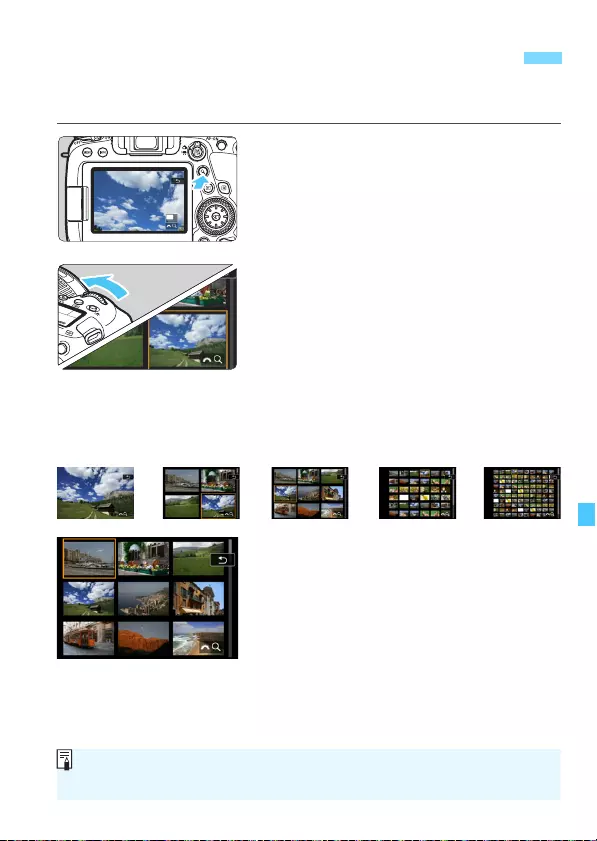
399
Search for images quickly with the index display showing 4, 9, 36, or
100 images on one screen.
1Press the <u> button.
During image playback or when the
camera is ready to shoot, press the
<u> button.
[6u] will be displayed on the lower
right of the screen.
2Switch to the index display.
Turn the <
6
> dial counterclockwise.
The 4-image index display will
appear. The selected image is
highlighted with an orange frame.
Turning the <6> dial further counterclockwise will switch the
display from 9 images, 36 images, and to 100 images. If you turn the
dial clockwise, it will rotate through 100, 36, 9, 4, and single-image
display.
3Select an image.
Operate the <5> dial or <9
> to
move the orange frame and select the
image.
Press the <u> button to turn off the
[6u] icon, then turn the <6> dial
to display the image(s) on the next or
previous screen.
Press <0> in the index display to display the selected image in the
single-image display.
H
Index display (Multiple-image Display)
If the search conditions are set with [32: Set image search conditions]
(p.402), only the found images will be displayed.
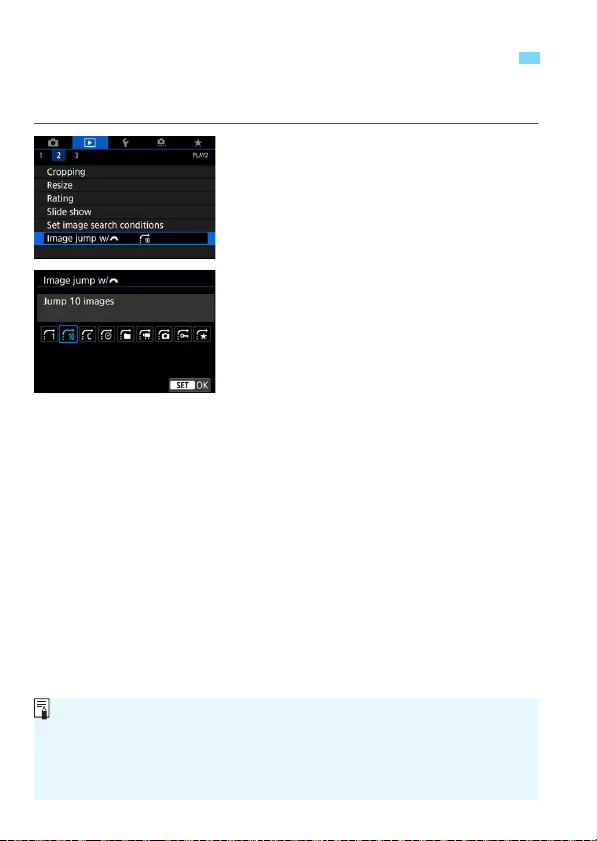
400
In the single-image display, you can turn the <6> dial to jump through
the images forward or backward according to the jump method set.
1Select [Image jump w/6].
Under the [32] tab, select [Image
jump w/6], then press <0>.
2Select the jump method.
Select the jump method, then press
<0>.
d:Display images one by one
e:Jump by 10 images
r:Jump images by the specified
number
g:Display by date
h:Display by folder
i:Display movies only
j:Display stills only
P:Display protected images
only
k:Display by image rating
(p.412)
e
Jump Display (Jumping Through Images)
With [Jump images by the specified number], you can turn the <6>
dial to select the number of images within 1 to 100 you want to jump by.
When you select [Display by image rating], turn the <6> dial to
specify the rating. If you browse images with 9 selected, all the rated
images will be displayed.

401
e Jump Display (Jumping Through Images)
3Browse by jumping.
Press the <x> button to play back
images.
In the single-image display, turn the
<6> dial.
You can browse by the set method.
Playback position
Jump method
To search images by shooting date, select [g: Date].
To search images by folder, select [h: Folder].
If the card contains both movies and still photos, select [i: Movies] or
[j: Stills] to display one or the other.
If the jump method is set to [P: Protect] or [k: Rating] but no images
are protected or have ratings, you cannot use the <6> dial to browse
through images.
If search conditions are set with [32: Set image search conditions]
(p.402), only the found images will appear in jump display.

402
You can play back images filtered according to search conditions. After
setting the image search conditions, you can play back and display only
the found images.
Note that the following can be done for the found images: Erase
protection, rating, slide show, deletion, print order, and photobook order.
This feature enables you to quickly do a specific task to the found
images in one batch.
1Select [Set image search
conditions].
Under the [32] tab, select [Set
image search conditions], then
press <0>.
2Set the search conditions.
Press the <W> <X> keys to select an
item.
Press the <Y> <Z> keys to set the
setting.
A checkmark [X] is appended to the
left of the item. (Specified as the
search condition.)
If you select the item and press the <B> button, the checkmark
[X] will be removed. (The search condition is canceled.)
t Filtering Images for Playback
Checkmark
Item Setting
9Rating Images with the selected (rating) condition will be displayed.
dDate Images taken on the selected shooting date will be displayed.
nFolder Images in the selected folder will be displayed.
JProtect Images with the selected (protect) condition will be displayed.
fType of file
Displays images in the selected file type.
The following file formats can be set:
[z Stills], [z (RAW)], [z (RAW,RAW+JPEG)],
[z(RAW+JPEG)], [z (RAW+JPEG, JPEG)], [z (JPEG)],
and [k Movies].

403
t Filtering Images for Playback
3Implement the search conditions.
Read the message that appears.
Select [OK], then press <0>.
The search condition is specified.
4Display the found images.
Press the <3> button to play back
images.
Only the images that match the set
conditions (filtered) will be played back.
When the images are filtered, the
screen will have an outer yellow frame.
Display the screen in step 2, then press the <L> button to remove all
the checkmarks [X]. Press the <0> button, then select [OK] to clear
the search conditions.
Yellow frame
Clearing the Search Conditions
If there are no images matching the search conditions, pressing <0> on
the screen in step 2 will not enable [OK]. (Cannot proceed to step 3.)
Even if [52: Auto power off] is set to [1 min.], [2 min.], or [4 min.], the
auto power off time will be approx. 6 min. when the [32: Set image
search conditions] screen is displayed.
Doing any of the following will clear the search conditions, and the filtered
display will end. ([
Image search canceled
] may also appear on the screen.)
• Shooting is performed.
• Auto power off takes effect.
• Setting the power switch to <2>.
• Formatting the card.
• Opening the battery compartment cover or card slot cover.
• Adding an image (processing a RAW image, resizing an image,
cropping an image, etc.).
• When there are no longer any images matching the search conditions.
• All the camera settings are cleared.

404
You can magnify a captured image by approx. 1.5x to 10x on the LCD
monitor.
1Magnify the image.
The image can be magnified as
follows: 1. During image playback, 2.
During the image review after image
capture, and 3. From the shooting-
ready state.
Press the <u> button.
The magnified view will appear. The
magnified area position and [6u]
will be displayed on the lower right of
the screen.
The image magnification increases
as you turn the <6> dial clockwise.
You can magnify the image up to
approx. 10x.
The image magnification decreases
as you turn the <6> dial
counterclockwise. In the case of 1
and 3 only, turning the dial further will
display the index display (p.399).
2Scroll around the image.
Use <9> to scroll around the
magnified image.
Press the <u> button or <x>
button to exit the magnified view.
u Magnifying Images
Magnified area position
In the case of 1 and 3 only, you can turn the <5> dial to view another
image while maintaining the magnified view.
A movie cannot be magnified.

405
u Magnifying Images
Under the [33] tab, when you select
[Magnificatn (apx)], you can set the
initial magnification ratio and position for
the magnified view.
1x (no magnification)
The image is not magnified. The magnified view will start with the
single-image display.
2x, 4x, 8x, 10x (magnify from center)
The magnified view starts at the image center at the selected
magnification.
Actual size (from selected point)
The recorded image’s pixels will be displayed at approx. 100%. The
magnified view starts at the AF point that achieved focus. If the
photo is taken with manual focus, the magnified view starts at the
image center.
Same as last magnification (from center)
The magnification will be the same as the last time you exited the
magnified view with the <x> or <u> button. The magnified view
starts at the image center.
3 Setting the Initial Magnification Ratio and Position
For images taken with [Live 1-point AF] (p.313) or with [Distortion
correction] set to [Enable] (p.202), the magnified view will start at the
image center even if [Actual size (from selected pt)] has been set.

406
The LCD monitor is a touch-sensitive panel that you can touch with your
fingers for various playback operations. First, press the <x> button
to play back images.
Swipe with one finger.
With single-image display, touch the
LCD monitor with one finger. You
can browse to the next or previous
image by swiping your finger to the
left or right.
Swipe to the left to see the next
(newer) image, or swipe to the right to
see the previous (older) image.
With index display, also touch the LCD
monitor with
one finger
. You can
browse to the next or previous screen
by swiping your finger up or down.
Swipe up to see the next (newer)
images or swipe down to see the
previous (older) images.
When you select an image, the orange
frame will appear. Tap on the image
again to display it as a single image.
Swipe with two fingers.
Touch the LCD monitor with two fingers.
When you swipe two fingers to the left or
right, you can jump through images with
the method set in [Image jump w/6]
under the [x2] tab.
d Playing Back with the Touch Screen
Browsing Images
Jumping through Images (Jump Display)

407
d Playing Back with the Touch Screen
Pinch two fingers.
Touch the screen with two fingers spread
apart, and pinch your fingers together on
the screen.
Each time you pinch your fingers, the
image will shrink. If you pinch the
single-image display, it will change to
the 4-image index display.
When you select an image, the orange frame will appear. Tap on the
image again to display it as a single image.
Spread two fingers apart.
Touch the screen with two fingers together,
then spread your fingers apart on the screen.
As you spread your fingers, the
image will be magnified.
The image can be magnified up to
approx. 10x.
To reduce the image, pinch your fingers together on the screen.
If you do this on a 4-image index display, it will change into the
single-image display.
Double-tap.
You can magnify the image by using one finger to quickly tap twice
(double-tap) on the LCD monitor. The image will be magnified on the
spot where you tap. To return to the single-image display, double-tap on
the image again.
To scroll around the position of magnified display in magnified view,
touch the LCD monitor with one finger and move it around.
Reducing Image (Index Display)
Magnifying Image
You cannot magnify the image by double-tapping in the index display.
Touch operations on the camera’s LCD monitor are also possible while
playing back images on a TV set connected to your camera (p.427).
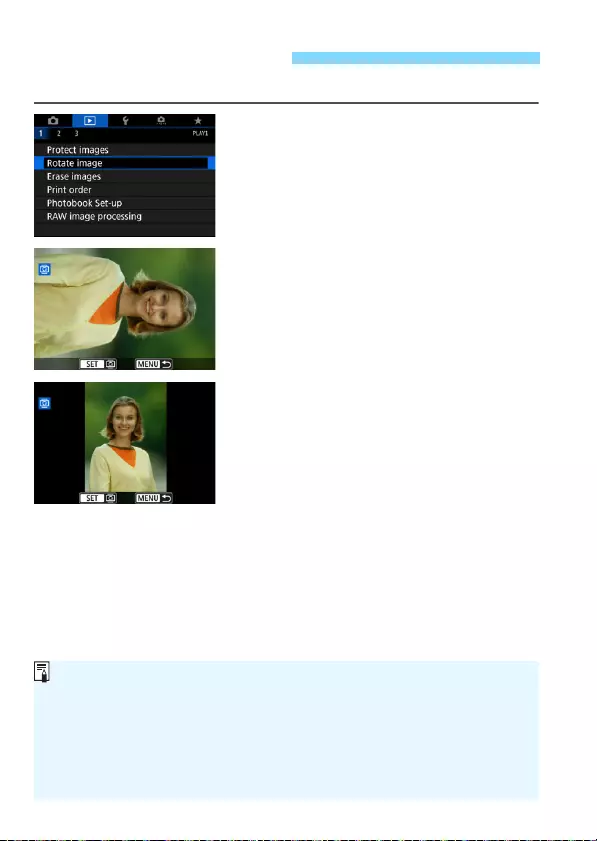
408
You can rotate the displayed image to the desired orientation.
1Select [Rotate image].
Under the [31] tab, select [Rotate
image], then press <0>.
2Select an image.
Turn the <5> dial to select the
image to be rotated.
You can also select an image in the
index display (p.399).
3Rotate the image.
Each time you press <0>, the
image will rotate clockwise as follows:
90° 9 270° 9 0°.
To rotate another image, repeat steps
2 and 3.
b Rotating the Image
If you set [51: Auto rotate] to [OnzD] (p.435) before taking vertical
shots, you need not rotate the image as described above.
If the rotated image is not displayed in the rotated orientation during
image playback, set [51: Auto rotate] to [OnzD].
A movie cannot be rotated.
If the search conditions are set with [32: Set image search
conditions] (p.402), only the found images will be displayed.

409
You can protect important images from being accidentally erased by the
camera’s erase function.
1Select [Protect images].
Under the [31] tab, select
[
Protect
images], then press <0>.
2Select [Select images].
An image will be displayed.
3Select the image to be protected.
Turn the <5> dial to select the
image to be protected.
4Protect the image.
Press <0> to protect the selected
image. The <K> icon will appear at
the top of the screen.
To cancel the image protection, press
<0> again. The <K> icon will
disappear.
To protect another image, repeat
steps 3 and 4.
K Protecting Images
3 Protecting a Single Image
Image protection icon
If the search conditions are set with [32: Set image search conditions]
(p.402), only the found images will be displayed.

410
K Protecting Images
While looking at the images in the index display, you can specify the
first and last images for a range to protect all the specified images at
once.
1Select [Select range].
Under [31: Protect images], select
[Select range] and press <0>.
2Specify the range of images.
Select the first image (start point),
then press <0>.
Next, select the last image (end
point), then press <0>.
The images in the specified range will
be protected and the <K> icon will
appear.
To select another image to be
protected, repeat step 2.
3 Specifying the Range of Images to be Protected
If the search conditions are set with [32: Set image search
conditions] (p.402), only the found images will be displayed.
If you specify a protected image as the first image in the range, all
images in the range (from the first image to the last) will become
unprotected instead. (Protection will be canceled in the specified range.)

411
K Protecting Images
You can protect all the images in a folder or on a card at once.
When you select [All images in folder]
or [All images on card] in [31:
Protect images], all the images in the
folder or on the card will be protected.
To cancel the selection, select
[Unprotect all images in folder] or
[Unprotect all images on card].
If the search conditions are set with [32: Set image search
conditions] (p.402), the display will change to [All found images] and
[Unprotect all found].
If you select [All found images], all the
found images will be protected.
If you select [Unprotect all found], the
protection of all the found images will be
canceled.
3 Protecting All Images in a Folder or on a Card
If you format the card (p.70), the protected images will also be erased.
Movies can also be protected.
Once an image is protected, it cannot be erased by the camera’s erase
function. To erase a protected image, you must first cancel the
protection.
If you erase all the images (p.433), only the protected images will
remain. This is convenient when you want to erase all unnecessary
images at once.

412
You can rate images (still photos and movies) with one of the five rating
marks: l/m/n/o/p. This function is called rating.
1Select [Rating].
Under the [32] tab, select [Rating],
then press <0>.
2Select [Select images].
An image will be displayed.
3Select the image to be rated.
Turn the <5> dial to select the
image to be rated.
If you press the <u> button and turn
the <6> dial counterclockwise, you
can select an image from a three-
image display. To return to the single-
image display, turn the dial clockwise.
4Rate the image.
Press <0>, and a blue highlight
frame will appear as shown in the
screen shown on the left.
Press the <W> <X> keys to select a
rating mark, then press <0>.
When you append a rating mark for
the image, the number beside the set
rating will increase by one.
To rate another image, repeat steps 3
and 4.
p Setting Ratings
3 Rating a Single Image
If the search conditions are set with [32: Set image search conditions]
(p.402), only the found images will be displayed.
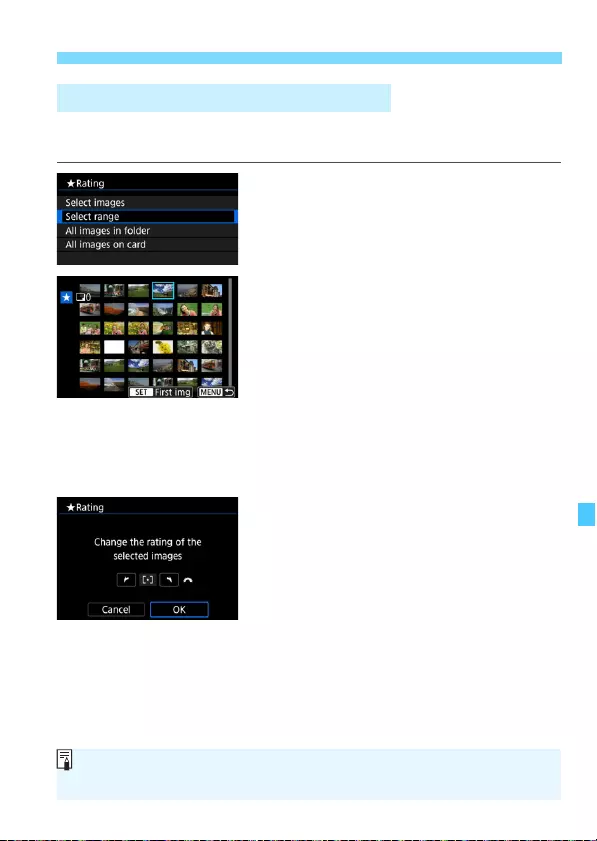
413
p Setting Ratings
While looking at the images in the index display, you can specify the
first and last images for a range to rate all the specified images at once.
1Select [Select range].
Select [Select range] in [32:
Rating], then press <0>.
2Specify the range.
Select the first image (start point),
then press <0>.
Next, select the last image (end
point), then press <0>.
A checkmark [X] will be appended to
all the images within the range
between first and last images.
3Press the <Q> button.
4Rate the image.
Turn the <6> dial to select a rating
mark, then select [OK].
All the images in the specified range
will be rated (same rating) at once.
3 Rating by Specifying the Range
If the search conditions are set with [32: Set image search conditions]
(p.402), only the found images will be displayed.

414
p Setting Ratings
You can rate all the images in a folder or on a card at once.
Under [32: Rating], when you select
[All images in folder] or [All images on
card], all the images in the folder or on
the card will be rated.
Turn the <6> dial to select a rating,
then select [OK].
When you are not rating images or
cancelling the rating, select [OFF].
If the search conditions are set with [32: Set image search
conditions] (p.402), the display will change to [All found images].
If you select [All found images], all the
found images filtered by the search
conditions will be rated as specified.
3 Rating All Images in a Folder or on a Card
On the step 4 screen on page 412, the number next to the rating mark goes
up to only three digits (max. 999). If there are 1000 or more images with a
given rating, “###” will be displayed.
Taking Advantage of Ratings
With [32: Set image search conditions] and [32: Image jump w/
6], you can display only the images given a specific rating.
Depending on the computer’s operating system, you can see each file’s
rating as part of the file information display or in the provided, standard
image viewer (JPEG images only).

415
During playback, you can press the <Q> button to set the following:
[J: Protect images], [b: Rotate image], [9: Rating], [R: RAW
image processing (1 images only)], [S: Resize (JPEG image only)],
[N: Cropping (JPEG images only)], [ : Highlight alert], [ : AF point
display], [e: Image jump w/6], [t: Image search], and [q: Send
images to smartphone*].
For movies, only the functions in bold above can be set.
* Not selectable if [Wi-Fi] is set to [Disable] in [Wi-Fi setting] under [51: Wireless
communication settings].
1Press the <Q> button.
During image playback, press the
<Q> button.
The Quick Control options will
appear.
2Select an item and set it.
Press the <W> <X> keys to select a
function.
The setting of the selected function is
displayed at the bottom.
Turn the <6> or <5> dial to set it.
For protecting images (p.409) and
Rating (p.412), press <
B
> to set it.
For RAW image processing (p.438),
Resize (p.444), Cropping (p.446),
Image search (p.402), and Send
images to smartphone, press <
0> to
set it.
To cancel, press the <M> button.
Q Quick Control for Playback

416
Q Quick Control for Playback
3Exit the setting.
Press the <Q> button to exit the
Quick Control.
To rotate an image, set [51: Auto rotate] to [OnzD] (p.435). If [51:
Auto rotate] is set to [OnD] or [Off], the [b Rotate image] setting will be
recorded to the image, but the camera will not rotate the image for display.
Pressing the <Q> button during the index display will switch to the
single-image display, and the Quick Control screen will appear. Pressing
the <Q> button again will return to the index display.
For images taken with another camera, the options you can select may
be restricted.

417
The three main ways to play back and enjoy movies are as follows:
By connecting the camera to a TV set
with an HDMI cable, you can play back
the camera’s still photos and movies on
the TV set. Using the HDMI Cable HTC-
100 (sold separately) is recommended.
You can play back movies on the
camera’s LCD monitor.
You can also edit out the movie’s first
and last scenes and can play back the
still photos or movies on the card in an
automatic slide show.
k Enjoying Movies
Playback on a TV Set (p.427)
Playback on the Camera’s LCD Monitor (p.419)
Even if the camera is connected to a TV set with an HDMI cable and a
4K time-lapse movie is played back, it will be played back in Full HD
quality. (Playback in 4K quality is not possible.)
Since hard disk recorders do not have an HDMI IN terminal, the camera
cannot be connected to a hard disk recorder with an HDMI cable.
Even if the camera is connected to a hard disk recorder with a USB
cable, movies and still photos cannot be played back or saved.
A movie edited with a computer cannot be rewritten to the card and played
back with the camera.

418
k Enjoying Movies
The movie files recorded on the card can
be transferred to a computer and played
back or edited with pre-installed or
general-purpose software compatible
with the movie’s recording format.
Playback and Editing with a Computer
To play back or edit a movie with commercially-available software, use
software compatible with MP4-format and MOV-format movies. For
details on commercially-available software, contact the software
manufacturer.
You can play back 4K time-lapse movies with EOS MOVIE Utility (p.595).

419
1Play back the image.
Press the <
x
> button to play back an
image.
2Select a movie.
Turn the <5> dial to select the
movie to be played back.
In the single-image display, the
<s1> icon displayed on the upper
left indicates a movie. If the movie is a
video snapshot, <st> will be
displayed.
In the index display, perforations at
the left edge of a thumbnail indicate a
movie. As movies cannot be played
back from the index display, press
<0> to switch to the single-image
display.
3In the single-image display, press <0>.
The movie playback panel will appear at the bottom of the
screen.
4 Play back the movie.
Select [7] (Play), then press <0>.
The movie will start playing back.
You can pause the playback by
pressing <
0
>. Press it again to
resume the playback.
You can adjust the sound volume
even during movie playback by
turning the <6> dial.
For more details on the playback
procedure, see the next page.
k Playing Back Movies
Speaker
If the search conditions are set with [32: Set image search conditions]
(p.402), only the filtered images in step 2 will be displayed.

420
k Playing Back Movies
Movie Playback Panel
* For 4K time-lapse movie playback, the item name will be [Play (Frame skip)].
Operation Playback Description
7 Play* Pressing <0> toggles between playback and stop.
8 Slow motion
Adjusts the slow motion speed by turning the <5>
dial. The slow motion speed is indicated on the upper
right of the screen.
5 First frame Displays the movie’s first frame.
3 Previous frame Displays the previous frame each time you press
<0>. Holding <0> down will rewind the movie.
6 Next frame Plays the movie frame-by-frame each time you press
<0>. Holding <0> down will fast forward the movie.
4 Last frame Displays the movie’s last frame.
y Background music Plays back a movie with the selected background
music (p.426).
X Edit Displays the editing screen (p.422).
Playback position
mm’ ss” Playback time (minutes:seconds)
9 Volume Turn the <6> dial to adjust the volume of the built-in
speaker (p.419).
32Returns to the single-image display when <M>
button is pressed.

421
k Playing Back Movies
Tap [7] at the center of the
screen.
The movie will start playing back.
To display the movie playback panel,
tap <s1> or <st> on the
upper left of the screen.
To pause the movie while it is playing
back, tap on the screen. The movie
playback panel will also appear.
Playback with the Touch Screen
If you play back a 4K time-lapse movie on the camera, the playback
resolution will be equivalent to that of a Full HD movie played back on
the camera.
If you play back a 4K time-lapse movie with the camera or select [Slow
motion] and set it to the fastest speed (by turning <5> all the way to
the right), every other frame will be skipped during playback.
The camera may not be able to play back movies shot with another
camera.
If you connect the camera to a TV set to play back a movie (p.427),
adjust the sound volume with the TV set. (Turning the <6> dial will not
change the sound volume.)
If you attach or detach the lens, the card’s writing speed is slow, or the
movie file contains corrupted frames during movie playback, the movie
playback will stop.
If [Background music] is set, the sound recorded with the movie will not
be played during the movie playback.
For 4K time-lapse movies, when you select [7] on the movie playback
panel, [Play (Frame skip)] will be displayed.
With a fully-charged Battery Pack LP-E6N, the continuous playback time
at room temperature (23°C/73°F) will be approx. 4 hr. 40 min. (with L/
w set).

422
You can edit out the first and last scenes of a movie in approx. 1-sec.
increments.
1On the movie playback screen,
select [X].
The movie editing panel will be
displayed at the bottom of the screen.
2Specify the part to be edited out.
Select either [U] (Cut beginning) or
[V] (Cut end), then press <0>.
Press the <Y> <Z> keys to see the
previous or next frames. Keep
holding down the key to fast forward
or fast rewind the frames. Turn the
<5> dial for frame-by-frame
playback.
After deciding which part to edit out,
press <0>. The portion highlighted
in white on the top of the screen is
what will remain.
3Check the edited movie.
Select [7] and press <0> to play
back the edited movie.
To change the edited part, go back to
step 2.
To cancel the editing, press the
<M> button, then select [OK] on
the confirmation dialog.
X
Editing a Movie’s First and Last Scenes

423
X Editing a Movie’s First and Last Scenes
4Save the edited movie.
Select [W], then press <0>.
The save screen will appear.
To save it as a new movie, select
[New file]. To save it and overwrite
the original movie file, select
[Overwrite], then press <0>.
On the confirmation dialog, select
[OK] to save the edited movie and
return to the movie playback screen.
Since the editing is performed in approx. 1-sec. increments (position
indicated by [ ] on the top of the screen), the actual position where the
movie is edited may differ from the position you specified.
If the card does not have enough free space, [New file] will not be
available.
When the battery level is low, movie editing is not possible. Use a fully-
charged battery.
Movies shot with another camera cannot be edited with this camera.
You cannot edit a movie when the camera is connected to a computer.
X

424
You can play back the images on the card as an automatic slide show.
1Specify the images to be played
back.
To play back all the images on the
card, go to step 2.
If you want to specify the images to
be played back in the slide show, filter
the images with [Set image search
conditions] under the [32] tab
(p.402).
2Select [Slide show].
Under the [32] tab, select
[
Slide
show
], then press <
0
>.
3Set the playback as desired.
Select [Set up], then press <0>.
Set the [Display time], [Repeat]
(repeated playback), [Transition
effect] (effect when changing
images), and [Background music]
for the still photos.
For [Background music], see page
426.
After completing the settings, press
the <M> button.
3
Slide Show (Auto Playback)
Display time Repeat

425
3 Slide Show (Auto Playback)
4Start the slide show.
Select [Start], then press <0>.
After [Loading image...] is displayed,
the slide show will start.
5Exit the slide show.
To exit the slide show and return to
the setting screen, press the
<M> button.
Transition effect Background music
When images for playback are already filtered (search conditions are
set) with [32: Set image search conditions], the images matching the
search conditions will be played back in the slide show.
To pause the slide show, press <0>. During pause, [G] will be
displayed on the upper left of the image. Press <0> again to resume
the slide show. You can also pause the slide show by tapping on the
screen.
During the automatic playback of still photos, you can press the <B>
button to switch the display format (p.388).
During movie playback, you can adjust the sound volume by turning the
<6> dial.
During auto playback or pause, you can turn the <5> dial to view
another image.
During auto playback, auto power off will not take effect.
The display time may differ depending on the image.
To view the slide show on a TV set, see page 427.

426
3 Slide Show (Auto Playback)
If you use EOS Utility (EOS software, p.594) to copy background music
tracks to the card, you can play the background music together with the
slide show.
1Select [Background music].
Set [Background music] to [On],
then press <0>.
If the card has no background music,
you cannot perform step 2.
2Select the background music.
Press the <W> <X> keys to select
the desired background music.
To listen to a sample of a background
music track, press the <B>
button. During playback, press the
<W> <X> keys to play another
background music track. Press the
<B> again to stop playing the
background music track.
Adjust the sound volume by turning
the <6> dial.
Select a background music track and
press <0> to add a checkmark [X].
You can also select multiple
background music tracks.
The checkmarked [
X
] background
music will be played for the slide show.
Selecting the Background Music
At the time of purchase, the camera does not have background music.
For the procedure to save (copy) the background music tracks to a card,
refer to the EOS Utility Instruction Manual (p.596).
To delete the background music tracks saved on the card, press the
<L> button in step 2.

427
By connecting the camera to a TV set with an HDMI cable, you can play
back the camera’s still photos and movies on the TV set. For the HDMI
cable, HDMI Cable HTC-100 (sold separately) is recommended.
If the picture does not appear on the TV screen, check if the [53: Video
system] is correctly set to [For NTSC] or [For PAL] (depending on the
video system of your TV set).
1Connect the HDMI cable to the
camera.
With the plug’s <dHDMI MINI> logo
facing the front of the camera, insert it
into the <D> terminal.
2Connect the HDMI cable to the TV
set.
Connect the HDMI cable to the TV
set’s HDMI IN port.
3Turn on the TV set and switch the
TV set’s video input to select the
connected port.
4Set the camera’s power switch to
<1>.
5Press the <x> button.
The image will appear on the TV
screen. (Nothing will be displayed on
the camera’s LCD monitor.)
The images will automatically be
displayed at the optimum resolution
matching the connected TV set.
By pressing the <B> button, you
can change the display format.
To play back movies, see page 419.
Viewing Images on a TV Set

428
Viewing Images on a TV Set
If the TV set connected to the camera with an HDMI cable is compatible
with HDMI CEC*, you can use the TV set’s remote control for playback
operations.
* An HDMI-standard function enabling HDMI devices to control each other so that
you can control them with one remote control unit.
1Select [Ctrl over HDMI].
Under the [33] tab, select [Ctrl over
HDMI], then press <0>.
2Select [Enable].
3Connect the camera to a TV set.
Use an HDMI cable to connect the
camera to the TV set.
The TV set’s input will switch
automatically to the HDMI port
connected to the camera. If it does not
switch automatically, use the TV set’s
remote control to select the HDMI IN
port the cable is connected to.
Using HDMI CEC TV Sets
When the camera is connected to a TV set with an HDMI cable, 4K time-
lapse movies will be played back in Full HD quality (cannot be played
back in 4K quality).
Adjust movie sound volume with the TV set. The sound volume cannot
be adjusted with the camera.
Before connecting or disconnecting the cable between the camera and
TV set, turn off the camera and TV set.
Depending on the TV set, part of the image displayed may be cut off.
Do not connect any other device’s output to the camera’s <D>
terminal. Doing so may cause a malfunction.
Certain TV sets may not display the images due to incompatibility.
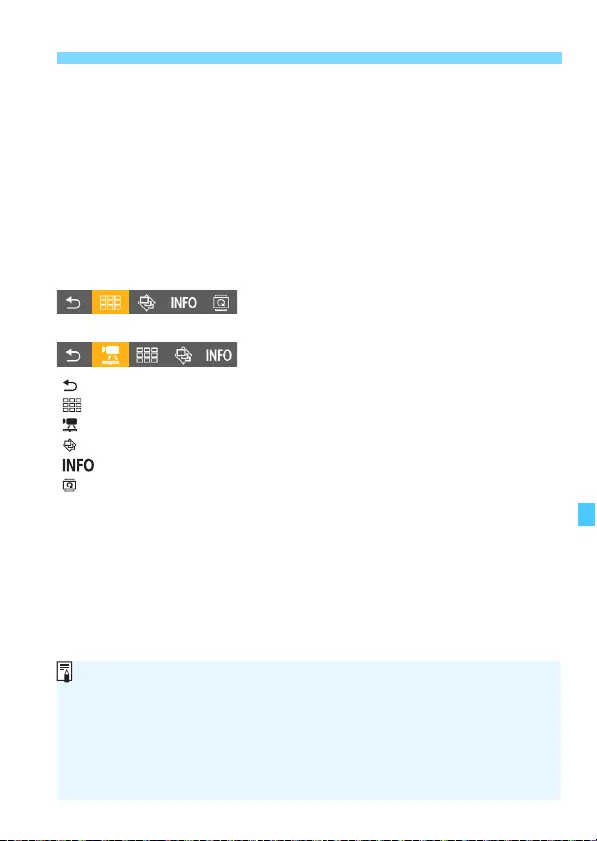
429
Viewing Images on a TV Set
4Press the camera’s <x> button.
An image will appear on the TV
screen and you can use the TV set’s
remote control for playback.
5Select an image.
Point the remote control toward the
TV set and press the / button to
select an image.
6Press the remote control’s Enter
button.
The menu appears and you can
perform the playback operations
shown on the left.
Press the remote control’s /
button to select the desired option,
then press the Enter button.
If you select [Return] and press the
Enter button, the menu will disappear
and you can use the remote control’s
/ button to select an image.
Still photo playback menu
Movie playback menu
: Return
: 9-image index
: Play back movie
: Slide show
: Display shooting info
: Rotate
Certain TV sets require you to first enable the HDMI CEC connection.
For details, refer to the TV set’s Instruction Manual.
Certain TV sets, even those compatible with HDMI CEC, may not be able
to be operated properly. In such a case, set [33: Ctrl over HDMI] to
[Disable], and use the camera to control the playback operation.
You can set the images to be played back when [Slide show] is selected
with [32: Set image search conditions].

430
You can either select and erase unnecessary images one by one or
erase them in one batch. Protected images (p.409) will not be erased.
1Select the image to be erased.
Press the <x> button to play back
images.
Turn the <5> dial to select the
image to be erased.
2Press the <L> button.
The Erase menu will appear.
3Erase the image.
Select [Erase], then press <0>. The
image displayed will be erased.
L Erasing Images
Erasing a Single Image
Once an image is erased, it cannot be recovered. Make sure you no
longer need the image before erasing it. To prevent important images
from being erased accidentally, protect them. Note that erasing a
RAW+JPEG image will erase both the RAW and JPEG images.
If the search conditions are set with [32: Set image search conditions]
(p.402), only the found images will be displayed.

431
L Erasing Images
By adding checkmarks <X> to the images to be erased, you can erase
all those images at once.
1Select [Erase images].
Under the [31] tab, select [Erase
images], then press <0>.
2Select [Select and erase images].
An image will be displayed.
3Select the image to be erased.
Turn the <
5
> dial to select the image
to be erased, then press <
0
>.
A checkmark [X] will be displayed on
the upper left of the screen.
If you press the <u> button and turn
the <6> dial counterclockwise, you
can select an image from a three-
image display. To return to the single-
image display, turn the dial clockwise.
To select another image to be erased,
repeat step 3.
4Erase the image.
Press the <L> button, then press
[OK].
The selected images will be erased at
once.
3 Checkmarking [X] Images to Be Erased in a Batch
Under [32: Set image search conditions], if [Protect] is set to [Enable],
[31: Erase images] cannot be selected.
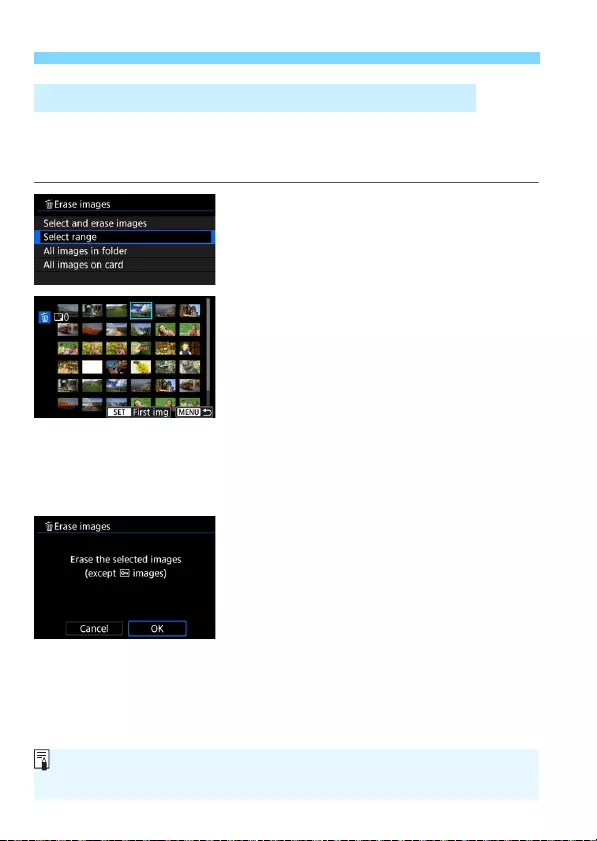
432
L Erasing Images
While looking at the images in the index display, you can specify the
first and last images for a range to erase all the specified images at
once.
1Select [Select range].
Select [Select range] in [31: Erase
images], then press <0>.
2Specify the range of images.
Select the first image (start point),
then press <0>.
Next, select the last image (end
point), then press <0>.
A checkmark [X] will be appended to
all the images within the specified
range.
3Press the <L> button.
4Erase the image.
Select [OK].
The images in the specified range will
be erased.
3 Specifying the Range of Images to be Erased
If the search conditions are set with [32: Set image search conditions]
(p.402), only the found images will be displayed.
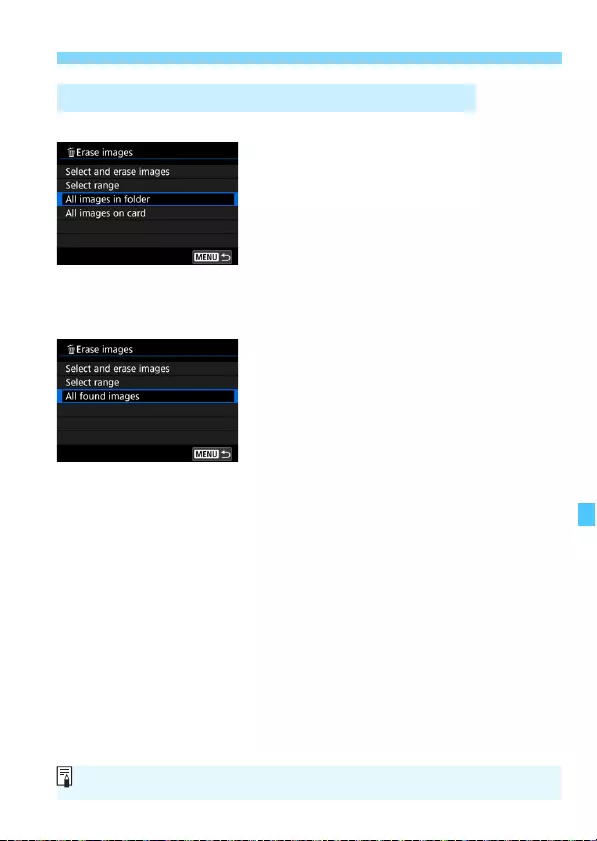
433
L Erasing Images
You can erase all the images in a folder or on a card at once.
When [31: Erase images] is set to [All
images in folder] or [All images on
card], all the images in the folder or on
the card will be erased.
If the search conditions are set with [32: Set image search
conditions] (p.402), the display will change to [All found images].
If you select [All found images], all the
found images will be erased as specified.
3 Erasing All Images in a Folder or on a Card
To erase all the images including protected images, format the card (p.70).
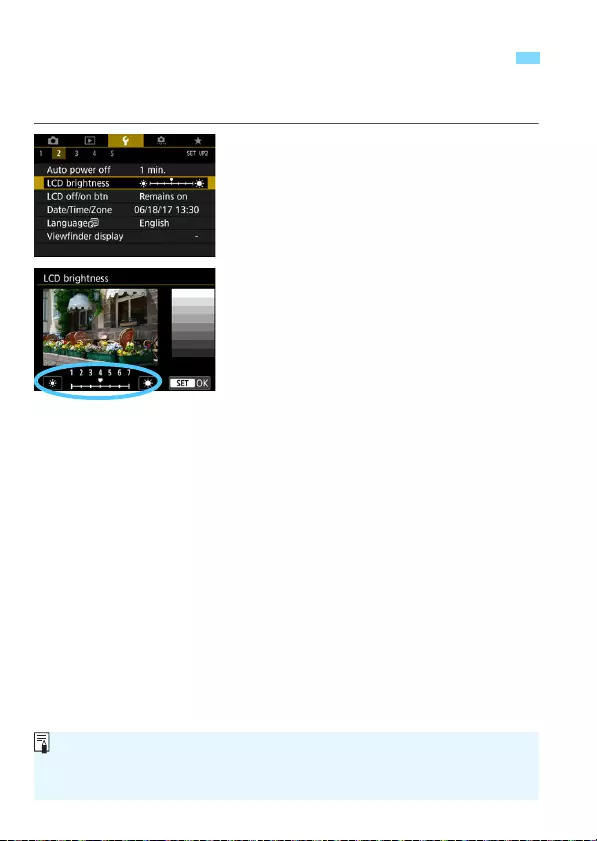
434
You can adjust the brightness of the LCD monitor to make it easier to
view.
1Select [LCD brightness].
Under the [52] tab, select [LCD
brightness], then press <0>.
2 Adjust the brightness.
Referring to the gray chart, press the
<Y> <Z> keys to adjust the
brightness, then press <0>.
3
Adjusting the LCD Monitor Brightness
To check the image’s exposure, referring to the histogram is
recommended (p.398).
The last image played back will be displayed on the screen in step 2.

435
Images shot in vertical orientation are rotated
automatically to the proper orientation for viewing,
so they will not be displayed in horizontal
orientation when played back on the camera’s LCD
monitor or viewed on a computer screen. You can
change the setting of this feature.
1Select [Auto rotate].
Under the [51] tab, select [Auto
rotate], then press <0>.
2Set the display orientation.
Select the desired setting, then press
<0>.
OnzD
The vertical image is automatically rotated during playback on both
the camera’s LCD monitor and on the computer.
OnD
The vertical image is automatically rotated only on the computer.
Disable
The vertical image is not automatically rotated.
3
Setting the Auto Rotation of Vertical Images
Images captured with auto rotation set to [Off] will not rotate during playback
even if you later set auto rotation to [On].
The image displayed immediately after shooting will not be automatically
rotated.
If a picture is taken while the camera is pointing up or down, automatic
rotation to the proper orientation for viewing may not be performed correctly.
If the vertical image is not automatically rotated on the computer screen,
it means the software you are using does not support image rotation for
display. Using the EOS software is recommended.

436

437
11
Post-Processing
Images
This chapter describes RAW image processing, JPEG
image resizing, and JPEG image cropping.
The
M
icon
at the upper right of the page title indicates that
the function is available only in Creative Zone modes
(<d>, <s>, <f>, <a>, <F>).
The camera may not be able to process images taken with
another camera.
Post-processing images as described in this chapter cannot be
performed when the camera is connected to a computer with
an interface cable (sold separately).
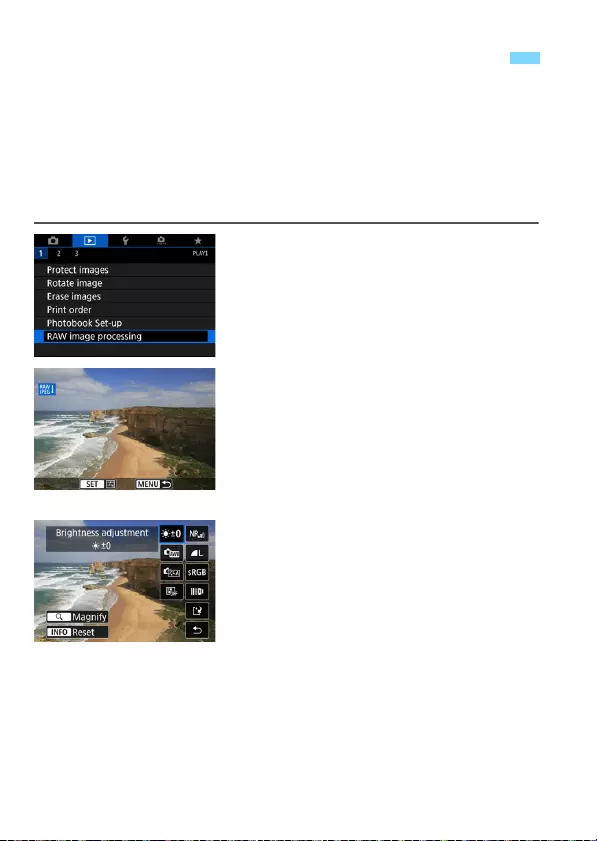
438
You can process 1 images with the camera and save them as JPEG
images. As the RAW image itself does not change, you can apply
different processing conditions to create any number of JPEG images
from it.
Note that 41 and 61 images cannot be processed with the
camera. Use Digital Photo Professional (EOS software, p.594) to
process those images.
1Select [RAW image processing].
Under the [31] tab, select [RAW
image processing], then press
<0>.
1 images will be displayed.
2
Select the image to be processed.
Turn the <5> dial to select the
image you want to process.
If you press the <u> button and turn
the <6> dial counterclockwise, you
can select an image from the index
display.
3Set the desired processing
conditions.
Press <0> and wait until the RAW-
processing options appear (p.441).
Use <9> to select an option, then
turn the <6> or <5> dial to switch
the setting.
The displayed image will reflect such
settings as “Brightness adjustment”,
“White balance”, etc.
To return to the image settings at the
time of shooting, press the <B>
button.
R
Processing RAW Images with the Camera
N

439
R Processing RAW Images with the CameraN
Displaying the setting screen
Press <0> to display the selected
function’s setting screen. Turn the
<6> or <5> dial to change the
setting. Press <0> to finalize the
setting and return to the previous
screen.
4 Save the image.
Select [W] (Save), then press <0>.
When you select [OK], the JPEG
image created by the processing will
be saved to the card.
Check the destination folder and
image file number, then select [OK].
To process another image, repeat
steps 2 to 4.

440
R Processing RAW Images with the CameraN
You can magnify the image by pressing the <u> button in step 3. The
magnification will vary depending on the [Image quality] setting under
[x1: RAW image processing]. With <9>, you can scroll around the
magnified image.
To cancel the magnified view, press the <u> button again.
With [z4: Aspect ratio] (p.168) set to an option other than [3:2], frame
lines indicating the image area will be displayed on the shot 1
images. JPEG images generated from 1 images will be saved with
the set aspect ratio.
Magnified View
Images with Aspect Ratio Setting
When you process multiple-exposure 1 images, certain settings cannot
be changed.

441
R Processing RAW Images with the CameraN
Brightness adjustment
You can adjust the image brightness up to ±1 stop in 1/3-stop
increments. The displayed image will reflect the setting’s effect.
White balance (p.185)
You can select the white balance. If you select [Q] and press the
<B> button, you can select [Auto: Ambience priority] or [Auto:
White priority]. If you select [P] and press the <B> button, you
can set the color temperature. The displayed image will reflect the
setting’s effect.
Picture Style (p.176)
You can select the Picture Style. By pressing the <B> button,
you can adjust the sharpness, contrast, and other parameters. The
displayed image will reflect the setting’s effect.
Auto Lighting Optimizer (p.194)
You can set the Auto Lighting Optimizer. The displayed image will
reflect the setting’s effect.
High ISO speed noise reduction (p.195)
You can set the noise reduction processing for high ISO speeds. The
displayed image will reflect the setting’s effect. If the effect is difficult
to discern, magnify the image (p.440).
73 Image quality (p.162)
You can set the image quality when creating a JPEG image.
RAW Image Processing Options

442
R Processing RAW Images with the CameraN
Color space (p.208)
You can select either sRGB or Adobe RGB. Since the camera’s LCD
monitor is not compatible with Adobe RGB, the difference in the
image will hardly be perceptible when either color space is set.
Lens aberration correction
Peripheral illumination correction (p.200)
A phenomenon that makes the image corners look darker due to
the lens characteristics can be corrected. If [Enable] is set, the
corrected image will be displayed. If the effect is difficult to
discern, magnify the image (p.440) and check the four corners.
The peripheral illumination correction applied with the camera will
be less pronounced than that applied with the Digital Photo
Professional (EOS software, p.594) at maximum correction
amount. If the effects of correction are not apparent, use Digital
Photo Professional to apply the peripheral illumination correction.
Distortion correction (p.202)
Image distortion due to lens characteristics can be corrected. If
[Enable] is set, the corrected image will be displayed. The image
periphery will be trimmed in the corrected image.
Since the image resolution may look slightly lower, adjust the
sharpness with the Picture Style’s [Sharpness] parameter setting
as necessary.
Chromatic aberration correction (p.201)
Chromatic aberrations (color fringing along the subject’s outline)
due to the lens characteristics can be corrected. If [Enable] is set,
the corrected image will be displayed. If the effect is difficult to
discern, magnify the image (p.440).

443
R Processing RAW Images with the CameraN
Diffraction correction (p.203)
The diffraction by the lens aperture degrading the image
sharpness can be corrected. If [Enable] is set, the corrected
image will be displayed. If the effect is difficult to discern, magnify
the image (p.440).
Processing RAW images in the camera will not produce exactly the
same results as processing RAW images with Digital Photo Professional
(EOS software).
If you perform [Brightness adjustment], noise, banding, etc. may be
intensified with the effects of adjustment.
When processing images with [Distortion correction] set to [Enable],
AF point display information (p.397) or Dust Delete Data (p.452) will not
be appended to the image.
The effect of the lens aberration correction varies depending on the lens
used and shooting conditions. Also, the effect may be difficult to discern
depending on the lens used, shooting conditions, etc.
The lens correction data for lens aberration corrections is registered (stored)
in the camera.

444
You can resize a JPEG image to make the pixel count lower and save it
as a new image. Resizing an image is possible only with JPEG 3, 4,
and a images. JPEG b and RAW images cannot be resized.
1Select [Resize].
Under the [32] tab, select [Resize],
then press <0>.
An image will be displayed.
2Select an image.
Turn the <5> dial to select the
image you want to resize.
If you press the <u> button and turn
the <6> dial counterclockwise, you
can select an image from the index
display.
3Select the desired image size.
Press <0> to display the image
sizes.
Select the desired image size, then
press <0>.
4Save the image.
Select [OK] to save the resized
image.
Check the destination folder and
image file number, then select [OK].
To resize another image, repeat steps
2 to 4.
S Resizing JPEG Images
Target sizes
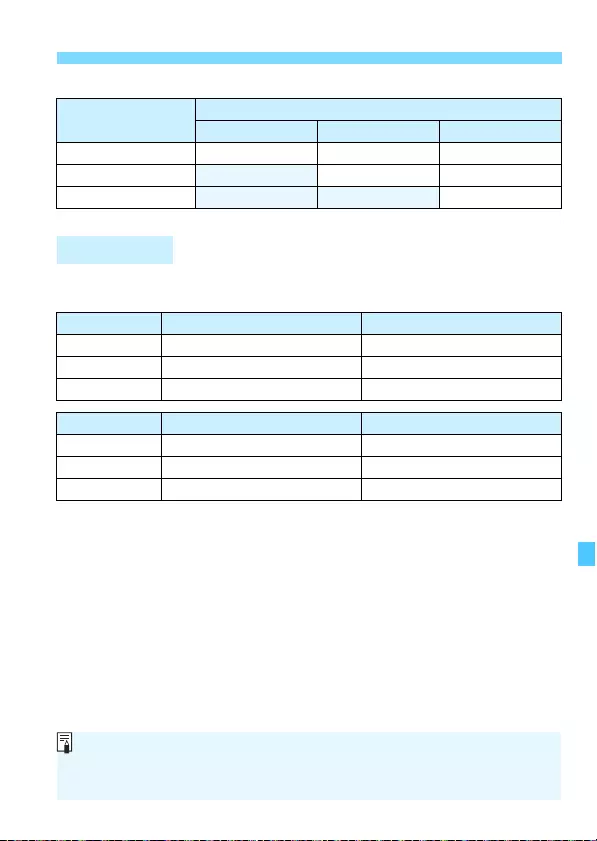
445
S Resizing JPEG Images
Resize Options by Original Image Quality
Sizes for resized images are shown below.
(Approx. pixels)
Original Image
Quality
Available Resize Settings
4a b
3kkk
4kk
ak
Image Sizes
Image Quality Full-frame (3:2) 4:3 (aspect ratio)
44160x2768* (11.5 megapixels) 3680x2768* (10.2 megapixels)
a3120x2080 (6.5 megapixels) 2768x2080* (5.8 megapixels)
b2400x1600 (3.8 megapixels) 2112x1600* (3.4 megapixels)
Image Quality 16:9 (aspect ratio) 1:1 (aspect ratio)
44160x2336* (9.7 megapixels) 2768x2768 (7.7 megapixels)
a3120x1752* (5.5 megapixels) 2080x2080 (4.3 megapixels)
b2400x1344* (3.2 megapixels) 1600x1600 (2.6 megapixels)
The actual aspect ratio of images in the sizes marked with an asterisk “*”
will differ from the aspect ratio indicated.
The image may be cropped slightly depending on the resizing conditions.
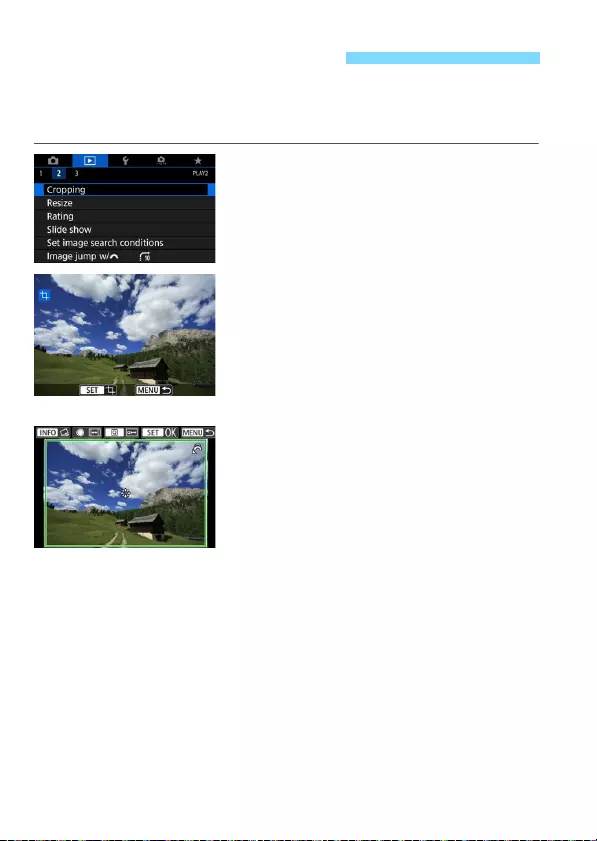
446
You can crop a captured JPEG image and save it as another image.
Cropping an image is possible only with JPEG 3, 4, a, and b
images. Images shot in RAW cannot be cropped.
1Select [Cropping].
Under the [x2] tab, select
[Cropping], then press <0>.
An image will be displayed.
2Select an image.
Turn the <5> dial to select the
image you want to crop.
If you press the <u> button and turn
the <6> dial counterclockwise, you
can select an image from the index
display.
3Set the cropping frame.
Press <0> to display the cropping
frame.
The image area within the cropping
frame will be cropped.
Changing the Cropping Frame Size
Turn the <6> dial to change the cropping frame size. The smaller
the cropping frame, the more magnified the cropped image will look.
Changing the Aspect Ratio and Orientation
Turn the <5> dial to change the cropping frame’s aspect ratio. You
can select the aspect ratio as follows: [3:2], [16:9], [4:3], or [1:1].
Turn the <5> dial to change the orientation of the cropping frame. If
you select [2:3], [9:16], or [3:4], you can crop a horizontal image to
look as if it was shot in vertical orientation.
N Cropping JPEG Images
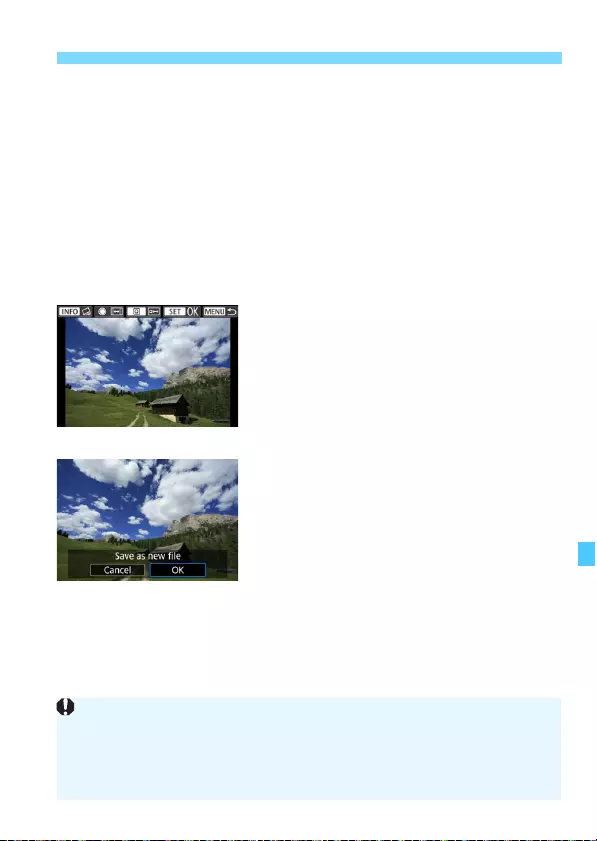
447
N Cropping JPEG Images
Moving the Cropping Frame
Use <9> to move the frame over the image vertically or
horizontally. Move the cropping frame until it covers the desired
image area.
Correcting the Tilt
You can correct image tilt by ±10°. Press the <B> button, then
while checking the tilt against the grid, turn the <5> dial (in 0.1°
increments) or tap the left or right wedge (in 0.5° increments) on the
upper left of the screen to correct the tilt. After completing the tilt
correction, press <0>.
4Check the image area to be
cropped.
Press the <Q> button.
The image area to be cropped will be
displayed.
To return to the original display, press
the <Q> button again.
5Save the image.
Press <0>, then select [OK] to save
the cropped image.
Check the destination folder and
image file number, then select [OK].
To crop another image, repeat steps 2
to 5.
The position and size of the cropping frame may change depending on
the angle set for tilt correction.
Once a cropped image is saved, it cannot be cropped again or resized.
AF point display information (p.397) and Dust Delete Data (p.452) will
not be appended to the cropped images.

448

449
12
Sensor Cleaning
The camera has a Self Cleaning Sensor Unit to
automatically shake off dust adhered to the image
sensor’s front layer (low-pass filter).
The Dust Delete Data can also be appended to the
image so that the dust spots remaining can be deleted
automatically by Digital Photo Professional (EOS
software, p.594).
Smudges adhering to the front of the sensor
Besides dust entering the camera from outside, in rare cases,
lubricant from the camera’s internal parts may adhere to the front of
the sensor. If visible spots still remain after the automatic sensor
cleaning, having the sensor cleaned by a Canon Service Center is
recommended.
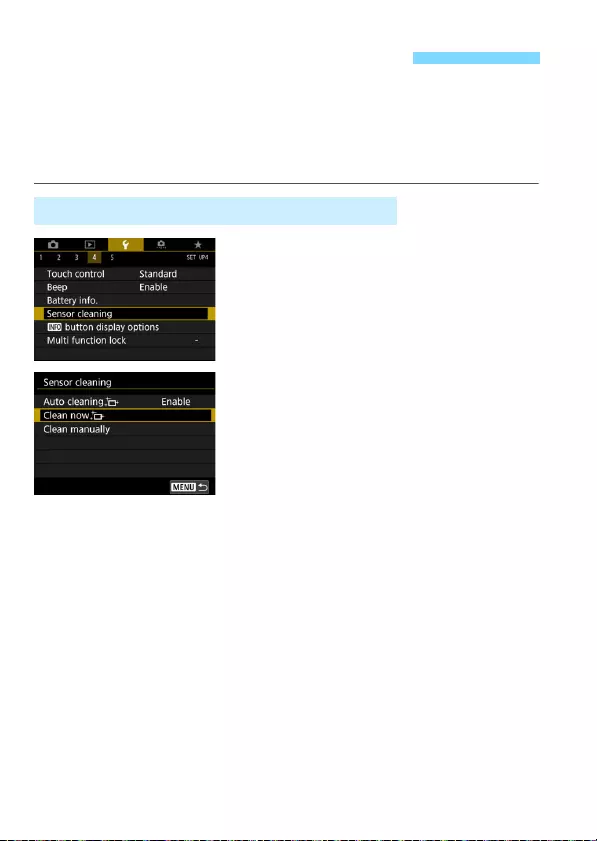
450
Whenever you set the power switch to <1> or <2>, the Self
Cleaning Sensor Unit automatically shakes off the dust on the front of
the sensor. Normally, you need not pay attention to this operation.
However, you can manually perform sensor cleaning or can disable this
unit as follows.
1Select [Sensor cleaning].
Under the [54] tab, select [Sensor
cleaning], then press <0>.
2Select [Clean nowf].
Select [Clean nowf], then press
<0>.
Select [OK].
The screen will indicate that the sensor is being cleaned. (A small
sound may be heard.) Although there will be a mechanical sound of
the shutter during sensor cleaning, the picture will not be recorded to
the card.
After sensor cleaning is finished, the camera will automatically
restart (turn off and on).
f Automatic Sensor Cleaning
Activating the Sensor Cleaning Manually

451
f Automatic Sensor Cleaning
In step 2, select [Auto cleaningf] and set it to [Disable].
The sensor will no longer be cleaned when you set the power switch
to <1> or <2>.
Disabling Automatic Sensor Cleaning
For best results, perform the sensor cleaning with the camera placed
upright and stable on a table or other flat surface.
Even if you repeat the sensor cleaning, the result will not improve much.
Immediately after the sensor cleaning is finished, the [Clean nowf]
option remains disabled temporarily.
Dots of light may appear on images if the sensor is affected by cosmic
rays, etc. By selecting [Clean nowf], their appearance may be
suppressed (p.565).
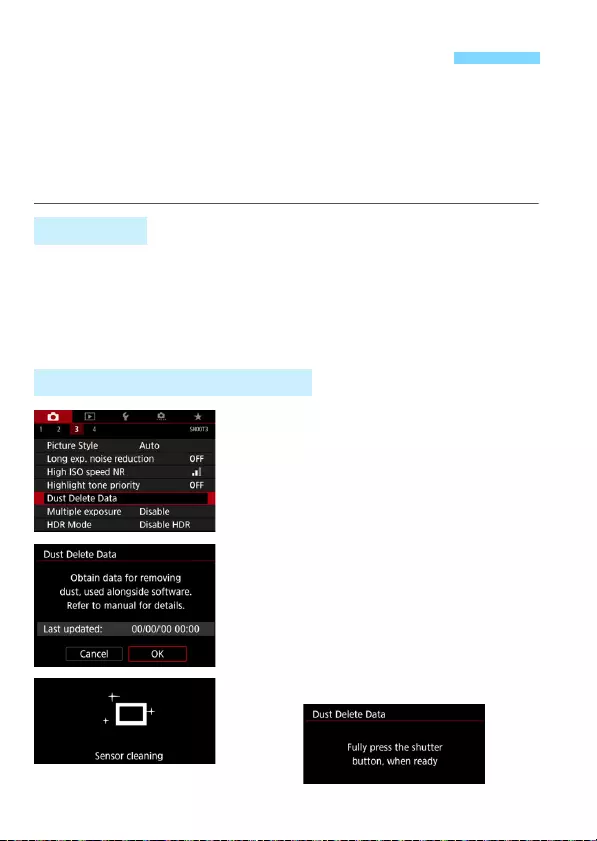
452
Normally, the Self Cleaning Sensor Unit will eliminate most of the dust
that may be visible on captured images. However, for the case where
visible dust still remains, you can append the Dust Delete Data to the
image for erasing the dust spots later. The Dust Delete Data is used by
Digital Photo Professional (EOS software, p.594) to erase the dust
spots automatically.
Prepare a solid white object such as a sheet of paper.
Set the lens focal length to 50 mm or longer.
Set the lens’s focus mode switch to <MF> and set the focus to
infinity (∞). If the lens has no distance scale, rotate the camera to
face toward you and turn the focusing ring clockwise all the way.
1Select [Dust Delete Data].
Under the [z3] tab, select [Dust
Delete Data], then press <0>.
2Select [OK].
After the automatic self-cleaning of
the sensor is performed, a message
will appear. Although there will be a
mechanical sound of the shutter
during the cleaning, no picture is
taken.
3 Appending Dust Delete DataN
Preparation
Obtaining the Dust Delete Data
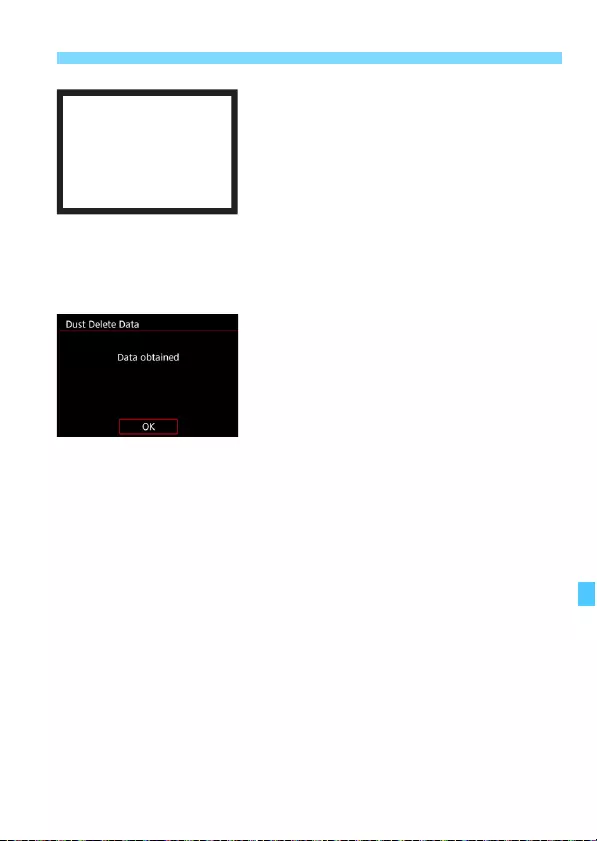
453
3 Appending Dust Delete DataN
3Shoot a solid-white object.
At a distance of 20 cm - 30 cm (0.7 ft.
- 1.0 ft.), fill the viewfinder with a
patternless, solid-white object and
take a picture.
The picture will be taken in aperture-
priority AE mode at an aperture of
f/22.
Since the image will not be saved, the
data can still be obtained even if there
is no card in the camera.
When the picture is taken, the camera
will start collecting the Dust Delete
Data. When the Dust Delete Data is
obtained, a message will appear.
If the data is not obtained
successfully, an error message will
appear. Follow the “Preparation”
procedure on the preceding page,
then select [OK]. Take the picture
again.

454
3 Appending Dust Delete DataN
After the Dust Delete Data is obtained, it is appended to all the JPEG
and RAW images captured thereafter. Before an important shoot, it is
recommended that you update the Dust Delete Data by obtaining it
again.
For details about using Digital Photo Professional (EOS software,
p.594) to erase dust spots automatically, refer to the Digital Photo
Professional Instruction Manual (p.596).
The Dust Delete Data appended to the image is so small that it hardly
affects the image file size.
Dust Delete Data
Be sure to use a solid-white object such as a new sheet of white paper. If the
object has any pattern or design, it may be recognized as dust data and
affect the accuracy of the dust deletion with the Digital Photo Professional
(EOS software).
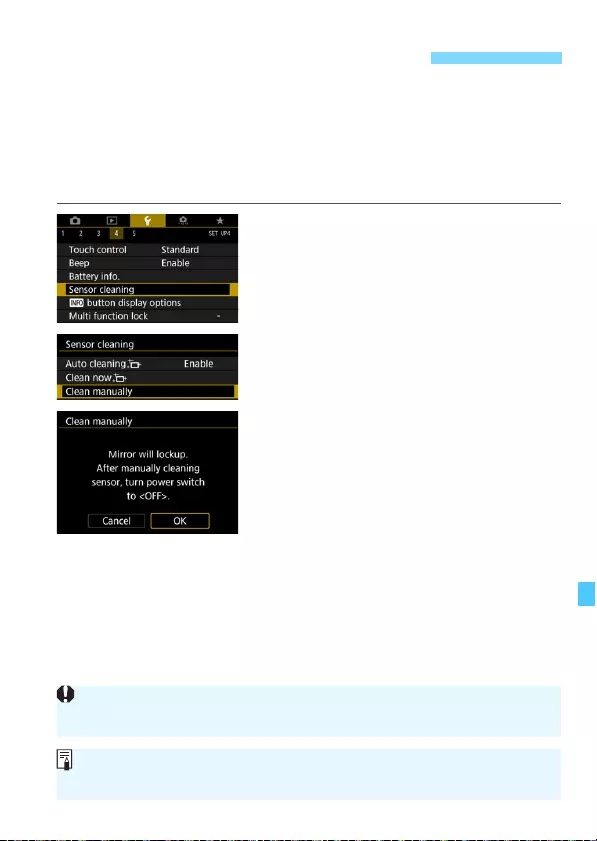
455
Dust that could not be removed by the automatic sensor cleaning can
be removed manually with a commercially-available blower, etc. Before
cleaning the sensor, detach the lens from the camera.
The image sensor is extremely delicate. If the sensor needs to be
cleaned directly, having it done by a Canon Service Center is
recommended.
1Select [Sensor cleaning].
Under the [54] tab, select [Sensor
cleaning], then press <0>.
2Select [Clean manually].
3Select [OK].
In a moment, the reflex mirror will lock
up and the shutter will open.
“CLn” will blink on the LCD panel.
4Clean the sensor.
5End the cleaning.
Set the power switch to <2>.
3 Manual Sensor CleaningN
If you will clean the sensor manually, make sure to use a fully-charged
battery.
Using the household power outlet accessories (sold separately, p.520) is
recommended.

456
3 Manual Sensor CleaningN
While cleaning the sensor, never do any of the following. If the
power is cut off, the shutter will close and the reflex mirror will go
back down. These may result in damaging the image sensor,
shutter curtains, and reflex mirror.
• Setting the power switch to <2>.
• Removing or inserting the battery.
The surface of the image sensor is extremely delicate. Clean the sensor
with care.
Use a plain blower without any brush attached. A brush can scratch the
sensor.
Do not insert the blower tip inside the camera beyond the lens mount. If
the power is turned off, the shutter will close and the shutter curtains or
reflex mirror may get damaged.
Never use pressurized air or gas to clean the sensor. Pressurized air
may damage the sensor, and sprayed gas may freeze on the sensor and
scratch it.
If the battery level becomes low while cleaning the sensor, the beeper
will sound as a warning. Stop cleaning the sensor.
If a smudge that cannot be removed with a blower remains, having the
sensor cleaned by a Canon Service Center is recommended.

457
13
Print order and
Photobook Set-up
Digital Print Order Format (DPOF) (p.458)
You can specify printing instructions such as the image
selection, quantity to print, etc. for the images recorded on
the card.
Specifying Images for a Photobook (p.464)
You can specify the images for printing in a photobook from
those saved on the card.

458
DPOF (Digital Print Order Format) enables you to print images recorded
on the card according to your printing instructions such as the image
selection, quantity to print, etc. You can print multiple images in one
batch or create a print order for a photofinisher.
You can set the print settings such as print type, date imprinting, file
number imprinting, etc. The print settings will be applied to all the
images specified for printing. (They cannot be set individually for each
image.)
1Select [Print order].
Under the [31] tab, select [Print
order], then press <0>.
2Select [Set up].
3Set the options as desired.
Set the [Print type], [Date], and [File
No.].
Select the option to be set, then press
<0>. Select the desired setting,
then press <0>.
W Digital Print Order Format (DPOF)
3 Setting the Printing Options
Print type Date File number

459
W Digital Print Order Format (DPOF)
4Exit the setting.
Press the <M> button.
The print order screen will reappear.
Next, select [Sel.Image] or [Multiple]
to order the images to be printed.
Print type
KStandard Prints one image on one sheet.
LIndex Multiple thumbnail images are printed on
one sheet.
K
LBoth Prints both the standard and index prints.
Date On [On] imprints the recorded date of the captured
image.
Off
File number On [On] imprints the file number.
Off

460
W Digital Print Order Format (DPOF)
RAW images or movies cannot be specified for printing.
If you print an image with a large image size using the [Index] or [Both]
setting (p.458), the index print may not be printed with certain printers. In
such a case, resize the image (p.444), then print the index print.
Even if [Date] and [File No.] are set to [On], the date or file number may
not be imprinted, depending on the print type setting and printer.
With [Index] prints, the [Date] and [File No.] cannot both be set to [On]
at the same time.
When printing with DPOF, use the card for which print order
specifications are set. You cannot print in the specified print order if you
extract just the images from the card for printing.
Certain DPOF-compliant printers and photofinishers may not be able to
print the images as you specified. Refer to the printer’s instruction
manual before printing, or check with your photofinisher about
compatibility when ordering prints.
While installing images into this camera, do not specify a new print order
for images that had a print order set by a different camera. All the print
orders may be overwritten inadvertently. Also, the print order may not be
possible, depending on the image type.
You can send images from the camera via Wi-Fi to a PictBridge-compatible
(Wireless LAN) printer and print the images (direct printing). For details,
refer to the “Wi-Fi (Wireless Communication) Function Instruction Manual”
(p.4).
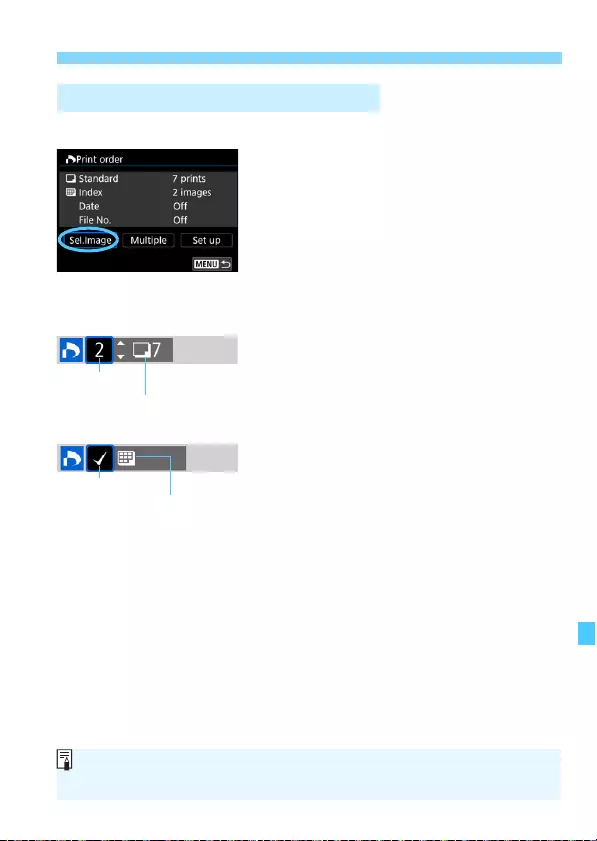
461
W Digital Print Order Format (DPOF)
Selecting Images
Select and specify the images one by
one.
If you press the <u> button and turn the
<6> dial counterclockwise, you can
select an image from a three-image
display. To return to the single-image
display, turn the dial clockwise.
Press the <M> button to save the
print order to the card.
Standard / Both
Press <0> to print a copy of the
displayed image. By pressing the <W>
<X> keys, you can set the number of
copies to be printed up to 99.
Index
Press <0> to add a checkmark to the
box [X]. The image will be included in
the index print.
3 Specifying Images for Printing
Quantity
Total images selected
Index icon
Checkmark
If the search conditions are set with [32: Set image search conditions]
(p.402), only the found images will be displayed.

462
W Digital Print Order Format (DPOF)
Selecting Multiple Images
Select Range
Under [Multiple], select [Select
range]. Select the first and last
images of the desired range, then all
the images in the range will be
marked with the checkmark [X]. A
print order for one copy of each
image will be set.
If an image marked with [X] is set as
the first image, the images with [X]
within the range from the first image
to the last will be canceled. (The
specified range will have no [X].)
All Images in a Folder
Select [Mark all in folder] and select the folder. A print order for one
copy of all the images in the folder will be specified.
If you select [Clear all in folder] and select the folder, the print order
for all the images in the folder will be canceled.
All Images on a Card
If you select [Mark all on card], one copy of all the images on the
card will be specified for printing.
If you select [Clear all on card], the print order will be cleared for all
the images on the card.

463
W Digital Print Order Format (DPOF)
If the search conditions are set with [32: Set image search
conditions] (p.402) and you select [Multiple], the display will change to
[Mark all found images] and [Clear all found images].
All found images
If you select [Mark all found
images], a print order for one copy of
all the images filtered by the search
will be set.
If you select [Clear all found
images], the print order will be
cleared for all the found images.
RAW images or movies cannot be specified for printing. Note that RAW
images or movies will not be specified for printing even if you specify all
images with [Multiple].
When using a PictBridge-compatible printer, do not specify more than
400 images for one print order. If you specify more than this, the images
may not all be printed.
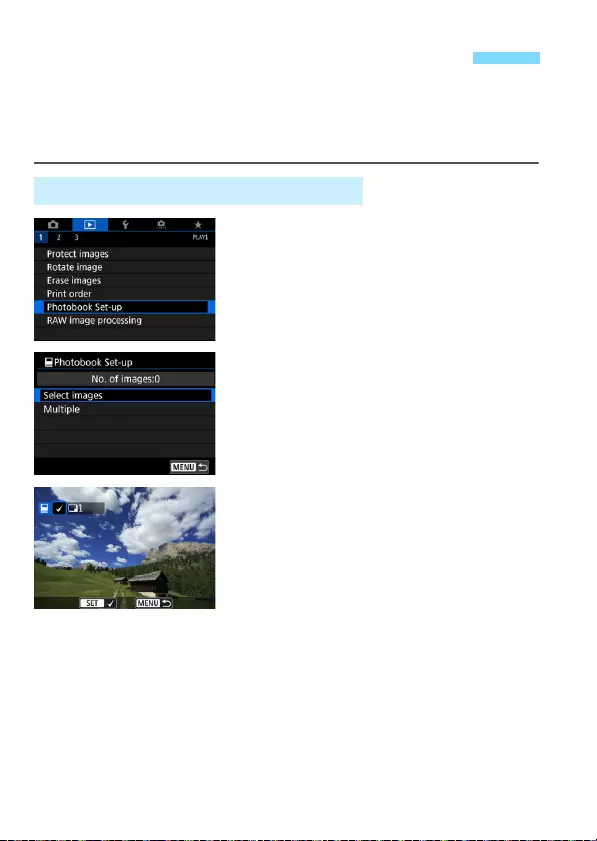
464
You can specify up to 998 images to be printed in a photobook. When
you use EOS Utility (EOS software) to transfer images to a computer,
the specified images for a photobook will be copied to a dedicated
folder. This function is useful for ordering photobooks online.
1Select [Photobook Set-up].
Under the [x1] tab, select
[Photobook Set-up], then press
<0>.
2Select [Select images].
3Select the image to be specified.
Turn the <5> dial to select the
image to be specified for a
photobook, then press <0>.
If you press the <u> button and turn
the <6> dial counterclockwise, you
can select an image from a three-
image display. To return to the single-
image display, turn the dial clockwise.
To select other images to be specified
for a photobook, repeat step 3.
p Specifying Images for a Photobook
3 Specifying One Image at a Time
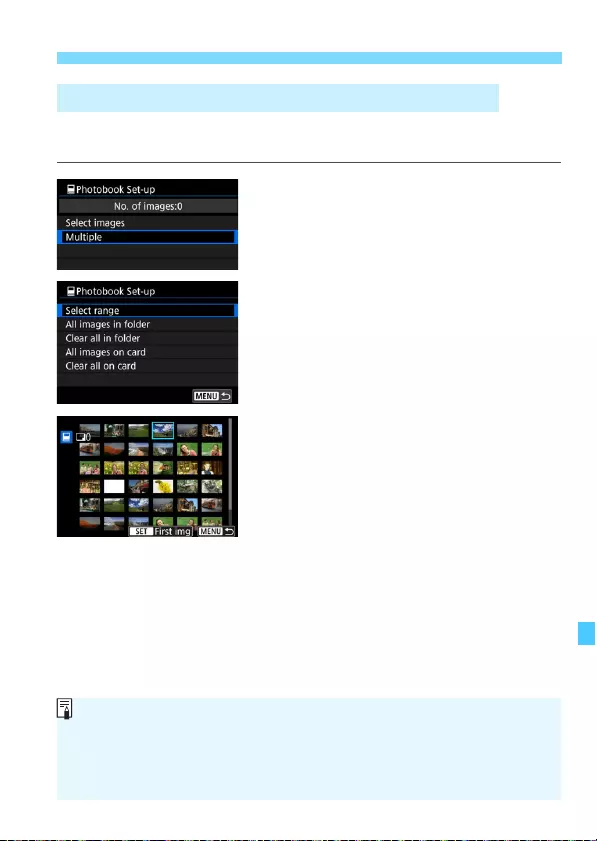
465
p Specifying Images for a Photobook
While looking at the images in the index display, you can specify the
first and last images for a range to all the specified images at once.
1Select [Multiple].
Under [31: Photobook set-up],
select [Multiple], then press <0>.
2Select [Select range].
3Specify the range of images.
Select the first image (start point),
then press <0>.
Next, select the last image (end
point), then press <0>.
A checkmark [X] will be appended to
all the images within the specified
range.
To select other images to be specified
for a photobook, repeat step 3.
3 Specifying the Image Range for a Photobook
If the search conditions are set with [32: Set image search
conditions] (p.402), only the found images will be displayed.
If an image marked with the checkmark [X] is set as the first image, the
images with [X] within the range from the first image to the last will be
canceled. (The specified range will have no [X].)
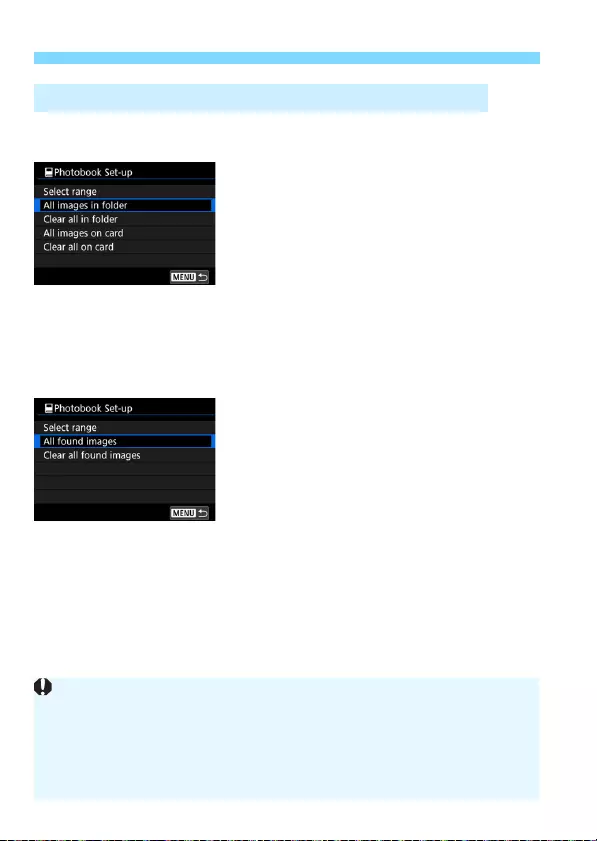
466
p Specifying Images for a Photobook
You can specify all the images in a folder or on a card at once for a
photobook.
Under [x1: Photobook Set-up], you
can set [Multiple] to [All images in
folder] or [All images on card] to
specify all the images in the folder or on
the card for a photobook.
To cancel the selection, select [Clear all
in folder] or [Clear all on card].
If the search conditions are set with [32: Set image search
conditions] (p.402) and you select [Multiple], the display will change to
[All found images] and [Clear all found images].
If you select [All found images], all the
found images will be specified for the
photobook.
If you select [Clear all found images],
all the found images will be cleared for
the photobook.
3 Specifying All Images in a Folder or on a Card
RAW images or movies cannot be specified for the photobook. Note that
RAW images or movies will not be specified for the photobook even if
you specify all images with [Multiple].
Do not specify images already specified for a photobook in another
camera for another photobook with this camera. All the photobook
settings may be overwritten inadvertently.
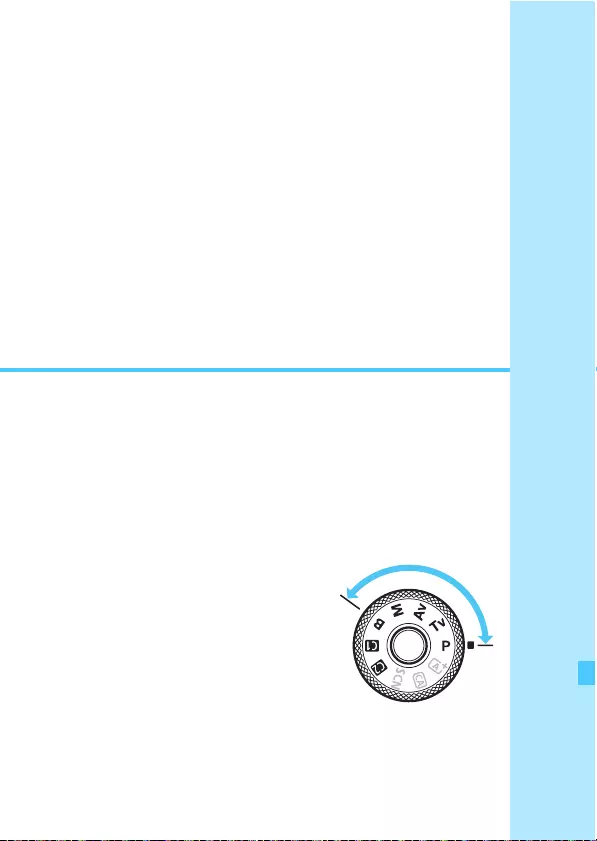
467
14
Customizing the
Camera
You can make fine adjustments to various camera
functions and change the functionality of buttons and
dials to suit your picture-taking preferences with
Custom Functions and Custom Controls.
You can also save the camera’s current settings to the
<w> and <x> modes.
The functions described in this chapter are settable and
usable in Creative Zone modes.
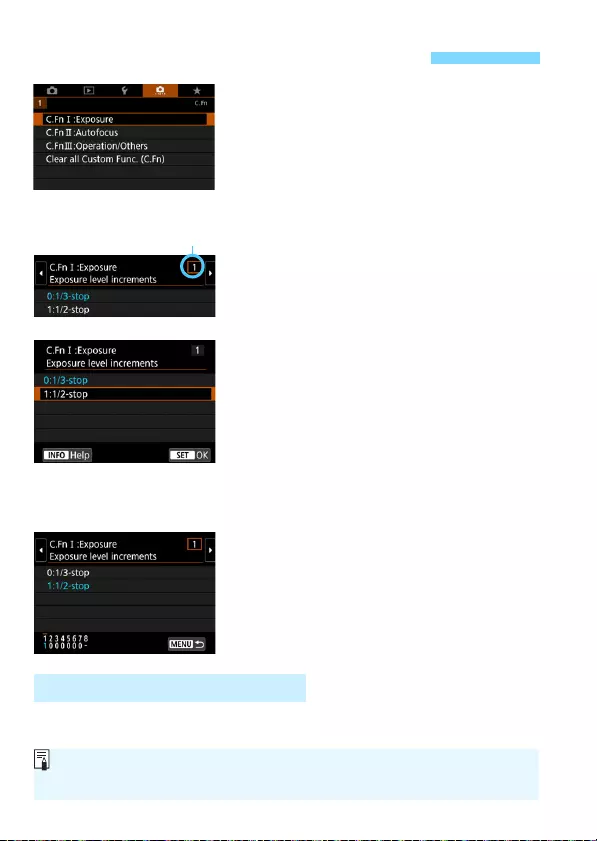
468
1Select the [8] tab.
2Select the desired group.
Select [C.Fn I: Exposure], [C.Fn II:
Autofocus], or [C.Fn III: Operation/
Others], then press <0>.
3Select the Custom Function
number.
Press the <Y> <Z> keys to select
the Custom Function number, then
press <0>.
4Change the setting as desired.
Press the <W> <X> keys to select
the desired setting (number), then
press <0>.
Repeat steps 2 to 4 if you want to set
another Custom Function.
At the bottom of the screen, the current
Custom Function settings are indicated
below the respective function numbers.
5Exit the setting.
Press the <M> button.
The screen in step 2 will reappear.
In step 2, selecting [Clear all Custom Func. (C.Fn)] will clear all the
Custom Function settings.
3 Setting Custom FunctionsN
Custom Function number
Clearing All Custom Functions
Even if you perform [Clear all Custom Func.(C.Fn)], the settings for
[8C.Fn III-4: Custom Controls] will not be cleared.
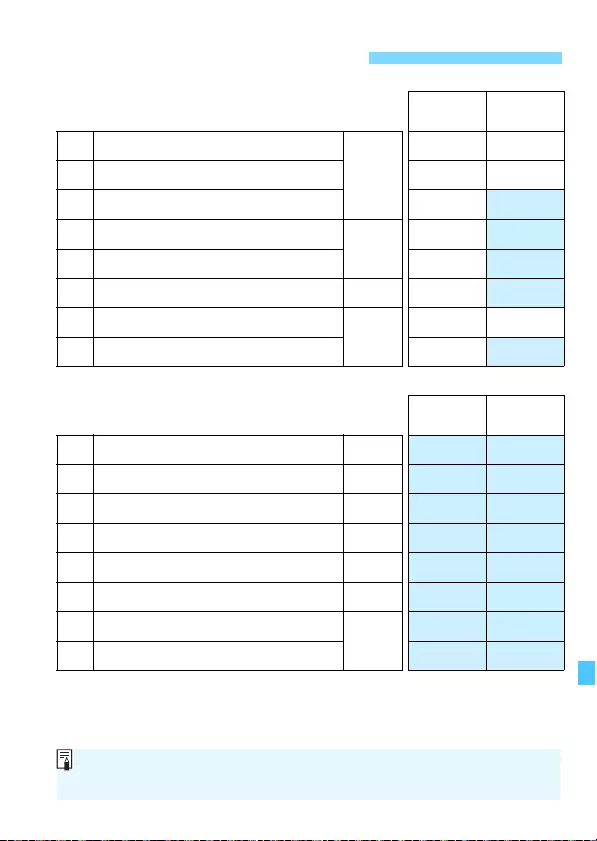
469
*1: If an EX-series Speedlite (sold separately) equipped with an LED light is used,
the AF-assist light will turn on when necessary.
*2: Enabled only with time-lapse movie shooting.
3 Custom FunctionsN
C.Fn I: Exposure A LV
Shooting
k
Movie
Shooting
1Exposure level increments
p.471
k k
2 ISO speed setting increments kIn a
3Bracketing auto cancel k
4Bracketing sequence
p.472
k
5 Number of bracketed shots k
6Safety shift p.473 k
7Exposure compensation auto cancel
p.474
k k
8 Metering mode, AE locked after focus k
C.Fn II: AF A LV
Shooting
k
Movie
Shooting
1 Tracking sensitivity p.475
2Acceleration/deceleration tracking p.476
3AF point auto switching p.477
4 AI Servo 1st image priority p.478
5AI Servo 2nd image priority p.479
6AF-assist beam firing p.480 *1 *1*2
7 Lens drive when AF impossible
p.481
8Select AF area selection mode
Shaded Custom Functions do not function during Live View (LV) shooting or
movie shooting. (Settings are disabled.)
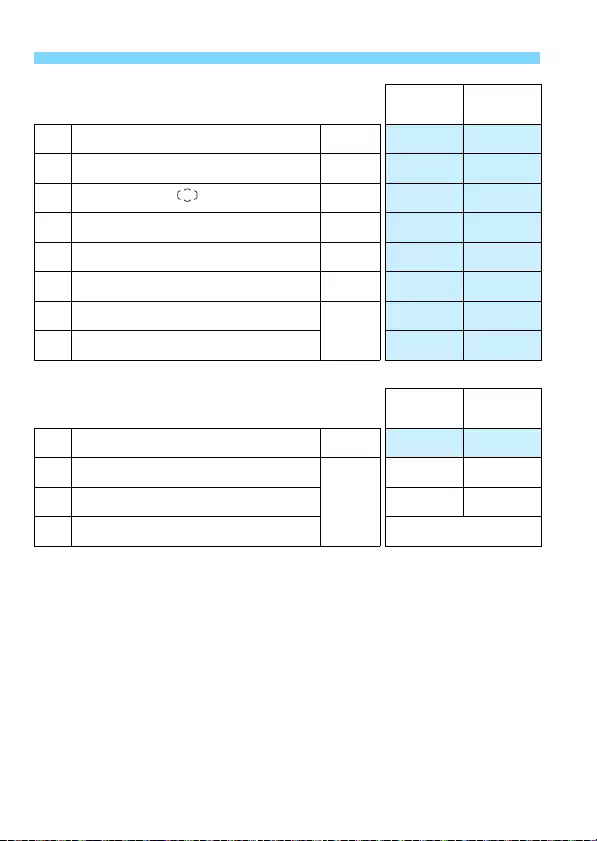
470
3 Custom FunctionsN
C.Fn II: AF A LV
Shooting
k
Movie
Shooting
9AF area selection method p.482
10 Orientation linked AF point p.483
11 Initial AF point, AI Servo AF p.484
12 Auto AF point selection: Color p.485
13 AF point selection movement p.486
14 AF point display during focus p.487
15 Viewfinder display illumination
p.488
16 AF Microadjustment
C.Fn III: Operation/Others A LV
Shooting
k
Movie
Shooting
1 Warnings z in viewfinder p.489
2 Dial direction during Tv/Av
p.490
kk
3 Retract lens on power off kk
4 Custom Controls Depends on setting

471
3
Custom Function Settings
N
C.Fn I: Exposure
C.Fn I-1 Exposure level increments
0: 1/3-stop
1: 1/2-stop
Sets 1/2-stop increments for the shutter speed, aperture, exposure
compensation, AEB, flash exposure compensation, etc.
C.Fn I-2 ISO speed setting increments
0: 1/3-stop
1: 1-stop
You can change the manual ISO speed setting increments to a
whole-stop.
C.Fn I-3 Bracketing auto cancel
0: Enable
When you set the power switch to <2>, the AEB and white
balance bracketing settings will be canceled. AEB settings will also
be canceled when the flash is ready to fire or if you switch to movie
shooting.
1: Disable
The AEB and white balance bracketing settings will not be
canceled even if you set the power switch to <2>. (If the flash
is ready to fire or if you switch to movie shooting, AEB will be
canceled temporarily, but the AEB range will be retained.)
When [1:1/2-stop] is set, the display will be as shown below.
Even if [1: 1-stop] is set, ISO speed will be automatically set in 1/3-stop
increments when ISO Auto is set.
Even when [1: 1-stop] is set, you can set ISO 40000 (for still photo
shooting).

472
3 Custom Function SettingsN
C.Fn I-4 Bracketing sequence
The AEB shooting sequence and white balance bracketing sequence
can be changed.
0: 09-9+
1: -909+
2: +909-
C.Fn I-5 Number of bracketed shots
The number of shots taken with AEB and white balance bracketing can
be changed from the default 3 shots, to 2, 5, or 7 shots.
When [8C.Fn I-4: Bracketing sequence] is set to [0, -, +], the
bracketed shots will be taken as shown in the table below.
0: 3 shots 2: 5 shots
1: 2 shots 3: 7 shots
(1-stop/step increments)
AEB White Balance Bracketing
B/A Direction M/G Direction
0 : Standard exposure 0 : Standard white balance
0 : Standard white balance
- : Decreased exposure
- : Blue bias - : Magenta bias
+ : Increased exposure
+ : Amber bias + : Green bias
1st Shot 2nd Shot 3rd Shot 4th Shot 5th Shot 6th Shot 7th Shot
3: 3 shots
Standard (0)
-1 +1
2: 2 shots
Standard (0)
±1
5: 5 shots
Standard (0)
-2 -1 +1 +2
7: 7 shots
Standard (0)
-3 -2 -1 +1 +2 +3
If [1: 2 shots] is set, you can select the + or - side when setting the AEB
range. With WB bracketing, the 2nd shot will be adjusted toward either the
B/A or M/G direction.

473
3 Custom Function SettingsN
C.Fn I-6 Safety shift
0: Disable
1: Shutter speed/Aperture
Takes effect in the <s> shutter-priority AE and <f> aperture-
priority AE modes. If the subject brightness changes and the
standard exposure cannot be obtained within the autoexposure
range, the camera will automatically change the manually-selected
setting to obtain the standard exposure.
2: ISO speed
Works in the <d> Program AE, <s> shutter-priority AE, and
<f> aperture-priority AE modes. If the subject brightness
changes and the standard exposure cannot be obtained within the
autoexposure range, the camera will automatically change the
manually set ISO speed to obtain the standard exposure.
Under [z2: zISO speed settings], even if [ISO speed range] or [Min.
shutter spd.] is changed from the default setting, safety shift will
override it if the standard exposure cannot be obtained.
The minimum and maximum limits for the safety shift with the ISO speed
are determined by [Auto range] under [z2: zISO speed settings]
(p.174). However, if the manually set ISO speed exceeds the [Auto
range], the safety shift will take effect up or down to the manually set ISO
speed.
Safety shift will take effect as necessary even when flash is used.
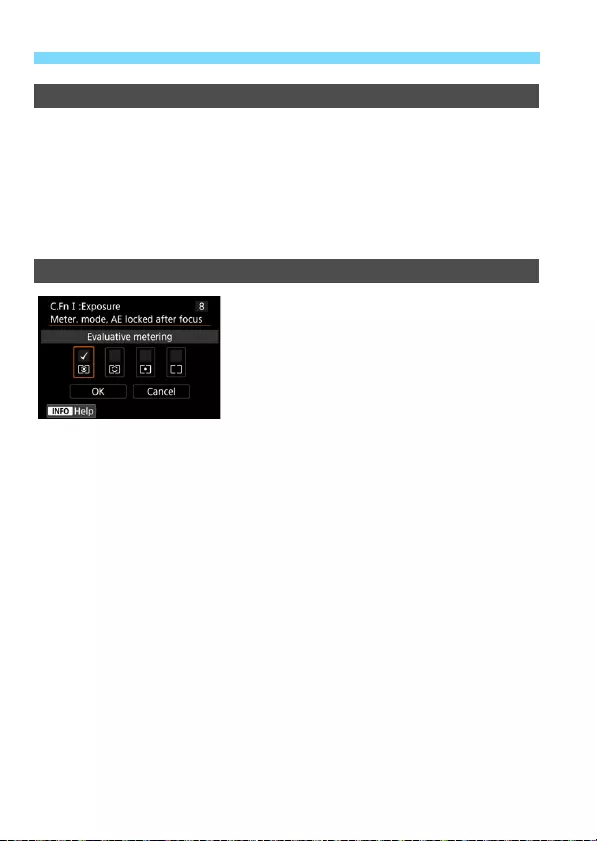
474
3 Custom Function SettingsN
C.Fn I-7 Exposure compensation auto cancel
0: Disable
The exposure compensation setting will not be canceled even if
you set the power switch to <2>.
1: Enable
When you set the power switch to <2>, the exposure
compensation setting will be canceled.
C.Fn I-8 Metering mode, AE locked after focus
For each metering mode, you can set
whether to lock the exposure (AE lock)
after achieving focus with One-Shot AF by
pressing the shutter button halfway. The
exposure will be locked while you keep
pressing the shutter button halfway.
Checkmark [X] the metering modes for
when AE lock is to be applied. Select a
metering mode [q/w/r/e], then press
<0> to append a checkmark [X]. Select
[OK] to register the setting.
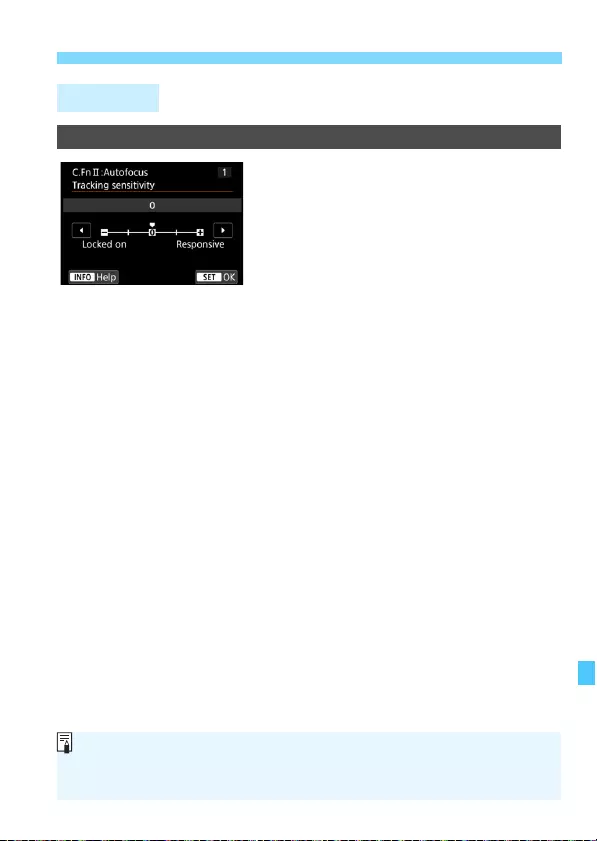
475
3 Custom Function SettingsN
C.Fn II: AF
C.Fn II-1 Tracking sensitivity
Sets the subject-tracking sensitivity during
AI Servo AF when an obstacle cuts across
the AF points or when the subject strays
from the AF point.
0
Default setting. Suitable for moving subjects in general.
Locked on: -2 / Locked on: -1
The camera will try to continue focusing on the subject even if an
obstacle cuts across the AF points or if the subject strays from the
AF points. The -2 setting makes the camera keep tracking the
target subject longer than the -1 setting.
However, if the camera focuses on a wrong subject, it may take
slightly longer to switch and focus on the target subject.
Responsive: +2 / Responsive: +1
The camera can focus consecutively on subjects at different
distances that are covered by the AF points. Also effective when
you want to always focus on the closest subject. The +2 setting is
more responsive than the +1 setting when focusing on the next
subject.
However, the camera will be more prone to focus on an
unintended subject.
[8C.Fn II-1: Tracking sensitivity] is the same feature as [AI Servo
tracking sensitivity] in the EOS-1D Mark III/IV, EOS-1Ds Mark III, and
EOS 7D.

476
3 Custom Function SettingsN
C.Fn II-2 Acceleration/deceleration tracking
This sets the tracking sensitivity for moving
subjects whose speed can momentarily
change dramatically by starting or stopping
suddenly, etc.
0
Suited for subjects that move at a steady speed (minor changes in
moving speed).
+2 / +1
Effective for subjects having sudden movements, sudden
acceleration/deceleration, or sudden stops. Even if the moving
subject’s speed suddenly changes dramatically, the camera
continues to focus on the target subject. For example, for an
approaching subject, the camera becomes less prone to focus
behind it to avoid subject blur. For a subject stopping suddenly, the
camera becomes less prone to focus in front of it. Setting +2 can
track dramatic changes in the moving subject’s speed better than
with +1.
However, since the camera will be sensitive to even slight
movements of the subject, focusing may become unstable for
short periods.

477
3 Custom Function SettingsN
C.Fn II-3 AF point auto switching
This sets the switching sensitivity of the AF
points as they track the subject moving
dramatically up, down, left, or right.
This setting takes effect when the AF area
selection mode is set to Zone AF, Large
Zone AF, or Automatic selection AF.
0
Standard setting for gradual AF point switching.
+2 / +1
Even if the target subject moves dramatically up, down, left, or
right and moves away from the AF point, the camera switches its
focus to neighboring AF points to continue focusing on the subject.
The camera switches to the AF point deemed most likely to focus
on the subject based on the subject’s continual movement,
contrast, etc. Setting +2 makes the camera more prone to switch
the AF point than with +1.
However, with a wide-angle lens having a wide depth of field or if
the subject is too small in the frame, the camera may focus with an
unintended AF point.

478
3 Custom Function SettingsN
C.Fn II-4 AI Servo 1st image priority
You can set the AF operation
characteristics and shutter-release timing
for the first shot with AI Servo AF.
Equal priority
Equal priority is given to focusing and shutter release.
: Release priority
Pressing the shutter button takes the picture immediately even if
focus has not been achieved. Useful when you want to give priority
to capturing the decisive moment rather than achieving focus.
: Focus priority
Pressing the shutter button does not take the picture until focus is
achieved. Useful when you want to achieve focus before capturing
the image.
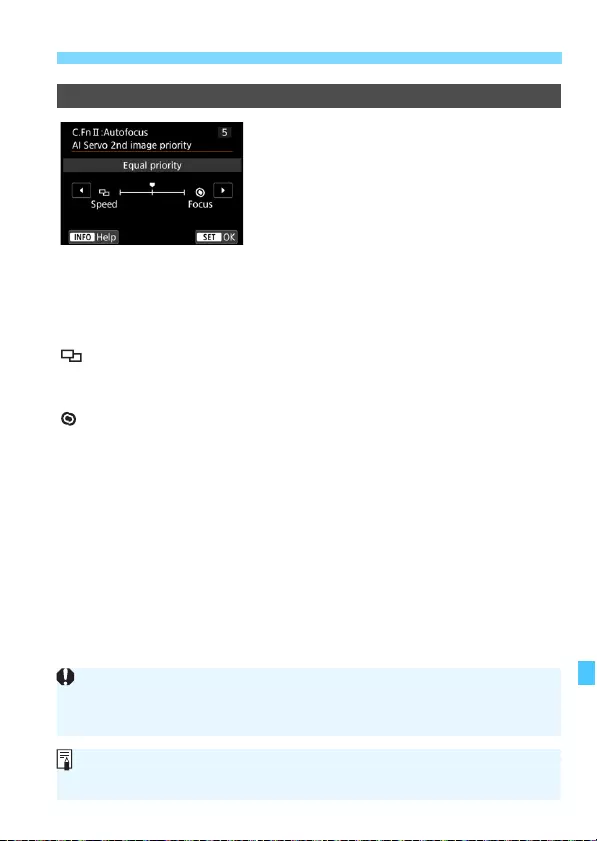
479
3 Custom Function SettingsN
C.Fn II-5 AI Servo 2nd image priority
With AI Servo AF for continuous shooting,
you can preset the AF operation
characteristics and shutter-release timing
for the subsequent shots after the first shot
in continuous shooting.
Equal priority
Equal priority is given to focusing and continuous shooting speed.
In low light or with low-contrast subjects, continuous shooting
speed may slow down.
: Shooting speed priority
Priority is given to the continuous shooting speed instead of
achieving focus.
: Focus priority
Priority is given to achieving focus instead of the continuous
shooting speed. The picture will not be taken until focus is
achieved.
Even if [Shooting speed priority] is set, under shooting conditions that
activate flicker reduction (p.206), the continuous shooting speed may
become slower or the shooting interval may become irregular.
If focus cannot be achieved in low-light conditions when [Equal priority] is
set, setting [Focus priority] may give better results.

480
3 Custom Function SettingsN
C.Fn II-6 AF-assist beam firing
Enables or disables the EOS-dedicated external Speedlite’s AF-assist
beam.
0: Enable
The external Speedlite emits the AF-assist beam when necessary.
1: Disable
The external Speedlite will not emit the AF-assist beam. This
prevents the AF-assist beam from disturbing others.
2: IR AF assist beam only
When an external Speedlite is attached, only the infrared AF-assist
beam will be emitted. Useful when you do not want to fire a series
of small flashes as the AF-assist light (Intermittent flash method).
With an EX-series Speedlite equipped with an LED light, the LED
light will not automatically turn on as the AF-assist beam.
If an external Speedlite’s [AF-assist beam firing] Custom Function is set to
[Disable], this function’s setting will be overridden and the AF-assist beam
will not be emitted.
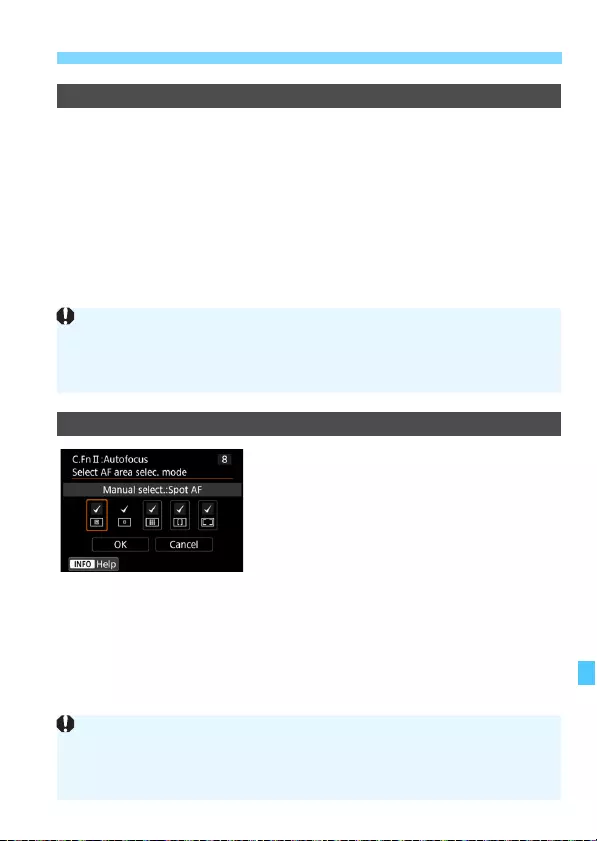
481
3 Custom Function SettingsN
C.Fn II-7 Lens drive when AF impossible
If focus cannot be achieved with autofocus, you can have the camera
keep searching for the precise focus or have it stop searching.
0: Continue focus search
If focus cannot be achieved with autofocus, the lens is driven to
search for the precise focus.
1: Stop focus search
If autofocus starts and the focus is far off or if focus cannot be
achieved, the lens drive will not be performed. This prevents the lens
from becoming grossly out of focus due to the focus search drive.
C.Fn II-8 Select AF area selection mode
You can limit the selectable AF area
selection modes to suit your shooting
preferences. Select the desired AF area
selection mode and press <0> to add a
checkmark [X]. Then select [OK] to
register the setting.
The AF area selection modes are
described on pages 134-135.
N: Manual select.:Spot AF
E: Manual selection:1 pt AF
F: Manual select.:Zone AF
G: Manual select.:Large Zone AF
H: Auto selection AF
When focus search drive is performed using a super telephoto lens or a lens
with a wide focusing drive range, the lens can become grossly out of focus,
and it may take more time to achieve focus next time. Setting [1: Stop
focus search] is recommended.
The [X] mark cannot be removed from [Manual selection:1 pt AF].
If the attached lens belongs to group G or H, you cannot use certain AF
area selection modes even if you add a checkmark [X] in [Select AF
area selec. mode].

482
3 Custom Function SettingsN
C.Fn II-9 AF area selection method
You can set the method for changing the AF area selection mode.
0: S 9 AF area selection button
After you press the <S> or <B> button, pressing the <B>
button will change the AF area selection mode.
1: S 9 Main Dial
After you press the <S> or <B> button, turning the <6> dial
will change the AF area selection mode.
When [1: S9Main Dial] is set, use the <9> to move the AF point
horizontally.

483
3 Custom Function SettingsN
C.Fn II-10 Orientation linked AF point
You can set the AF point or the AF area selection mode + AF point
separately for vertical shooting and horizontal shooting.
0: Same for both vert/horiz
The same AF area selection mode and manually-selected AF point
(or zone) are used for both vertical shooting and horizontal shooting.
1: Separate AF pts: Area+pt
The AF area selection mode and AF point (or zone) can be set
separately for each camera orientation (1. Horizontal, 2. Vertical with the
camera grip at the top, 3. Vertical with the camera grip at the bottom).
When you manually select the AF area selection mode and AF
point (or zone) for each of the three camera orientations, they will
be registered for the respective orientation. Whenever you change
the camera orientation during shooting, the camera will switch to
the AF area selection mode and manually-selected AF point (or
zone) set for that orientation.
2: Separate AF pts: Pt only
The AF point can be set separately for each camera orientation (1.
Horizontal, 2. Vertical with the camera grip at the top, 3. Vertical
with the camera grip at the bottom). While using the same AF area
selection mode, the AF point will switch automatically for the
respective camera orientation.
When you manually select the AF point for each of the three camera
orientations, it will be registered for the respective orientation.
During shooting, the AF point will switch to the manually-selected
one depending on the camera orientation. By changing the AF area
selection mode to Single-point Spot AF or Single-point AF, the AF
point set for the respective orientation can be retained.
If you change the AF area selection mode to Zone AF or Large
Zone AF, the zone will switch to the manually-selected one for the
respective camera orientation.
If [8: Clear all Custom Func. (C.Fn)] is selected (p.468), the settings
for the 1., 2., and 3. orientations will be cleared.
If you set this function and later attach a lens from a different AF group
(p.145-148, particularly Group H), the setting may be cleared.
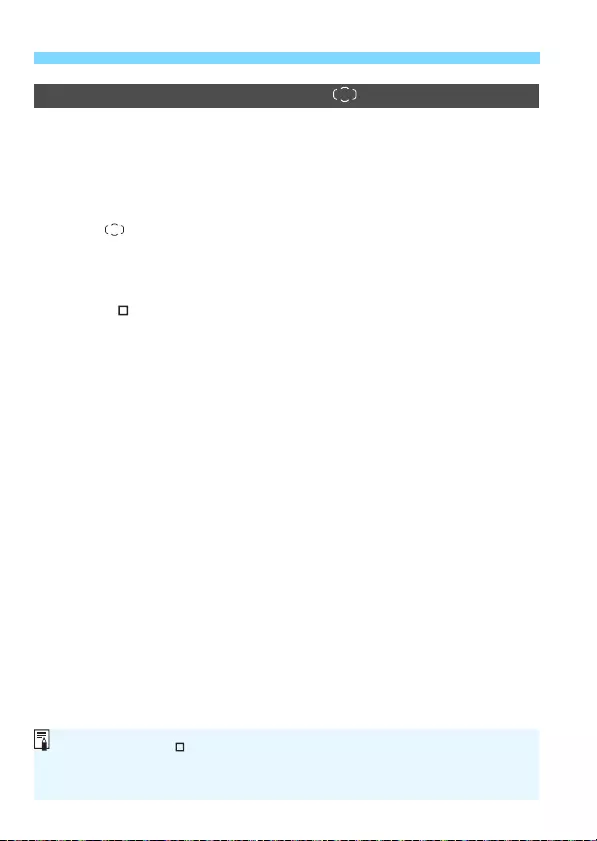
484
3 Custom Function SettingsN
C.Fn II-11 Initial AF Point, AI Servo AF
You can set the AI Servo AF’s starting AF point for when the AF area
selection mode is set to Auto selection AF.
0: Auto
The AF point that AI Servo AF starts with is set automatically to
suit the shooting conditions.
1: Initial AF pt selected
AI Servo AF will start with the manually-selected AF point when
the AF operation is set to AI Servo AF and the AF area selection
mode is set to Auto selection AF.
2: Manual AF pt
If you switch from Single-point Spot AF or Single-point AF to Auto
selection AF, AI Servo AF will start with the AF point that was
manually selected before the switch. Useful if you want AI Servo
AF to start with the AF point that was selected before the AF area
selection mode is switched to Auto selection AF.
When [2: Manual AF pt] is set, AI Servo AF will start with the zone
corresponding to the manually-selected AF point even if the AF area
selection mode is switched to Zone AF or Large Zone AF.

485
3 Custom Function SettingsN
C.Fn II-12 Auto AF point selection: Color tracking
Use this function to autofocus by recognizing colors equivalent to skin
tones. This function works when the AF area selection mode is set to
Zone AF (manual selection of zone), Large Zone AF (manual selection
of zone), or Automatic selection AF.
0: Enable
The camera selects AF points automatically based on AF
information and information on colors equivalent to skin tones.
In One-Shot AF mode, focusing on a still human subject in the AF
area is made easier.
In AI Servo AF mode, focusing on a human subject in the AF area
is made easier. If no skin tones can be detected, the nearest
subject will be focused on. Once focus is achieved, AF points are
automatically selected so that the camera continues to focus on
the color of the area it focused on first.
1: Disable
AF points are automatically selected based only on AF
information.
With setting [0: Enable], focusing will take slightly longer than with
setting [1: Disable].
Even with setting [0: Enable], the expected result may not be obtained
depending on the shooting conditions and subject.
Under so low light that the EOS-dedicated, external Speedlite emits the
AF-assist beam automatically, AF points are selected automatically
based only on AF information. (Human skin-tone color information is not
used for AF.)

486
3 Custom Function SettingsN
C.Fn II-13 AF point selection movement
You can set either to stop the selection at the outer edge or it can cycle
around to the opposite side in AF point selection.
0: Stops at AF area edges
Useful if you often use an AF point along the edge.
1: Continuous
Instead of stopping at the outer edge, the selection of AF point
continues to the opposite side.
With [8C.Fn II-11: Initial AF pt, AI Servo AF] set to [1: Initial AF
pt selected], the above setting will also work when you are selecting the
initial AF point for AI Servo AF.
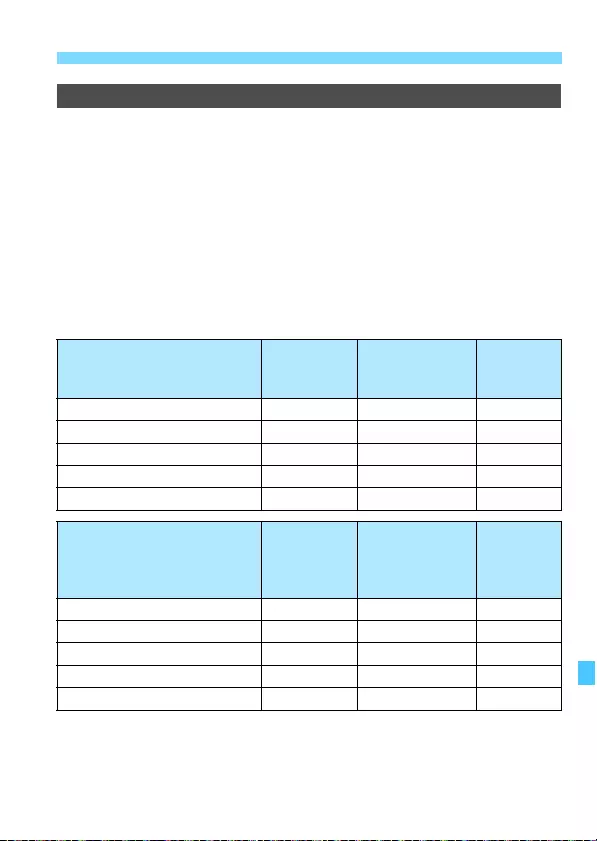
487
3 Custom Function SettingsN
C.Fn II-14 AF point display during focus
You can set whether to display the AF point(s) before AF starts
(shooting ready), when AF starts, during AF, when focus is achieved,
and when the metering timer is active after focus is achieved.
0 : Selected (constant)
1 : All (constant)
2 : Selected (pre-AF,focused)
3 : Selected AF pt (focused)
4 : Disable display
k: Displayed, l: Not displayed
AF point display during focus
With AF
point
selected
Before AF starts
(shooting ready) At AF start
0: Selected (constant) kkk
1: All (constant) kkk
2: Selected (pre-AF,focused) kkk
3: Selected AF pt (focused) klk
4: Disable display kll
AF point display during focus During AF Focus achieved
Metering
active after
achieving
focus
0: Selected (constant) kkk
1: All (constant) kkk
2: Selected (pre-AF,focused) lkk
3: Selected AF pt (focused) lkl
4: Disable display lll
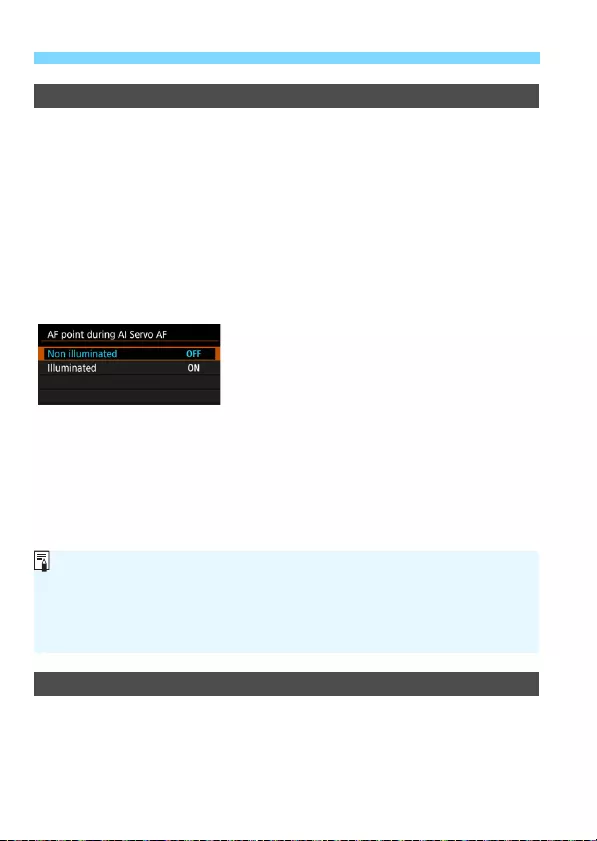
488
3 Custom Function SettingsN
C.Fn II-15 Viewfinder display illumination
You can set whether the AF points in the viewfinder will light up in red
when focus is achieved.
0: Auto
The AF points achieving focus in low light or with a dark subject
will automatically light up in red.
1: Enable
The AF points light up in red regardless of the ambient light level.
2: Disable
The AF points do not light up in red.
With [Auto] or [Enable] set, you can set
whether the AF point is to light up in red
when you press the <Q> button during AI
Servo AF.
OFF: Non illuminated
The AF points will not light up during AI Servo AF.
ON: Illuminated
The AF points used for focusing light up in red during AI Servo AF.
The AF points also light up during continuous shooting.
If set to [2: Disable], this function will not work.
C.Fn II-16 AF Microadjustment
You can make fine adjustments for the AF’s point of focus. For details,
see page 491.
When you press the <S> or <B> button, the AF points will be
illuminated in red regardless of this setting.
The aspect ratio lines, electronic level, and grid in the viewfinder and the
information set with [Show/hide in viewfinder] (p.82) will also light up in
red.

489
3 Custom Function SettingsN
C.Fn III: Operation/Others
C.Fn III-1 Warnings z in viewfinder
When any of the following functions are set, the <z> icon can be
displayed in the viewfinder and on the LCD panel (p.31).
Select the function for which you want the warning icon to appear, then
press <0> to add a checkmark [X]. Then select [OK] to register the
setting.
When monochrome V is set
If [z3: Picture Style] is set to [Monochrome] (p.178), the
warning icon will appear.
When WB is corrected
If white balance correction is set (p.191), the warning icon will
appear.
When M is set
If [z3: High ISO speed NR] is set to [Multi Shot Noise
Reduction] (p.195), the warning icon will appear.
When HDR is set
If [z3: HDR mode] is set (p.253), the warning icon will appear.
If you set any of the checkmarked [X] functions, <z> will also appear for
the respective setting displayed on the Quick Control screen (p.61).

490
3 Custom Function SettingsN
C.Fn III-2 Dial direction during Tv/Av
0: Normal
1: Reverse direction
Dial turning direction when setting the shutter speed and aperture
can be reversed.
In the <a> shooting mode, the turning direction of the <6> and
<5> dials will be reversed. In other shooting modes, the turning
direction of only the <6> dial will be reversed. The <5> dial’s
turning direction in the <a> mode and the turning direction to set
the exposure compensation in the <d>, <s>, and <f>
modes will be the same.
C.Fn III-3 Retract lens on power off
This is to set the lens retraction mechanism for when a gear-driven
STM lens (such as EF40mm f/2.8 STM) is attached to the camera. You
can set it to retract the extended lens automatically when the camera’s
power switch is set to <2>.
0: Enable
1: Disable
C.Fn III-4 Custom Controls
You can assign frequently-used functions to camera buttons or dials
according to your preferences. For details, see page 497.
With auto power off, the lens will not retract regardless of the setting.
Before detaching the lens, make sure that it is retracted.
When [0: Enable] is set, this function takes effect regardless of the lens’s
focus mode switch setting (AF or MF).
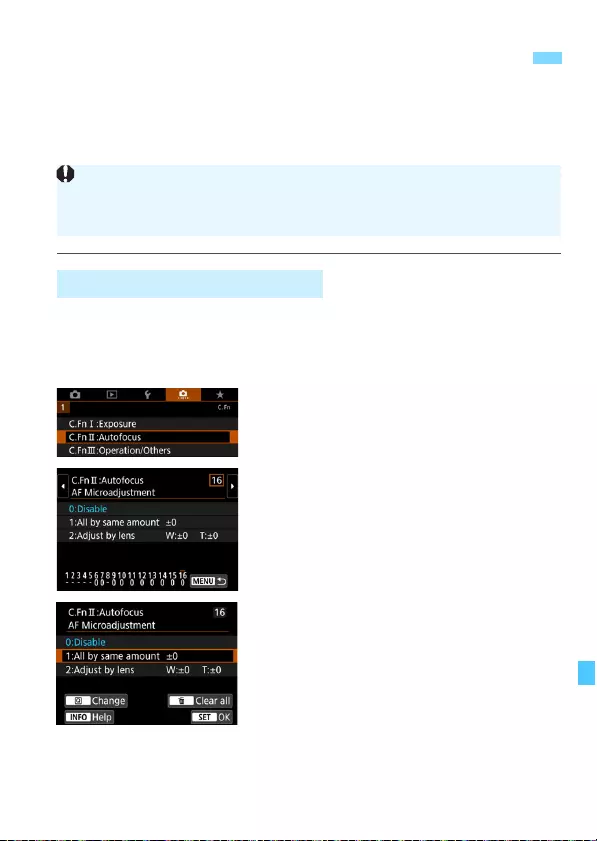
491
Fine adjustment of the AF’s point of focus is possible for viewfinder
shooting. This is called “AF Microadjustment”. Before making the
adjustment, read “General Cautions for AF Microadjustment” and
“Notes for AF Microadjustment” on page 496.
Set the adjustment amount manually by repeatedly making
adjustments, shooting, and checking the results until the desired result
is achieved. During AF, regardless of the lens used, the point of focus
will always be shifted by the adjustment amount.
1Select [C.Fn II: Autofocus].
Under the [8] tab, select [C.Fn II:
Autofocus], then press <0>.
2Select [16: AF Microadjustment].
3Select [1: All by same amount].
4Press the <Q> button.
The [1: All by same amount] screen
will appear.
8
: Fine Adjustment of AF’s Point of Focus
N
1: Adjust All by Same Amount
Normally, this adjustment is not required. Perform this adjustment
only if necessary. Note that performing this adjustment may prevent
accurate focusing from being achieved.

492
8: Fine Adjustment of AF’s Point of FocusN
5Make the adjustment.
Set the adjustment amount. The
adjustable range is ±20 steps.
Setting it toward “-: ” will shift the
point of focus in front of the standard
point of focus.
Setting it toward “+: ” will shift the
point of focus to behind the standard
point of focus.
After making the adjustment, press
<0>.
Select [1: All by same amount], then
press <0>.
6Check the result of the
adjustment.
Take a picture and play back the
image (p.388) to check the
adjustment result.
If the shooting result comes out with
focus in front of the targeted point,
adjust toward the “+: ” side. If it
comes out with focus behind the
targeted point, adjust toward the
“-: ” side.
Repeat the adjustment as necessary.
If [1: All by same amount] is selected, separate AF adjustment will not be
possible for the wide-angle and telephoto ends of zoom lenses.
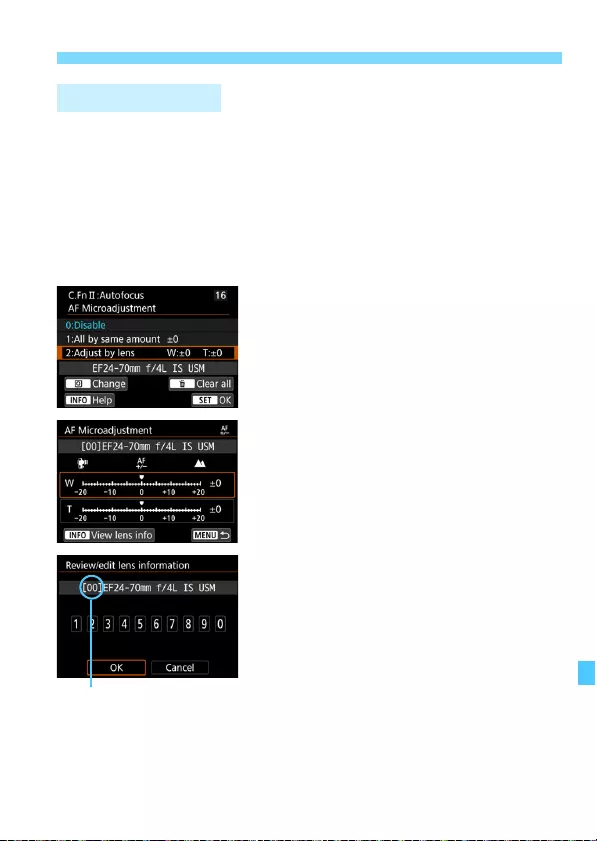
493
8: Fine Adjustment of AF’s Point of FocusN
You can make the adjustment for each lens and register the adjustment
in the camera. You can register the adjustment for up to 40 lenses.
When you autofocus with a lens whose adjustment is registered, the
point of focus will always be shifted by the adjustment amount.
Set the adjustment amount manually by repeatedly making
adjustments, shooting, and checking the results until the desired result
is achieved. If you use a zoom lens, make the adjustment for the wide-
angle (W) and telephoto (T) ends.
1Select [2: Adjust by lens].
2Press the <Q> button.
The [2: Adjust by lens] screen will
appear.
3Check and change the lens
information.
Displaying the Lens Information
Press the <B> button.
The screen will show the lens name
and a 10-digit serial number. When
the serial number is displayed, select
[OK] and go to step 4.
If the lens’s serial number cannot be
confirmed, “0000000000” will be
displayed. In this case, enter the
number by following the instructions
on the next page.
Regarding the asterisk “*” displayed
in front of some lens serial numbers,
see the next page.
2: Adjust by Lens
Registered number
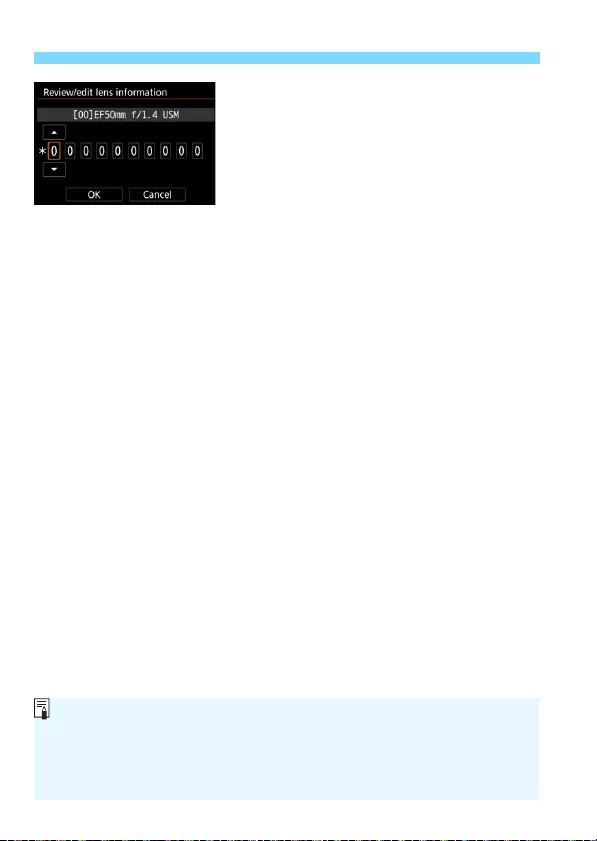
494
8: Fine Adjustment of AF’s Point of FocusN
Entering the Serial Number
Select the digit to be entered, then
press <0> so <r> is displayed.
Enter the number, then press <0>.
After entering all the digits, select
[OK].
Lens Serial Number
In step 3, if “*” appears in front of the 10-digit lens serial
number, you can register only one unit of the same lens model.
Even if you enter the serial number, “*” will remain displayed.
The serial number on the lens may differ from the serial number
displayed on the screen in step 3. This is not a malfunction.
If the lens serial number includes letters, enter only the numbers.
If the lens serial number is eleven digits or longer, enter only the last
ten digits.
The location of the serial number varies depending on the lens.
Certain lenses may not have a serial number inscribed. To register a
lens that has no serial number inscribed, enter any serial number.
If [2: Adjust by lens] is selected and an extender is used, the
adjustment will be registered for the lens and extender combination.
If 40 lenses have already been registered, a message will appear. After
you select a lens whose registration is to be erased (overwritten), you
can register another lens.
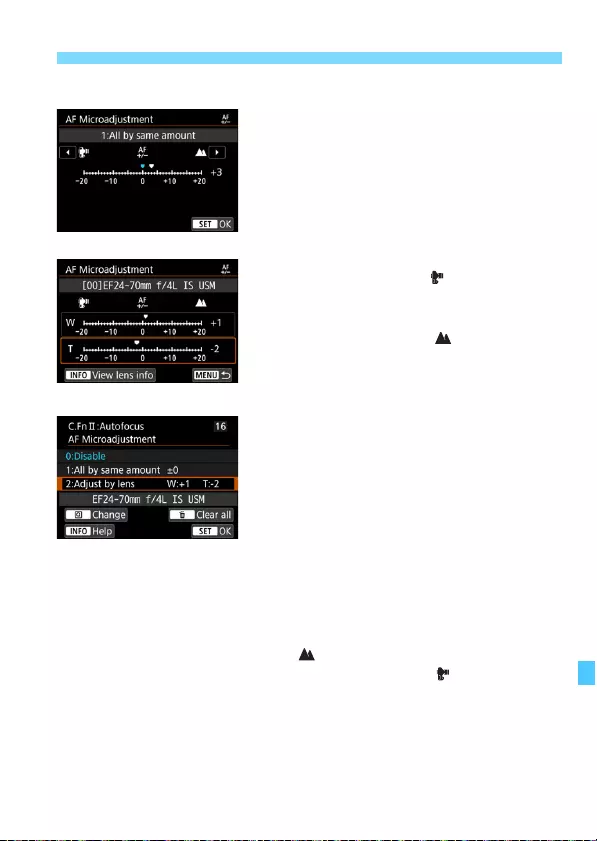
495
8: Fine Adjustment of AF’s Point of FocusN
4Make the adjustment.
For a zoom lens, select the wide-
angle (W) or telephoto (T) end.
Pressing <0> will turn off the
orange frame and make the
adjustment possible.
Set the adjustment amount, then
press <0>. The adjustable range is
±20 steps.
Setting it toward “-: ” will shift the
point of focus in front of the standard
point of focus.
Setting it toward “+: ” will shift the
point of focus to behind the standard
point of focus.
For a zoom lens, repeat this
procedure and adjust it for the wide-
angle (W) and telephoto (T) ends.
After completing the adjustment,
press the <M> button to return to
the screen in step 1.
Select [2: Adjust by lens], then
press <0>.
5Check the result of the adjustment.
Take a picture and play back the image (p.388) to check the
adjustment result.
If the shooting result comes out with focus in front of the targeted
point, adjust toward the “+: ” side. If it comes out with focus
behind the targeted point, adjust toward the “-: ” side.
Repeat the adjustment as necessary.
Single focal length lens
Zoom lens

496
8: Fine Adjustment of AF’s Point of FocusN
When [ Clear all] appears at the bottom of the screen, pressing the
<L> button will clear all the adjustments made for [1: All by same
amount] and [2: Adjust by lens].
Clearing All AF Microadjustments
When shooting with the intermediate range (focal length) of a zoom lens, the
AF’s point of focus is corrected automatically relative to the adjustments
made for the wide-angle and telephoto ends. Even if only the wide-angle or
telephoto end is adjusted, a correction will be made automatically for the
intermediate range.
Cautions for AF Microadjustment
The AF’s point of focus will vary slightly depending on the subject
conditions, brightness, zoom position, and other shooting conditions.
Therefore, even if you perform AF Microadjustment, focus may still not
be achieved at the suitable position.
The adjustment amount of one step varies depending on the maximum
aperture of the lens. Keep adjusting, shooting, and checking the focus
repeatedly to adjust the AF’s point of focus.
The adjustment will not be applied to AF in Live View shooting or movie
shooting.
The adjustments will be retained even if you do [8: Clear all Custom
Functions (C.Fn)] (p.468). However, the setting will be [0: Disable].
Notes for AF Microadjustment
It is best to make the adjustment at the actual location where you will
shoot. This will make the adjustment more precise.
Using a tripod when making the adjustment is recommended.
For making adjustments, shooting at the 73 image-recording quality is
recommended.
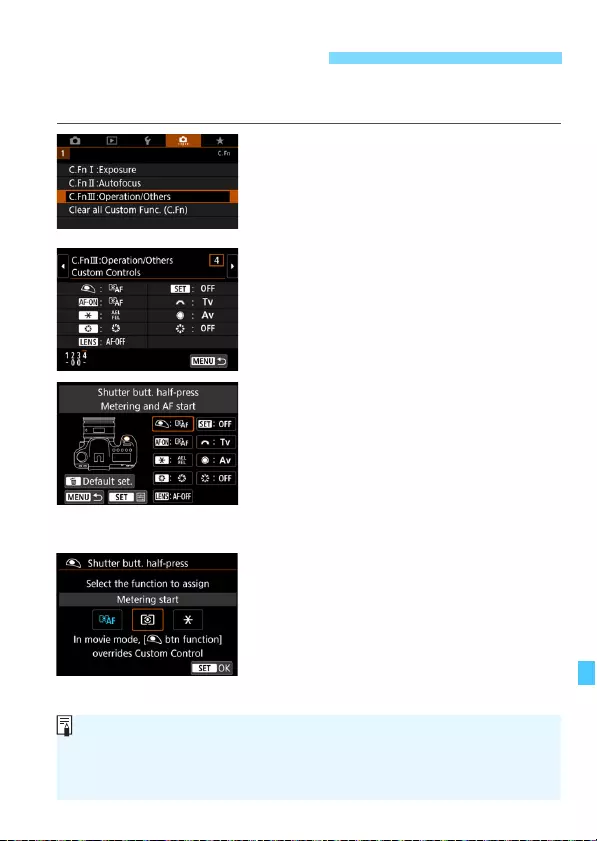
497
You can assign frequently-used functions to camera buttons or dials
according to your preferences for easy operations.
1Select [C.Fn III: Operation/
Others].
Under the [8] tab, select [C.Fn III:
Operation/Others], then press
<0>.
2Select [4: Custom Controls].
The Custom Controls setting screen
will appear.
3Select a camera button or dial.
Select a camera button or dial, then
press <0>.
The name of the camera control and
the assignable functions will be
displayed.
The diagram on the left will show the
location of the selected button or dial.
4Assign a function.
Select a function, then press <0>.
5Exit the setting.
When you press <0> to exit the
setting, the screen in step 3 will
reappear.
Press the <M> button to exit.
8: Custom ControlsN
With the screen in step 3 displayed, you can press the <L> button to revert
the Custom Control settings to their defaults. Note that the [8C.Fn III-4:
Custom Controls] settings will not be canceled even if you select [8:
Clear all Custom Func. (C.Fn)].
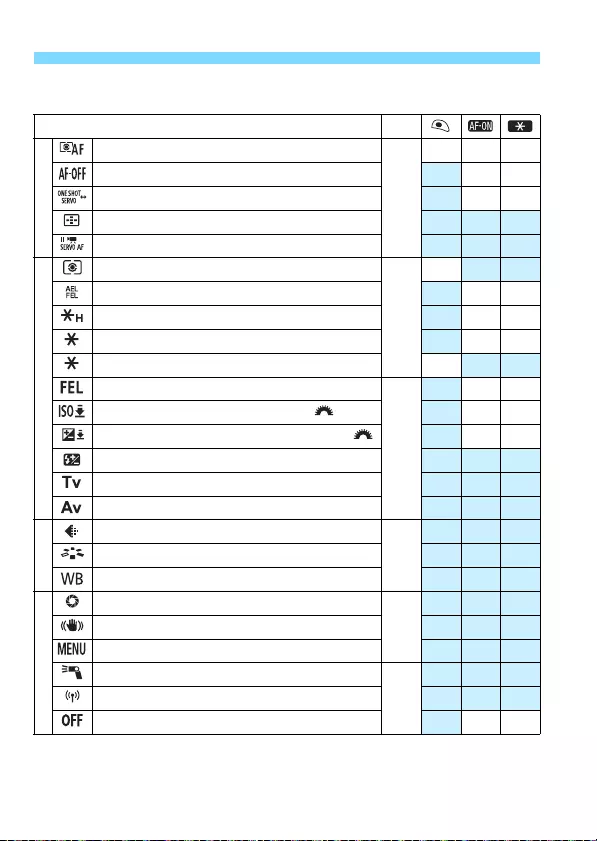
498
8: Custom ControlsN
Assignable Functions to Camera Controls
Function Page
Metering and AF start
500
k k k
AF stop kk
ONE SHOT z AI SERVO/SERVO k k
Direct AF point selection
Pause Movie Servo AF
Metering start
501
k
AE lock/FE lock k k
AE lock (hold) kk
AE lock k k
AE lock (while button pressed) k
FE lock
502
kk
Set ISO speed (hold button, turn ) k k
Exposure compensation (hold button, turn )
k k
Flash exposure compensation
Shutter speed setting in M mode
Aperture setting in M mode
Image quality
503
Picture Style
White balance selection
Depth-of-field preview
503
IS start
Menu display
Flash function settings
504
Wi-Fi function
No function (disabled) k k
AFExposureOperation Images
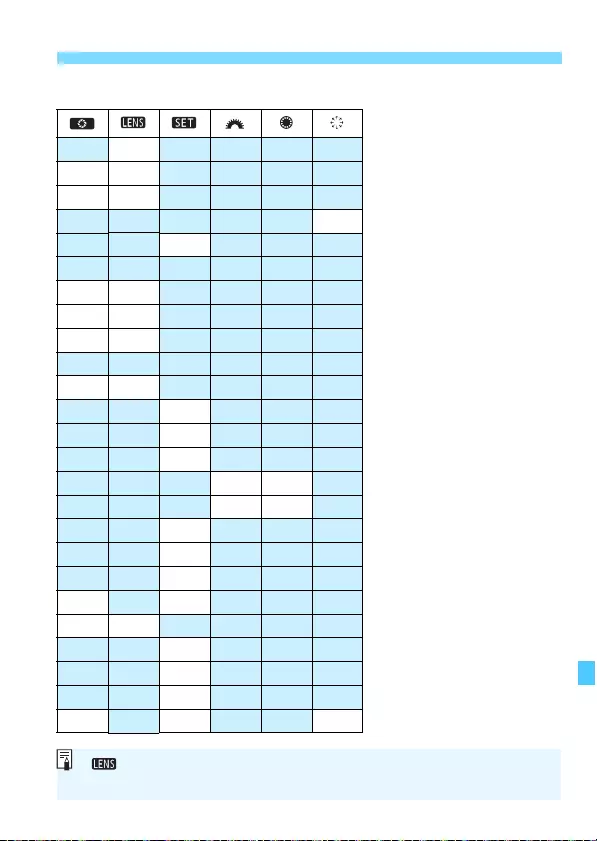
499
8: Custom ControlsN
k
kk
k k
k
k
k k
kk
k k
kk
k
k
k
k k
kk
k
k
k
k k
k k
k
k
k
k k k
< > stands for “AF stop button” provided on super telephoto lenses
equipped with Image Stabilizer.

500
8: Custom ControlsN
When you press the button assigned to this function, metering and AF
are performed.
The AF will stop while you hold down the button assigned to this
function. Useful when you want to stop the AF during AI Servo AF.
You can switch the AF operation. In One-Shot AF mode, when you
press the button to which this function is assigned, the camera switches
to AI Servo AF/Servo AF mode. If you press the button in the AI Servo
AF/Servo AF mode, the camera switches to One-Shot AF mode. Useful
when you need to keep switching between One-Shot AF and AI Servo
AF/Servo AF for a subject that keeps moving and stopping.
When the metering timer is active, you can select an AF point directly
with the <9> dial without pressing the <S> or <B> button.
While Movie Servo AF is operating, pressing <0> will pause the AF.
Press the button again to resume Movie Servo AF.
AF
: Metering and AF start
: AF stop
: ONE SHOT z AI SERVO/SERVO
:Direct AF point selection
: Pause Movie Servo AF
This function does not work during Live View shooting if Multi Shot Noise
Reduction is set.

501
8: Custom ControlsN
When you press the shutter button halfway, exposure metering is
performed. (AF is not performed.)
When you press the button assigned to this function, you can lock the
exposure (AE lock) while the metering timer is active. Useful when you
want to set the focus and exposure separately.
For flash photography, pressing the button assigned to this function will
fire a preflash and retain the required flash output (FE lock).
When you press the button assigned to this function, you can lock the
exposure (AE lock) while the metering timer is active. Useful when you
want to set the focus and exposure separately.
The exposure will be locked (AE lock) while you hold down the shutter
button.
When you press the button assigned to this function, you can lock the
exposure (AE lock). The AE lock will be maintained until you press the
button again. Useful when you want to set the focus and exposure
separately or take multiple shots at the same exposure setting.
Exposure
: Metering start
: AE lock/FE lock
: AE lock
: AE lock (while button pressed)
: AE lock (hold)
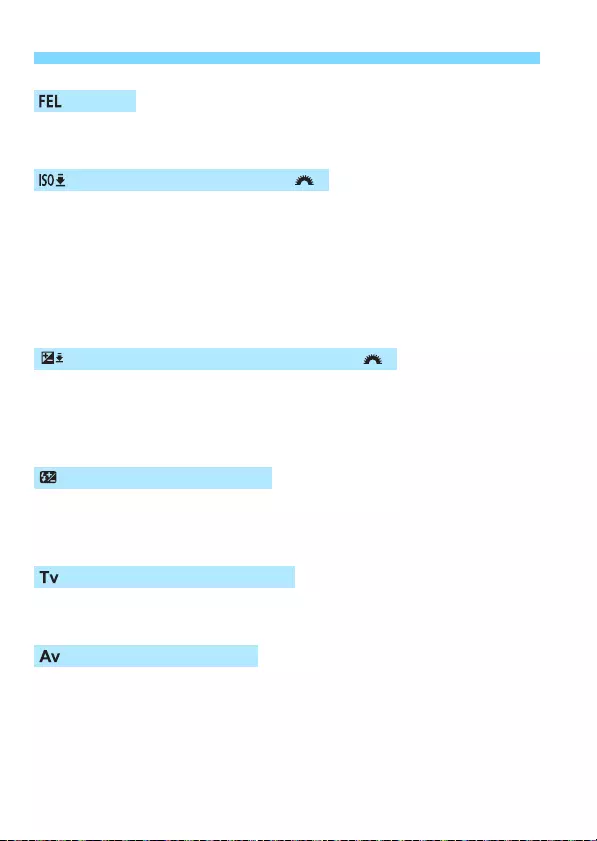
502
8: Custom ControlsN
For flash photography, pressing the button assigned to this function will
fire a preflash and retain the required flash output (FE lock).
You can set the ISO speed by holding down the button assigned with
this function and turning the <6> dial (works with still photo shooting
only). If this control is used with ISO Auto set, you can set the ISO
speed manually. When the metering timer (0) ends, ISO Auto will be
restored. If you use this function in the <a> mode, you can adjust the
exposure with the ISO speed while maintaining the current shutter
speed and aperture value.
You can set the exposure compensation by turning the <6> dial while
holding down the button assigned with this function. Useful when you
want to set exposure compensation in <a> manual exposure with ISO
Auto set.
By pressing <0>, you can set the exposure compensation amount
while looking at the exposure level indicator in the viewfinder or on the
LCD panel.
With <a> manual exposure, you can set the shutter speed with the
<6> or <5> dial.
With <a> manual exposure, you can set the aperture with the <5> or
<6> dial.
: FE lock
: Set ISO speed (hold button, turn )
: Exposure compensation (hold button, turn )
: Flash exposure compensation
: Shutter speed setting in M mode
: Aperture setting in M mode

503
8: Custom ControlsN
Press <0> to display the recording quality setting screen (p.162) on
the LCD monitor.
Press <0> to display the Picture Style selection screen (p.176) on the
LCD monitor.
Press <0> to display the white balance setting screen (p.185) on the
LCD monitor.
When you press the depth-of-field preview button or <0>, the aperture
will stop down and you can check the depth of field (p.240).
With the lens’s IS switch set to <1>, if you press the depth-of-field
preview button or the lens’s AF stop button, the Image Stabilizer will
operate.
Press <0> to display the menu on the LCD monitor.
Image
: Image quality
: Picture Style
: White balance selection
Operation
: Depth-of-field preview
: IS start
: Menu display
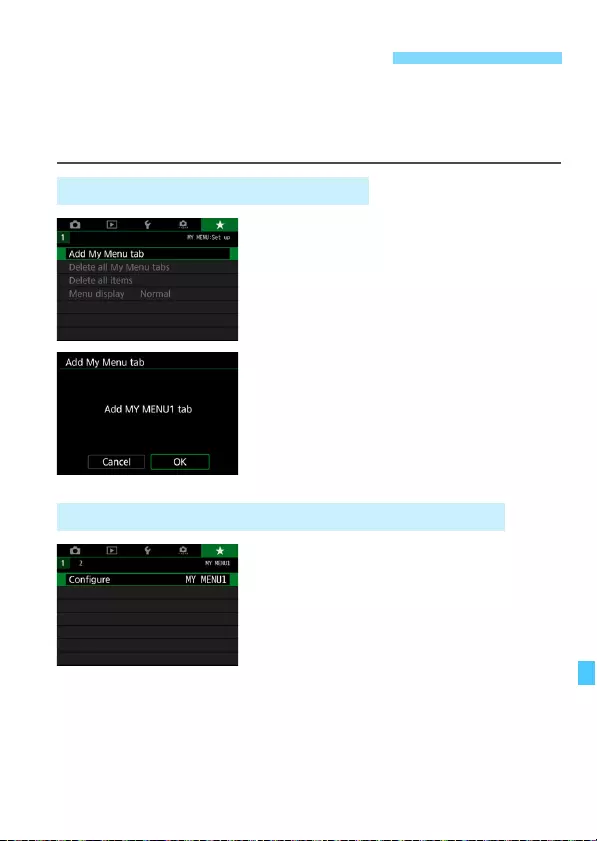
505
Under My Menu tab, you can register menu items and Custom
Functions whose settings you change frequently. You can also name
the registered menu tabs, and press the <M> button to display the
My Menu tab first.
1Select [Add My Menu tab].
Under the [9] tab, select [Add My
Menu tab], then press <0>.
2Select [OK].
The [MY MENU1] tab is created.
You can create up to five My Menu
tabs by repeating steps 1 and 2.
1Select [Configure: MY MENU*].
Press the <Y> <Z> keys to select
[Configure: MY MENU*] (tab for
registering menu items), then press
<0>.
3 Registering My MenuN
Creating and Adding My Menu Tab
Registering Menu Items under the My Menu Tab(s)
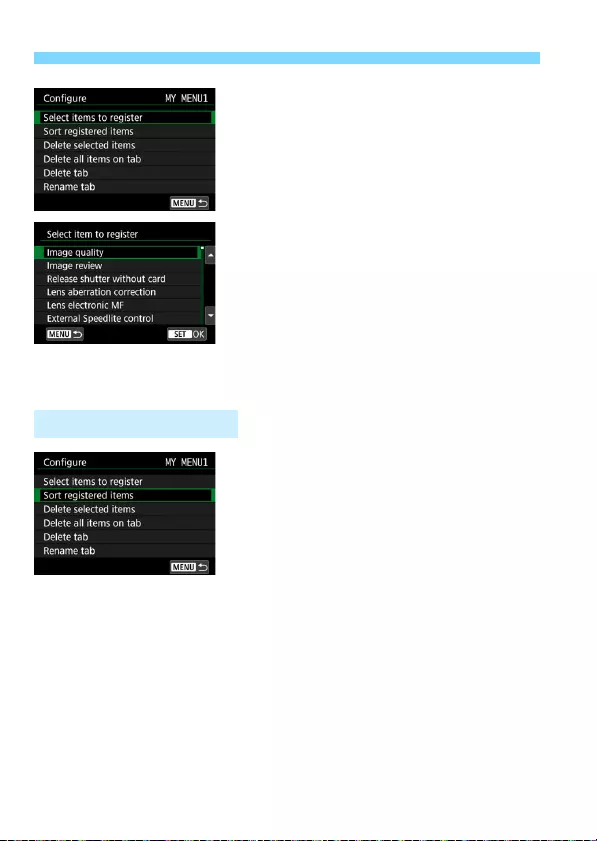
506
3 Registering My MenuN
2Select [Select items to register].
3Register the desired items.
Select the option to be set, then press
<0>.
Select [OK] on the confirmation
dialog.
You can register up to six items.
To return to the screen in step 2,
press the <M> button.
You can sort and delete items under the
menu tab, and rename or delete the
menu tab.
Sort registered items
You can change the order of the registered items in My Menu. Select
[Sort registered items] and select the item whose order you want to
change. Then press <0>. With [z] displayed, press the <W> <X>
keys to change the order, then press <0>.
Delete selected items / Delete all items on tab
You can delete any of the registered items. [Delete selected items]
deletes one item at a time, and [Delete all items on tab] deletes all
the registered items under the tab.
My Menu Tab Settings
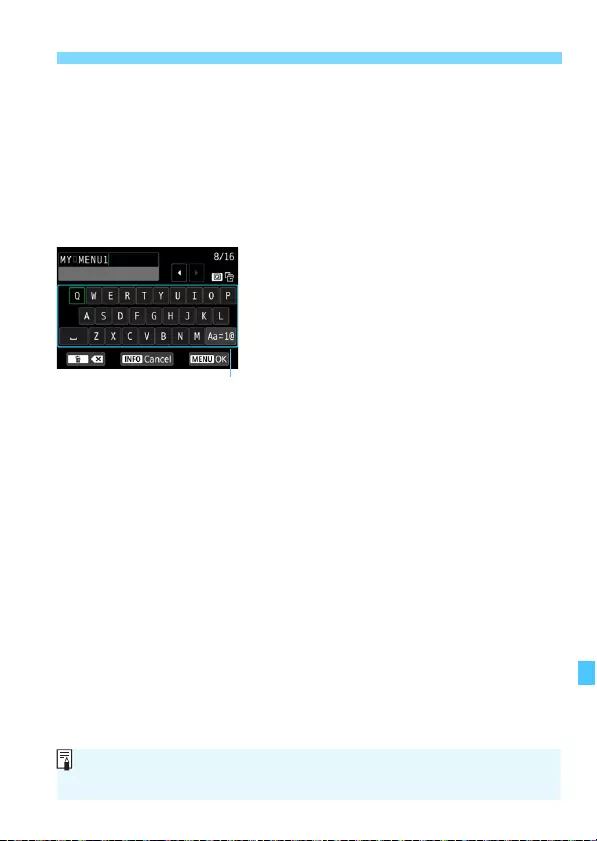
507
3 Registering My MenuN
Delete tab
You can delete the My Menu tab currently displayed. Select [Delete
tab] to delete the [MY MENU*] tab.
Rename tab
You can rename the My Menu tab from [MY MENU*].
1Select [Rename tab].
2Enter text.
Press the <L> button to delete any
unnecessary characters.
Use <9> or <5> <6> to move
the n and select the desired
character. Then press <0> to enter
it.
By selecting [Aaz1@], you can
change the input mode.
You can enter up to 16 characters.
To cancel the text entry, press the
<B> button, then select [OK].
3Exit the setting.
After entering the text, press the
<M> button, then select [OK].
The set name is saved.
Input mode
If you cannot enter text in step 2, press the <Q> button and use the
character palette when the blue frame appears.

508
3 Registering My MenuN
You can delete all the created My Menu
tabs or My Menu items registered under
them.
Delete all My Menu tabs
You can delete all My Menu tabs you created. When you select
[Delete all My Menu tabs], all the tabs from [MY MENU1] to [MY
MENU5] will be deleted and the [9] tab will revert to its default.
Delete all items
You can delete all the items registered under the [MY MENU1] to
[MY MENU5] tabs. The tab(s) will remain. When [Delete all items] is
selected, all the items registered under all the created tabs will be
deleted.
Deleting all My Menu tabs / Deleting all items
If you perform [Delete tab] or [Delete all My Menu tabs], tab names
renamed with [Rename tab] will also be deleted.

509
3 Registering My MenuN
You can select [Menu display] to set the
menu screen that is to appear first when
you press the <M> button.
Normal display
Displays the last displayed menu screen.
Display from My Menu tab
Displays with the [9] tab selected.
Display only My Menu tab
Only the [9] tab is displayed. (The z, 3, 5, and 8 tabs will not
be displayed.)
Menu Display Settings
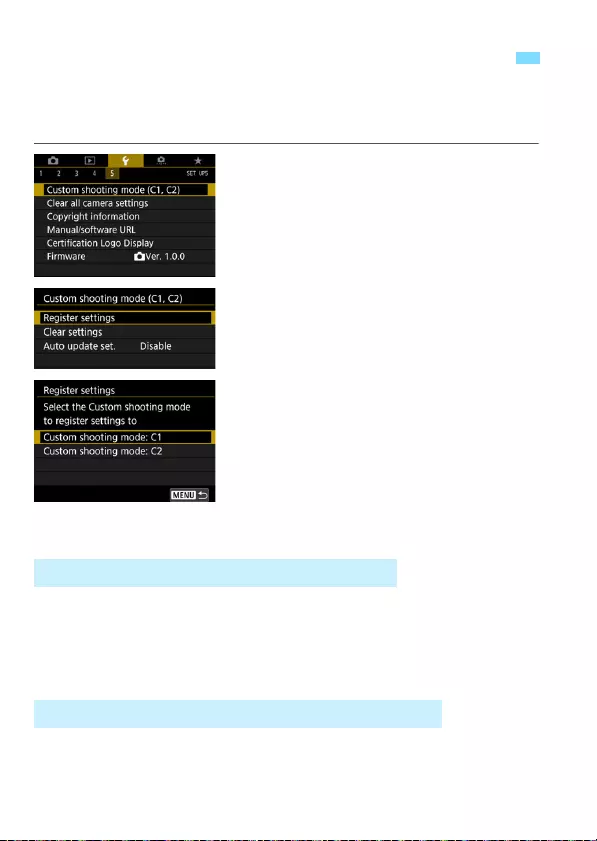
510
You can register current camera settings, such as the shooting
functions, menu functions, and Custom Function settings, as Custom
shooting modes under the Mode Dial’s <w> and <x> positions.
1Select [Custom shooting mode
(C1, C2)].
Under the [55] tab, select [Custom
shooting mode (C1, C2)], then press
<0>.
2Select [Register settings].
3Register the desired items.
Select the Custom shooting mode to
be registered, then press <0>.
Select [OK] on the confirmation
dialog.
The current camera settings (p.511)
will be registered under the Mode
Dial’s C* position.
If you change a setting while you shoot in the <w> or <x> mode, the
respective Custom shooting mode can be automatically updated to
reflect the changes in the settings (Auto update). To enable this
automatic update, set [Auto update set.] to [Enable] in step 2.
If you select [Clear settings] in step 2, the settings of respective modes
can be reverted to the default settings with no Custom shooting modes
registered.
w
: Registering Custom Shooting Modes
N
Automatic Update of Registered Settings
Canceling Registered Custom Shooting Modes

511
w: Registering Custom Shooting ModesN
Shooting Function Settings
Shooting mode, Shutter speed, Aperture, ISO speed, AF operation, AF area
selection mode, AF point, Drive mode, Metering mode, Exposure
compensation amount, AEB increment, Flash exposure compensation amount
Menu Functions
[z1]Image quality, Image review time, Release shutter without
card, Lens aberration correction, Lens electronic MF, Flash
firing, E-TTL II flash metering, Flash sync speed in Av mode
[z2]Exposure compensation/AEB, zISO speed settings, Auto
Lighting Optimizer, White balance, Custom White Balance,
White balance shift/bracketing, Color space
[z3]Picture Style, Long exposure noise reduction, High ISO
speed noise reduction, Highlight tone priority, Multiple
exposure (settings), HDR Mode (settings)
[z4]Interval timer, Bulb timer, Anti-flicker shooting, Mirror lockup,
Aspect ratio, Live View shooting
[z5 (Live View shooting)]
AF method, Touch Shutter, Metering timer, Grid, Exposure
simulation, Silent LV shoot.
[z1 (Movie shooting)]
Movie recording size, Image quality, Sound recording,
Peripheral illumination correction, Chromatic aberration
correction, Lens electronic MF
[z2 (Movie shooting)]
Exposure compensation,
k
ISO speed settings, Auto Lighting
Optimizer, White balance, Custom White Balance, White balance shift
Settings To Be Registered
My Menu settings will not be registered under Custom shooting modes.
Even in the <w> and <x> modes, you can still change shooting function
settings and menu settings.

512
w: Registering Custom Shooting ModesN
[z4 (Movie shooting)]
Movie Servo AF, AF method, Movie Servo AF tracking
sensitivity, Movie Servo AF speed, Metering timer, Grid, V
button function
[z5 (Movie shooting)]
Video snapshot, Time-lapse movie (setting), Movie digital IS,
Remote control
[x2] Slide show (settings), Image jump with 6
[x3] Highlight alert, AF point display, Playback grid, Histogram
display, Magnification (approx.)
[51] File numbering, Auto rotate
[52] Auto power off, LCD brightness, LCD off/on button,
Viewfinder display
[53] Help text size
[54] Touch control, Beep, Auto cleaning, z button display
options/z button LV display options, Multi function lock
[81]C.Fn I
Exposure level increments, ISO speed setting increments,
Bracketing auto cancel, Bracketing sequence, Number of
bracketed shots, Safety shift, Exposure compensation auto
cancel, Metering mode, AE locked after focus
C.Fn II
Tracking sensitivity, Acceleration/deceleration tracking, AF
point auto switching, AI Servo 1st image priority, AI Servo 2nd
image priority, AF-assist beam firing, Lens drive when AF
impossible, Select AF area selection mode, AF area selection
method, Orientation linked AF point, Initial AF point, AI
Servo AF, Auto AF point selection: Color Tracking, AF point
selection movement, AF point display during focus, VF
display illumination, AF Microadjustment (excluding
adjustment)
C.Fn III
Dial direction during Tv/Av, Retract lens on power off, Custom
Controls

513
15
Reference
This chapter provides reference information for system
accessories, camera features, etc.
Certification Logo
Select [55: Certification Logo Display] and press <0> to
display some of the logos of the camera’s certifications. Other
certification logos can be found in this Instruction Manual, on the
camera body, and on the camera’s package.
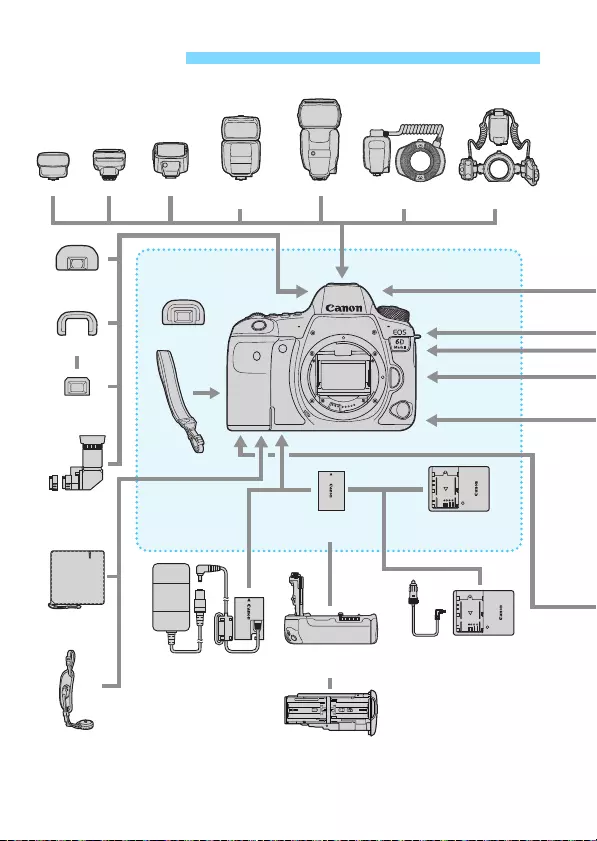
514
System Map
Strap
Battery Pack
LP-E6N*1
Battery Charger
LC-E6
Car Battery
Charger
CBC-E6
Car Battery
Cable CB-570
Macro Ring Lite
MR-14EX II
ST-E2 Macro Twin Lite
MT-24EX
270EX II
ST-E3-RT
Eyecup Eb
Battery Grip
BG-E21
Battery Magazine
BGM-E21L for
LP-E6N/LP-E6
(attached to BG-E21)
600EX II-RT430EX III-RT/
430EX III
AC Adapter
AC-E6N
*2
DC Coupler
DR-E6
*2
Bundled
Accessories
Angle
Finder C
Protecting
Cloth PC-E1
Rubber Frame Eb
Eyepiece Extender
EP-EX15
E-series Dioptric
Adjustment Lenses
Hand Strap E2

515
System Map
Card reader
Interface Cable
IFC-500U (4.7 m/15.4 ft.)
SD/SDHC/SDXC
memory card
Interface Cable
IFC-200U (1.9 m/6.2 ft.)
USB port
Computer
Card slot
Directional Stereo
Microphone
DM-E1
Timer Remote
Controller
TC-80N3
Remote
Switch
RS-80N3
Wireless
Controller
LC-5
EF lenses
Remote
Controller
RC-6
Wireless
Remote
Control
BR-E1
TV/Monitor
Connect Station
CS100
HDMI Cable
HTC-100 (2.9 m/9.5 ft.)
*1: Battery Pack LP-E6 can also be used.
*2: AC Adapter Kit ACK-E6 can also be used.
* All cable lengths given are approximate figures.
Interface Cable
IFC-400PCU (1.3 m/4.3 ft.)
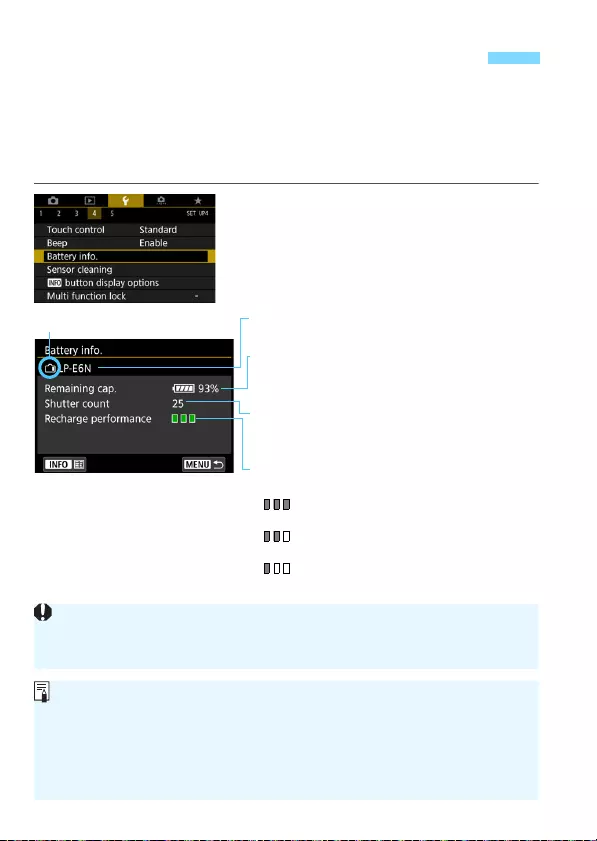
516
You can check the conditions of the battery you are using on the LCD
monitor. Each Battery Pack LP-E6N/LP-E6 has a unique serial number,
and you can register multiple battery packs to the camera. When you
use this feature, you can check the registered batteries’ approximate
remaining capacity and usage history.
Select [Battery info.].
Under the [54] tab, select [Battery
info.], then press <0>.
The battery information screen will
appear.
3 Checking the Battery Information
Battery model or household power source
being used.
The battery level indicator (p.48) is displayed
together with the remaining battery level
shown in 1% increments.
The number of shots taken with the current
battery. The number is reset when the battery
is recharged.
Battery’s recharge performance level is
displayed in three levels.
(Green) : Battery’s recharge
performance is good.
(Green) :
Battery’s recharge performance
is slightly degraded.
(Red) : Purchasing a new battery is
recommended.
Battery position
Using a genuine Canon Battery Pack LP-E6N/LP-E6 is recommended. If
you use batteries that are not genuine Canon products, the camera’s full
performance may not be attained or malfunction may result.
The shutter count is the number of still photos taken. (Movie shooting is
not counted.)
The battery information will also be displayed when using Battery Grip
BG-E21 (sold separately).
If a battery communication error message is displayed, follow the
instructions in the message.
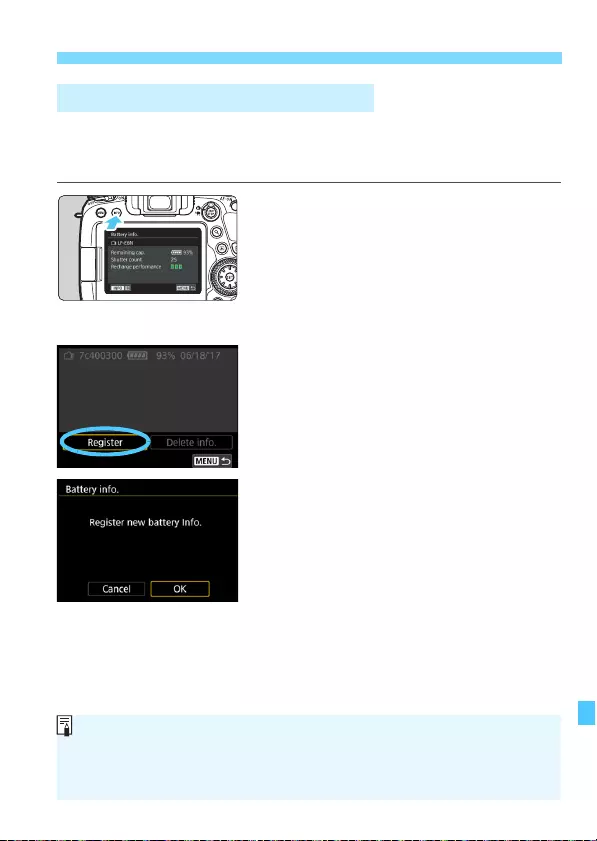
517
3 Checking the Battery Information
You can register up to six LP-E6N/LP-E6 batteries to the camera. To
register multiple batteries to the camera, follow the procedure below for
each battery.
1Press the <B> button.
With the battery info. screen
displayed, press the <B> button.
The battery history screen will
appear.
If the battery is not registered, it will
be grayed out.
2Select [Register].
The confirmation dialog will appear.
3Select [OK].
The battery will be registered and the
battery history screen will reappear.
The grayed out battery number will
now be displayed in white.
Press the <M> button. The
battery info. screen will reappear.
Registering Batteries to the Camera
The battery cannot be registered if the household power outlet
accessories (sold separately, p.520) are used.
If six batteries are already registered, [Register] cannot be selected. To
delete unnecessary battery information, see page 519.
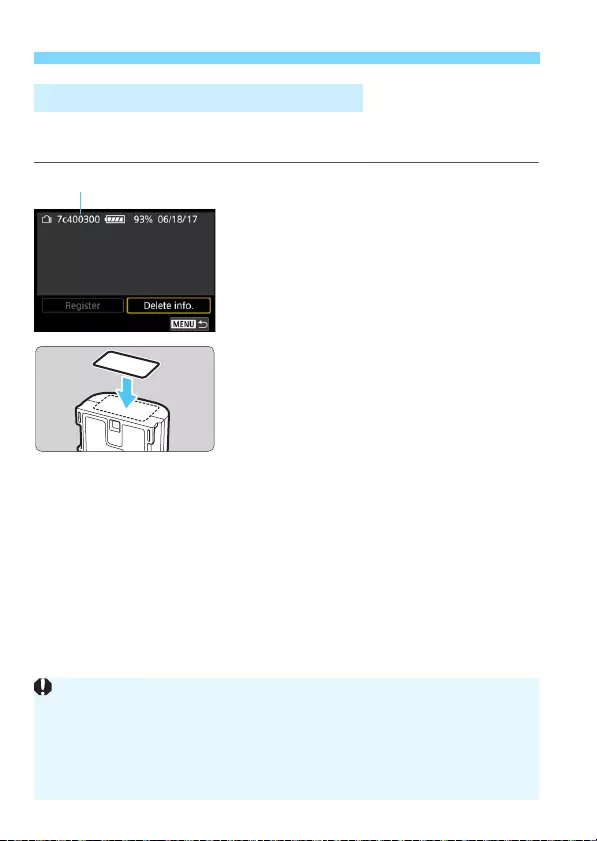
518
3 Checking the Battery Information
It is convenient to label each registered Battery Pack LP-E6N/LP-E6
with their serial numbers, using commercially-available labels.
1Write the serial number on a
label.
Write the serial number displayed on
the battery history screen on a label
approx. 25 mm x 15 mm / 1.0 in. x 0.6
in. in size.
2Remove the battery and affix the
label.
Set the power switch to <2>.
Open the battery compartment cover
and remove the battery.
Affix the label as shown in the
illustration (on the side with no
electrical contacts).
Repeat this procedure for all of your
batteries so you can easily see the
serial number.
Labeling Serial Numbers on Batteries
Serial number
7c400300
Do not affix the label on any part other than as shown in the illustration in
step 2. Otherwise, the misplaced label may make it difficult to insert the
battery or impossible to turn on the camera.
If you use Battery Grip BG-E21 (sold separately), the label may peel off
as you repeatedly insert and remove the battery into the battery
magazine. If it peels off, affix a new label.
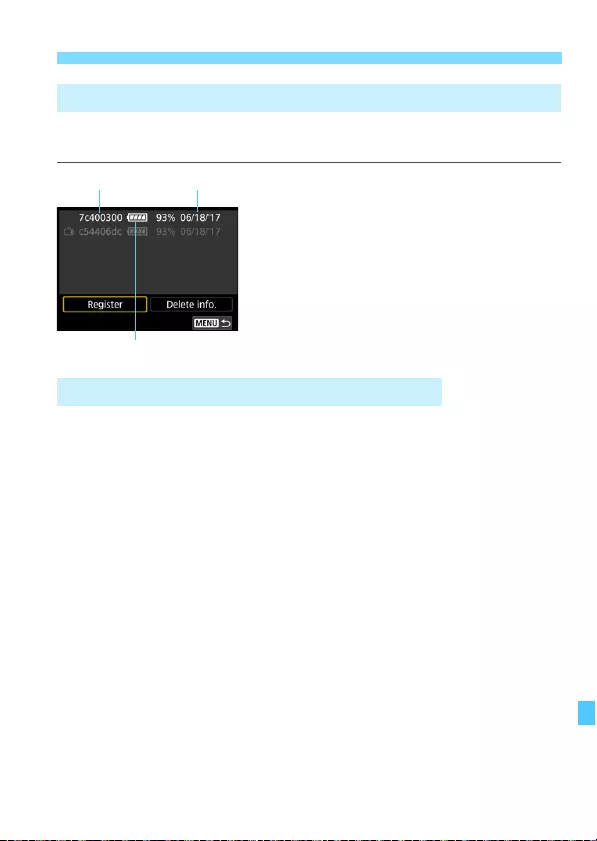
519
3 Checking the Battery Information
You can check the remaining capacity of any battery (even when not
installed) and also when it was last used.
Look for the serial number.
Refer to the battery’s serial number
label and look for the battery’s serial
number on the battery history screen.
You can check the respective
battery’s remaining capacity and the
date when it was last used.
1Select [Delete info.].
Follow step 2 on page 517 to select [Delete info.], then press
<0>.
2Select the battery information to be deleted.
Select the battery information to be deleted, then press <0>.
[X] will appear.
To delete information for another battery, repeat this procedure.
3Press the <L> button.
The confirmation dialog will appear.
4Select [OK].
The battery information will be deleted and the screen in step 1
will reappear.
Checking the Remaining Capacity of a Registered Battery
Serial number Date last used
Battery level
Deleting the Registered Battery Information
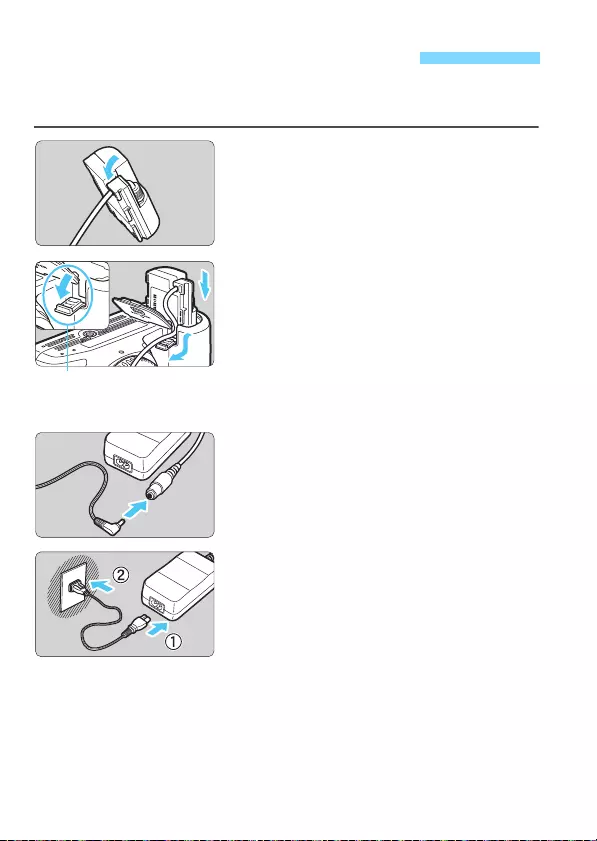
520
You can power the camera with a household power outlet by using the
DC Coupler DR-E6 and AC Adapter AC-E6N (each sold separately).
1Place the cord in the groove.
Carefully insert the DC coupler’s cord
into the groove without damaging the
cord.
2Insert the DC coupler.
Open the battery compartment cover
and open the DC coupler cord hole
cover.
Insert the DC coupler securely until it
locks and put the cord through the
hole.
Close the cover.
3Connect the DC coupler to the AC
adapter.
Connect the DC coupler’s plug to the
AC adapter’s connector securely.
4Connect the power cord.
Connect the power cord to the AC
adapter and insert the power plug into
a power outlet.
5Set the camera’s power switch to
<1> (p.47).
Using a Household Power Outlet
DC coupler cord hole

521
Using a Household Power Outlet
Do not use an AC adapter other than the AC-E6N (sold separately).
While the camera’s power switch is on, do not connect or disconnect the
power cord or connector, or disconnect the DC coupler.
After using the camera, unplug the power plug from the power outlet.
AC Adapter Kit ACK-E6 can also be used.
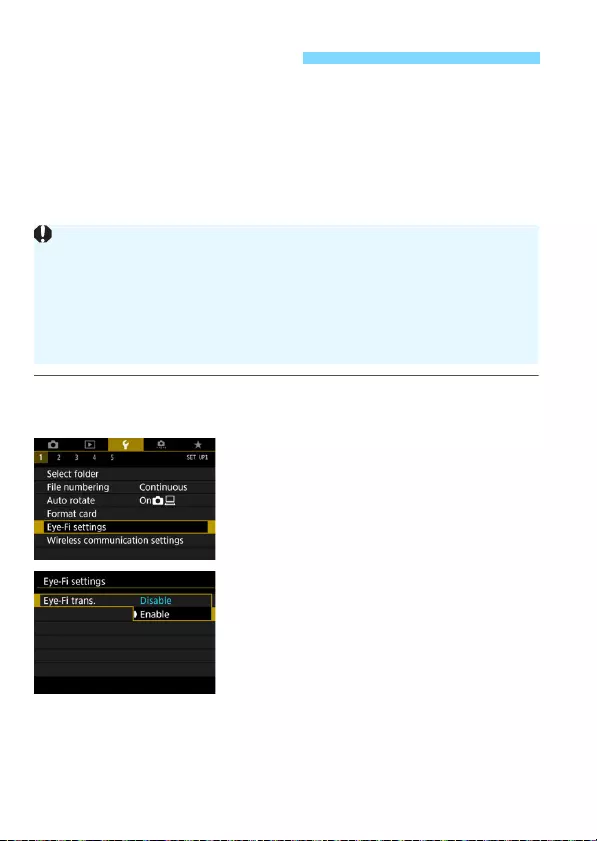
522
With a commercially-available Eye-Fi card already set up, you can
automatically transfer captured images to a computer or upload them to
an online service via a wireless LAN.
The image transfer is a function of the Eye-Fi card. For instructions on
how to set up and use the Eye-Fi card or to troubleshoot any image
transfer problems, refer to the Eye-Fi card’s instruction manual or
contact the card manufacturer.
1Insert an Eye-Fi card (p.43).
2Select [Eye-Fi settings].
Under the [51] tab, select [Eye-Fi
settings], then press <0>.
This menu is displayed only when an
Eye-Fi card is inserted into the
camera.
3Enable Eye-Fi transmission.
Select [Eye-Fi trans.], then press
<0>.
Select [Enable], then press <0>.
If you set [Disable], there will be no
automatic transmission even with the
Eye-Fi card inserted (transmission
status icon I).
H Using Eye-Fi Cards
The camera is not guaranteed to support Eye-Fi card functions
(including wireless transfer). In case of a problem with an Eye-Fi card,
please check with the card manufacturer. Also note that approval is
required to use Eye-Fi cards in many countries or regions. Without
approval, use of the card is not permitted. If it is unclear whether the
card has been approved for use in your area, please check with the
card manufacturer.
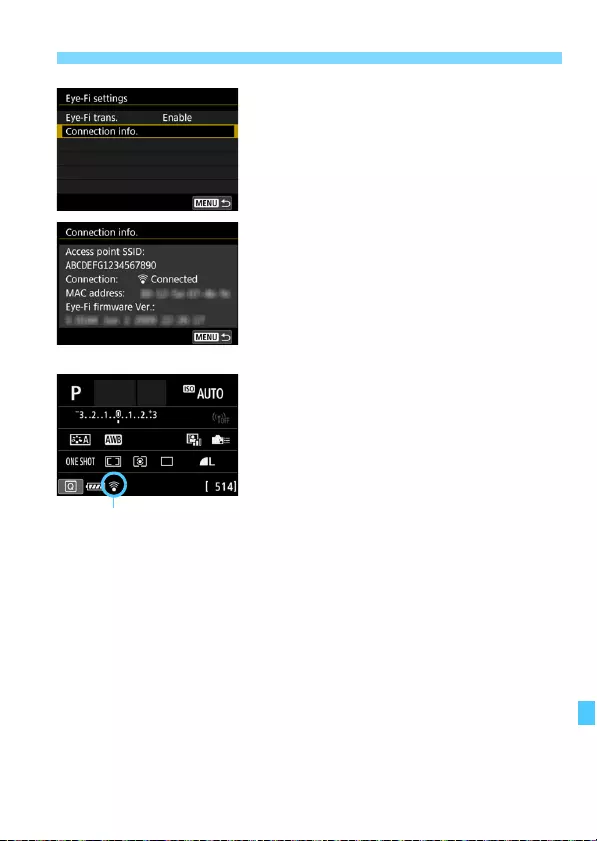
523
H Using Eye-Fi Cards
4Display the connection
information.
Select [Connection info.], then press
<0>.
5Check the [Access point SSID:].
Check that an access point is
displayed for [Access point SSID:].
You can also check the Eye-Fi card’s
MAC address and firmware version.
Press the <M> button to exit the
menu.
6Take the picture.
The picture is transferred and the
[H] icon switches from gray (not
connected) to one of the icons in the
sequence below.
For transferred images, [O] is
displayed in the shooting information
display (p.392).
H(Gray) Not connected : No connection with access point.
H(Blinking) Connecting... : Connecting to access point.
H(Illuminated) Connected : Connection to access point established.
H() Transferring... :
Image transfer to access point in progress.
Transmission status

524
H Using Eye-Fi Cards
Cautions for Using Eye-Fi Cards
Under [Wi-Fi settings] of [51: Wireless communication settings], if
[Wi-Fi] set to [Enable], image transfer with an Eye-Fi card will not be
possible.
If “J” is displayed, an error occurred while retrieving the card
information. Turn the camera’s power switch off and on again.
Even if [Eye-Fi trans.] is set to [Disable], it may still transmit a signal. In
hospitals, on airplanes, and in other places where wireless transmissions
are prohibited, remove the Eye-Fi card from the camera beforehand.
If the image transfer does not function, check the Eye-Fi card and
computer settings. For details, see the card’s Instruction Manual.
Depending on the wireless LAN’s connection conditions, the image
transfer may take longer or it may be interrupted.
Because of the communication function, the Eye-Fi card may become
hot.
The camera’s battery power will be consumed faster.
During the image transfer, auto power off will not take effect.
If you insert a wireless LAN card other than an Eye-Fi card, [51: Eye-Fi
settings] will not appear. Also, the transmission status icon <H> will not
appear.

525
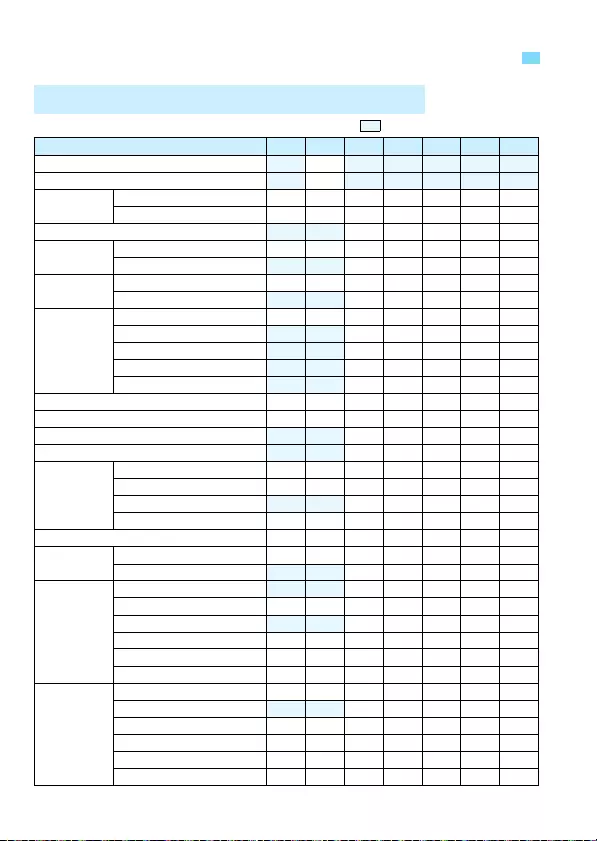
526
o: Set automatically k: User selectable : Not selectable/Disabled
Function Availability Table by Shooting Mode
Still Photo Shooting (A, C, Creative Zone)
Function ACd s f a F
Shooting with ambience selection k
Background blur setting k
Image-recording
quality
RAW kkkkkkk
JPEG kkkkkkk
Aspect ratio kkkkk
ISO speed Automatically set/Auto ookkkkk
Manually set kkkkk
Picture Style Auto ookkkkk
Manual selection kkkkk
White
balance
Auto ookkkkk
Preset kkkkk
Custom kkkkk
Color temperature setting kkkkk
Correction/Bracketing kkkkk
Auto Lighting Optimizer ookkkkk
High ISO speed noise reduction ookkkkk
Long exposure noise reduction kkkkk
Highlight tone priority kkkkk
Lens
aberration
correction
Peripheral illumination correction
ookkkkk
Chromatic aberration correction
ookkkkk
Distortion correction kkkkk
Diffraction correction ookkkkk
Anti-flicker shooting*1ookkkkk
Color space sRGB ookkkkk
Adobe RGB kkkkk
AF
(Viewfinder
shooting)
One-Shot AF kkkkk
AI Focus AF ookkkkk
AI Servo AF kkkkk
AF area selection mode kkkkkkk
AF point selection kkkkkkk
Manual focusing (MF) kkkkkkk
AF
(Live View
shooting)
One-Shot AF ookkkkk
Servo AF kkkkk
u+Tracking kkkkkkk
Smooth zone kkkkkkk
Live 1-point AF kkkkkkk
Manual focusing (MF) kkkkkkk

527
Function Availability Table by Shooting Mode
*1: Settable only with viewfinder shooting (enabled).
*2: Settable only with ISO Auto set.
*3: With ISO Auto, you can set a fixed ISO speed.
*4: Settable with [Flash firing] under [External Speedlite control].
Function ACd s f a F
Drive
Single shooting kkkkkkk
High-speed continuous shooting
kkkkkkk
Low-speed continuous shooting
kkkkkkk
Silent single shooting*1kkkkkkk
Silent continuous shooting*1kkkkkkk
10-sec. self-timer/Remote control
kkkkkkk
2-sec. self-timer/Remote control
kkkkkkk
Self-timer: Continuous kkkkkkk
Metering
Evaluative metering ookkkkk
Partial metering kkkkk
Spot metering kkkkk
Center-weighted average metering
kkkkk
Exposure
Program shift k
Exposure compensation kkkk*2
AEB kkkk
AE lock kkkk*3
Depth-of-field preview kkkkk
HDR shooting kkkk
Multiple exposures kkkkk
Interval timer*1kkkkkk
Bulb timer k
Mirror lockup*1kkkkk
External
flash
Flash on*4ookkkkk
Flash off*4kkkkk
Flash exposure compensation
kkkkk
FE lock*1kkkkk
Flash function settings kkkkk
Custom Function settings kkkkk
GPS function kkkkkkk
Live View shooting kkkkkkk
Quick Control kkkkkkk
Touch operation kkkkkkk

528
Function Availability Table by Shooting Mode
o: Set automatically k: User selectable : Not selectable/Disabled
Still Photo Shooting (8: 2 q 3 5C r)
Function 8
2q3 5 C r
Brightness kkkkkk
Color tone
Panning effect k
Image-recording
quality
RAW kkkkkk
JPEG kkkkkk
Aspect ratio
ISO speed Automatically set/Auto oooooo
Manually set
Picture Style Auto oooooo
Manual selection
White
balance
Auto oooooo
Preset
Custom
Color temperature setting
Correction/Bracketing
Auto Lighting Optimizer oooooo
High ISO speed noise reduction oooooo
Long exposure noise reduction
Highlight tone priority
Lens
aberration
correction
Peripheral illumination correction
oooooo
Chromatic aberration correction
oooooo
Distortion correction o
Diffraction correction oooooo
Anti-flicker shooting*1 oooooo
Color space sRGB oooooo
Adobe RGB
AF
(Viewfinder
shooting)
One-Shot AF ooo
AI Focus AF
AI Servo AF ooo
AF area selection mode kkkkkk
AF point selection kkkkkk
Manual focusing (MF) kkkkkk
AF
(Live View
shooting)
One-Shot AF ooo
Servo AF ooo
u+Tracking kkkkk
Smooth zone kkkkko
Live 1-point AF kkkkk
Manual focusing (MF) kkkkkk
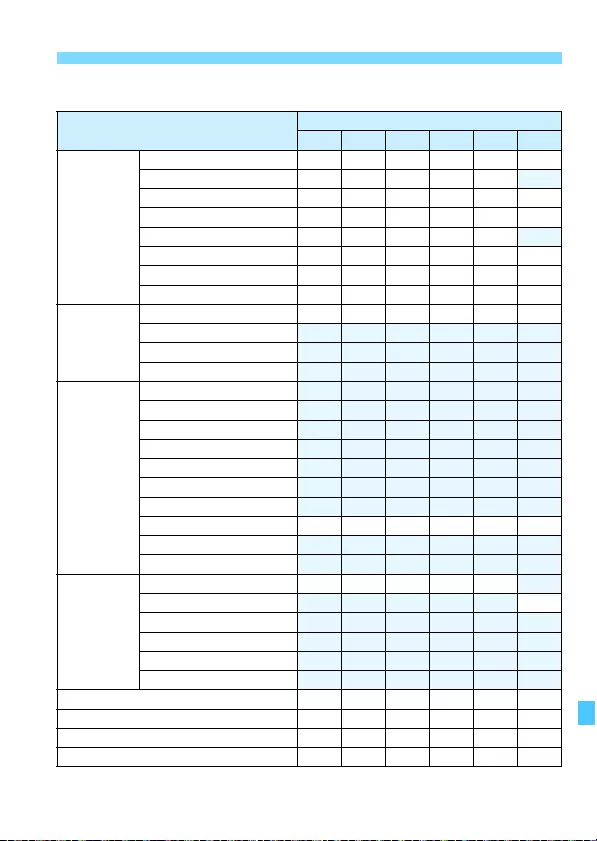
529
Function Availability Table by Shooting Mode
*1: Settable only with viewfinder shooting (enabled).
Function 8
2q3 5 C r
Drive
Single shooting kkkkkk
High-speed continuous shooting
kkkkk
Low-speed continuous shooting
kkkkkk
Silent single shooting*1kkkkkk
Silent continuous shooting*1kkkkk
10-sec. self-timer/Remote control
kkkkkk
2-sec. self-timer/Remote control
kkkkkk
Self-timer: Continuous kkkkkk
Metering
Evaluative metering oooooo
Partial metering
Spot metering
Center-weighted average metering
Exposure
Program shift
Exposure compensation
AEB
AE lock
Depth-of-field preview
HDR shooting
Multiple exposures
Interval timer*1kkkkkk
Bulb timer
Mirror lockup
External
flash
Flash on ooooo
Flash off o
Flash exposure compensation
FE lock*1
Flash function settings
Custom Function settings
GPS function kkkkkk
Live View shooting kkkkkk
Quick Control kkkkkk
Touch operation kkkkkk
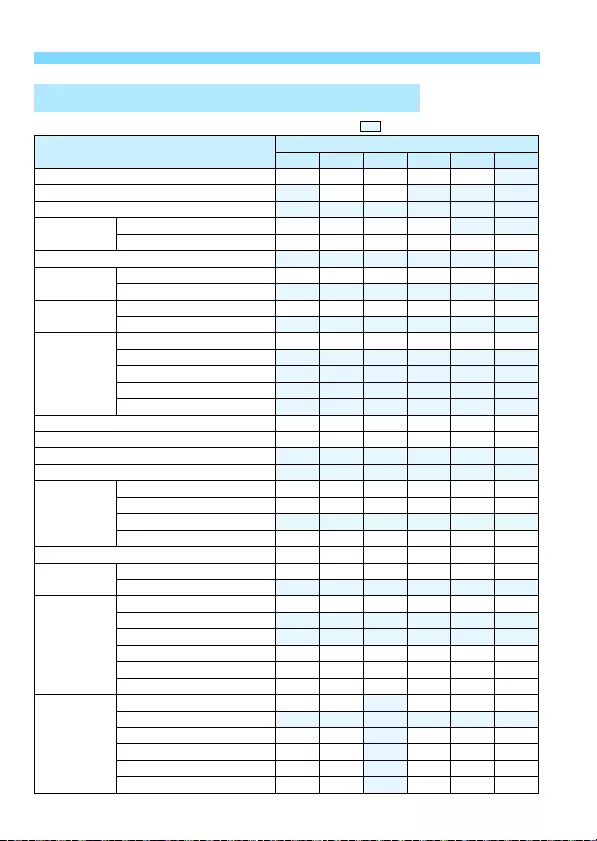
530
Function Availability Table by Shooting Mode
o: Set automatically k: User selectable : Not selectable/Disabled
Still Photo Shooting (8: 4 P y 6 F G)
Function 8
4 P y 6 F G
Brightness kkkkk
Color tone kk
Panning effect
Image-recording
quality
RAW kkkk
JPEG kkkkkk
Aspect ratio
ISO speed Automatically set/Auto oooooo
Manually set
Picture Style Auto oooooo
Manual selection
White
balance
Auto oooooo
Preset
Custom
Color temperature setting
Correction/Bracketing
Auto Lighting Optimizer oooooo
High ISO speed noise reduction oooooo
Long exposure noise reduction
Highlight tone priority
Lens
aberration
correction
Peripheral illumination correction
oooooo
Chromatic aberration correction
oooooo
Distortion correction
Diffraction correction oooooo
Anti-flicker shooting*1 oooooo
Color space sRGB oooooo
Adobe RGB
AF
(Viewfinder
shooting)
One-Shot AF oooooo
AI Focus AF
AI Servo AF
AF area selection mode kkokkk
AF point selection kko*2kkk
Manual focusing (MF) kkkkkk
AF
(Live View
shooting)
One-Shot AF oo ooo
Servo AF
u+Tracking kk kkk
Smooth zone kk kkk
Live 1-point AF kk kkk
Manual focusing (MF) kk kkk
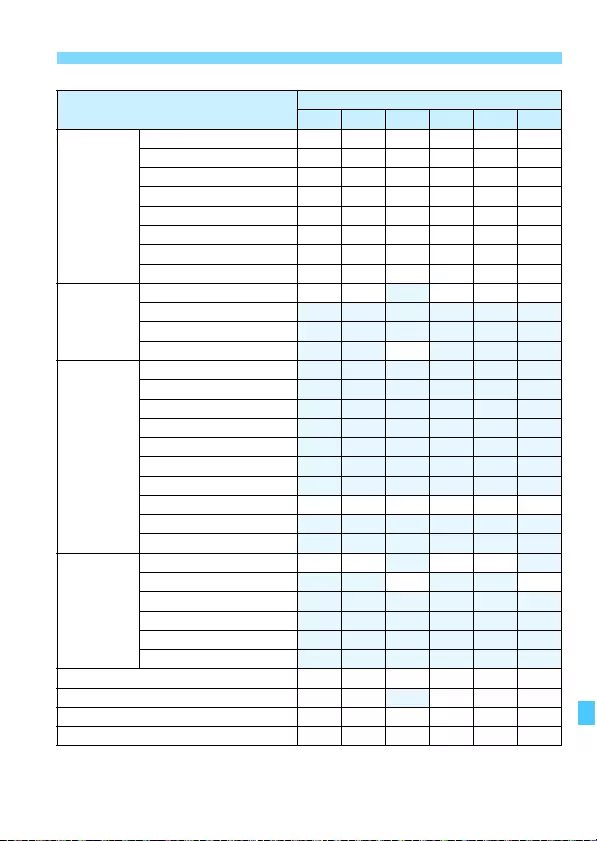
531
Function Availability Table by Shooting Mode
*1: Settable only with viewfinder shooting (enabled).
*2: Focusing is performed with the (single) AF point at the viewfinder center.
Function 8
4 P y 6 F G
Drive
Single shooting kkkkkk
High-speed continuous shooting
kkkkkk
Low-speed continuous shooting
kkkkkk
Silent single shooting*1kkkkkk
Silent continuous shooting*1kkkkkk
10-sec. self-timer/Remote control
kkkkkk
2-sec. self-timer/Remote control
kkkkkk
Self-timer: Continuous kkkkkk
Metering
Evaluative metering oo ooo
Partial metering
Spot metering
Center-weighted average metering
o
Exposure
Program shift
Exposure compensation
AEB
AE lock
Depth-of-field preview
HDR shooting
Multiple exposures
Interval timer*1kkkkkk
Bulb timer
Mirror lockup
External
flash units
Flash on oo oo
Flash off o o
Flash exposure compensation
FE lock*1
Flash function settings
Custom Function settings
GPS function kkkkkk
Live View shooting kk kkk
Quick Control kkkkkk
Touch operation kkkkkk

532
Function Availability Table by Shooting Mode
o: Set automatically k: User selectable : Not selectable/Disabled
Movie Shooting
Function A/C8d/s/f/Fa
yukM
Movie recording quality selectable ko*1kk
Sound recording
Auto oo k k
Custom kk
Wind filter oo k k
Attenuator kk
HDR movie o*2
Time-lapse
movie
4K kkk
Full HD kkk
Video snapshot kkk
ISO speed
Automatically set/Auto oo o k
Manually set k
Picture Style
Auto oo k k
Manual selection kk
White balance
Auto oo k k
Preset kk
Custom kk
Color temperature setting kk
Correction kk
Auto Lighting Optimizer oo k k
High ISO speed noise reduction oo k k
Highlight tone priority kk
Lens aberration
correction
Peripheral illumination correction okk
Chromatic aberration correction oo k k
Movie digital IS kkk
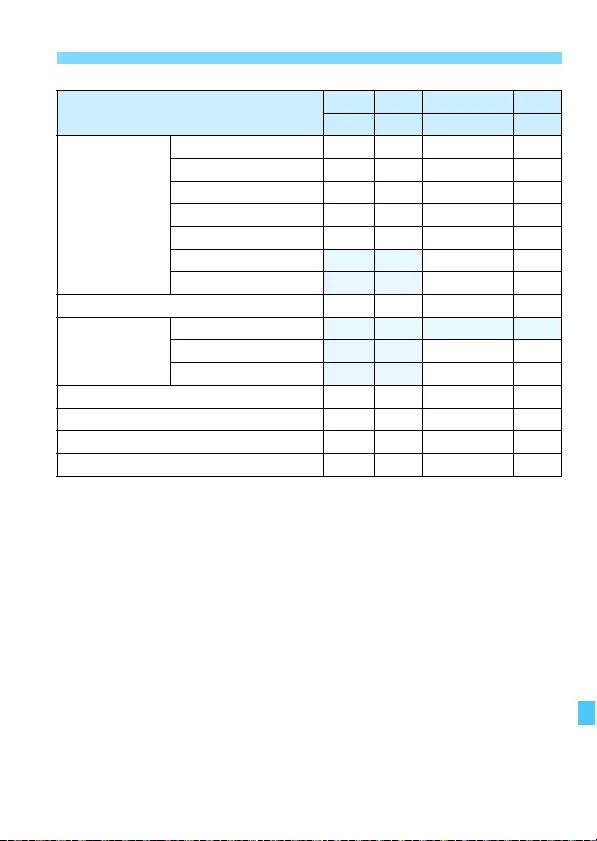
533
Function Availability Table by Shooting Mode
*1: Automatically set to NTSC: L 6 X/PAL:L 5 X.
*2: In the <8> mode, HDR movie shooting will be set automatically.
*3: With ISO Auto, exposure compensation can be set.
*4: With ISO Auto, a fixed ISO speed can be set.
Function A/C8d/s/f/Fa
yukM
AF
u+Tracking kkkk
Smooth zone kkkk
Live 1-point AF kkkk
Manual focusing (MF)
kkkk
Movie servo AF kkkk
• Tracking sensitivity kk
• AF speed kk
Metering oooo
Exposure
Program shift
Exposure compensation kk*3
AE lock kk*4
GPS function kkkk
Remote control shooting kkkk
Quick Control kkkk
Touch operation kkkk

534
z: Shooting 1 (Red) Page
*1: In the <F> and <G> modes, RAW quality cannot be selected.
z: Shooting 1 (Red) Page
*1: In the <F> and <G> modes, RAW quality cannot be selected.
z: Shooting 2 (Red) Page
*1: Not settable in the <r> mode. (Automatically set to [Smooth zone].)
3Menu Settings
Viewfinder Shooting (Basic Zone Modes)
Image quality*11 / 41 / 61
162
73
,
83
,
74
,
84
,
7a
,
8a
,
b
Image review time Off / 2 sec. / 4 sec. / 8 sec. / Hold 74
Release shutter
without card Enable / Disable 44
Interval timer Disable / Enable (Interval / Number of shots) 267
Live View shooting Enable / Disable 291
Live View Shooting (Basic Zone Modes)
Image quality*11 / 41 / 61
162
73
,
83
,
74
,
84
,
7a
,
8a
,
b
Image review time Off / 2 sec. / 4 sec. / 8 sec. / Hold 74
Release shutter
without card Enable / Disable 44
AF method*1u+Tracking / Smooth zone / Live 1-point AF 308
Touch Shutter Disable / Enable 319
Grid display Off / 3x3 l / 6x4 m / 3x3+diag n302

535
3Menu Settings
z: Shooting 1*1 (Red) Page
*1: During movie shooting, [z1: Movie rec. size] and [z1: Sound recording]
will be displayed (p.545).
*2: Not displayed for movie shooting.
Viewfinder Shooting and Live View Shooting
(Creative Zone Modes)
Image quality
1 / 41 / 61
162
73
,
83
,
74
,
84
,
7a
,
8a
,
b
Image review time*2Off / 2 sec. / 4 sec. / 8 sec. / Hold 74
Release shutter
without card*2Enable / Disable 44
Lens aberration
correction
Peripheral illumination correction: Enable /
Disable
200
Chromatic aberration correction: Enable / Disable
Distortion correction*2: Disable / Enable
Diffraction correction*2: Disable / Enable
Lens electronic MF Disable after One-Shot AF / Enable after One-
Shot AF 155
External Speedlite
control*2
Flash firing / E-TTL II metering / Flash sync.
speed in Av mode / Flash function settings /
Flash C.Fn settings / Clear settings
281
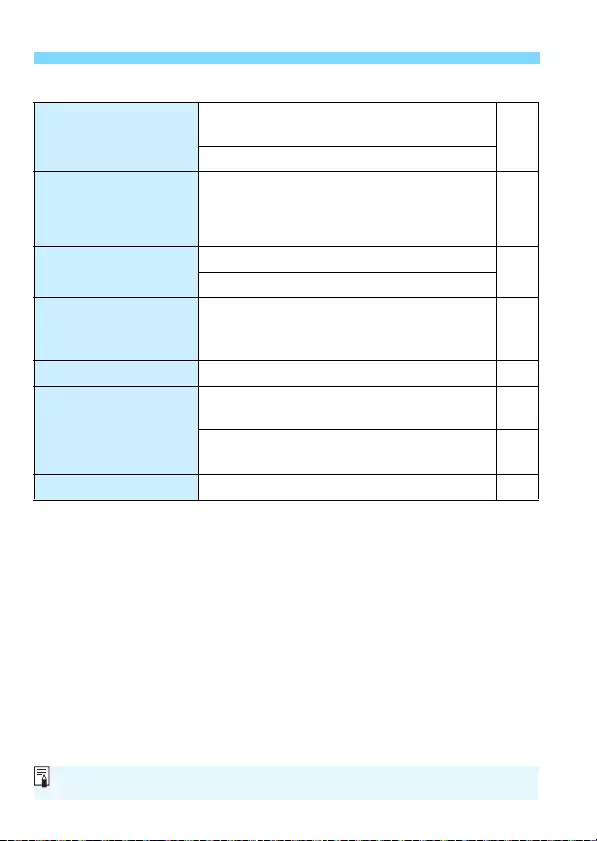
536
3Menu Settings
z: Shooting 2 (Red) Page
*1: For movie shooting, it will be [z2: Exposure compensation].
*2: During Live View shooting or movie shooting, exposure compensation can be
set up to ±3 stops.
*3: For movie shooting, it will be [z2: kISO speed settings].
*4: For movie shooting, it will be [z2: WB correction].
*5: Not displayed for movie shooting.
Exposure
compensation/
AEB setting*1
Exposure compensation: ±5 stops*2 in 1/3- or
1/2-stop increments 245
247
AEB: ±3 stops in 1/3- or 1/2-stop increments
zISO speed settings*3ISO speed / ISO speed range / Auto range /
Minimum shutter speed
170
173
174
175
Auto Lighting
Optimizer
Disable / Low / Standard / High 194
Disabled in M or B modes
White balance
Q
(Ambience priority) /
Qw
(White priority)
/
W/E/R/Y/U/D/O/P (Approx. 2500 -
10000)
185
Custom White Balance Manual setting of white balance 188
White balance shift/
bracketing*4
White balance correction: B/A/M/G bias, 9
levels each 191
White balance bracketing: B/A and M/G bias,
single-level increments, ±3 levels 192
Color space*5sRGB / Adobe RGB 208
Shaded menu options are not displayed in Basic Zone modes.

537
3Menu Settings
z: Shooting 3 (Red) Page
*1: Not displayed for movie shooting.
Picture Style
DAuto / PStandard / QPortrait /
RLandscape / uFine Detail /
SNeutral / UFaithful / VMonochrome /
WUser Defined 1-3
176
Noise reduction for
long exposures*1Disable / Auto / Enable 197
High ISO speed noise
reduction
Disable / Low / Standard / High / Multi Shot
Noise Reduction*1195
Highlight tone priority Disable / Enable 199
Dust Delete Data*1
Obtain data to be used with Digital Photo
Professional (EOS software) to delete dust
spots
452
Multiple exposures*1
Multiple exposure / Multiple exposure control /
Number of exposures / Continue multiple
exposure / Select image for multiple exposures
258
HDR mode*1Adjust dynamic range / Effect / Continuous
HDR / Auto Image Align 253
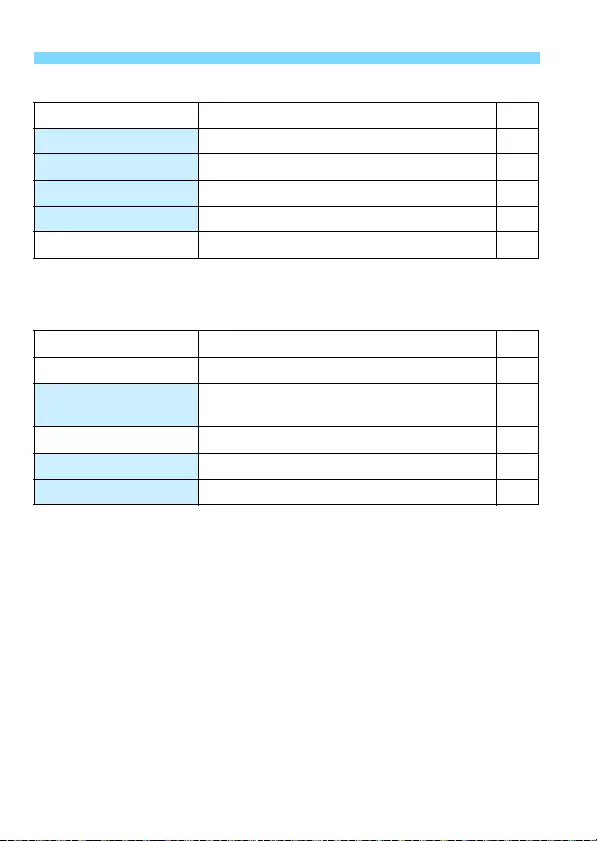
538
3Menu Settings
z: Shooting 4 (Red) Page
*1: Not displayed for Live View shooting.
*2: In Basic Zone modes, these menu options are displayed under the [z1] tab.
z: Shooting5*1*2 (Red) Page
*1: The [z5] tab is displayed for Live View shooting. (Not displayed for viewfinder
shooting.)
*2: In Basic Zone modes, these menu options are displayed under the [z2] tab.
Interval timer
*1*2Disable / Enable (Interval / Number of shots) 267
Bulb timer Disable / Enable (Exposure time) 251
Anti-flicker shooting*1Disable / Enable 206
Mirror lockup*1Disable / Enable 265
Aspect ratio 3:2 / 4:3 / 16:9 / 1:1 168
Live View shooting*1*2Enable / Disable 291
AF method u+Tracking / Smooth zone / Live 1-point AF 308
Touch Shutter Disable / Enable 319
Metering timer
4 sec. / 8 sec. / 16 sec. / 30 sec. / 1 min. / 10 min.
/ 30 min.
302
Grid display Off / 3x3 l / 6x4 m / 3x3+diag n302
Exposure simulation Enable / During e / Disable 303
Silent LV shooting Mode 1 / Mode 2 / Disable 303
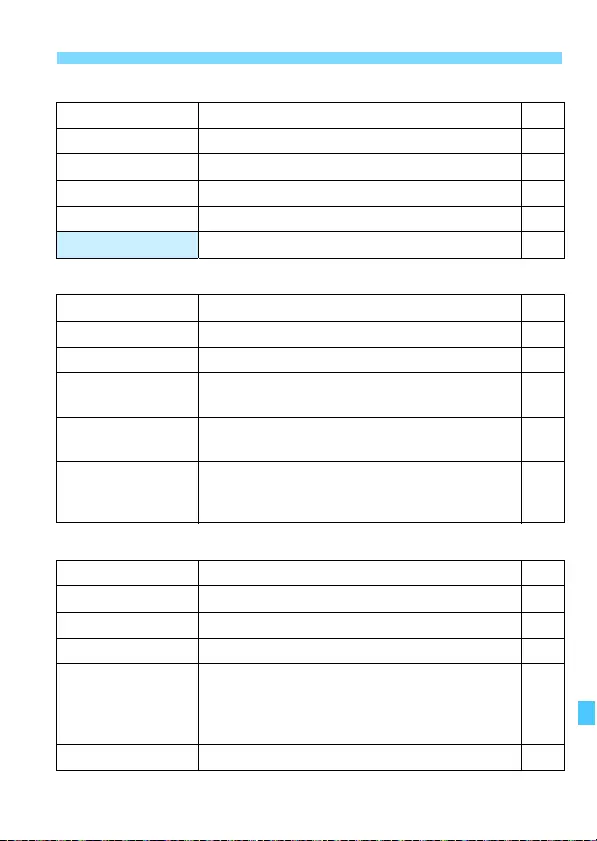
539
3Menu Settings
3: Playback 1 (Blue) Page
3: Playback 2 (Blue) Page
3: Playback 3 (Blue) Page
Protect images Protect images 409
Rotate image Rotate images 408
Erase images Erase images 430
Print order Specify images to be printed (DPOF) 458
Photobook set-up Specify images for a photobook 464
RAW image processing
Process 1 images 438
Cropping Partially crop JPEG images 446
Resizing Downsize JPEG image’s pixel count 444
Rating Rate images 412
Slide show
Display time / Repeat / Transition effect /
Background music
424
Set image search
conditions Rating / Date / Folder / Protect / Type of file 402
Image jump w/6
1 image / 10 images / Jump images by the
specified number / Date / Folder / Movies / Stills /
Protect / Rating
400
Highlight alert Disable / Enable 397
AF point display Disable / Enable 397
Playback grid
Off / 3x3
l
/ 6x4
m
/ 3x3+diag
n390
Histogram display Brightness / RGB 398
Magnification
(Approx.)
1x (no magnification) / 2x (magnify from center) / 4x
(magnify from center) / 8x (magnify from center) / 10x
(magnify from center) / Actual size (from selected
point) / Same as last magnification (from center)
405
Control over HDMI Disable / Enable 428

540
3Menu Settings
5: Set-up 1 (Yellow) Page
*1: For details, refer to the “Wi-Fi (Wireless Communication) Function Instruction
Manual” (p.4).
Select folder Create and select a folder 209
File numbering Numbering: Continuous / Auto reset 211
Manual reset
Vertical image auto
rotation OnzD / OnD / Off 435
Format card Erase data on the card by formatting 70
Eye-Fi settings Displayed when a commercially-available Eye-
Fi card is inserted 522
Wireless
communication
settings*1
Wi-Fi settings:
Wi-Fi / NFC connection / Password /
Connection history / MAC address
–
Wi-Fi function:
Transfer images between cameras / Connect to
smartphone / Remote control (EOS Utility) /
Print from Wi-Fi printer / Upload to Web service
Bluetooth function:
Bluetooth function / Pairing / Check/clear
connection info / Bluetooth address
Send images to smartphone
Nickname
Clear settings
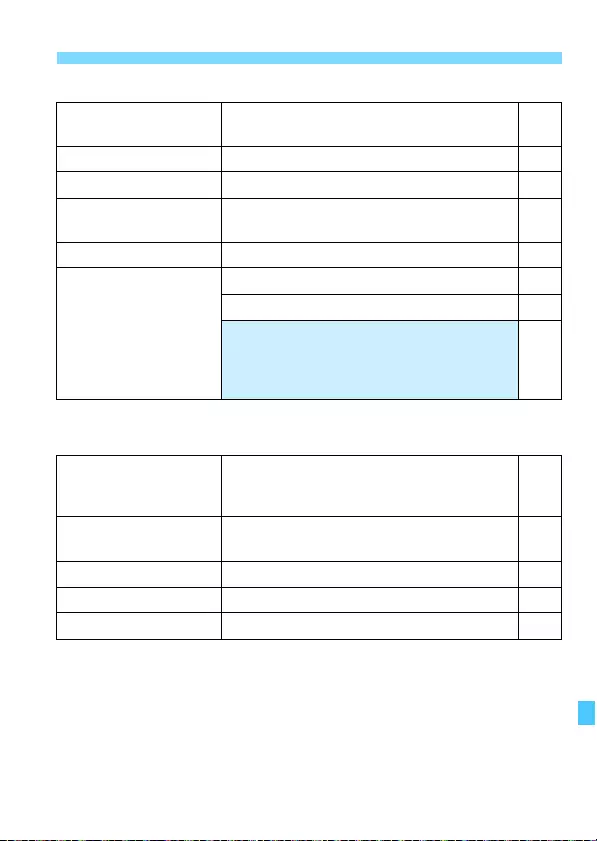
541
3Menu Settings
5: Set-up 2 (Yellow) Page
*1: Not displayed for Live View shooting or movie shooting.
5: Set-up 3 (Yellow) Page
*1: Not displayed for Live View shooting or movie shooting.
Auto power off 1 min. / 2 min. / 4 min. / 8 min. / 15 min. / 30
min. / Disable 73
LCD brightness LCD brightness adjustable to 7 levels 434
LCD off/on*1Remains on / Shutter btn. 74
Date/Time/Zone Date (year, month, day) / Time (hr., min., sec.) /
Daylight saving time / Time zone 49
LanguageKSelect the interface language 52
Viewfinder display*1
Electronic level: Hide / Show 81
Grid display: Hide / Show 79
Show/hide in viewfinder:
Battery level, Shooting mode, AF operation,
Image quality (Image type), Drive mode,
Metering mode, Flicker detection
82
GPS setting
GPS / Auto time setting / Position update
interval / GPS information display / GPS
Logger
217
Video system For NTSC / For PAL 341
427
Mode guide*1Enable / Disable 89
Feature guide Enable / Disable 90
Help text size Small / Standard 92
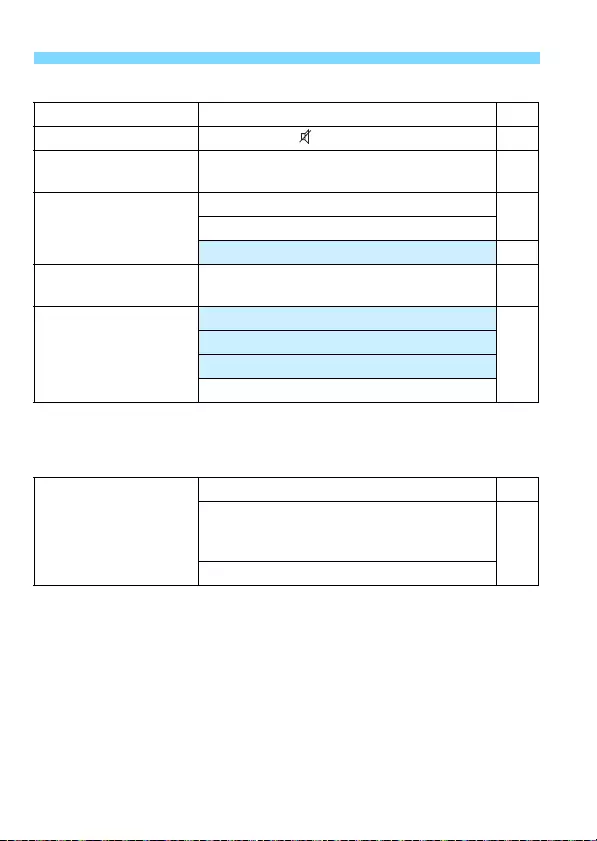
542
3Menu Settings
5: Set-up 4 (Yellow): For viewfinder shooting Page
*1: For Live View shooting and movie shooting, it will be [z button LV display
options].
5: Set-up 4 (Yellow): For Live View shooting/Movie shooting Page
Touch operation Standard / Sensitive / Disable 69
Beep Enable / Touch / Disable 73
Battery information Power source / Remaining capacity / Shutter
count / Recharge performance 516
Sensor cleaning
Auto cleaningf: Enable / Disable 450
Clean nowf
Clean manually 455
zbutton display
options*1Electronic level / Quick Control screen 84
Multi function lock
Main Dial
88
Quick Control Dial
Multi-controller
Touch operation
z button LV display
options
Live View info switch setting: 1 / 2 / 3 / 4 298
Histogram display
• Brightness/RGB: Brightness / RGB
• Display size: Large / Small 299
Reset

543
3Menu Settings
5: Set-up 5 (Yellow) Page
*1: Not displayed for Live View shooting or movie shooting.
Custom shooting
modes (C1, C2)
Register setting / Clear settings / Auto update
settings 510
Clear all camera
settings Resets the camera to the default settings 75
Copyright information
Display copyright information / Enter author’s
name / Enter copyright details / Delete
copyright information
214
Manual/software URL URL and QR code for downloading Instruction
Manuals and software 5
Certification Logo
Display
Displays some of the logos of the camera’s
certifications 513
Firmware*1Select to update the firmware of the camera,
lens, Speedlite, etc. –
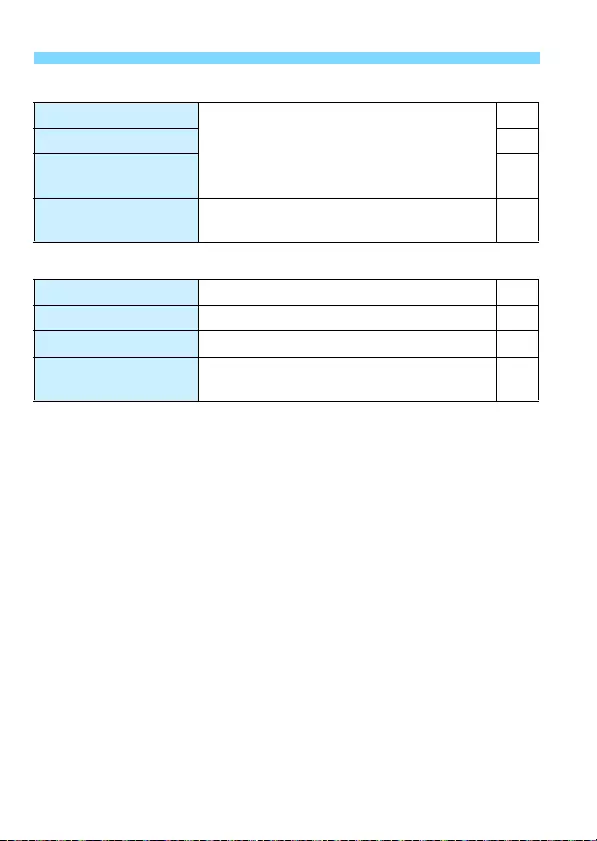
544
3Menu Settings
8: Custom Functions (Orange) Page
9: My Menu (Green) Page
C.Fn I: Exposure
Customize camera functions as desired
471
C.Fn II: Autofocus 475
C.Fn III: Operation/
Others 489
Clear all Custom
Functions (C.Fn) Clear Custom Function settings 468
Add My Menu tab Add My Menu tabs 1-5 505
Delete all My Menu tabs Delete all My Menu tabs 508
Delete all items Delete all items under My Menu tabs 1-5 508
Menu display Normal display / Display from My Menu tab /
Display only My Menu tab 509

545
3Menu Settings
z: Shooting 1 (Red) Page
*1: In Basic Zone modes, it will be [Enable] [Disable].
z: Shooting 2 (Red) Page
Movie Shooting
Movie recording size
1920x1080 / 1280x720
341
NTSC: 59.94p / 29.97p / 23.98p
PAL: 50.00p / 25.00p
Standard (IPB) / Light (IPB)
Sound recording
Sound recording*1: Auto / Manual / Disable
346Sound-recording level
Wind filter: Auto / Disable
Attenuator: Disable / Enable 347
kISO speed settings ISO speed / ISO speed range / ISO Auto /
aISO Auto 372
The “Movie Shooting” table only includes what is not covered by the
“Viewfinder Shooting and Live View Shooting” table.
For [z: Shooting 3] (Red), see page 537.

546
3Menu Settings
z: Shooting 4*1 (Red) Page
*1: In Basic Zone modes, these menu options are displayed under the [z2] tab.
Movie Servo AF Enable / Disable 373
AF method u+Tracking / Smooth zone / Live 1-point AF 374
Movie Servo AF
tracking sensitivity
Locked on (-3/-2/-1) / 0 / Responsive
(+1/+2/+3) 375
Movie Servo AF Speed
When active: Always on / During shooting
376
AF speed: Slow (-7/-6/-5/-4/-3/-2/-1) /
Standard / Fast (+1/+2)
Metering timer 4 sec. / 8 sec. / 16 sec. / 30 sec. / 1 min. /
10 min. / 30 min. 377
Grid display Off / 3x3 l / 6x4 m / 3x3+diag n377
V button function /- / q/- / /k / q/k378

547
3Menu Settings
z: Shooting 5*1 (Red) Page
*1: In Basic Zone modes, these menu options are displayed under the [z3] tab.
Video snapshot
Video snapshot: Enable / Disable
361
Album settings: Create a new album / Add to
existing album
Show confirm message: Enable / Disable 364
Time-lapse movie
Time-lapse movie: Disable / Enable
H(3840x2160) / Enable L(1920x1080) 350
Shooting interval (hr., min., sec.) 351
Number of shots
Auto exposure: Fixed 1st frame / Each frame
352
LCD auto off: Disable / Enable
Beep as image taken: Enable / Disable 353
Movie digital IS Disable / Enable / Enhanced 380
Remote control
shooting Disable / Enable 381

548
If a problem occurs with the camera, first consult this Troubleshooting
Guide. If this Troubleshooting Guide does not resolve the problem,
contact your dealer or nearest Canon Service Center.
If the battery’s remaining capacity (p.516) is 94% or higher, the
battery will not be recharged.
Do not use any battery other than genuine Canon Battery Pack
LP-E6N/LP-E6.
If (1) the battery charger or battery has a problem or (2) communication
with the battery failed (with a non-Canon battery pack), the protection
circuit will stop charging, and the charge lamp will blink in orange at a
constant high speed. In the case of (1), unplug the charger’s power plug
from the power outlet. Detach and reattach the battery to the charger. Wait
a few minutes, then reconnect the power plug to the power outlet. If the
problem persists, contact your dealer or nearest Canon Service Center.
If the internal temperature of the battery attached to the charger is
high, the charger will not charge the battery for safety reasons (lamp
off). During charging, if the battery’s temperature becomes high for
any reason, charging will stop automatically (lamp blinks). When the
battery temperature goes down, charging will resume automatically.
Make sure the battery compartment cover is closed (p.42).
Make sure the battery is installed properly in the camera (p.42).
Recharge the battery (p.40).
Make sure the card slot cover is closed (p.43).
Troubleshooting Guide
Power-Related Problems
The battery does not recharge.
The charger’s lamp blinks at high speed.
The charger’s lamp does not blink.
The camera is not activated on even when the power switch is set to <
1
>.

549
Troubleshooting Guide
If the power is turned off while an image is being recorded to the
card, the access lamp will remain on or continue to blink for a few
seconds. When the image recording is complete, the power will
turn off automatically.
Do not use any battery other than genuine Canon Battery Pack
LP-E6N/LP-E6.
Remove and install the battery again (p.42).
If the electrical contacts are dirty, use a soft cloth to clean them.
Use a fully-charged battery (p.40).
The battery performance may have degraded. See [54: Battery
info.] to check the battery’s recharge performance level (p.516). If
the battery performance is poor, replace the battery with a new
one.
The number of possible shots will decrease with any of the
following operations:
• Pressing the shutter button halfway for a prolonged period.
• Activating the AF frequently without taking a picture.
• Using the lens’s Image Stabilizer.
• Using GPS.
• Using the LCD monitor frequently.
• Continuing Live View shooting or movie shooting for a prolonged
period.
• Using the Wi-Fi/NFC/Bluetooth (wireless communication)
function.
• Enabling the Eye-Fi card’s transmission.
The access lamp still lights or blinks even when
the power switch is <2>.
[Does this battery/do these batteries display the Canon
logo?] is displayed.
The battery becomes exhausted quickly.

550
Troubleshooting Guide
Auto power off is in effect. If you do not want auto power off to
take effect, set [52: Auto power off] to [Disable] (p.73).
Even if [52: Auto power off] is set to [Disable], the LCD monitor
will still turn off after the camera is left idle for approx. 30 min. (The
camera’s power does not turn off.)
The camera cannot be used with EF-S or EF-M lenses (p.53).
Install a recharged battery in the camera (p.40).
Make sure the card is properly inserted (p.43).
Slide the card’s write-protect switch to the Write/Erase setting
(p.43).
If the card is full, replace the card or delete unnecessary images
to make space (p.43, 430).
You cannot take a picture when focusing with One-Shot AF and
the focus indicator <o> in the viewfinder is blinking or when the
AF point is orange during Live View/movie shooting. Press the
shutter button halfway again to refocus automatically, or focus
manually (p.56, 154).
The camera turns off by itself.
Shooting-Related Problems
The lens cannot be attached.
The viewfinder is dark.
No images can be shot or recorded.

551
Troubleshooting Guide
If a card error message is displayed, see page 45 or 567.
Since SDXC cards are formatted in exFAT, if you format a card
with this camera and then insert it into another camera, an error
may be displayed and it may not be possible to use the card.
Set [z4: Mirror lockup] to [Disable].
Set the lens’s focus mode switch to <AF> (p.53).
Press the shutter button gently to prevent camera shake (p.55,
56).
With a lens equipped with an Image Stabilizer, set the IS switch to
<1>.
In low light, the shutter speed may become slow. Use a faster
shutter speed (p.236), set a higher ISO speed (p.170), use flash
(p.278), or use a tripod.
See “Minimizing Blurred Photos” on page 96.
The card cannot be used.
An error message is displayed when the
card is inserted in another camera.
I have to press the shutter button twice to take a picture.
The image is out of focus or blurred.

552
Troubleshooting Guide
Depending on the attached lens, the number of usable AF points
and patterns and Area AF frame shape vary. The lenses are
categorized into 8 groups from A to H (p.145). Check which group
your lens belongs to. Using a lens in Groups E to H will have
fewer usable AF points (p.147-148).
Regarding the AF points lighting up or blinking when you press
the <S> or <B> button, see page 138.
The AF points light up in red when you shoot under low light or
when focus is achieved on a dark subject.
In the <d>, <s>, <f>, <a>, or <F> mode, you can set
whether to have the AF points light up in red for when focus is
achieved (p.488).
Set the AF operation to One-Shot AF. Focus lock is not possible in
the AI Servo AF/Servo AF mode or when servo takes effect in AI
Focus AF mode (p.97, 131).
There are fewer AF points or the Area AF frame
shape is different.
The AF point is blinking or two AF points are displayed.
The AF points do not light up in red.
I cannot lock the focus and recompose the shot.

553
Troubleshooting Guide
The continuous shooting speed for high-speed continuous
shooting may decrease depending on the temperature, battery
level, flicker reduction, shutter speed, aperture, subject
conditions, brightness, AF operation, lens, Live View shooting,
flash use, shooting function settings, etc. For details, see page
156 or 158.
If you shoot a subject that has fine detail such as a field of grass,
the file size will be larger, and the actual maximum burst may be
lower than the number listed on page 164.
The maximum burst displayed in the viewfinder does not change
when you change the card, even if it is a high-speed card. The
maximum burst shown in the table on page 164 is based on
Canon’s testing card. (The faster the card’s writing speed, the
higher the actual maximum burst will be.) Therefore, the
maximum burst displayed in the viewfinder may differ from the
actual maximum burst.
The continuous shooting speed is slow.
The maximum burst during continuous shooting is lower.
Even after I change the card, the maximum burst
displayed for continuous shooting does not change.

554
Troubleshooting Guide
If [z3: Highlight tone priority] is set to [Enable], the settable
ISO speed range will be ISO 200 - ISO 40000 (for still photo
shooting). Even if you set [ISO speed range] to expand the
setting range, you cannot select L (equivalent to ISO 50), H1
(equivalent to ISO 51200), or H2 (equivalent to ISO 102400).
When [z3: Highlight tone priority] is set to [Disable] (p.199),
you can set ISO 100/125/160, L, or H1/H2.
Set [z2: Auto Lighting Optimizer] to [Disable] (p.194). When
[Low], [Standard], or [High] is set, even if you set a decreased
exposure compensation or flash exposure compensation, the
image may come out bright.
See page 242 to set the exposure compensation.
During movie shooting, [Distortion correction] or [Diffraction
correction] will not be displayed.
ISO 100 cannot be set. ISO speed expansion cannot be selected.
Even if I set a decreased exposure compensation,
the image comes out bright.
I cannot set the exposure compensation when
both manual exposure and ISO Auto are set.
Not all the lens aberration correction options are displayed.

555
Troubleshooting Guide
If you shoot at night when the background is dark, the shutter
speed automatically becomes slow (slow-sync shooting) so that
both the subject and background are properly exposed. To
prevent a slow shutter speed, under [z1: External Speedlite
control], set [Flash sync. speed in Av mode] to [1/180-1/60sec.
auto] or [1/180 sec. (fixed)] (p.282).
Make sure the flash is securely attached to the camera.
If you use a non-Canon flash unit with Live View shooting, set
[z5: Silent LV shoot.] to [Disable] (p.303).
If you use a flash unit other than an EX-series Speedlite, the flash
will always fire at full output (p.279).
When the flash Custom Function setting for [Flash metering
mode] is set to [TTL flash metering] (autoflash), the flash will
always fire at full output (p.286).
If flash exposure compensation is already set with the Speedlite,
flash exposure compensation cannot be set with the camera.
When the external Speedlite’s flash exposure compensation is
canceled (set to 0), flash exposure compensation can be set with
the camera.
Under [z1: External Speedlite control], set [Flash sync.
speed in Av mode] to [Auto] (p.282).
When I use the <f> mode with flash,
the shutter speed becomes slow.
The flash does not fire.
The flash always fires at full output.
Flash exposure compensation cannot be set.
High-speed sync cannot be set in the <f> mode.

556
Troubleshooting Guide
When taking still photos, set the drive mode to <Q> or <k>
(p.157). When shooting movies, set [z5: Remote control] to
[Enable] (p.381).
Check the position of the remote controller’s release timing
switch.
If you are using Wireless Remote Control BR-E1, see page 273.
Under [51: Wireless communication settings], if [Bluetooth
function] is set to [Smartphone] or [Remote], you cannot use
infrared remote controllers such as the RC-6 for remote control
shooting. Set [Bluetooth function] to [Disable].
To use a remote controller for time-lapse movie shooting, see
page 360.
If you use flash with Live View shooting, the shutter will make two
release sounds each time you shoot (p.292).
It indicates that the camera’s internal temperature is high. If the
white <s> icon is displayed, the still photo’s image quality may
deteriorate. If the red <E> icon is displayed, it indicates that the
Live View shooting will soon stop automatically (p.323).
Remote control shooting is not possible.
The shutter makes two release sounds during
Live View shooting.
During Live View shooting, a white s or red E icon is displayed.

557
Troubleshooting Guide
If the image-recording quality is set to 41 or 61, the shot
images are not displayed during continuous shooting (p.291).
It indicates that the camera’s internal temperature is high. If the
red <E> icon is displayed, it indicates that the movie shooting will
soon stop automatically (p.382).
If the card’s writing speed is slow, movie shooting may stop
automatically. For cards that can record movies, see page 343. To
find out the card’s writing speed, refer to the card manufacturer’s
Web site, etc.
If you shoot a movie for 29 min. 59 sec., the movie shooting will
stop automatically.
In shooting modes other than <a>, the ISO speed is set
automatically. In the <a> mode, you can manually set the ISO
speed (p.331).
If [z3: Highlight tone priority] is set to [Enable], the settable
ISO speed range will start from ISO 200. Even if you expand the
setting range with [ISO speed range], you cannot select H1 or
H2. When [z3: Highlight tone priority] is set to [Disable]
(p.199), you can set ISO 100/125/160 or an expanded ISO speed.
Shot images are not displayed when continuous shooting
is performed during Live View shooting.
During movie shooting, the red E icon is displayed.
Movie shooting stops by itself.
The ISO speed cannot be set for movie shooting.
ISO 100 cannot be set or ISO speed expansion cannot
be selected during movie shooting.

558
Troubleshooting Guide
For viewfinder shooting and Live View shooting, the ISO speed
will be set according to [ISO speed range] under [z2: zISO
speed settings] (p.173). For movie shooting, the ISO speed will
be set according to [ISO speed range] under [z2: kISO
speed settings] (p.372).
If you change the shutter speed or aperture during movie
shooting, the changes in the exposure may be recorded.
Shooting a few test movies is recommended if you intend to
perform zooming during movie shooting. Zooming during movie
shooting may result in recording of changes in exposure or
mechanical sound of the lens, or images may be out of focus.
Flickering, horizontal stripes (noise), or irregular exposures can be
caused by fluorescent lighting, LED lighting, or other light sources
during movie shooting. Also, changes in the exposure (brightness)
or color tone may be recorded. In the <a> mode, a slow shutter
speed may reduce the problem. The problem may be more
noticeable in time-lapse movie shooting.
The manually set ISO speed changes when
switching to movie shooting.
The exposure changes during movie shooting.
The image flickers or horizontal stripes
appear during movie shooting.

559
Troubleshooting Guide
If you move the camera to the left or right (panning) or shoot a
moving subject, the image may look distorted. The problem may
be more noticeable in time-lapse movie shooting.
Still photos cannot be taken during movie shooting. To take still
photos, stop the movie shooting and perform viewfinder shooting
or Live View shooting.
If the camera is connected to a computer or other device with an
interface cable (sold separately), Wi-Fi functions cannot be set.
Disconnect the interface cable before setting any functions. For
details, refer to the “Wi-Fi (Wireless Communication) Function
Instruction Manual” (p.4).
The subject looks distorted during movie shooting.
I cannot take still photos during movie shooting.
Wi-Fi
Wi-Fi function cannot be set.

560
Troubleshooting Guide
Set the <R> switch downward (lock release) (p.59).
Check the [54: Multi function lock] setting (p.88).
Make sure [54: Touch control] is set to [Standard] or
[Sensitive] (p.69).
For movie shooting, check the [z4: V btn function] setting
(p.378).
Check the [8C.Fn III-4: Custom Controls] setting (p.497).
Certain tabs and options do not appear in Basic Zone modes or
for Live View shooting and movie shooting.
Under the [9] tab, [Menu display] is set to [Display from My
Menu tab] or [Display only My Menu tab]. Set [Normal display]
(p.509).
Operation Problems
I cannot change the setting with the <6>,
<5>, <9>, or <d>.
Touch operation is not possible.
A camera button or dial does not work as expected.
Display Problems
The menu screen shows fewer tabs and options.
The display starts with [9] My Menu or the [9] tab
alone is displayed.

561
Troubleshooting Guide
Set [z2: Color space] to [sRGB]. If [Adobe RGB] is set, the first
character will be an underscore (p.208).
It is a movie file (p.211).
If the card already contains recorded images, the image number
may not start from 0001 (p.211).
Make sure the correct date and time are set (p.49).
Check the time zone and daylight saving time (p.50, 51).
The shooting date and time do not appear in the image. The date
and time are recorded in the image data as shooting information.
When printing, you can imprint the date and time in the picture,
using the date and time recorded in the shooting information
(p.458).
The file name’s first character is an underscore (“_”).
The file name starts with “MVI_”.
The file numbering does not start from 0001.
The shooting date and time displayed are incorrect.
The date and time are not in the image.

562
Troubleshooting Guide
If the number of images recorded on the card exceeds the number
the camera can display, [###] will be displayed.
In low temperatures, the display speed of the AF points may
become slower due to the AF point display device’s (liquid crystal)
characteristics. The display speed will return to normal at room
temperature.
If the LCD monitor is dirty, use a soft cloth to clean it.
The LCD monitor display may seem slightly slow in low
temperatures or may look black in high temperatures. It will return
to normal at room temperature.
[51: Eye-Fi settings] will appear only when an Eye-Fi card is
installed in the camera. If the Eye-Fi card has a write-protect
switch set to the LOCK position, you will not be able to check the
card’s connection status or disable Eye-Fi transmission (p.522).
Image transfer with Eye-Fi card is not possible if [Enable] is set
for [Wi-Fi] in [Wi-Fi Settings] under [51:Wireless
Communication settings].
[###] is displayed.
In the viewfinder, the AF point display speed is slow.
The LCD monitor does not display a clear image.
[Eye-Fi settings] does not appear.

563
Troubleshooting Guide
[33: Highlight alert] is set to [Enable] (p.397).
[33: AF point disp.] is set to [Enable] (p.397).
The AF points are not displayed when the following types of
images are played back:
• Images taken in the <8: qFG> modes.
• Images taken with distortion correction applied.
• Images taken with Multi Shot Noise Reduction applied.
• Cropped images.
If the image is protected, it cannot be erased (p.409).
The camera may not be able to play back images taken with
another camera.
Movies edited with a computer cannot be played back with the
camera.
The images have been filtered for playback with [32: Set image
search conditions] (p.402). Clear the image search conditions.
Playback Problems
Part of the image blinks in black.
A red box is displayed on the image.
During image playback, the AF points are not displayed.
The image cannot be erased.
Still photos and movies cannot be played back.
Only few images can be played back.

564
Troubleshooting Guide
If you operate the camera’s dials or lens during movie shooting,
the operation sound will also be recorded. Using the Directional
Stereo Microphone DM-E1 (sold separately) is recommended
(p.347).
If there is a drastic change in the exposure level during
autoexposure movie shooting, the recording will stop momentarily
until the brightness stabilizes. In such a case, shoot in the <a>
mode (p.330).
Make sure the [53: Video system] is correctly set to [For NTSC]
or [For PAL] (depending on the video system of your TV set).
Make sure the HDMI cable’s plug is inserted all the way in (p.427).
If the movie file size reaches 4 GB, another movie file will be
created automatically (p.345). However, if you use an SDXC card
formatted with the camera, you can record a movie in a single file
even if it exceeds 4 GB.
Operation sound and mechanical sound can be heard
during movie playback.
The movie appears to freeze momentarily.
No picture appear on the TV set.
There are multiple movie files for a single movie shoot.

565
Troubleshooting Guide
Depending on the card reader used and the computer’s operating
system, SDXC cards may not be correctly recognized. In such a
case, connect your camera to the computer with the interface
cable (sold separately), then transfer the images to the computer
using EOS Utility (EOS software, p.594).
41 and 61 images cannot be processed with the camera.
Use Digital Photo Professional (EOS software, p.594) to process
those images.
With this camera, you cannot resize JPEG b and 1 images
(p.444).
With this camera, you cannot crop RAW images (p.446).
White, red, blue, or other colored dots of light may appear on
images if the sensor is affected by cosmic rays, etc. Their
appearance may be reduced by performing [Clean nowf]
under [54: Sensor cleaning] (p.450).
My card reader does not recognize the card.
I cannot process the RAW image.
The image cannot be resized.
The image cannot be cropped.
Dots of light appear on the image.

566
Troubleshooting Guide
Under [54: Sensor cleaning], when you select [Clean nowf],
the shutter will make a mechanical sound during the cleaning, but
no picture will be recorded to the card (p.450).
If you repeatedly turn the power switch <1> and <2> within
a short time period, the <f> icon may not be displayed (p.47).
Install EOS Utility (EOS software) in the computer (p.596).
If the camera is already connected via Wi-Fi, it cannot
communicate with any computer connected with an interface
cable (sold separately).
When using EOS Utility (EOS software), set [z5: Time-lapse
movie] to [Disable] (p.350).
Sensor Cleaning Problems
The shutter makes a sound during sensor cleaning.
Automatic sensor cleaning does not work.
Computer Connection Problems
I cannot transfer images to a computer.
Communication between the connected camera
and computer does not work.

567
If there is a problem with the camera, an
error message will appear. Follow the on-
screen instructions.
* If the error message still persists after following the above instructions,
write down the error code number and contact your nearest Canon Service
Center.
Error Codes
Number Error Message and Solution
01
Communications between the camera and lens is faulty. Clean the
lens contacts.
Clean the electrical contacts on the camera and lens, use a genuine
Canon lens, or remove and install the battery again (p.27, 28, 42).
02
Card cannot be accessed. Reinsert/change card or format card
with the camera.
Remove and insert the card again, replace the card, or format the
card (p.43, 70).
04
Cannot save images because card is full. Replace card.
Replace the card, erase unnecessary images, or format the card
(p.43, 430, 70).
06
Sensor cleaning could not be performed. Turn the camera off and
on again.
Operate the power switch (p.47).
10, 20
30, 40
50, 60
70, 80
99
An error prevented shooting. Turn the camera off and on again or
re-install the battery.
Operate the power switch, remove and install the battery again, or
use a Canon lens (p.47, 42).
Error number
Cause and countermeasures

568
•Type
Type: Digital, single-lens reflex, AF/AE camera
Recording media: SD/SDHC*/SDXC* memory cards
* UHS-I cards compatible.
Image sensor size: Approx. 35.9 x 24.0 mm
Compatible lenses: Canon EF lenses
* Excluding EF-S and EF-M lenses
(The effective angle of view of a lens is approximately
equivalent to that of the focal length indicated.)
Lens mount: Canon EF mount
• Image Sensor
Type: CMOS sensor
Effective pixels: Approx. 26.2 megapixels
* Rounded to the nearest 100,000.
Aspect ratio: 3:2
Dust deletion: Auto/Manual, Appending Dust Delete Data
• Recording System
Recording format: Design rule for Camera File System (DCF) 2.0
Image type: JPEG, RAW (14-bit Canon original),
RAW+JPEG simultaneous recording possible
Pixels recorded: L (Large) : Approx. 26.0 megapixels (6240 x 4160)
M (Medium) : Approx. 11.5 megapixels (4160 x 2768)
S1 (Small 1) : Approx. 6.5 megapixels (3120 x 2080)
S2 (Small 2) : Approx. 3.8 megapixels (2400 x 1600)
RAW : Approx. 26.0 megapixels (6240 x 4160)
M-RAW : Approx. 14.6 megapixels (4680 x 3120)
S-RAW : Approx. 6.5 megapixels (3120 x 2080)
* Rounded to the nearest 100,000.
Aspect ratio: 3:2, 4:3, 16:9, 1:1
Folder creation and
selection:
Possible
File numbering: Continuous, Auto reset, Manual reset
Specifications

569
Specifications
• Image Processing During Shooting
Picture Style: Auto, Standard, Portrait, Landscape, Fine Detail, Neutral,
Faithful, Monochrome, User Defined 1 - 3
White balance: Auto (Ambience priority), Auto (White priority), Preset
(Daylight, Shade, Cloudy, Tungsten light, White
fluorescent light, Flash), Custom, Color temperature
setting (approx. 2500-10000 K)
White balance correction and white balance bracketing
features provided
* Flash color temperature information transmission
possible
Automatic image
brightness correction:
Auto Lighting Optimizer provided
Noise reduction: Applicable to high ISO speed shots and long exposures
Highlight tone priority: Provided
Lens aberration
correction:
Peripheral illumination correction, Chromatic aberration
correction, Distortion correction, Diffraction correction
• Viewfinder
Type: Eye-level pentaprism
Field of view coverage: Vertical/Horizontal approx. 98% (with eyepoint approx.
21 mm and aspect ratio set to 3:2)
Magnification: Approx. 0.71x (-1 m-1 with 50mm lens at infinity)
Eyepoint: Approx. 21 mm (from eyepiece lens center at -1 m-1)
Dioptric adjustment
range:
Approx. -3.0 - +1.0 m-1 (dpt)
Focusing screen: Fixed, Precision Matte
Grid display: Provided
Electronic level: Provided
Function setting display: Battery level (remaining capacity), Shooting mode, AF
operation, Image quality (Image type), Drive mode,
Metering mode, Flicker detection, Warning! display
Mirror: Quick-return type
Depth-of-field preview: Provided

570
Specifications
• Autofocus (during viewfinder shooting)
Type: TTL secondary image-registration, phase-difference
detection with the dedicated AF sensor
AF points: Max. 45 points (Cross-type AF point: Max. 45 points)
* Number of available AF points, Dual cross-type AF
points, and Cross-type AF points vary depending on
the lens used.
* Dual cross-type focusing at f/2.8 with center AF point
when Group A (of the AF groups) lenses are used.
Focusing brightness
range:
EV -3 - 18 (with the center AF point supporting f/2.8,
One-Shot AF, room temperature, ISO 100)
Focus operation: One-Shot AF, AI Servo AF, AI Focus AF, Manual focusing
(MF)
AF area selection mode:Single-point Spot AF (manual selection), Single-point AF
(manual selection), Zone AF (manual selection of zone),
Large zone AF (manual selection of zone), Automatic
selection AF
AF point automatic
selection conditions:
Automatic AF point selection possible based on color
information equivalent to human skin-tone
AI Servo AF
characteristics:
Characteristics can be set with Custom Functions for
Tracking sensitivity, Acceleration/deceleration tracking,
and AF point auto switching
AF fine adjustment: AF Microadjustment (All lenses by the same amount,
Adjust by lens)
AF-assist beam: With the EOS-dedicated external Speedlite
• Exposure Control
Metering mode: Approx. 7,560-pixel RGB+IR metering sensor and
63-zone TTL open-aperture metering
• Evaluative metering (linked to all AF points)
• Partial metering (approx. 6.5% of viewfinder at center)
• Spot metering (approx. 3.2% of viewfinder at center)
• Center-weighted average metering
Metering brightness
range:
EV 1 - 20 (at room temperature, ISO 100)

571
Specifications
Shooting mode: Basic Zone modes:
Scene Intelligent Auto, Creative Auto, Special Scene
(Portrait, Group Photo, Landscape, Sports, Kids,
Panning, Close-up, Food, Candlelight, Night Portrait,
Handheld Night Scene, HDR Backlight Control)
Creative Zone modes:
Program AE, Shutter-priority AE, Aperture-priority AE,
Manual exposure, Bulb exposure, Custom shooting
modes (C1/C2)
ISO speed
(Recommended
exposure index):
Basic Zone modes: ISO speed set automatically
P, Tv, Av, M, B: ISO Auto, ISO 100 - ISO 40000 manual
setting (in 1/3- or whole-stop increments), and expansion
to L (equivalent to ISO 50), H1 (equivalent to ISO
51200), H2 (equivalent to ISO 102400) provided.
* With highlight tone priority set, the minimum limit will be
ISO 200.
ISO speed settings: ISO speed range, Auto range, and minimum speed limit
for Auto settable
Exposure
compensation:
Manual:
With viewfinder shooting: ±5 stops in 1/3- or 1/2-stop
increments
With Live View shooting: ±3 stops in 1/3- or 1/2-stop
increments
AEB (Auto Exposure Bracketing):
±3 stops in 1/3- or 1/2-stop increments (can be combined
with manual exposure compensation)
AE lock: Auto: AE lock when focus is achieved can be enabled or
disabled for each metering mode with a Custom Function
Manual: With AE lock button
Flicker reduction: Provided
Interval timer: Shooting interval and shot count settable
Bulb timer: Bulb exposure time settable
Mirror lockup: Provided
• HDR Shooting
Dynamic range adjustment:
Auto, ±1, ±2, ±3
Effects: Natural, Art standard, Art vivid, Art bold, Art embossed
Auto image alignment: Provided

572
Specifications
• Multiple Exposures
Number of multiple
exposures:
2 to 9 exposures
Multiple-exposure control:
Additive, average
• Shutter
Type: Electronically-controlled, focal-plane shutter
Shutter speed: 1/4000 sec. to 30 sec. (total shutter speed range;
available range varies by shooting mode), Bulb, X-sync
at 1/180 sec.
• Drive System
Drive mode: Single shooting, High-speed continuous shooting, Low-
speed continuous shooting, Silent single shooting, Silent
continuous shooting, 10-sec. self-timer/remote control, 2-
sec. self-timer/remote control, Self-timer: Continuous
Continuous shooting
speed:
High-speed continuous shooting: Max. approx. 6.5 shots/
sec.
* The continuous shooting speed decreases during
Antiflicker shooting, during Live View shooting with
Servo AF, or during Live View shooting with an external
Speedlite.
* The continuous shooting speed for high-speed
continuous shooting may decrease depending on the
temperature, battery level, flicker reduction, shutter
speed, aperture, subject conditions, brightness, AF
operation, lens, flash use, shooting function settings, etc.
Low-speed continuous shooting: Max. approx. 3.0 shots/sec.
* The continuous shooting speed decreases during Live
View shooting with an external Speedlite.
* During Panning mode in viewfinder shooting: Max.
approx. 4.3 shots/sec., in Live View shooting: Max.
approx. 2.7 shots/sec. (at 1/30 sec. shutter speed, with
maximum aperture)
Silent continuous shooting: Max. approx. 3.0 shots/sec.
Max. burst: JPEG Large/Fine: Approx. 110 shots (Approx. 150 shots)
RAW: Approx. 18 shots (Approx. 21 shots)
RAW+JPEG Large/Fine: Approx. 17 shots (Approx. 19
shots)

573
Specifications
* Based on Canon’s standard testing SD card (Standard:
8 GB, High-speed: 16 GB, UHS-I compatible) and
standard testing conditions (High-speed continuous
shooting, ISO 100, Standard Picture Style).
* Figures in parentheses are the number of shots when a
Canon’s standard testing UHS-I SD card is used.
• External Speedlite
Compatible Speedlites: EX-series Speedlites
Flash metering: E-TTL II autoflash
Flash exposure
compensation:
±3 stops in 1/3- or 1/2-stop increments
FE lock: Provided
PC terminal: Not provided
Flash control: Flash function settings, Flash Custom Function settings
• Live View Shooting
Focus method: Dual pixel CMOS AF
AF operation: One-Shot AF, Servo AF
AF method: Face+Tracking, Smooth zone, Live 1-point AF
Manual focusing (approx. 5x and 10x magnification
available for focus check)
Focusing brightness
range:
EV -2.5 - 18 (at room temperature, ISO 100, One-Shot
AF)
Metering mode: Evaluative metering (315 zones), Partial metering
(approx. 6.3% of Live View screen), Spot metering
(approx. 2.7% of Live View screen), Center-weighted
average metering
Metering brightness
range:
EV 0 - 20 (at room temperature, ISO 100)
Silent Live View
shooting:
Provided (Mode 1 and 2)
Touch Shutter: Provided
Grid display: 3 types

574
Specifications
• Movie Shooting
Recording format: MP4
* For time-lapse movies: MOV format
Movie: MPEG-4 AVC/H.264
Variable (Average) bit rate
* For 4K time-lapse movies: Motion JPEG
Audio: AAC
Movie recording size: Full HD (1920x1080), HD (1280x720)
* For time-lapse movies: 4K (3840x2160) and Full HD
selectable
Frame rate: 59.94p/29.97p/23.98p (with NTSC)
50.00p/25.00p (with PAL)
Compression method: Standard (IPB), Light (IPB)
* For 4K time-lapse movies: Motion JPEG / Full HD time-
lapse movies: ALL-I (For editing/I-only)
Bit rate: [MP4]
Full HD (59.94p/50.00p)/Standard (IPB)
: Approx. 60 Mbps
Full HD (29.97p/25.00p/23.98p)/Standard (IPB)
: Approx. 30 Mbps
Full HD (29.97p/25.00p)/Light (IPB) : Approx. 12 Mbps
HD (59.94p/50.00p)/Standard (IPB) : Approx. 26 Mbps
HD (29.97p/25.00p)/Light (IPB) : Approx. 4 Mbps
[MOV]
4K time-lapse movies (29.97p/25.00p)
:
Approx. 500 Mbps
Full HD time-lapse movies (29.97p/25.00p)
: Approx. 90 Mbps
Card performance
requirements:
[Movie] (Writing/reading speed)
Full HD (59.94p/50.00p)/Standard (IPB)
: SD Speed Class 10 or faster
Full HD (29.97p/25.00p/23.98p)/Standard (IPB)
: SD Speed Class 6 or faster
Full HD (29.97p/25.00p)/Light (IPB)
: SD Speed Class 4 or faster
HD (59.94p/50.00p)/Standard (IPB)
: SD Speed Class 6 or faster
HD (29.97p/25.00p)/Light (IPB)
: SD Speed Class 4 or faster

575
Specifications
[Time-lapse movie] (Reading speed)
4K Time-lapse movie (29.97p/25.00p)
: UHS-I 90 MB/sec. or faster
Full HD Time-lapse movie (29.97p/25.00p)
: UHS-I Speed Class 3 or faster
Focus method: Dual pixel CMOS AF
AF method: Face+Tracking, Smooth zone, Live 1-point AF
Manual focusing (approx. 5x and 10x magnification
available for focus check)
Movie servo AF: Possible
* With movie Servo AF, the subject tracking and AF
speed are settable.
Movie digital IS: Possible (Enable/Enhanced)
Focusing brightness
range:
EV -2.5 - 18 (at room temperature, ISO 100, One-Shot
AF, 29.97 fps)
Metering mode: Center-weighted average and Evaluative metering with
the image sensor
* Automatically set by the focus method
Metering brightness
range:
EV 0 - 20 (at room temperature, ISO 100,
center-weighted average metering)
Exposure control: Auto exposure shooting (Program AE for movie
shooting), manual exposure
Exposure
compensation:
±3 stops in 1/3- or 1/2-stop increments
ISO speed
(Recommended
exposure index):
Scene Intelligent Auto, Creative Auto: Automatically set
within ISO 100 - ISO 25600
P/Tv/Av/B: Automatically set within ISO 100 - ISO 25600,
maximum limit settable within ISO 6400 - H2 (equivalent
to ISO 102400).
M: ISO Auto (automatically set within ISO 100 - ISO
25600), Manual setting within ISO 100 - ISO 25600
(in 1/3- or whole-stop increments), expandable to H
(equivalent to ISO 32000/40000), H1 (equivalent to ISO
51200), and H2 (equivalent to ISO 102400)
* With highlight tone priority set, the minimum limit will be
ISO 200.
* The settable range is different for time-lapse movie
shooting.

576
Specifications
ISO speed settings: For movie shooting, you can set the ISO speed range,
maximum limit for ISO Auto, and maximum limit for time-
lapse movie shooting with ISO Auto
Sound recording: Built-in stereo microphones, external stereo microphone
jack provided
Sound-recording level adjustable, wind filter provided,
attenuator provided
Grid display: 3 types
HDR movie shooting: Automatically set in SCN modes
Time-lapse movie: Movie recording quality (4K, Full HD), Shooting interval
(hr., min., sec.), Number of shots, Auto exposure (Fixed
1st frame, Each frame), LCD auto off, and Beep at the
time of shooting are settable.
Video snapshot: Provided (2 sec., 4 sec., 8 sec.)
Remote control
shooting:
Provided
Still photo shooting: Not possible during movie shooting
• LCD Monitor
Type: TFT color, liquid-crystal monitor
Monitor size and dots: Wide 3.0-in. (3:2) with approx. 1.04 million dots
Brightness adjustment: Manual (7 levels)
Electronic level: Provided
Interface languages: 25
Touch screen: Capacitive sensing
Shooting mode guide: Display on/off settable
Feature guide: Display on/off settable
Help display: Provided
* Text size settable for Help screen
• Playback
Image display format: Single-image display (without shooting information),
Single-image display (with basic information), Single-
image display (Shooting information displayed: Detailed
information, Lens/histogram, White balance, Picture
Style 1, Picture Style 2, Color space/noise reduction,
Lens aberration correction, GPS information), Index
display (4/9/36/100 images)

577
Specifications
Highlight alert: Overexposed highlights blink
AF point display: Provided (may not be displayed depending on shooting
conditions)
Grid display: 3 types
Magnified view: Approx. 1.5x-10x, initial magnification and position
settable
Image search: Search conditions settable (by rating, date, folder,
protected, file type)
Image browsing method:1 image, 10 images, Specified number, Date, Folder,
Movies, Stills, Protect, Rating
Image rotation: Provided
Image protection: Provided
Rating: Provided
Movie playback: Possible (on LCD monitor or with HDMI)
Start/end movie scene
editing:
Provided
Slide show: All images or images matching the search conditions are
played back automatically.
• Post-Processing of Images
In-camera RAW image
processing:
Brightness adjustment, White balance, Picture Style,
Auto Lighting Optimizer, High ISO speed noise reduction,
JPEG image-recording quality, Color space, Lens
aberration correction (Peripheral illumination correction,
Distortion correction, Chromatic aberration correction,
Diffraction correction)
Resize: Provided
Cropping: Provided
• Print Ordering
DPOF: Version 1.1 compliant
• GPS Functions
Compatible satellites: GPS satellites (USA), GLONASS satellites (Russia),
Quasi-Zenith Satellite System (QZSS) MICHIBIKI
(Japan)
GPS signal reception
modes:
Mode 1, Mode 2

578
Specifications
Geotag information
appended to image:
Latitude, Longitude, Elevation, Coordinated Universal
Time (UTC), Satellite signal acquisition status
Position update interval: 1 sec., 5 sec., 10 sec., 15 sec., 30 sec., 1 min., 2 min., 5
min.
Time setting: GPS time data set to camera
Log data: One file per day, NMEA format
* Change in time zone creates another file.
* The log data saved in internal memory can be
transferred to a card or downloaded to a computer as a
log file.
Log data deletion: Possible
• Customization Features
Custom Functions: 28 functions
Custom shooting
modes:
Register under C1/C2 mode
My Menu: Up to 5 screens can be registered
Copyright information: Text entry and appending possible
• Interface
DIGITAL terminal: Hi-Speed USB equivalent
Computer communication, Connect Station CS100
connection
HDMI mini OUT
terminal:
Type C (Auto switching of resolution), CEC-compatible
External microphone IN
terminal:
3.5 mm diameter stereo mini-jack
Directional Stereo Microphone DM-E1 or commercially-
available external microphone connectable
Remote control terminal:For N3-type remote control units
Wireless remote control: Compatible with Remote Controller RC-6 and Wireless
Remote Control BR-E1 (via Bluetooth)
Eye-Fi card: Supported

579
Specifications
•Power
Battery: Battery Pack LP-E6N/LP-E6, quantity 1
* AC power usable with household power outlet
accessories.
Battery information: Power source, Battery level, Shutter count, Recharge
performance, Battery registration possible
Number of possible
shots:
With viewfinder shooting:
Approx. 1200 shots at room temperature (23°C/73°F),
approx. 1100 shots at low temperatures (0°C/32°F)
With Live View shooting:
Approx. 380 shots at room temperature (23°C/73°F),
approx. 340 shots at low temperatures (0°C/32°F)
* With a fully-charged Battery Pack LP-E6N.
Movie shooting time: Total approx. 2 hr. 40 min. at room temperature (23°C/
73°F)
Total approx. 2 hr. 20 min. at low temperatures (0°C/
32°F)
* With a fully-charged Battery Pack LP-E6N, Movie
Servo AF disabled, and Full HD 29.97p/25.00p/23.98p
Standard (IPB) set.
• Dimensions and Weight
Dimensions (W x H x D):Approx. 144.0 x 110.5 x 74.8 mm / 5.67 x 4.35 x 2.94 in.
Weight: Approx. 765 g / 26.98 oz. (including battery pack and
card)/Approx. 685 g / 24.16 oz. (body only)
• Operation Environment
Working temperature
range:
0°C - +40°C/ 32°F - 104°F
Working humidity: 85% or less
All the data above is based on Canon’s testing standards and CIPA (Camera &
Imaging Products Association) testing standards and guidelines.
Dimensions and weight listed above are based on CIPA Guidelines (except weight
for camera body only).
Product specifications and the exterior are subject to change without notice.
If a problem occurs with a non-Canon lens attached to the camera, consult the
respective lens manufacturer.

580
Trademarks
Adobe is a trademark of Adobe Systems Incorporated.
Microsoft and Windows are trademarks or registered trademarks of Microsoft
Corporation in the United States and/or other countries.
App Store and macOS are trademarks of Apple Inc., registered in the U.S. and
other countries.
SDXC logo is a trademark of SD-3C, LLC.
HDMI, HDMI logo, and High-Definition Multimedia Interface are trademarks or
registered trademarks of HDMI Licensing LLC.
The Bluetooth® word mark and logos are registered trademarks owned by
Bluetooth SIG, Inc. and any use of such marks by Canon Inc. is under license.
Other trademarks and trade names are those of their respective owners.
All other trademarks are the property of their respective owners.
About MPEG-4 Licensing
“This product is licensed under AT&T patents for the MPEG-4 standard and may
be used for encoding MPEG-4 compliant video and/or decoding MPEG-4
compliant video that was encoded only (1) for a personal and non-commercial
purpose or (2) by a video provider licensed under the AT&T patents to provide
MPEG-4 compliant video. No license is granted or implied for any other use for
MPEG-4 standard.”
THIS PRODUCT IS LICENSED UNDER THE AVC PATENT PORTFOLIO
LICENSE FOR THE PERSONAL USE OF A CONSUMER OR OTHER USES IN
WHICH IT DOES NOT RECEIVE REMUNERATION TO (i) ENCODE VIDEO IN
COMPLIANCE WITH THE AVC STANDARD (''AVC VIDEO'') AND/OR (ii)
DECODE AVC VIDEO THAT WAS ENCODED BY A CONSUMER ENGAGED IN
A PERSONAL ACTIVITY AND/OR WAS OBTAINED FROM A VIDEO PROVIDER
LICENSED TO PROVIDE AVC VIDEO. NO LICENSE IS GRANTED OR SHALL
BE IMPLIED FOR ANY OTHER USE. ADDITIONAL INFORMATION MAY BE
OBTAINED FROM MPEG LA, L.L.C. SEE HTTP://WWW.MPEGLA.COM
* Notice displayed in English as required.

581
Third party software
This product includes third party software.
expat.h
Copyright (c) 1998, 1999, 2000 Thai Open Source Software Center Ltd
Permission is hereby granted, free of charge, to any person obtaining a
copy of this software and associated documentation files (the
"Software"), to deal in the Software without restriction, including without
limitation the rights to use, copy, modify, merge, publish, distribute,
sublicense, and/or sell copies of the Software, and to permit persons to
whom the Software is furnished to do so, subject to the following
conditions:
The above copyright notice and this permission notice shall be included
in all copies or substantial portions of the Software.
THE SOFTWARE IS PROVIDED "AS IS", WITHOUT WARRANTY OF
ANY KIND, EXPRESS OR IMPLIED, INCLUDING BUT NOT LIMITED
TO THE WARRANTIES OF MERCHANTABILITY, FITNESS FOR A
PARTICULAR PURPOSE AND NONINFRINGEMENT. IN NO EVENT
SHALL THE AUTHORS OR COPYRIGHT HOLDERS BE LIABLE FOR
ANY CLAIM, DAMAGES OR OTHER LIABILITY, WHETHER IN AN
ACTION OF CONTRACT, TORT OR OTHERWISE, ARISING FROM,
OUT OF OR IN CONNECTION WITH THE SOFTWARE OR THE USE
OR OTHER DEALINGS IN THE SOFTWARE.

582
Use of Genuine Canon Accessories Is Recommended
This product is designed to achieve optimum performance when used with
genuine Canon accessories. Therefore, using this product with genuine
accessories is highly recommended.
Canon shall not be liable for any damage to this product and/or accidents such
as malfunction, fire, etc. caused by the failure of non-genuine Canon
accessories (e.g., a leakage and/or explosion of a battery pack). Please note
that repairs arising out of the malfunction of non-genuine accessories will not
be covered by the warranty for repairs, although you may request such repairs
on a chargeable basis.
Battery Pack LP-E6N/LP-E6 is dedicated to Canon products only. Using it
with an incompatible battery charger or product may result in malfunction or
accidents for which Canon cannot be held liable.

583

584
Digital Camera Model DS126631 Systems
This device complies with Part 15 of the FCC Rules. Operation is subject to the
following two conditions: (1) This device may not cause harmful interference,
and (2) this device must accept any interference received, including
interference that may cause undesired operation.
Note: This equipment has been tested and found to comply with the limits for
class B digital devices, pursuant to Part 15 of the FCC Rules. These
limits are designed to provide reasonable protection against harmful
interference in a residential installation. This equipment generates, uses
and can radiate radio frequency energy and, if not installed and used in
accordance with the instructions, may cause harmful interference to
radio communications. However, there is no guarantee that interference
will not occur in a particular installation. If this equipment does cause
harmful interference to radio or television reception, which can be
determined by turning the equipment off and on, the user is encouraged
to try to correct the interference by one or more of the following
measures:
— Reorient or relocate the receiving antenna.
— Increase the separation between the equipment and receiver.
— Connect the equipment into an outlet on a circuit different from
that to which the receiver is connected.
—
Consult the dealer or an experienced radio/TV technician for help.
The cable with the ferrite core provided with the digital camera must be used
with this equipment in order to comply with Class B limits in Subpart B of Part
15 of the FCC rules.
Do not make any changes or modifications to the equipment unless otherwise
specified in the manual. If such changes or modifications should be made, you
could be required to stop operation of the equipment.
Canon U.S.A. Inc.
One Canon Park, Melville, NY 11747, U.S.A.
Tel No. 1-800-OK-CANON (1-800-652-2666)
CAN ICES-3 (B) / NMB-3 (B)

585
USA and Canada only:
The Lithium ion/polymer battery that powers the product is
recyclable. Please call 1-800-8-BATTERY for information on
how to recycle this battery.
For CA, USA only
Included lithium battery contains Perchlorate Material – special handling may apply.
See www.dtsc.ca.gov/hazardouswaste/perchlorate/ for details.
CAUTION
RISK OF EXPLOSION IF BATTERY IS REPLACED BY AN INCORRECT TYPE.
DISPOSE OF USED BATTERIES ACCORDING TO LOCAL REGULATION.

586

587

588

589

590

591

592

593
16
Software Start Guide /
Downloading Images to a Computer
This chapter describes about the EOS software, how to
download and install the software, how to use the
Software Instruction Manuals (PDF files), and how to
transfer images to a computer.

594
You can download the following EOS software from the Canon
Web site (p.596).
EOS Utility
With the camera connected to a computer, EOS Utility enables you
to transfer still photos and movies shot with the camera to the
computer. You can also use this software to set various camera
settings and shoot remotely from the computer connected to the
camera. Also, you can copy background music tracks, such as EOS
Sample Music*, to the card.
* You can use the background music as the soundtrack for a video
snapshot album, movie, or slide show played back with your
camera.
Digital Photo Professional
This software is recommended for users who shoot RAW images.
You can view, edit, and print RAW and JPEG images.
* Certain functions differ between the version to be installed on a
64-bit computer and that to be installed on a 32-bit computer.
Picture Style Editor
You can edit Picture Styles, and create and save original Picture
Style files. This software is aimed at advanced users who are
experienced in image processing.
Software Start Guide
Software Overview
You cannot install the EOS software to a computer without an Internet
connection.

595
Software Start Guide
EOS MOVIE Utility
This software enables you to play back the time-lapse movies you
shot. You can also select time-lapse movie frames and save them as
still photos (frame grab).

Software Start Guide
596
1
Download the software.
Connect to the Internet from a computer and access the following
Canon Web site.
www.canon.com/icpd
Select your country or region of residence and download the
software.
Decompress it on the computer.
For Windows : Click the displayed installer file to start the
installer.
For macOS : A dmg file will be created and displayed. Follow
the steps below to startup the installer.
(1) Double-click the dmg file.
A drive icon and installer file will appear on the desktop.
If the installer file does not appear, double-click the drive
icon to display it.
(2) Double-click the installer file.
The installer starts.
2Follow the on-screen instructions to install the software.
Downloading and Installing the Software
Do not connect the camera to a computer before you install the
software. The software will not be installed correctly.
Even if a previous version of the software is installed on your computer,
follow the procedure below to install the latest version. (The previous
version will be overwritten.)
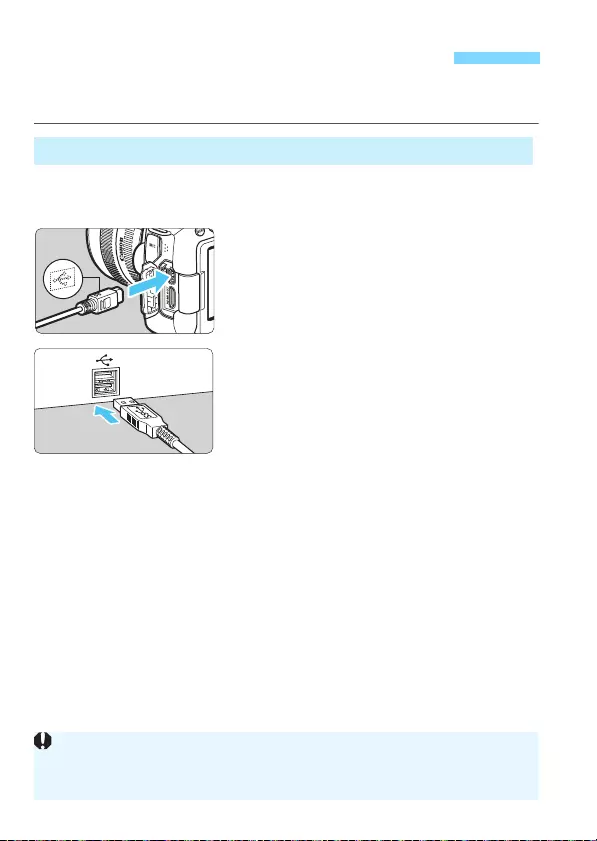
598
You can use EOS software to download images from the camera to a
computer. There are two ways to do this.
1Install the software (p.596).
2Use the interface cable (sold
separately) to connect the camera
to the computer.
Connect the cable to the camera’s
digital terminal with the cable plug’s
<D> icon facing the front of the
camera.
Connect the cord’s plug to the
computer’s USB terminal.
3Use EOS Utility to download the
images.
Refer to the EOS Utility Instruction
Manual (p.597).
Downloading Images to a Computer
Downloading by Connecting the Camera to the Computer
With Wi-Fi connection established, the camera cannot communicate with
the computer even if they are connected with an interface cable (sold
separately).
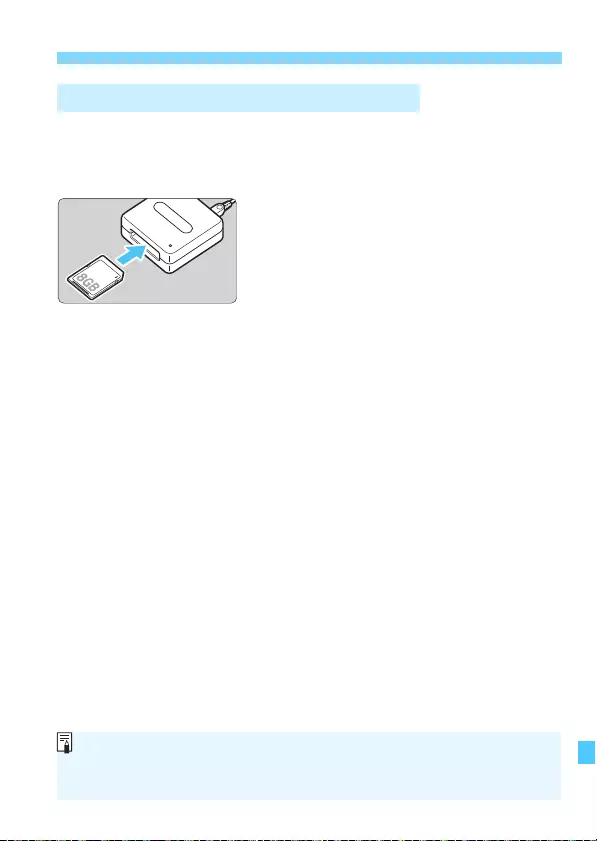
599
Downloading Images to a Computer
You can use a card reader to download images to a computer.
1Install the software (p.596).
2Insert the card into the card
reader.
3Use Digital Photo Professional to
download the images.
Refer to the Digital Photo
Professional Instruction Manual
(p.597).
Downloading Images with a Card Reader
When downloading images from the camera to a computer with a card
reader without using EOS software, copy the DCIM folder on the card to the
computer.

600
Numerics
10- or 2-sec. self-timer..................159
w1280x720 (movie)...................341
L1920x1080 (movie) ................341
H3840x2160
(Time-lapse movie) .......................350
4, 9, 36, or 100 images.................399
A
A (Scene Intelligent Auto) ............94
AC adapter....................................520
Acceleration/deceleration
tracking .........................................476
Access lamp .............................44, 45
Accessories ...................................... 3
Adjust all by same amount (AF)....491
Adobe RGB...................................208
AE lock..........................................249
AEB
(Auto Exposure Bracketing)..247, 472
AF .................................................129
AF area selection
mode ........................134, 136, 139
AF assist beam.........................480
AF groups .................................145
AF method ........................ 308, 374
AF Microadjustment .................491
AF operation..................... 130, 305
AF point automatic
selection ...........................135, 140
AF point red illumination...133, 488
AF point selection.............137, 500
AF sensor .................................143
AF speed ..................................376
Area AF frame.................. 135, 140
Beeper ....................................... 73
Color tracking................... 142, 485
Cross-type focusing ................. 143
Difficult subjects for AF .... 153, 316
Direct AF point selection .......... 500
Dual cross-type focusing ......... 143
F8 AF ............................... 143, 144
Manual focusing............... 154, 321
Number of AF points ................ 145
Out of focus ................. 55, 56, 551
Recomposing ............. 97, 131, 249
Spot AF point ..................... 31, 139
AF point auto switching ................ 477
AF-ON (AF start) button ......... 56, 498
AI FOCUS (AI Focus AF) ............. 132
AI SERVO (AI Servo AF)........ 97, 132
Acceleration/deceleration
tracking .................................... 476
AF point auto switching............ 477
AF points light up in red ........... 133
Initial position ........................... 484
Tracking sensitivity................... 475
Album (Video snapshot)............... 361
ALL-I (For editing/I-only) .............. 350
Ambience priority (AWB).............. 187
Ambience-based shots (C) ........ 101
Anti-flicker shooting ...................... 206
Aperture-priority AE ...................... 238
Area AF frame ...................... 135, 140
Aspect ratio .................................. 168
Attenuator..................................... 347
Auto (D) ................................... 177
Auto Lighting Optimizer................ 194
Auto playback............................... 424
Index

601
Index
Auto power off...........................47, 73
Auto reset......................................213
Auto time setting (GPS) ................227
Autofocus 9 AF
Automatic selection (AF).......135, 140
Av (Aperture-priority AE) ...............238
B
B (Bulb) .................................250, 326
B/W .......................................178, 182
Background blur (C) ...................103
Background music ........................426
Basic information display ..............391
Basic Zone modes ..........................35
Battery 9 Power
Battery Grip...........................514, 516
Beep (Beeper).................................73
Bit rate...........................................574
Black-and-white
images ..........................101, 178, 182
Bluetooth function .........................273
Bracketing
AEB (Auto Exposure
Bracketing) .......................247, 472
FEB (Flash Exposure
Bracketing) ...............................285
White balance bracketing .192, 472
Brightness (SCN)..........106, 127, 128
Built-in microphones .....................326
Bulb exposures .............................250
Bulb timer .................................251
buSY (BUSY) ........................167, 198
C
w/x (Custom shooting) ............ 510
C(Creative Auto) ........................ 100
Camera
Camera shake...................... 55, 96
Camera vibration blur......... 96, 265
Default settings .......................... 75
Holding the camera.................... 55
Candlelight ................................... 118
Cards...................... 5, 27, 43, 70, 343
Card reminder ............................ 44
Card requirements ................... 343
Formatting.................................. 70
Low-level formatting................... 71
Troubleshooting ................... 45, 71
Write-protect switch ................... 43
Center-weighted average
metering ....................................... 244
Certification Logo ......................... 513
Charger .................................... 37, 40
Chromatic aberration
correction.............................. 201, 442
Cleaning (image sensor) .............. 449
Clipped highlights......................... 397
CLn............................................... 455
Close-ups ..................................... 116
Color space .................................. 208
Color temperature ................ 185, 190
Color tone..................................... 181
Color tone (SCN).................. 106, 128
Color tracking ....................... 142, 485
Continuous (file numbering) ......... 212
Continuous shooting..................... 156

602
Index
Contrast ................................181, 194
Copyright information.................... 214
Creative Auto ................................ 100
Creative Zone modes .....................36
Cropping (images) ........................ 446
Cross-type focusing ......................143
Custom Controls ...........................497
Custom Functions.........468, 469, 471
Custom shooting mode.................510
D
D+ ................................................. 199
Date/time ........................................49
Daylight saving time........................51
DC Coupler ...................................520
Default settings ...............................75
Camera settings ......................... 75
Custom Controls.......................497
Custom Functions ....................468
Custom shooting mode ............510
Flash function settings..............287
My Menu...................................508
Default settings tables ....................75
Depth-of-field preview...................240
Dials
Main Dial ....................................57
Quick Control Dial ......................58
Diffraction correction.............203, 443
Digital terminal ........................29, 598
Dioptric adjustment .........................55
Direct selection (AF point) ............500
Distortion correction..............202, 442
Double-tap ....................................407
Downloading images to a
computer ...................................... 598
DPOF
(Digital Print Order Format).......... 458
Dragging......................................... 68
Drive mode................................... 156
Dual cross-type focusing.............. 143
Dust Delete Data.......................... 452
E
Electronic level ......................... 80, 81
Erasing images ............................ 430
Err (error codes)........................... 567
Evaluative metering...................... 243
exFAT ..................................... 71, 345
Expanded ISO speed ... 170, 173, 372
Exposure compensation............... 245
Exposure compensation in M mode
with ISO Auto ............................... 242
Exposure level increments ........... 471
Exposure level
indicator.................... 32, 34, 293, 334
Exposure simulation..................... 303
External Speedlite 9 Flash
External microphone .................... 347
Eyecup ......................................... 270
Eye-Fi cards ................................. 522
Eyepiece cover....................... 38, 270
F
L1920x1080
(Time-lapse movie)....................... 350
u+Tracking ................................. 309

603
Index
Faithful (U) ...............................178
FAT32......................................71, 345
FE lock ..........................................278
Feature guide..................................90
FEB
(Flash Exposure Bracketing).........285
File extension................................211
File name
Underscore “_”..........................208
File size.........................164, 344, 345
Filter effect (Monochrome)............182
Final image simulation ..........297, 338
Fine (Image-recording quality)......162
Fine Detail (u)..........................177
Fineness (Sharpness)...................181
Firmware .......................................543
First-curtain synchronization.........285
Flash (Speedlite)...........................277
Custom Functions.....................286
External flash units ...................278
FE lock......................................278
FEB (Flash Exposure
Bracketing) ...............................285
Flash control
(function settings) .....................281
Flash exposure
compensation ...................278, 285
Flash sync speed..............280, 282
Manual flash .............................283
Shutter synchronization
(1st/2nd curtain)........................285
Wireless....................................284
Flash exposure
compensation........................278, 285
Flash mode................................... 283
Flash sync contacts........................ 28
Flash sync. speed in Av mode...... 282
Focus indicator ....................... 94, 131
Focus lock .............................. 97, 131
Focus mode switch..... 6, 53, 154, 321
Focusing 9 AF
Focusing point
(AF point).............. 134, 137, 139, 143
Folder creation/selection ...... 209, 210
Food ............................................. 117
For editing (ALL-I) ........................ 350
Formatting (card initialization) ........ 70
Frame rate.................................... 342
Full Auto mode ............................... 94
Full High-Definition (Full HD)
(movie) ......................... 325, 341, 350
Functions available by shooting
mode ............................................ 526
G
GPS.............................................. 217
Grid display ............ 79, 302, 377, 390
Group Photo ................................. 110
H
H1/H2 (Expanded ISO
speed) .......................... 170, 173, 372
Handheld Night Scene ................. 120
HDMI .................................... 417, 427
HDMI CEC.................................... 428
HDR Backlight Control ................. 121
HDR movie shooting .................... 348

604
Index
HDR shooting ...............................253
Help ................................................91
Text size .....................................92
High dynamic range 9 HDR
High ISO speed noise reduction...195
High-Definition ..............................341
Highlight alert................................397
Highlight tone priority .................... 199
High-speed continuous shooting ..156
Histogram ............................. 293, 398
Hot shoe .................................28, 278
Household power..........................520
I
ICC profile.....................................208
Icons .................................................8
Illumination (AF point)................... 488
Illumination (LCD panel) ................. 60
Image browsing (Jump display)....400
Image dust prevention .................. 449
Image review time...........................74
Image search ................................ 402
Image-recording
quality ...........................162, 164, 341
Images
AF point display........................397
Auto playback........................... 424
Auto reset .................................213
Auto rotation .............................435
Continuous (file numbering) .....212
Downloading (to computer) ......598
Erasing .....................................430
File numbering.......................... 211
Highlight alert ...........................397
Histogram ................................ 398
Image-recording
quality ...................... 162, 164, 341
Index display............................ 399
Jump display (image browsing) 400
Magnifying images................... 404
Manual reset ............................ 213
Manual rotation ........................ 408
Playback .................................. 387
Protecting................................. 409
Rating ...................................... 412
Search conditions .................... 402
Shooting information................ 392
Slide show ............................... 424
Viewing on a TV set......... 417, 427
Index display ................................ 399
INFO
button ....... 60, 84, 293, 298, 334, 388
Initial AF Point .............................. 484
Initial magnification ratio/position . 405
Interval timer ................................ 267
IPB ............................................... 342
ISO speed .................... 170, 327, 331
Auto range (Still photos) .......... 174
Automatic setting (ISO Auto) ... 172
ISO Auto (movie) ..................... 372
ISO expansion ......................... 173
ISO speed range.............. 173, 372
Manual setting range ............... 173
Minimum shutter speed for ISO
Auto (Still photos) .................... 175
Setting increments ................... 471
Time-lapse ISO Auto................ 372
J
JPEG.................................... 162, 164

605
Index
Jump display.................................400
K
Kids ...............................................113
L
Landscape ....................................111
Landscape (R)..........................177
Language........................................52
Large (image-recording quality) ....164
Large Zone AF ......................135, 140
LCD monitor..............................27, 46
Adjusting angle.....................46, 99
Brightness.................................434
Electronic level .....................80, 84
Image Playback........................387
Menu display ......................64, 534
Quick Control........................61, 86
LCD Panel
Illumination .................................60
Lens ..........................................27, 53
AF group designations..............145
Chromatic aberration
correction..................................201
Diffraction correction.................203
Distortion correction..................202
Focus mode
switch......................6, 53, 154, 321
Lock release ...............................54
Optical aberration correction ....200
Peripheral illumination
correction..................................200
Lens electronic MF........................155
Light (IPB).....................................342
Live View shooting ..................98, 289
AF operation ............................ 305
Exposure simulation................. 303
u+Tracking ............................. 309
Grid display .............................. 302
Information display................... 293
Live 1-point AF......................... 313
Manual focusing....................... 321
Metering timer .......................... 302
Possible shots.......................... 291
Quick Control ........................... 301
Silent LV shooting .................... 303
Smooth zone............................ 311
LOCK........................................ 59, 88
LOG.............................................. 228
Logging......................................... 228
Log Data .................................. 229
Long (bulb) exposures.................. 250
Long Exposure Noise Reduction.. 197
Low-speed continuous shooting... 157
LV 9 Live View shooting
M
M (Manual exposure) ........... 241, 330
Magnifying images ....... 317, 321, 404
Main Dial ........................................ 57
Malfunction ................................... 548
Manual exposure.................. 241, 330
Manual focus ........................ 154, 321
Manual focusing ................... 154, 321
Manual reset................................. 213
Manual selection
(AF point)...................... 134, 137, 139
Maximum burst..................... 164, 167

606
Index
Medium
(image-recording quality) ..............164
Memory cards 9 Cards
Menu............................................... 64
Dimmed menu items .................. 66
My Menu...................................505
Setting procedure .......................65
Settings ....................................534
3 icon .........................................8
Metering mode..............................243
Metering timer.................56, 302, 377
MF (Manual focusing)...........154, 321
Microadjustment ...........................491
Microphone
Built-in ......................................326
External .................................... 347
Mirror lockup .................................265
Mode Dial..................................35, 57
Monochrome (V) ...................... 178
Motion JPEG (J) ......................350
MOV (D) .................................... 350
Movies .......................................... 325
AE lock ..................................... 328
AF method ........................ 308, 374
AF speed during
Movie Servo AF ........................376
Attenuator.................................347
Autoexposure shooting.............326
Cards suited for movie
shooting.................................... 343
Compression method ....... 342, 350
Editing ......................................422
Editing out first and
last scenes ...............................422
Enjoying movies .......................417
External microphone ................ 347
File size............................ 344, 345
Frame rate ............................... 342
Grid display .............................. 377
HDR movie shooting................ 348
Information display................... 334
Manual exposure shooting....... 330
Metering timer.......................... 377
Microphone...................... 326, 347
Movie digital IS ........................ 380
Movie recording method .......... 350
Movie recording size................ 341
Movie Servo AF ....... 373, 375, 376
Movie Servo AF tracking
sensitivity ................................. 375
Movie shooting button...... 326, 378
Playback .......................... 417, 419
Quick Control ........................... 339
Recording time......................... 344
Servo AF .................................. 373
Shutter speed .................. 330, 333
Sound recording/
Sound-recording level.............. 346
Time-lapse movie..................... 349
Video snapshots ...................... 361
Viewing on a TV set......... 417, 427
Wind filter................................. 346
MP4 (C) .................................... 342
M-RAW
(Medium RAW)..... 162, 164, 165, 166
Multi function lock..................... 59, 88
Multi Shot Noise Reduction.......... 195
Multi-controller................................ 59
Multiple exposure ......................... 258
MWB ............................................ 188
My Menu ...................................... 505

607
Index
N
Neutral (S) ...............................177
NFC connection ......................29, 540
Night Portrait .................................119
Noise reduction
High ISO speed ........................195
Long exposures ........................197
Nomenclature..................................28
Non-Canon flash units ..................280
Normal (Image-recording quality) .162
NTSC ............................342, 427, 541
O
ONE SHOT (One-Shot AF) ...131, 306
One-Shot AF .........................131, 306
P
P (Program AE).....................234, 326
PAL ...............................342, 427, 541
Panning.........................................114
Panning effect...........................115
Partial metering.............................243
Peripheral illumination
correction ..............................200, 442
Photobook set-up..........................464
Picture Style..................176, 180, 183
Pixel count ............................162, 164
Play (Frame skip)..........................421
Playback .......................................387
Portrait ..........................................109
Portrait (Q) ...............................177
Positioning hole...............................30
Positioning interval (GPS).............226
Possible recording time
(movie) ................................. 337, 344
Possible shots ................ 48, 164, 291
Power ............................................. 47
Auto power off...................... 47, 73
Battery information ................... 516
Battery level ....................... 48, 516
Charging .................................... 40
Household power..................... 520
Possible shots............ 48, 164, 291
Recharge performance ............ 516
Pressing completely ....................... 56
Pressing halfway ............................ 56
Printing
Print order (DPOF)................... 458
Photobook set-up..................... 464
Program AE .......................... 234, 326
Program shift............................ 235
Protecting images......................... 409
Q
Q (Quick
Control)........... 61, 126, 301, 339, 415
Quick Control Dial .......................... 58
R
Rating ........................................... 412
Rating mark .................................. 412
RAW ............................. 162, 164, 166
RAW image processing................ 438
RAW+JPEG.......................... 162, 164
Recharging ..................................... 40
Reduced display........................... 399
Release shutter without card.......... 44

608
Index
Remote control terminal..........28, 276
Remote controller .................271, 273
Remote switch ..............................276
Repeat (slide show)......................424
Resizing ........................................ 444
Rotation (image) ...........................408
S
Safety precautions ..........................22
Safety shift ....................................473
Saturation ..................................... 181
Scene icons .......................... 295, 329
Scene Intelligent Auto ..................... 94
SCN ................................35, 107, 348
SD, SDHC, SDXC cards 9 Cards
Second-curtain synchronization....285
Self-timer ......................................159
Sensitivity 9 ISO speed
Sensor cleaning ............................449
Sepia (Monochrome) ............101, 182
Serial number ................. 30, 494, 516
SERVO AF....................................307
Servo AF
AI SERVO AF .....................97, 132
Movie Servo AF ........373, 375, 376
SERVO (LV) ............................. 307
Sharpness.....................................181
Shooting information display.........392
Shooting mode guide......................89
Shooting modes..............................35
M (Manual exposure) .......241, 330
Av (Aperture-priority AE) ..........238
B (Bulb) .................................... 250
w/x (Custom shooting) ........ 510
C(Creative Auto).................... 100
A (Scene Intelligent Auto) ....... 94
P (Program AE)........................ 234
8 (Special scene) ............... 107
Tv (Shutter-priority AE) ............ 236
Shutter button................................. 56
Shutter button functions ............... 378
Shutter synchronization................ 285
Shutter-priority AE ........................ 236
Silent shooting
Silent continuous shooting....... 157
Silent LV shooting .................... 303
Silent single shooting............... 157
Single shooting..................... 156, 157
Single-image display .................... 388
Single-point AF............. 134, 139, 313
Single-point Spot AF ............ 134, 139
Slide show.................................... 424
Small (image-recording quality) ... 164
Smooth zone ................................ 311
Software ....................................... 594
Instruction Manual ................... 597
Sound recording/Sound-recording
level.............................................. 346
Speaker.................................. 29, 419
Special scene mode (SCN).. 107, 348
Specifications ............................... 568
Sports........................................... 112
Spot AF point.......................... 31, 139
Spot metering............................... 244
S-RAW
(Small RAW)......... 162, 164, 165, 166
sRGB............................................ 208

609
Index
Standard (IPB) ..............................342
Standard (P) ............................177
M icon..............................................8
Strap ...............................................38
Strength (Sharpness)....................181
Subjects difficult to
focus .............................153, 316, 374
System map..................................514
T
Temperature warning ............323, 382
Threshold (Sharpness) .................181
Tilt correction ..........................80, 447
Time zone .......................................49
Time-lapse movie..........................349
Tone priority ..................................199
Toning effect (Monochrome) .........182
Touch beeping.................................73
Touch operation ......................67, 406
Touch Shutter................................319
Tracking sensitivity........................475
Transition effect (slide show) ........425
Tripod socket ..................................30
Troubleshooting ............................548
Tv (Shutter-priority AE) .................236
U
UHS-I ........................................5, 343
Underscore “_”..............................208
USB (digital) terminal ..............29, 598
User Def. (W) ............................178
UTC (Coordinated Universal Time)218
V
Vari-angle LCD monitor ............ 46, 99
Vertical image auto rotation.......... 435
Video snapshots........................... 361
Video system................ 341, 427, 541
Viewfinder
Dioptric adjustment .................... 55
Electronic level........................... 81
Grid display ................................ 79
Information display..................... 82
Viewing on a TV set ............. 417, 427
Volume (movie playback) ............. 420
W
Warning icon ................................ 489
White balance (WB) ..................... 185
Auto.......................................... 187
Bracketing ................................ 192
Color temperature setting ........ 190
Correction ................................ 191
Custom..................................... 188
White priority (AWB) ..................... 187
Wi-Fi function ............................... 540
Wind filter ..................................... 346
Wireless communication
settings ......................................... 540
Z
Zone AF................................ 134, 139

CPH-E502-003 © CANON INC. 2020







